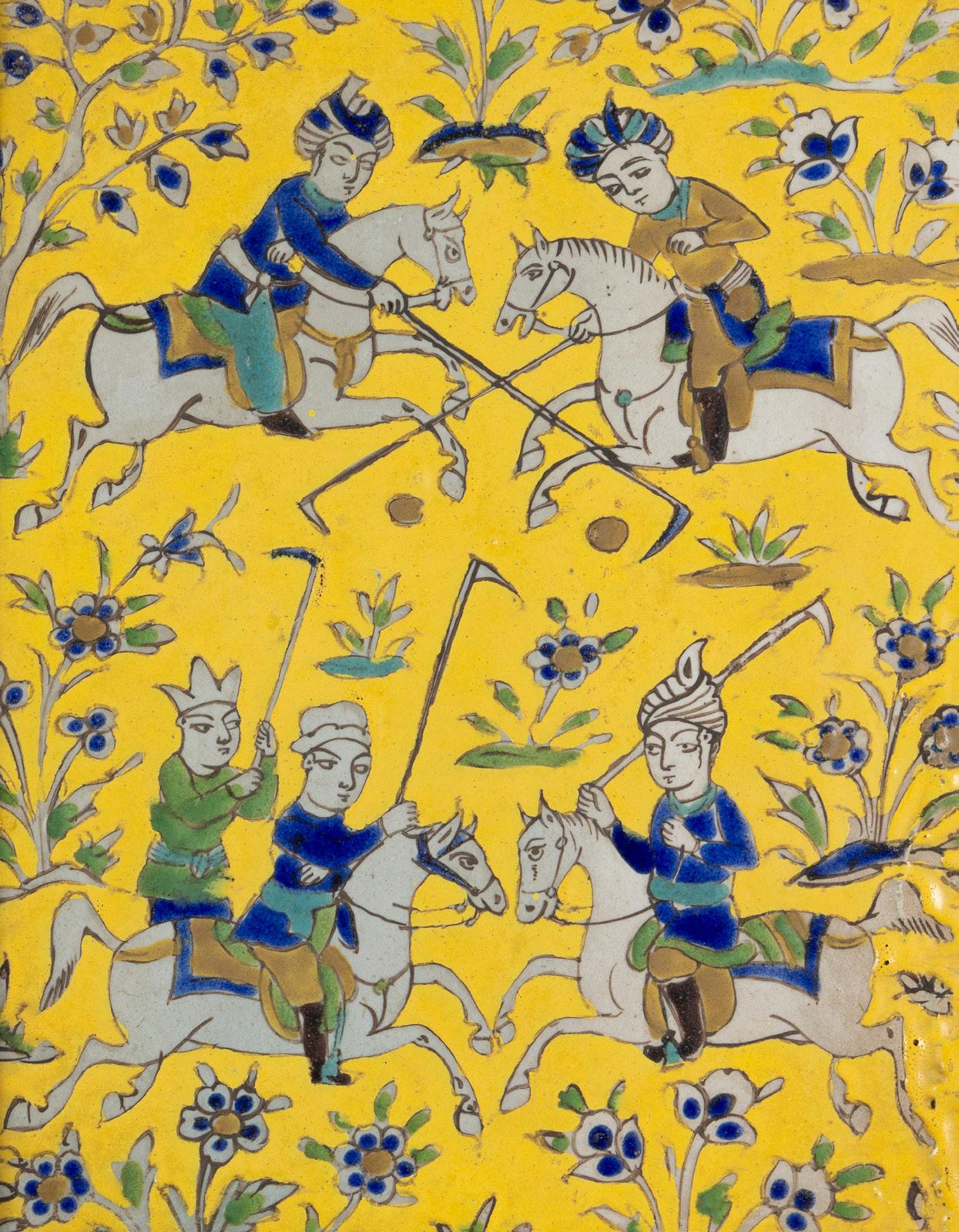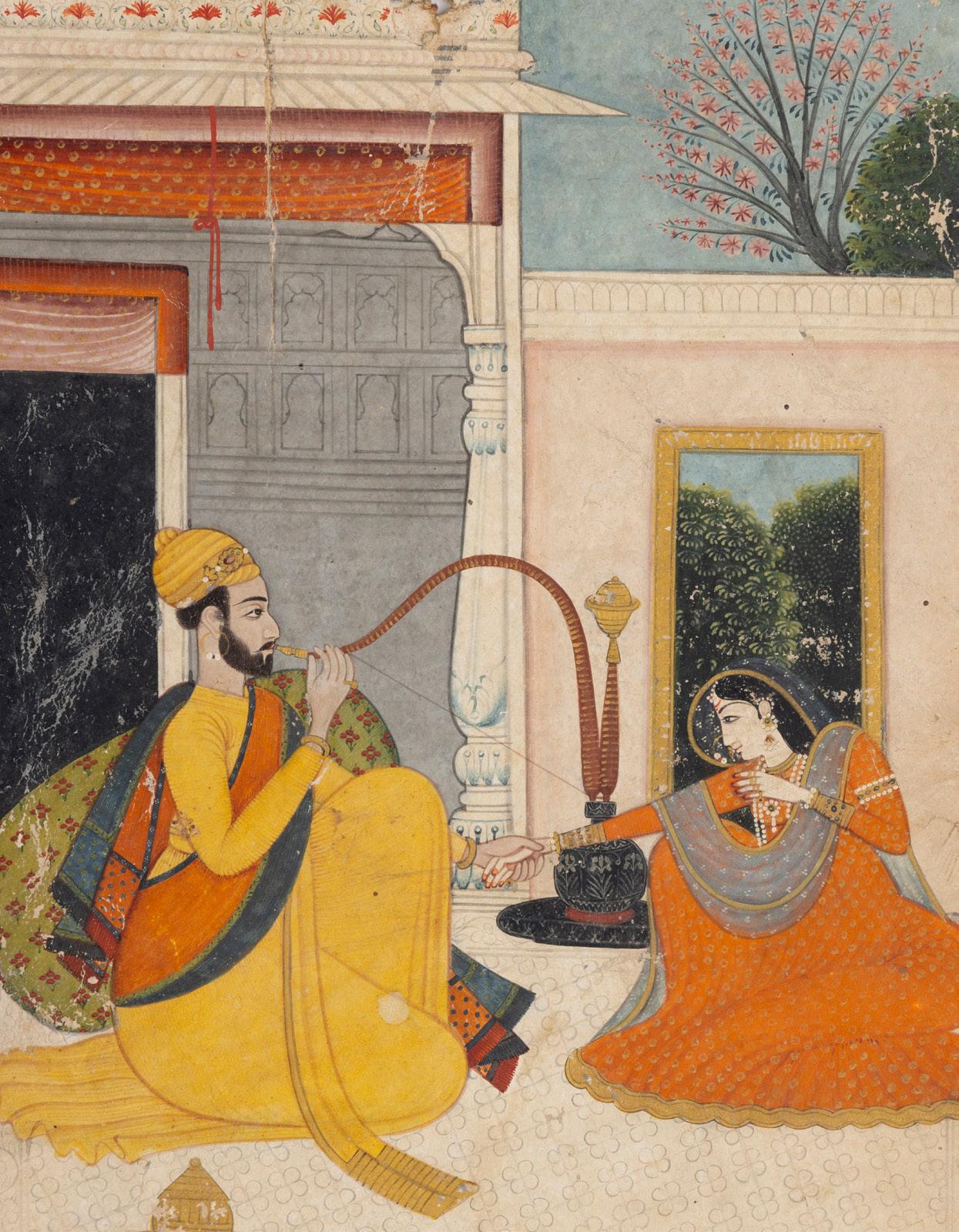

ISLAMIC & INDIAN ART
11TH JUNE 2025 LIVE ONLINE VIEWING IN LONDON

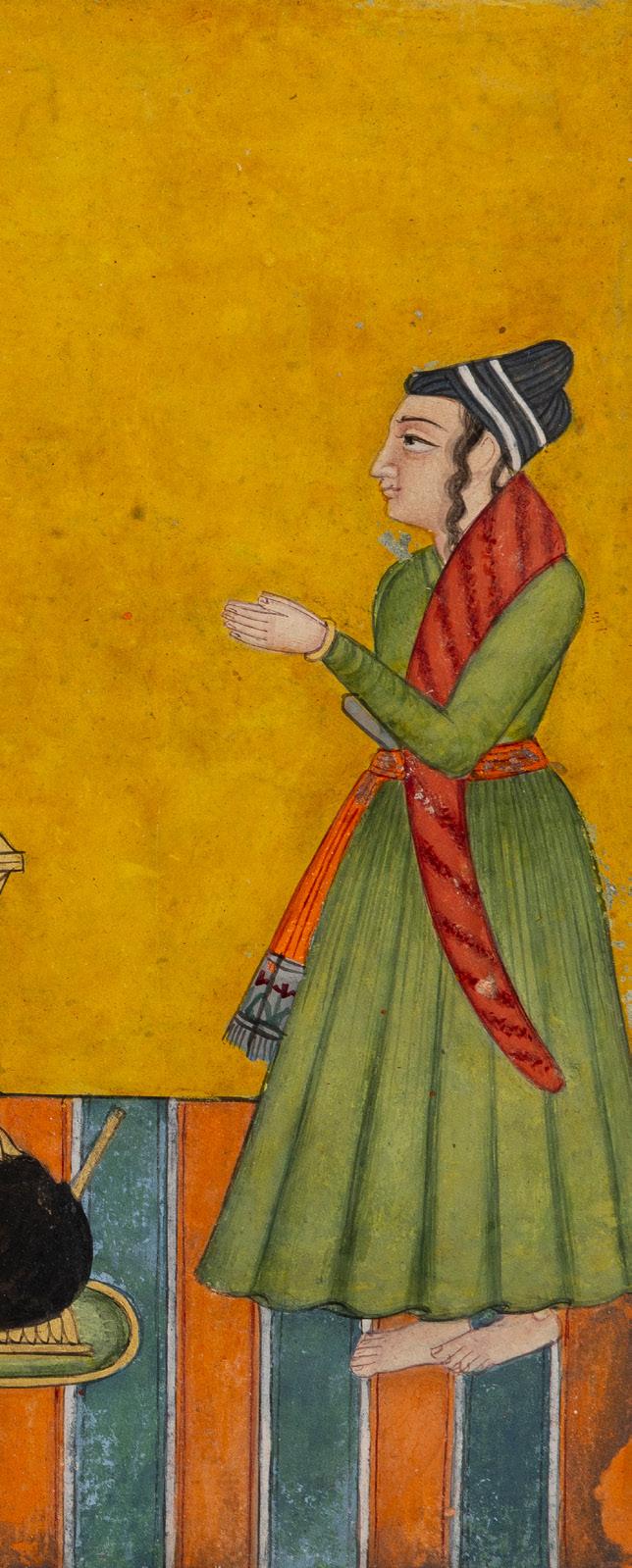
ISLAMIC & INDIAN ART
Sale Number LT850 Lyon & Turnbull 22 Connaught Street LONDON W2 2AF
BIDDING AT THIS SALE
Online, telephone and commission bidding only -please see the guide to bidding on page 120
VIEWING
Thursday 5th June 1pm - 4pm
Friday 6th June 10am - 4pm
Saturday 7th June 10am - 4pm
Monday 9th June 10am - 4pm
Tuesday 10th June 10am - 4pm Front Cover Lot 114 [detail] Inside Front Cover Lot 115 [detail]
CONTACT
BUYER'S GUIDE
BUYER’S PREMIUM
The buyer shall pay the hammer price together with a premium, at the following rate, thereon:
26% up to £20,000 25% from £20,001 to £500,000 20% thereafter.
VAT will be charged on the premium at the rate imposed by law (see our Conditions of Sale at the back of this catalogue).
ADDITIONAL VAT
† VAT at the standard rate payable on the hammer price
‡ Reduced rate of 5% import VAT payable on the hammer price
Ω Standard rate of import VAT on the hammer price
Lots affixed with ‡ or Ω symbols may be subject to further regulations upon export /import, please see Conditions of Sale for Buyers Section D.2.
No VAT is payable on the hammer price or premium for books bought at auction.
DROIT DE SUITE
§ indicates works which may be subject to the Droit de Suite or Artist’s Resale Right, a royalty payment for all qualifying works of art. Under legislation which came into effect on 1st January 2012, this applies to living artists and artists who have died in the last 70 years. This royalty will be charged to the buyer on the hammer price and in addition to the buyer’s premium. It will not apply to works where the Hammer Price is less than £1,000. The charge for works of art sold at and above £1,000 and below £50,000 is 4%. For items selling above £50,000, charges are calculated on a sliding scale.
More information on Droit de Suite is available at www.dacs.org.uk.
This sale is subject to our Standard conditions of Sale (available at the back of every catalogue and on our website). If you have not bought before we will be delighted to help you.
REGISTRATION
All potential buyers must register prior to placing a bid. Registration information may be submitted in person at our registration desk, by email, or on our website. Please note that first-time bidders, and those returning after an extended period, will be asked to supply the following documents in order to facilitate registration:
1 – Government issued photo ID (Passport/Driving licence)
2 – Proof of address (utility bill/bank statement). We may, at our option, also ask you to provide a bank reference and/ or deposit. (Particularly for bidding on lots marked by the high value lot symbol ) By registering for the sale, the buyer acknowledges that he or she has read, understood and accepted our Conditions of Sale (available at the back of every catalogue and on our website).
BIDDING & PAYMENT
For information on bidding options see our Guide to Bidding & Payment at the back of the catalogue.
REMOVAL OF PURCHASES
Responsibility for packing, shipping and insurance shall be exclusively that of the purchaser. See Collections & Storage section for more info specific to this particular auction.
CATALOGUE DESCRIPTIONS
All item descriptions, dimensions and estimates are provided for guidance only. It is the buyer’s responsibility to inspect all lots prior to bidding to ensure that the condition is to their satisfaction. Our specialists will be happy to prepare condition reports and additional images. These are for guidance only and all lots are sold ‘as found’, as per our Conditions of Sale.
IMPORT/EXPORT
Prospective buyers are advised that several countries prohibit the importation of property containing materials from endangered species, including but not limited to; rhino horn, ivory, coral and tortoiseshell. Accordingly, prospective buyers should familiarise themselves with all relevant customs regulations prior to bidding if they intend to import lots to another country. It is the buyer’s sole responsibility to obtain any relevant export or import licence. The denial of any licence or any delay in obtaining licences shall neither justify the recession of any sale nor any delay in making full payment for the lot.
ENDANGERED SPECIES
Please be aware that lots marked with the symbol Y contain material which may be subject to CITES regulations when exporting outside Great Britain. For more information visit http:// www.defra.gov.uk/ahvla-en/importsexports/cites
EXPORT OF IRANIAN WORKS
Iranian origin ‘informational materials’ (including fine art by recognised artists and books and manuscripts) may be imported into the United States and purchased by US persons, but Iranian origin ‘works of conventional craftsmanship’ (works that are not by a recognised artist and/or that have a function) may not. If you are a US person, you are responsible for checking that you do not bid on prohibited Iranian origin property. US persons include US citizens and US permanent residents (‘greencard holders’) wherever these individuals are located, US entities and any other persons temporarily resident or located in the US.
COLLECTIONS & STORAGE OF PURCHASED LOTS
FOR INTERNATIONAL BUYERS & UK (OUTSIDE SCOTLAND) BUYERS
STORAGE: Items will be stored at 22 Connaught Street, until Wednesday 25th June at 5pm.
Thereafter we will store items at Stephen Morris Shipping Ltd., 15 Ockham Drive, Greenford Park, Greenford, UB6 0FD.
Telephone +44(0)20 8832 2222. Items will be available to collect from 9am on Friday 27th June.
Please ensure payment has been made prior to collection. This can be done online, bank transfer or in person at our London office - details will be shown on your invoice also. Please note we are unable to accept cash or payments over the phone.
COST: Please note from Friday 27th June you will be charged by our storage partners.
Insurance 0.25% (all items)
Smalls (paintings and objects) - £2.50 admin fee then £1.00 per day.
Furniture pieces - £5.50 admin fee then £2.50 per day.
FOR BUYERS IN SCOTLAND
STORAGE: Items will be transported to our Edinburgh saleroom and will be available to collect on Friday 11th July from 9am. All collections will be by appointment only (this applies to both carriers and personal collections). To make an appointment email info@lyonandturnbull.com or call 0131 557 8844. Please ensure payment has been made prior to collection. This can be done by bank transfer, and debit/ credit card online (powered by Stripe) - details will be shown on your invoice. Please note we are unable to take payments over the phone.
MEET THE SPECIALISTS
At Lyon & Turnbull we want to make buying at auction as easy and enjoyable as possible. Our specialist team are on hand to assist you, whether you are looking for something in particular for your home or collection, require more detailed information about the history or current condition of a lot, or just want to find out more about the auction process.

KRISTINA SANNE Head of Sale | Consultant Specialist kristina.sanne@lyonandturnbull.com
ORDER OF SALE
Islamic Manuscripts & Works of Art Lots 1-59
Indian Miniatures & Works of Art Lots 60-147

A very special thanks to Margaret Erskine, Stella Koslowski and William Greenwood for all their help in creating this catalogue.
NEIL GRAHAM Sale Administrator neil.graham@lyonandturnbull.com
ISLAMIC WORKS OF ART
1
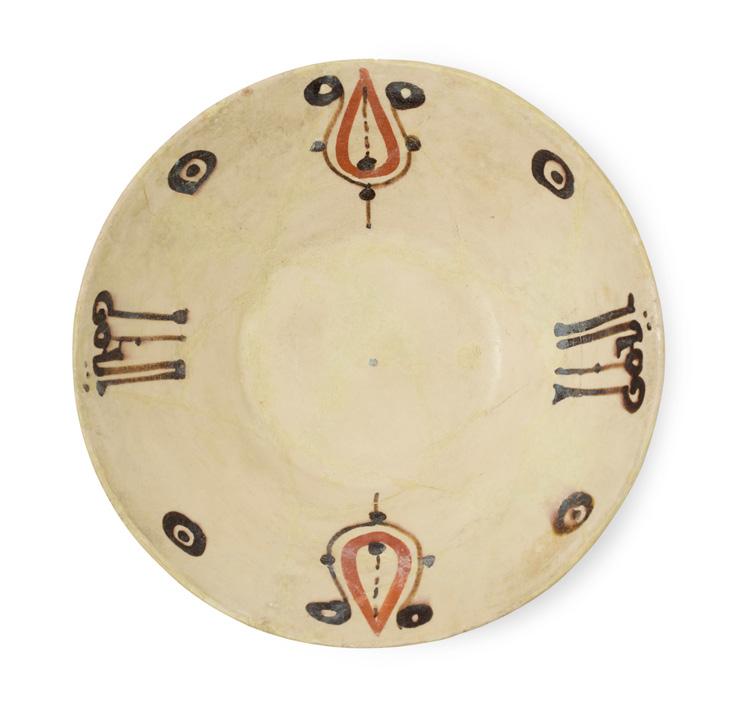
A SAMANID SLIP-PAINTED POTTERY
BI-CHROME CALLIGRAPHIC BOWL
CENTRAL ASIA, 10TH CENTURY
with flaring sides, decorated in red and brown slip on a white ground with two repeat kufic inscriptions and two flowerheads around the sides
19.4cm diameter
£1,000-1,500
Provenance: Sotheby’s, London, Arts of the Islamic World, 27 April 1995, lot 27.
Acquired from Aaron Gallery, London, inv. no. A 312.
Private UK Collection.
2
A KUFIC QUR’AN BIFOLIO NEAR EAST OR NORTH AFRICA, 9TH CENTURY
Arabic manuscript on vellum, 6 lines to the page written in bold kufic script in black ink, red and green vocalisation, gilt roundel verse markers and larger gilt roundels marking every fifth verse, mounted, framed and glazed
14.5cm x 43.6cm
£5,000-7,000
Provenance: Christie’s, Arts of the Islamic and Indian Worlds, London, 7 April 2011, lot 15.
The text inludes: Sura VI, al-an’am, The Cattle, vv. 160-161, parts of vv. 159 and 162, parts vv. 145 and 146.
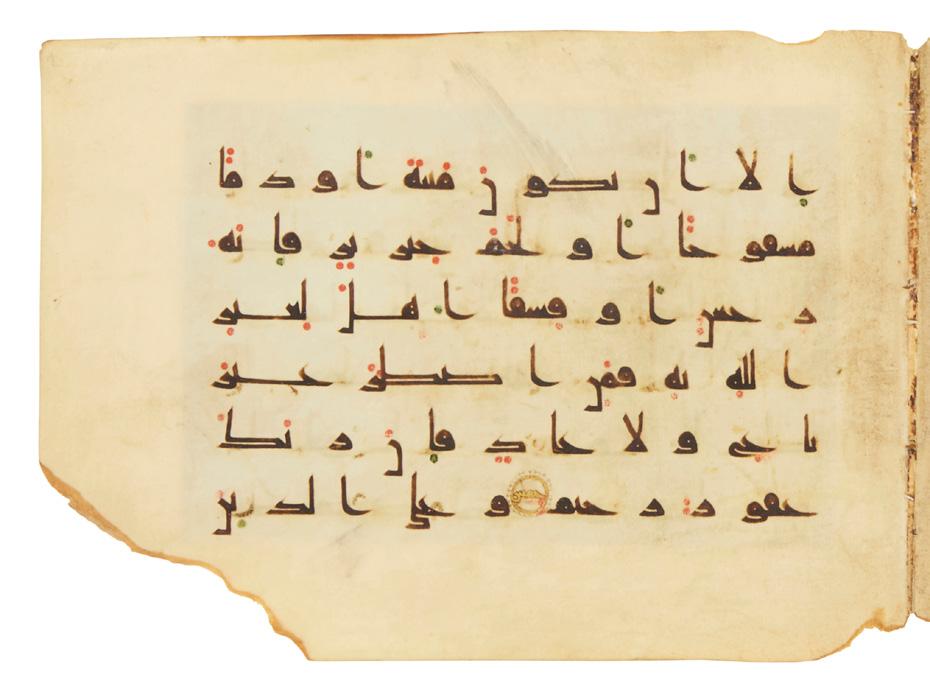
A SINGLE FOLIO IN EASTERN KUFIC SCRIPT FROM A DISPERSED MANUSCRIPT OF THE QUR’AN PERSIA, 11TH/ 12TH CENTURY
Arabic manuscript on buff paper, comprising sura 2, al-Baqara, parts of verses 221-22, with 7 lines of black Eastern kufic script with red diacritics, interlinear translations in Persian script, verses separated by gold and red dotted florets, a large gold and polychrome medallion within the margin 30.7cm x 22cm
£2,000-3,000
This single folio with script on either side in Eastern kufic on buff paper appears to belong to the same Qur’an as a section sold through these rooms (see Fine Asian and Islamic Works of Art, 16 May 2023, lot 304). Another single folio (Sura II, al-Baqara, v.146-150) that was previously in the collection of Adrienne Minassian, New York, 1955, was sold through Sotheby’s, London, Stuart Cary Welch Collection Part II, 6 April 2011, lot 13.
The style of script of this Qur’an folio epitomises the transitional period from the early kufic style into the more angular and more accentuated regional styles called ‘eastern’ and ‘western’. The crossed and perfectly symmetrical lam-alif is a characteristic of the eastern kufic. Another interesting feature of this Qur’an is the structure of the thick, buff paper, whose chain lines and laid lines are clearly visible.
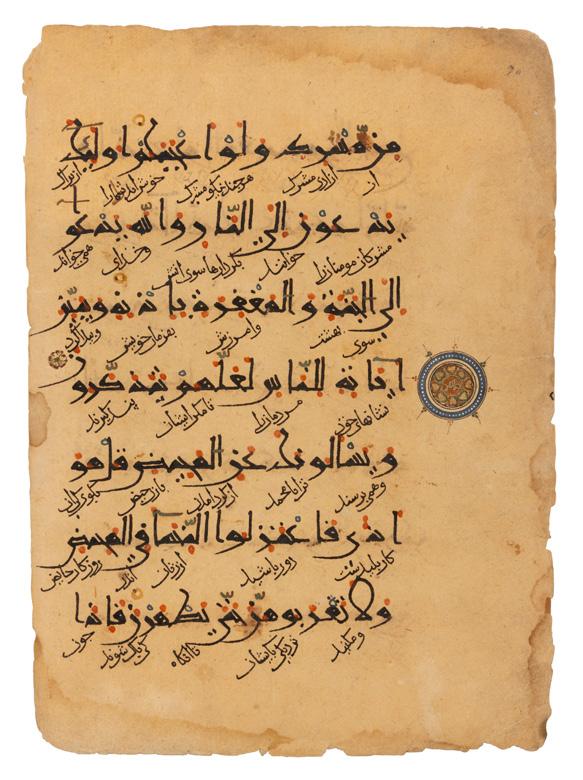
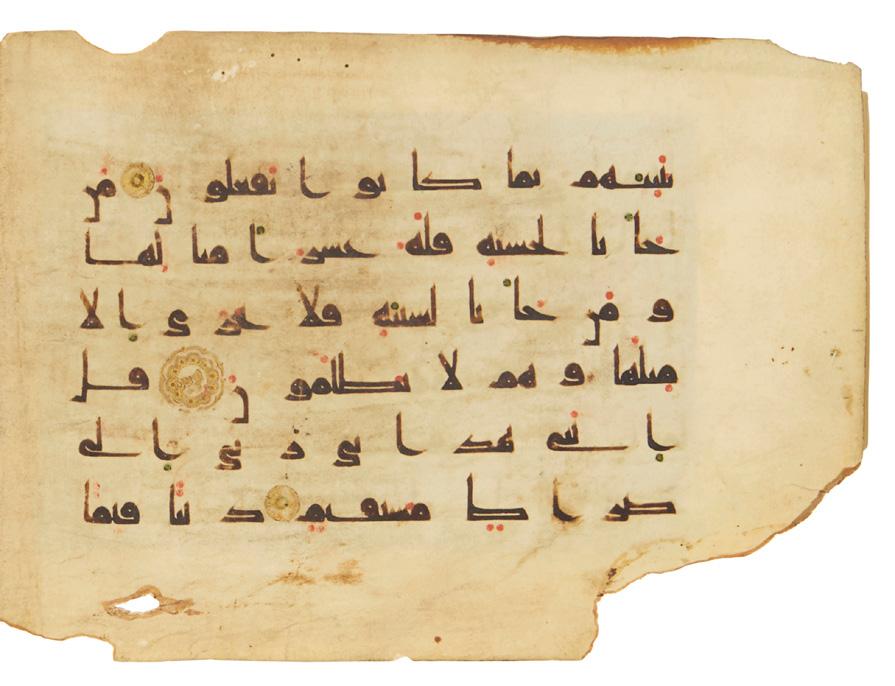
4
A FATIMID BLUE-GLASS COMPOSITE NECKLACE
EGYPT OR SYRIA, 10TH CENTURY
composed of twelve large lozenge-shaped glass elements hand drilled through the middle and strung with fifteen smaller associated glass beads, modern clasp
62.5cm long
£1,000-1,500
Provenance: Formerly,
5
A FATIMID ROCK CRYSTAL COMPOSITE NECKLACE
EGYPT OR SYRIA, 10TH CENTURY
composed of fourteen large oval-shaped crystal elements, hand-drilled through the centre, and three associated gold balls, with modern clasp
40.2cm long
£2,000-3,000
Provenance: Formerly, Mehdi Mahboubian Gallery, New York, 1970s.
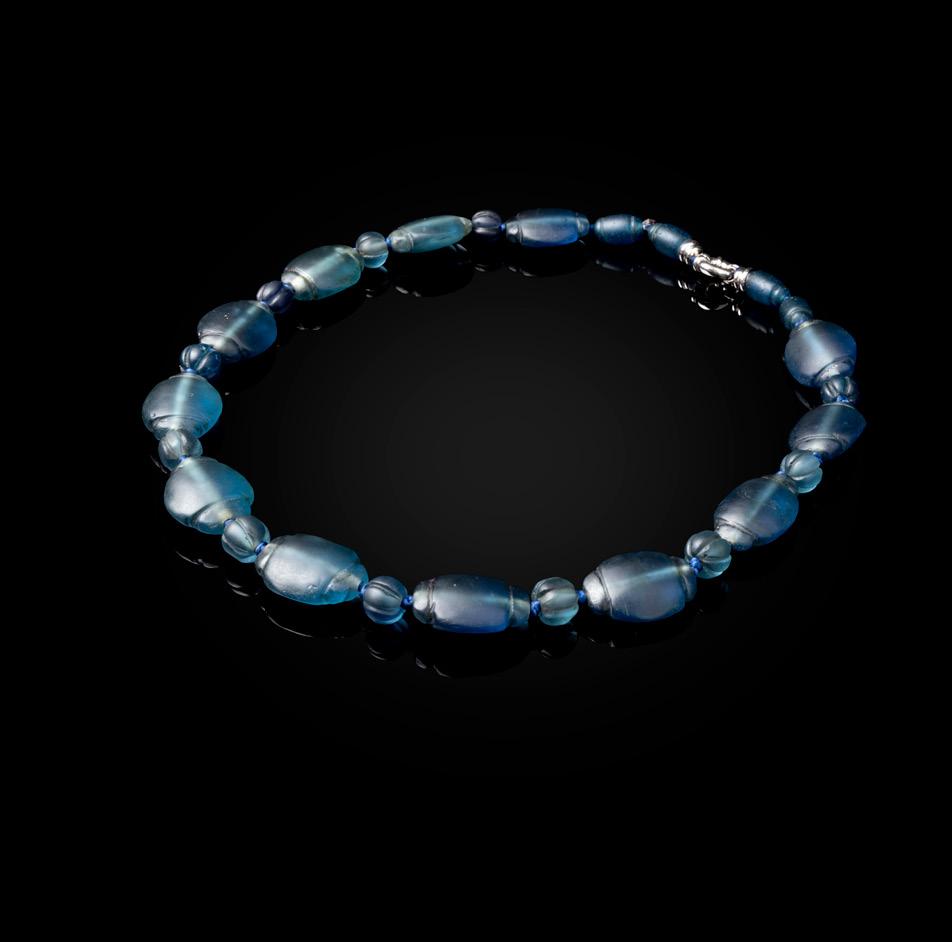



Mehdi Mahboubian Gallery, New York, 1970s
A RARE AND EARLY ISLAMIC CARVED LAPIS LAZULI ELEPHANT CHESS PIECE WESTERN ASIA, PROBABLY EASTERN KHORASAN, 10TH/ 11TH CENTURY
in the form of an elephant carved with naturalistic details, the front with stylised trunk, eyes, and two protruding tusks, the top with stylised ears and folds of skin, the back and sides with three panels containing criss-cross designs, and a smaller design in bands above and below 5cm high
£3,000-5,000

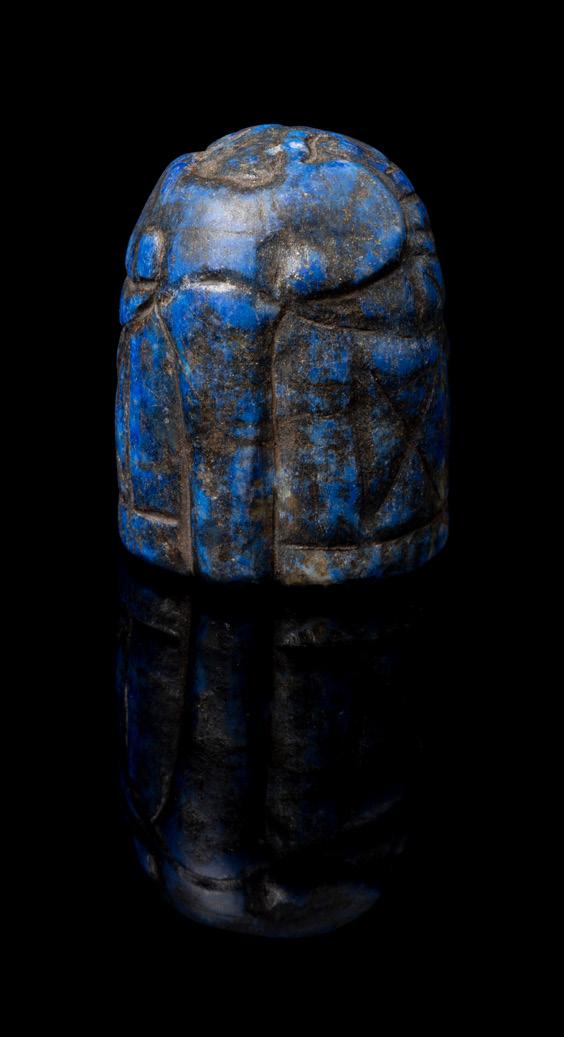
Chess originated in India around the 7th century, where it was a war game with the different pieces representing elements of the classical Indian army and its leadership. Among these were the war elephants (Arabic fil, Persian pil), of which the present piece is a superb example. It is recognisable as such by the long trunk, small eyes, floppy ears and skin, and in particular the small protrusions either side of the eyes. The latter are highly stylised representations of the animal’s tusks, which by the early mediaeval period had been reduced to small nubs. In terms of design, the closest comparison to this piece is a much larger chess fil carved from emerald glass in the al-Sabah Collection, which has been attributed to the 10-11th century Eastern Iranian world. Although the present example is less monumental and more carefully carved, the semi-abstracted form of the elephant’s face is very similar. Another reason to attribute the present piece to eastern Khorasan is the use of lapis lazuli, a rare and precious material the only source of which in the medieval. Eurasian world was Badakhshan in northern Afghanistan. This would suggest that the present piece would have been carved near where this stone was sourced (see W. Greenwood, Kings & Pawns: Board Games from India to Spain, Akkadia Press: 2014, pp. 6-21, 78-9, 162-3).
7
AN ABBASID OR FATIMID CARVED ROCK CRYSTAL CHESS PIECE
EGYPT OR NEAR EAST, 9TH/ 10TH CENTURY
of dome-shape on a flat base, with deep bevel-cut arabesque designs
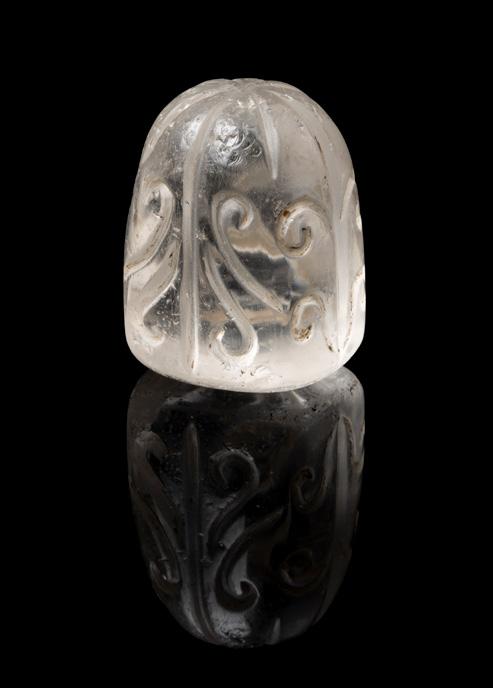
3.2cm high
£1,000-1,500
This small and exquisite rounded chess piece cut with U-shaped and arabesque designs, shares similarities with pawns that form a group of ten chess pieces in the Al-Sabbah collection that are cut in the ‘bevelled’ style (see D. Freeman Fahid, Chess and other Games Pieces from Islamic Lands, London, 2018, p. 183, Cats. 77-82).
8
AN EARLY ISLAMIC MINIATURE GLASS PERFUME BOTTLE WESTERN ASIA, PROBABLY PERSIA, 9TH/ 10TH CENTURY
colourless glass covered in a layer of iridescence, of pear-shaped on a flat base with faceted spout, moulded and tooled with a frieze of repeat arched designs around the body, pontil mark on base
6.2cm high
£2,000-3,000
These examples of early Islamic glass - as petite as they are, with none over seven centimetres in height - represent the skill and versatility of glassworkers in this period. All three were made by cutting glass blanks using a wheel or drill, a technique most closely associated with the pre-Islamic Sassanian empire. This tradition survived the arrival of the Muslim armies and by the ninth-tenth century had become the foremost manner of decorating Islamic glass.
The first vessel (Lot 8) employs a shape which was clearly popular in the early mediaeval period, when these were used as rose-water sprinklers. Not only is this shape found in glass, but it is also found in ceramic as well as metalwork. The horizontal mouldings used to delineate different sections of the vessel find comparison with metal pieces, suggesting that this might have been the glassworker’s primary inspiration [see M. Jenkins-Madina, “Islamic Glass: A Brief History” in MMA Bulletin vol. 44, no. 2 (Fall 1986), p. 31, no. 32].
Although also decorated using the same technique, the aesthetic of the second vessel (Lot 9) is quite different. Ultimately derived from the facet-cut bowls produced under the late Sassanian empire in Iran and exported as far as Japan and China, the cutting here creates a series of slightly concave hexagonal shapes in an overall honeycomb pattern. The remarkable uniformity of the hexagons and the care taken to scoop out their centres demonstrates the maker’s painstaking care over this piece [ see Carboni, S., Glass from Islamic Lands: the al-Sabah Collection, Kuwait National Museum, Thames & Hudson: 2001, pp. 32-5, cats. 9a-d]. The last piece (Lot 10), which has six facet-cut sides each with a central oval in relief, is closely paralleled by an example in the al-Sabah Collection, Kuwait (LNS 32 G, for which see ibid., p. 112, cat. 2.8), and in the David collection, Copenhagen (object number 32/1973).



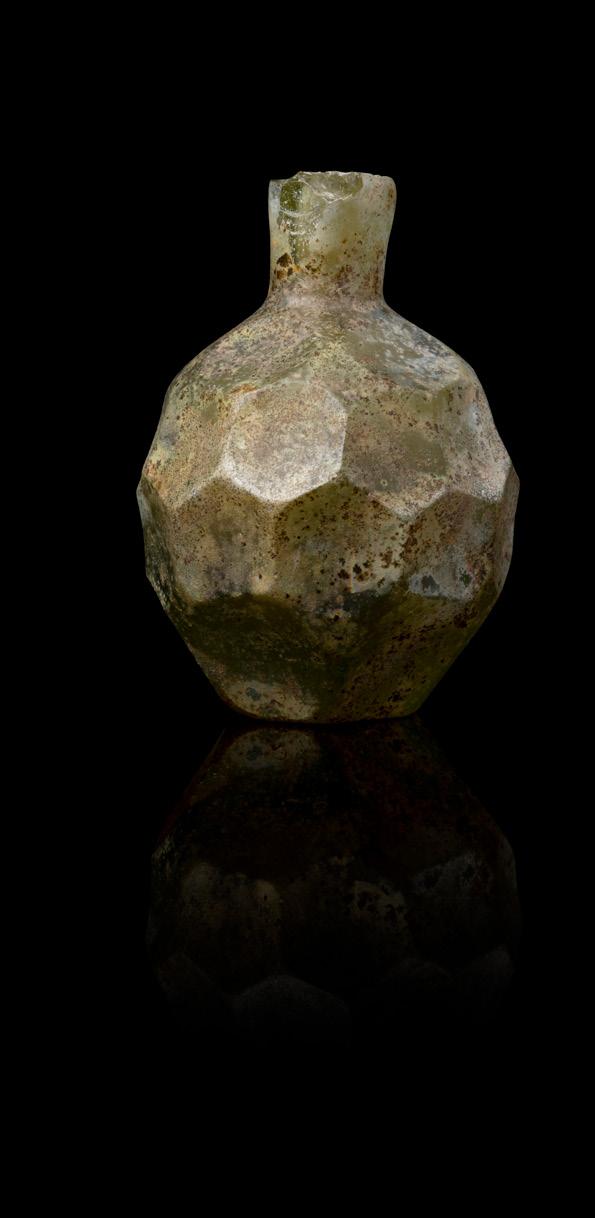
9
AN EARLY ISLAMIC FACETED MINIATURE PERFUME BOTTLE
WESTERN ASIA, PROBABLY PERSIA, 9TH - 11TH CENTURY
in a greyish colourless glass, of oval-shape with short cylindrical spout, the body wheel-cut with four rows of concave circular and hexagonal facets, some iridescence on the surface
5.7cm high
£1,200-1,800

10
AN EARLY ISLAMIC MINIATURE GLASS PERFUME BOTTLE
WESTERN ASIA, 8TH/ 9TH CENTURY
in a colourless glass, of squat form with faceted and slightly tapering cylindrical short spout, the body with relief-cut decoration with four sides, each with a raised boss, the surface covered with a light iridescence
4cm high
£600-800

AN ABBASID MINIATURE ‘MILLEFIORI’ GLASS COSMETIC DISH
MESOPOTAMIA, PROBABLY SAMARA, 9TH CENTURY
of oval form on a short foot, the base colour in black with brown and white and black decoration
6.8cm diameter
£3,000-4,000
This dish and the following one are excellent examples of the millefiori technique. The process of millefiori (“a thousand flowers”) glass work is time-consuming and delicate. Each component, known as a tessera (small tiles made of stone or glass), is sliced from a longer, cylindrical cane of glass that was formed from multiple layers. Originally created to imitate variegated stones like agate, these tesserae patterns were initially concentric circles or spirals, but by the late Roman period, more complex patterns were used. Islamic glassmakers carried on this cane making technique and improved it greatly in 8th and 9th century Abbasid Iraq, where it was used to ornament the floor in front of the Abbasid caliph’s throne in Samarra.
For an almost identical bowl to lot 11 in the Metropolitan Museum, see accession number 1990.185.



AN ABBASID MINIATURE ‘MILLEFIORI’ GLASS COSMETIC DISH MESOPOTAMIA, PROBABLY SAMARA, 9TH CENTURY
of circular form on a short foot, the base colour in blue with the circular decoration in green, white and black
5.4cm diameter
£3,000-4,000

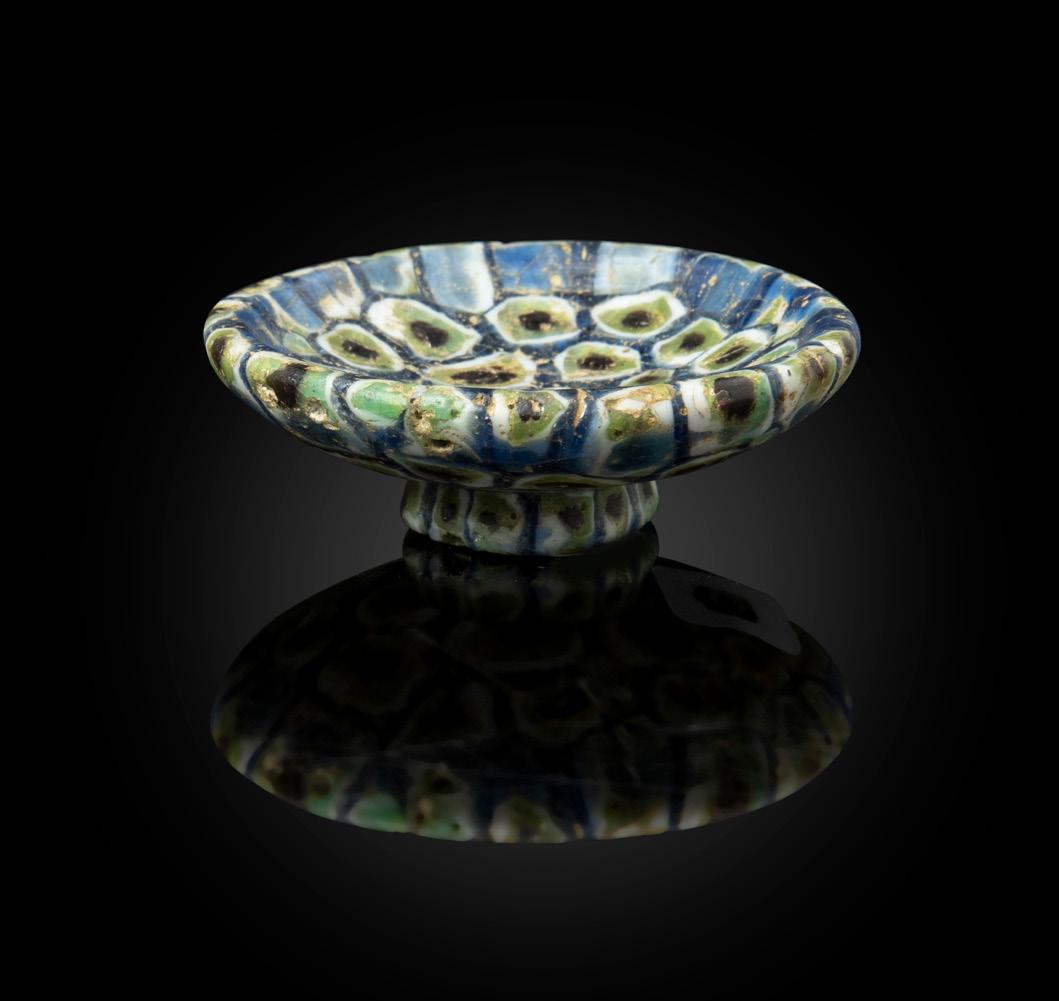
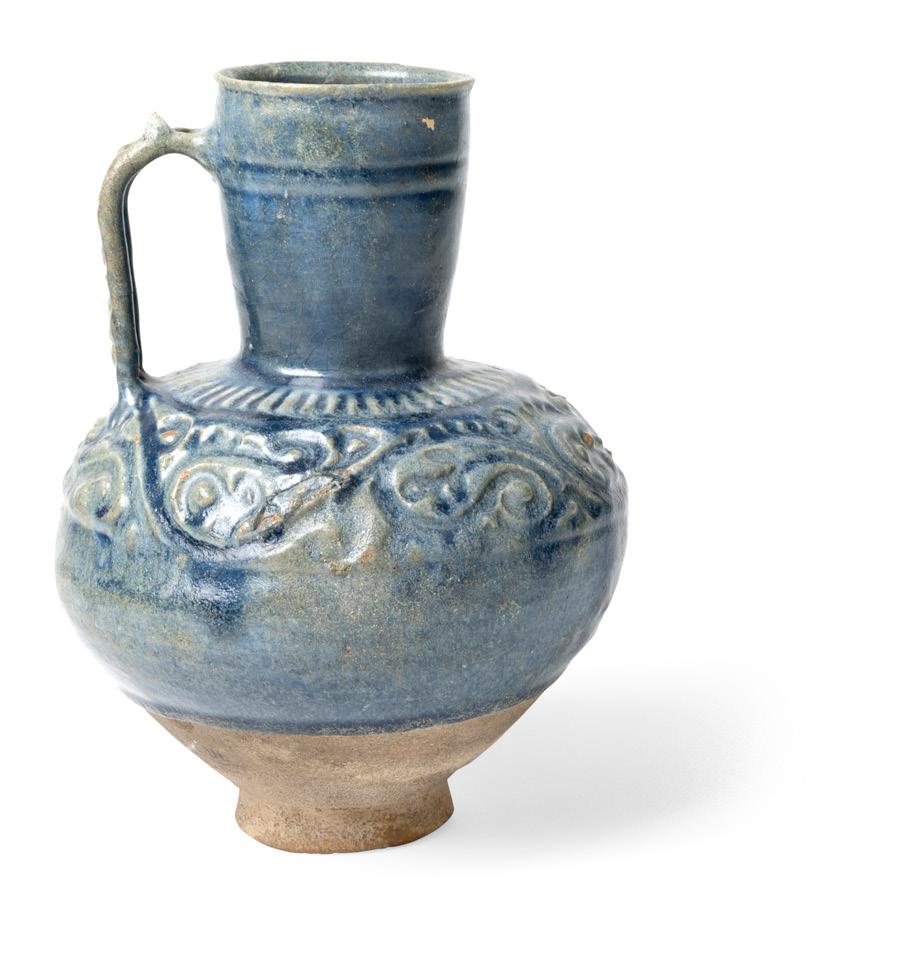
AN ISLAMIC MOULDED BLUE GLASS BOTTLE
CENTRAL ASIA, SAMARKAND, 12TH CENTURY
of globular body in blue transparent glass, moulded with floral scrolls, tall slender neck with applied wavy bands, remains of iridescence on the surface
21.8cm high
£1,000-1,500
Provenance: Christie’s, Indian and Islamic Art and Textiles, London, 29 April 2005, lot 155.
A STRIKING KASHAN MONOCHROME MOULDED POTTERY JUG
PERSIA, 12TH/ 13TH CENTURY
of bulbous form with cylindrical and slightly tapering neck on a short flaring foot, with an openwork zig-zag handle surmounted by a pair of pointed thumb rests, the body glazed in a monochrome light cobalt-blue, carved and moulded with a frieze around the shoulder consisting of elegant and meandering vegetal designs
25cm high
£1,500-2,000
The Persian ceramics industry was completely transformed during the 11th century by the development of a hard, artificial body known as fritware, which made fine ceramics capable of reproducing metalwork forms. The properties of this new, manmade body can be seen in the openwork handle of the current piece as well as the delicate moulding on the shoulder. Another aspect of fritware was that by including finely ground quartz as well as small amounts of glass, it produced a much whiter body than the traditional earthenwares. This encouraged the use of fine turquoise or lavender glazes, as can be seen here. Kashan, a city in central Iran, was famous for its ceramics, the production of which peaked between the 1170s and 1220s. The very elegant combination of pyriform body and tall, vertical neck is seen in a number of jugs from this place and period (see O. Watson, Ceramics of Iran: Islamic Pottery from the Sarikhani Collection, Yale University Press: 2020, p. 305).
For a comparable vessel in the same glaze decorated with a similar frieze, see Bonhams, Islamic and Indian Art, 8 October 2009, lot 99.
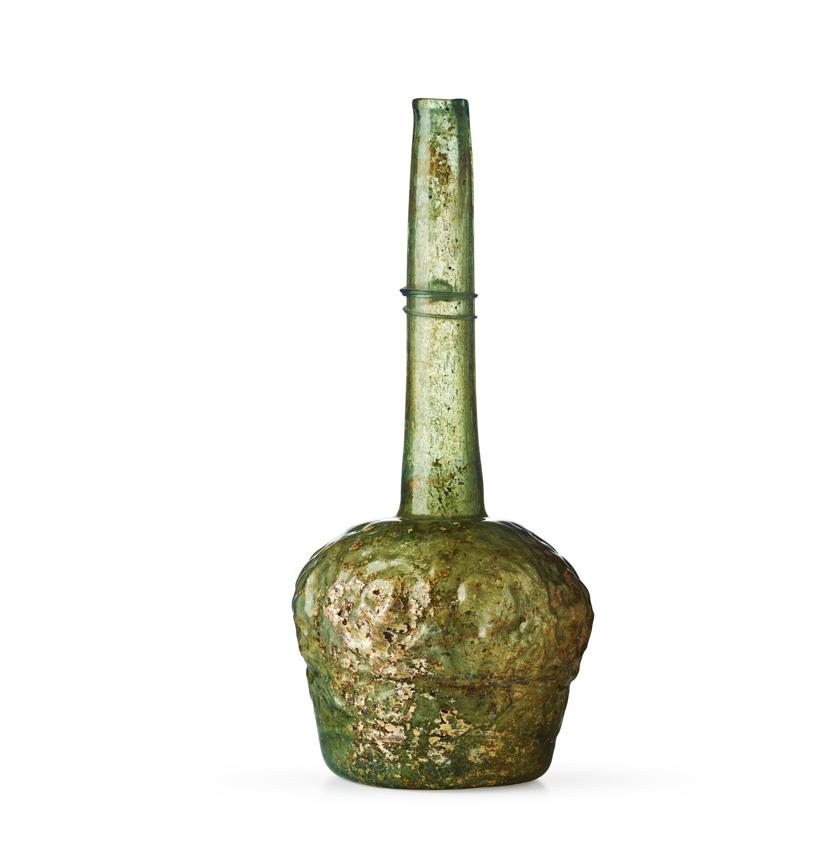
15
A MAMLUK ENGRAVED CANDLESTICK BASE
EGYPT OR SYRIA, 14TH CENTURY
of truncated conical form with flaring foot, a raised rib below the upper edge, engraved and decorated in silver and remains of polychrome enamel inlay, the body with inscriptions in thuluth script interspersed by roundels containing floral motifs, all on a ground of scrolling tendrils, inscribed in two areas outside the main decoration
12.5cm high; 24.5cm diameter
£1,500-2,000
The inscriptions, include: a repetition of the words ‘The high and the just’, a maker’s inscription ‘The work of Hadi’, and; the name of the owner ‘The owner is Taqa bint Muhammad b. al-Hasan son of the Commander of the Faithful’.
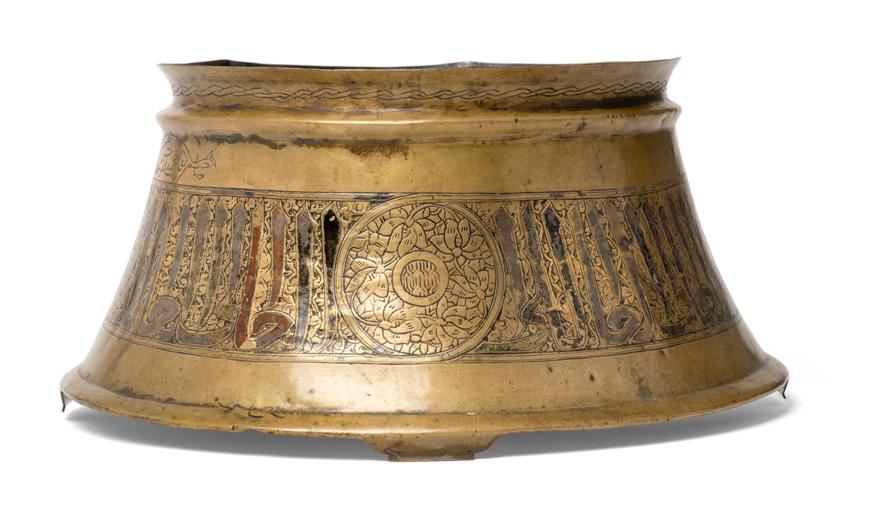
For a comparable candlestick base, see Bonhams, Islamic and Indian Art, London, 12 November 2024, lot 66.
16
A MAMLUK ‘VENETO-SARACENIC’ ENGRAVED BRASS DISH
EGYPT OR SYRIA, 15TH CENTURY
of circular and shallow form with rounded sides, profusely engraved with interlace floral arabesque, palmettes and split-palmettes, arranged around wide concentric bands
32cm diameter
£1,000-1,500
Whilst the dish is a little rubbed from wear, its richly engraved decoration is still very apparent. Remnants of the design are similar to the design on a Veneto-Saracenic dish in the British Museum, signed by Mahmud al-Kurdi, attributed to the 15th/ 16th Century (see object number 1878.1230.705).
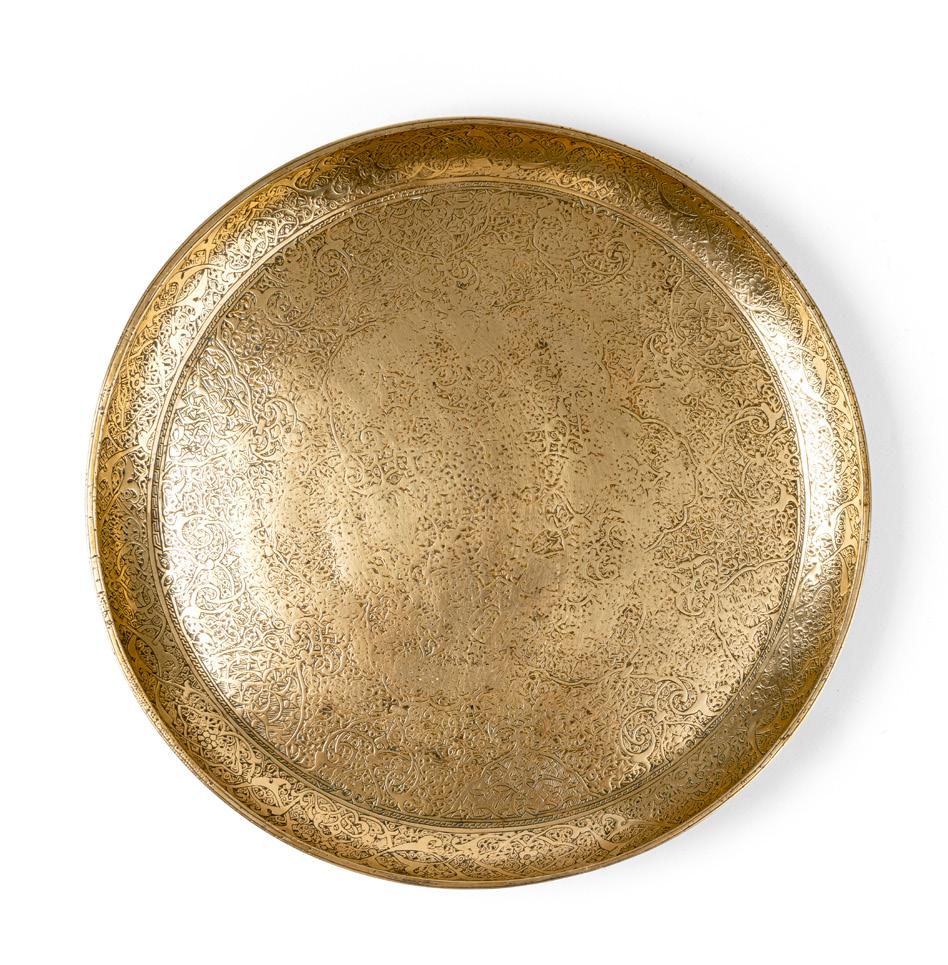

A LARGE AND FINELY ILLUMINATED FRONTISPIECE FROM A MANUSCRIPT OF THE QUR’AN SYRIA OR EGYPT, 14TH CENTURY
ink, gouache and gold on cream paper, laid down on a later sheet of buff paper, text in inner margin in elegant Eastern kufic script finely stencilled with scrolling foliage motifs on a dark blue ground, comprising chapter 56, verses 76-82, the entire central panel decorated with finely drawn floral and foliate scrolls painted in gold, Arabic seal impression at upper left on later sheet, mounted, glazed and framed
Leaf 33cm x 22.5cm; sheet 39cm x 30cm
£2,000-3,000
Provenance: Formerly in a private collection, Amsterdam, formed in the 1980s.
Private Scottish collection.
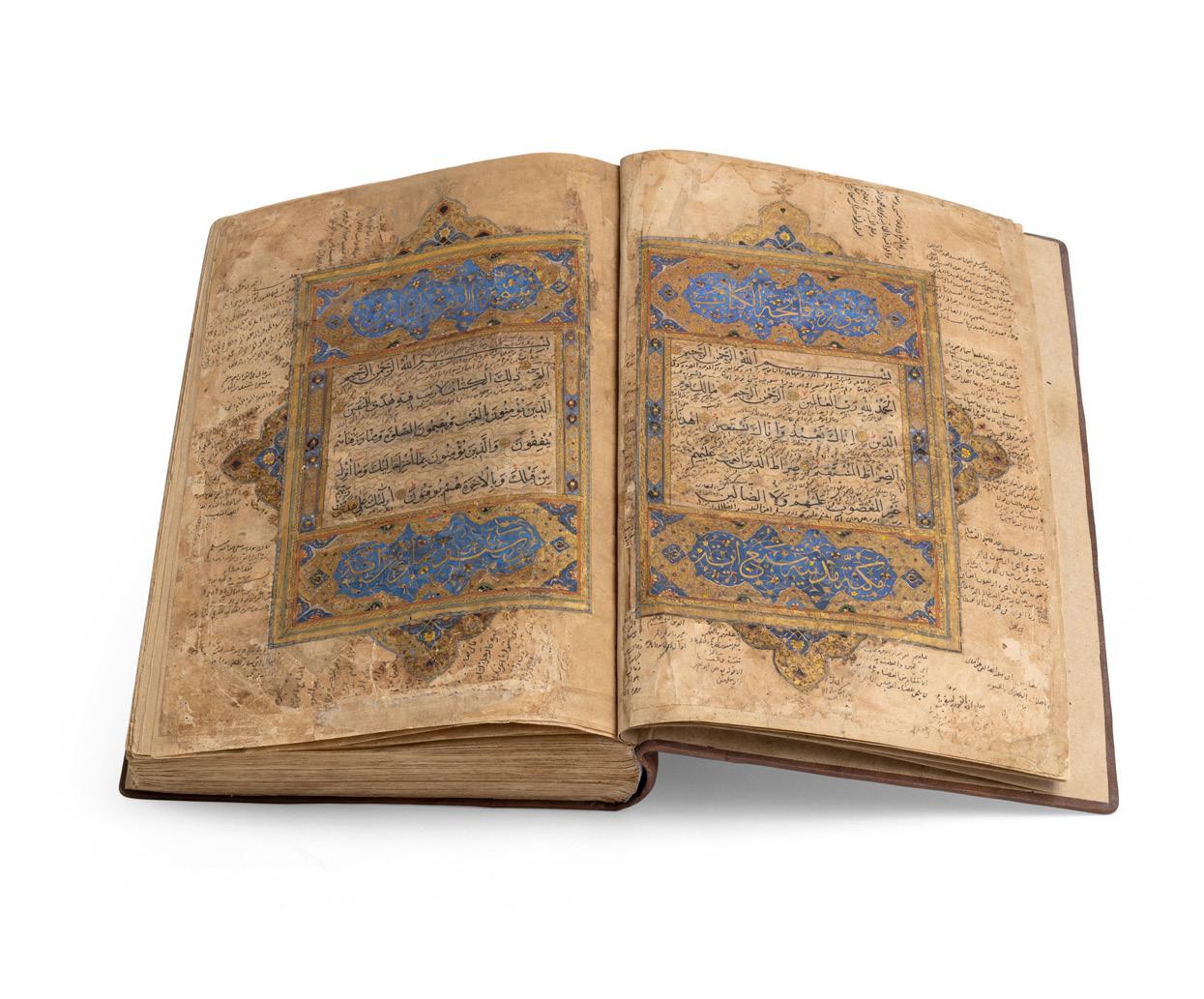
A LARGE TIMURID ILLUMINATED QUR’AN COPIED BY SIBAWAYEH I-KUNJI PERSIA, DATED AH 883/ AD 1478-9
Arabic manuscript on paper, ink, gouache and gold, 348 leaves, 11 lines to the page, written in naskh script in black ink, verses separated by gold dots pointed in blue, Surah headings in red thuluth script within plain panels ruled in blue, text blocks ruled in colours and gold, opening double shamsa comprising blue and gold medallions with scrolling arabesques, further opening double page frontispiece with text within cloud bands, with gold geometric borders, panels above and below with text in large thuluth script in gold reserved against blue grounds decorated with scrolling tendrils, marginal glosses and notes with the text throughout, later red Morocco binding with tooled and stamped decoration cover 35cm x 25.4cm; folio 34.3cm x 23.3cm £6,000-8,000
19
A RARE ILKHANID OR GOLDEN HORDE SILVER CASKET
CENTRAL ASIA, 14TH/ 15TH CENTURY of hexagonal form on three anthropomorphic feet, with teardrop-shaped openwork bosses on each side and each facet of the lid, against a scrolling vegetal design, the bosses flanked by rearing deer 9.5cm high; 7cm diameter.
£3,000-4,000
Provenance: Formerly, the collection of Richard Trescott (1941-2018), London.
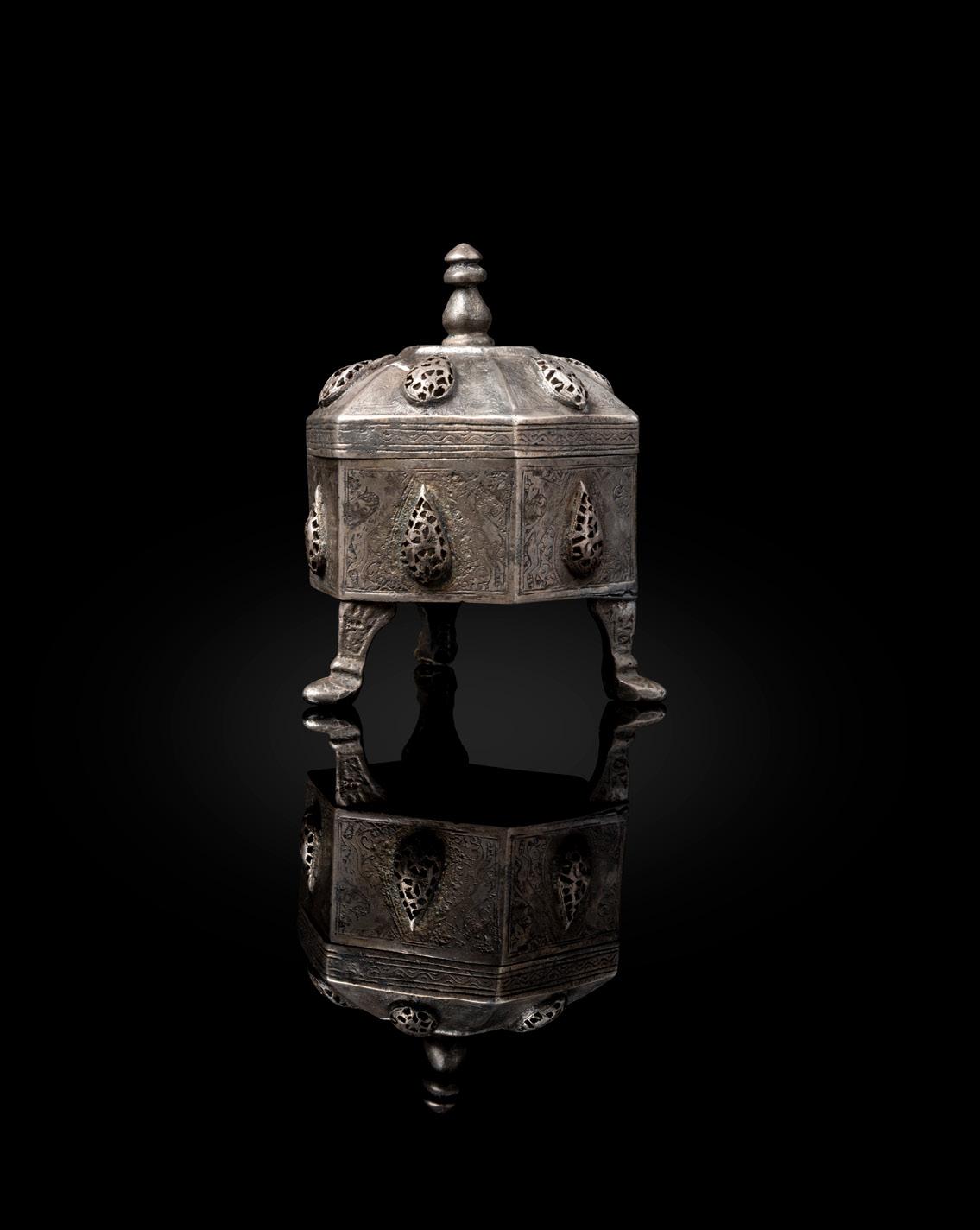
Although there was clearly a taste for precious metal objects among the Mongol rulers of the Golden Horde in Russia and Central Asia and the Ilkhanate in Iran, very little of this has survived. Many such pieces would have been melted down over the centuries. This small but very fine casket is therefore a rare survival from this time, especially as it is in such good condition. The vegetal design of the background is paralleled in silver objects from this period, such as a fine silver-gilt cup in the David Collection (see accession no. 48/1979). Similarly, the openwork bosses are comparable to the silver and gold belt buckles worn as personal adornments by the Mongol elites of Eurasia (see L. Komaroff, The Legacy of Genghis Khan: Courtly Art and Culture in Western Asia, 1256-1353, Metropolitan Museum of Art: 2002, p. 55 fig. 53, cat. 156 and p. 62 fig. 57, cat. 143). The motif of deer among foliage seen on the sides of the casket was also popular among the Mongol elites of Eurasia. It is commonly found on Mongol-era belt mounts, including one which belonged to a member of the ruling family of the Golden Horde. This design appears to have derived from the Jin dynasty of China, conquered by the Mongols in 1234, where it was an element of military regalia (see Mohamed Bashir, The Arts of the Muslim Knight: The Furusiyya Art Foundation Collection, Skira: 2008, p. 130 no. 120).



A STRIKING TIMURID BLUE AND WHITE POTTERY DISH
PERSIA, TABRIZ, 15TH CENTURY
on a short foot of shallow form with flattened rim and scalloped edge, decorated in underglaze cobalt blue on a white ground with five roses to the centre, the cavetto with repeat vegetal designs, and the rim with a Chinese-inspired wave design, three visible kiln stacking marks, with further decoration to the exterior of the rim and cavetto, verso with drilled holes for hanging, intact
31.5cm diameter; 5cm high
£3,000-4,000

Provenance: Euphrosyne Whitaker (1862-1947).
Thence by descent.
Mrs Euphrosyne (Effie) Whitaker, nee Manuel, was a well-known collector and esteemed figure in Palermo, Sicily. She was married to Joshua Whitaker and together they built a strong legacy in Palermo, including assisting with the foundation of a sports club which today is known as the football team, Palermo FC.
Like their Mongol ancestors before them, the Timurid rulers of Iran and Central Asia enjoyed strong cultural links with China. Such a connection is clearly visible through their taste for locally-produced blue and white ceramics such as this dish. It forms part of a larger group of which the decoration and form were inspired by 15th century Chinese Ming originals. Although there were a number of production sites in both the east and west of their empire, Tabriz is known to have produced the most aesthetically and technically impressive examples (see J. Soustiel, La céramique islamique, Office du Livre: 1985, p. 216). The cusped rim and wave pattern on the rim can be seen on an early 16th century dish in the British Museum (1965,0729.1), and the foliage on the cavetto is very closely paralleled by that on a dish in the Ashmolean Museum (EA1978.1740) (see L. Golombek, Mason, R.B., and Bailey, G.A., Tamerlane’s Tableware: A New Approach to Chinoiserie Ceramics of Fifteenth- and Sixteenth-Century Iran, Mazda Publishers in Association with Royal Ontario Museum: 1996, pp. 152, 154). A dish with a near-identical main design of five roses was sold at Sotheby’s, Arts of the Islamic World & India, 25 October 2023, lot 139.
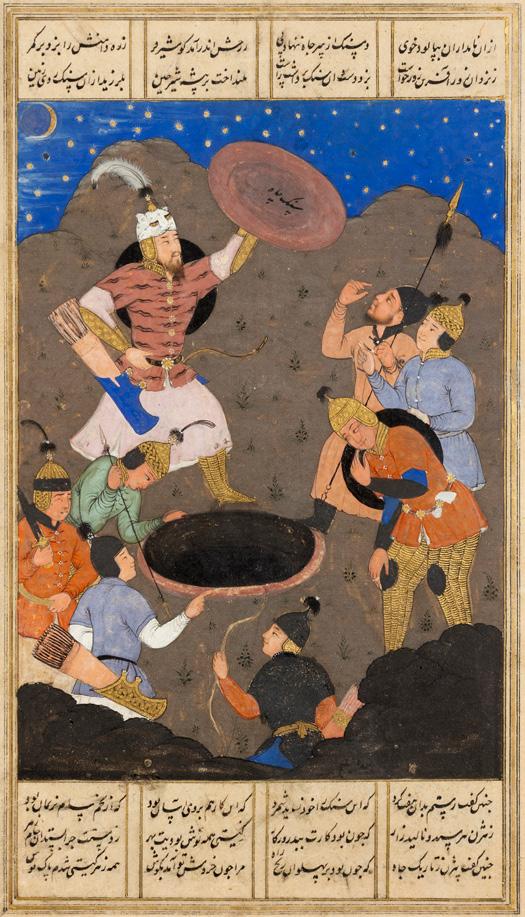
AN ILLUSTRATED FOLIO FROM A DISPERSED MANUSCRIPT OF FIRDAUSI’S SHAHNAMEH: RUSTAM SAVES BIZHAN FROM A WELL
CENTRAL ASIA, BOKHARA, CIRCA 1670
ink, gouache heightened with gold on paper, the image set within four columns of nasta’liq text with gold rules, two lines above, and three lines below, the text continues on the reverse, within a mountainous landscape under a moonlit and starlit sky, Rustam is wearing his characteristic tiger-striped tunic and holding the lid of a well up high in his left hand with a look of triumph, three soldiers are peering in the well, whilst three figures on the right are standing, one holding a spear looking impressed, mounted, glazed and framed 25.1cm x 16.8cm
£3,000-4,000
Provenance: Formerly, the collection of Octave Homberg (French, 1876-1941).
Sale, Paris, Galerie Georges Petit, Collection de Octave Homberg, 3-5 June, 1931, no. 103.
The Shahnameh or Persian Book of Kings, an epic that recounts both the mystical and real history of Persia, contains many tales of the hero Rustam in which he meets a series of challenges and fights a variety of demons and monsters. Here he is taking the lid off a well to save Bizhan, who has been imprisoned within it. Bizhan was the son of Giv, a friend of Rustam’s. The princess Manizha had drugged her lover Bizhan and taken him to her palace. This annoyed her father Afrasyab, who put Bizhan in chains and threw him into a well. Later Manizha was able to lead Rustam and his followers to the pit. The extremely heavy rock covering the well had belonged to the div (demon) Akvan whom Rustam had killed. Rustam mustered the strength to lift it and hurl it back to China and the lovers were reunited.
This miniature comes from a manuscript that was offered for sale in Paris in 1931 as part of the collection of Octave Homberg, the pages of which have since been dispersed. This manuscript was described in the catalogue as a collection of “Epopees du Cycle Saitanais”. The manuscript took the very rare form of extracts from the main epics of Persian history, the Shahnameh of Firdausi; the Faramouznameh; the Bahman Nameh and the Nariman Nameh. The manuscript originally had a frontispiece decorated with eighty-five paintings, the main ones signed by Mohammed Moqim and Mohammad Salim. Some other miniatures from this manuscript reappeared at auctions in Paris and London. Other paintings by the two principal artists of this Homberg manuscript can be seen in a manuscript illustrating the lyric poems of Nizami, copied and illuminated in Bokhara in 1670 for the library of Sultan ‘Abd-al Aziz Bahadur Khan (1945-1680), now in the collection of the Chester Beatty Library in Dublin.
For a recent study on the painters of Bokhara, see Y. Porter, Farhad the Painter, in connection with the painting workshops of Bukhara in the time of ‘Abd-al Aziz Khan, 1645-1680, in The Timurid Heritage: Iran, Central Asia, India, XVth-XVIIth centuries, Cahier d’Asie Central, IFEAC, 3-4, 1977, p. 267.
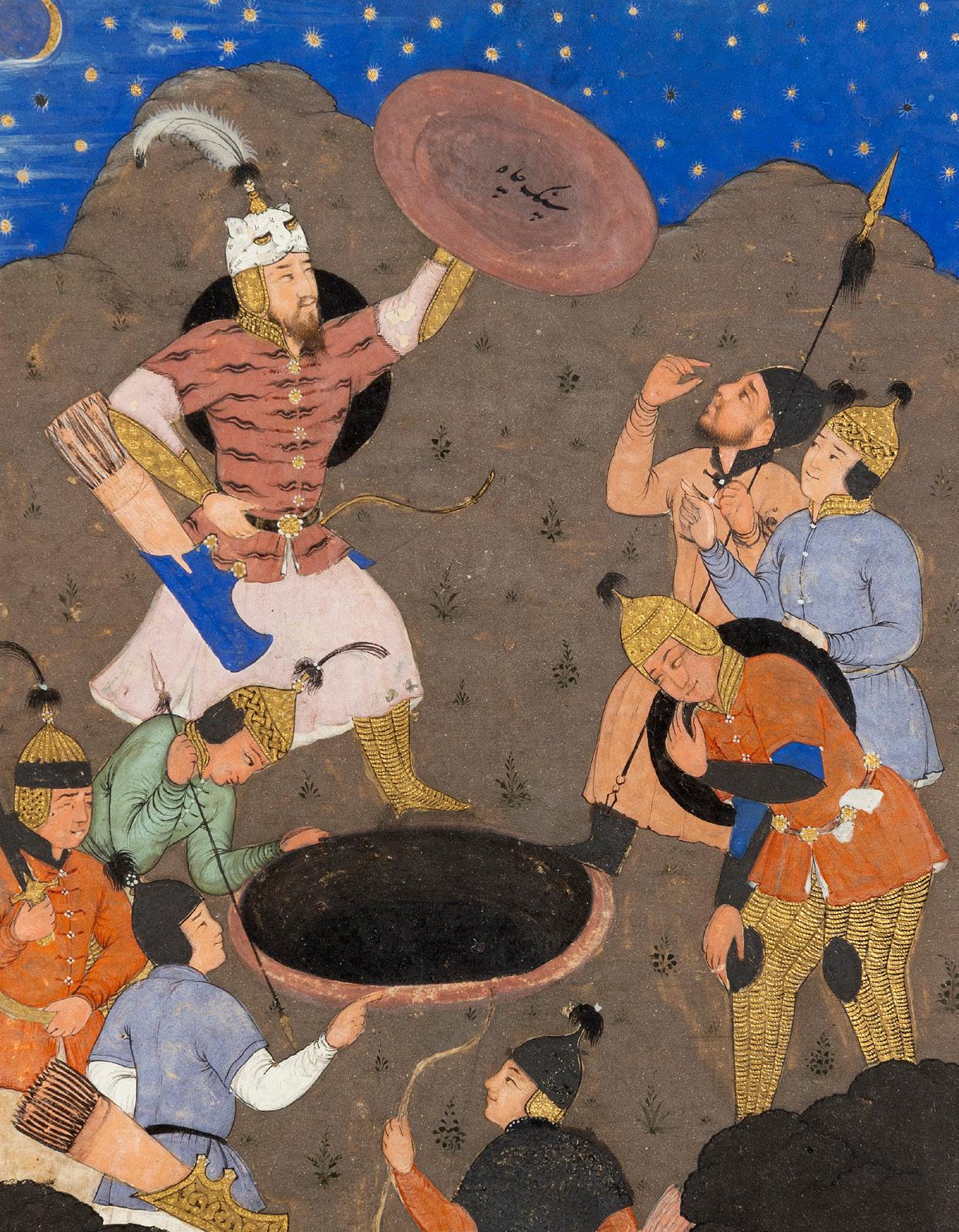
22
A SAFAVID DRAWING WITH ILLUMINATED MOUNTS PERSIA, 17TH CENTURY
gouache and gold on paper, depicting a lady kneeling and resting against a vivid blue bolster cushion with gold embroidery, holding a cup between two fingers and a metal bottle in the other hand, a bowl of oranges before her, in a landscape covered with flowers and bushes, within a border of cut and pasted panels containing empty gold cartouches on a cobalt blue ground with delicate floral detail, mounted, glazed and framed
21.5cm x 14cm
£2,000-3,000
Provenance: Formerly, the Estate of costume designer Anthony Powell (1935-2021).
Powell was an English costume designer for theater and film. Working with notable directors such as Steven Spielberg, Roman Polanski, and William Friedkin, Powell showed his versatility and wide-ranging design skills. His projects encompassed everything from period films to modern and contemporary. He won three Academy Awards for his costumes and was active in the entertainment world for over 40 years. Powell is doubtless best known for his work on films such as the Indiana Jones trilogy (1981, 1984 and 1989) and 101 Dalmatians (1996).
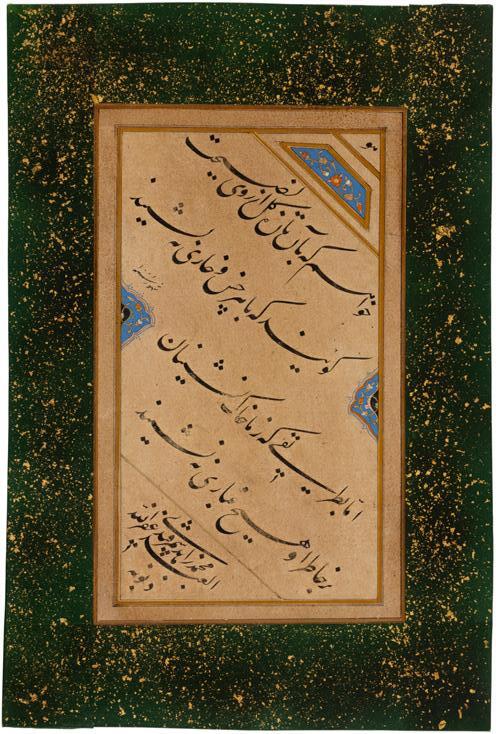
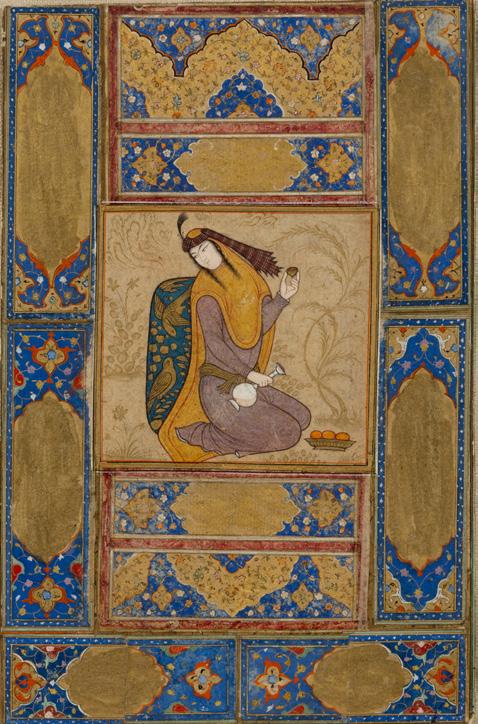
A NASTA’LIQ PANEL OR QIT’A
PERSIA, SIGNED MUHAMMAD ZAHID SAMARKANDI, DATED AH 1001/ AD 1592-3
ink on paper laid down on an album page, gold margin rules, green border sprinkled in gold, with four diagonal lines of elegant nasta’liq script, verso with old inventory label
Folio 30.8cm x 20.7cm
£800-1,200
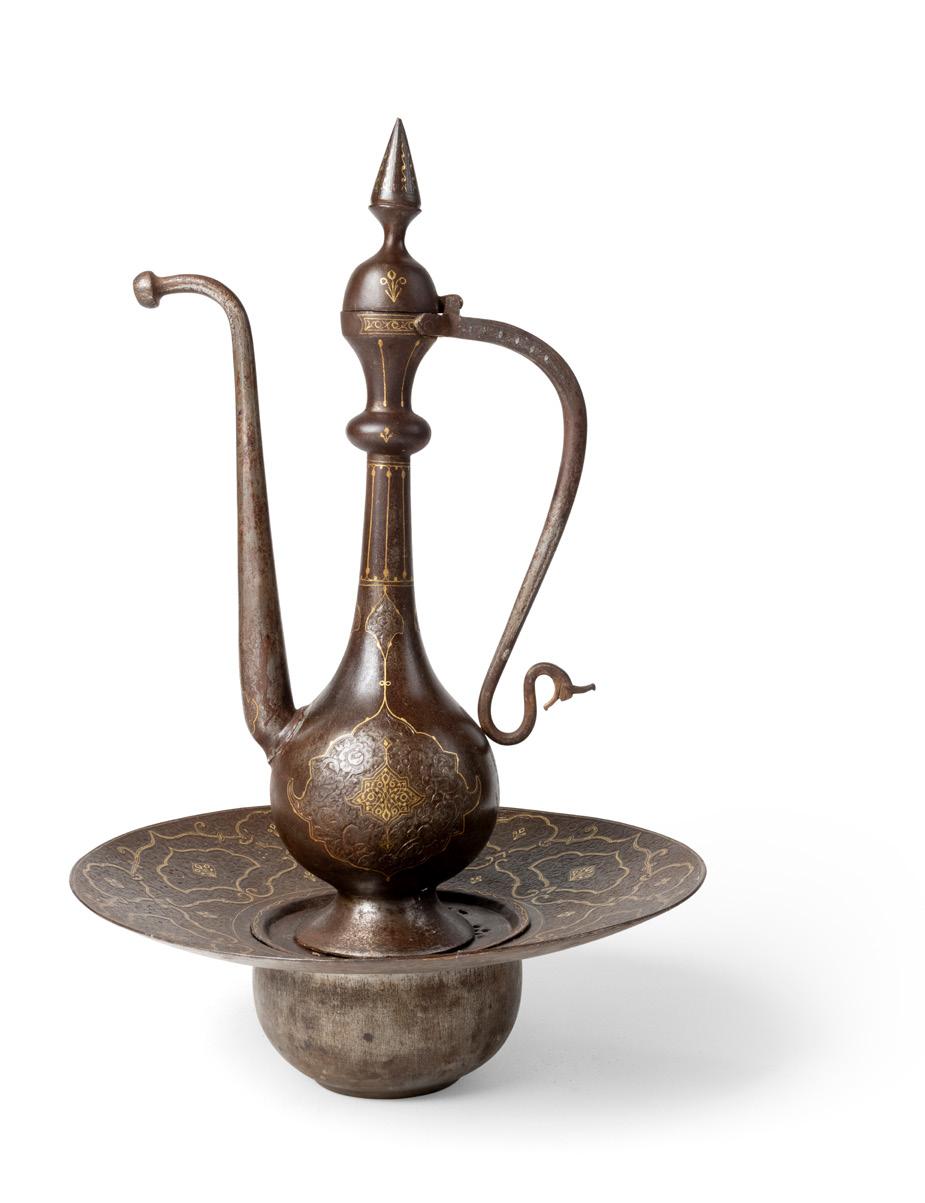
A QAJAR GOLD DAMASCENED STEEL EWER AND BASIN PERSIA, 19TH CENTURY
the ewer of piriform on a splayed foot with hinged lid, long tapering spout and ‘s’ shaped handle, the basin of typical form with circular lid decorated in openwork, profusely engraved and decorated in gold and silver inlay with cartouches containing floral sprays on grounds of engraved floral interlace
Ewer 41.2cm high; basin 31.5cm diameter
£3,000-5,000

A RARE QAJAR GILT-COPPER HELMET DECORATED WITH HUNTING SCENES PERSIA, 19TH CENTURY
of dome-shaped form, profusely decorated in lower relief with Persian hunting and battle scenes, bands of square pseudo-kufic around the top of the helmet finial and around the edge of the rim of the helmet, the edge pierced with holes with remains of chainmail
19.4cm high, 20.5cm diameter
£2,000-3,000



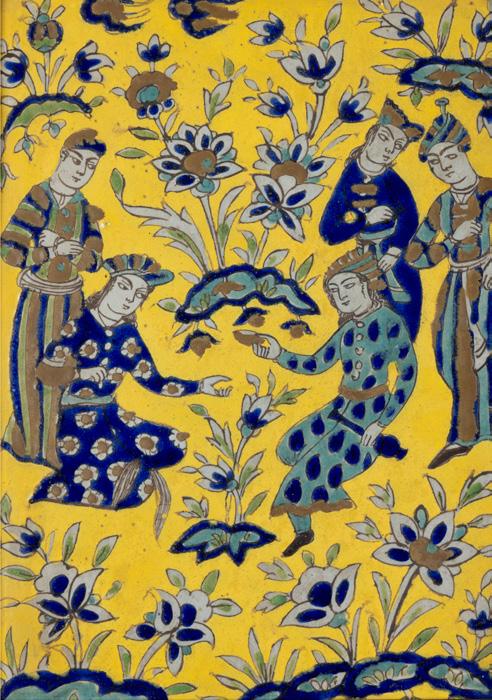
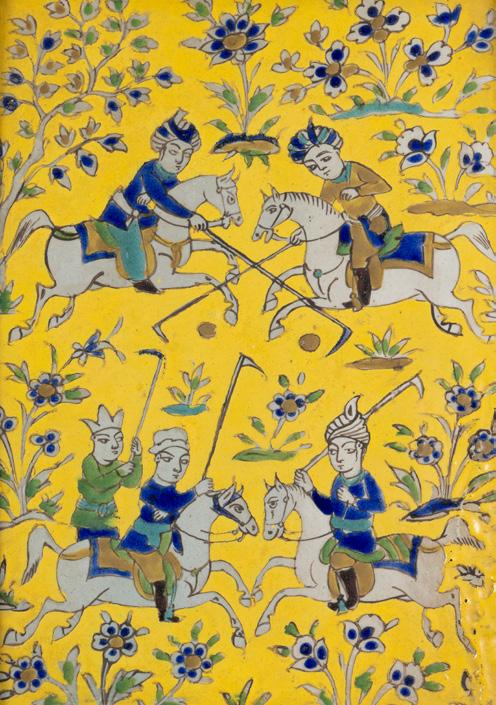
A STRIKING PAIR OF QAJAR CUERDA-SECA POTTERY TILES: COURTIERS IN A GARDEN AND POLO PLAYERS PERSIA, 19TH CENTURY
each of rectangular form and decorated in portrait format on a bright yellow ground, one depicting five courtiers in a garden with flowers and water features, two Chinese-inspired cloud scrolls above, the other depicting a game of polo with two horse riders in mid-play scrambling over balls, and three below with their sticks raised above, against a floral landscape, framed each 32cm x 23cm; framed 37.5cm x 28cm
£4,000-6,000
Produced in the cuerda-seca (dry cord) technique, the present pair of tiles depict courtiers having a conversation in a garden and polo players on horseback. The yellow in the background gives a striking look to the pair. Both tiles belong to a much-favoured category found in many pieces of Qajar art, the depiction of courtly life and its activities. Polo, chawgan in Persian, was a game very much enjoyed by the royals in Persia and central Asia. It was introduced to India primarily by Persianate courts. The Mughals played a significant role in spreading polo in India, and it was later adopted as ‘polo’ by the British during the British Raj in the 1850s.
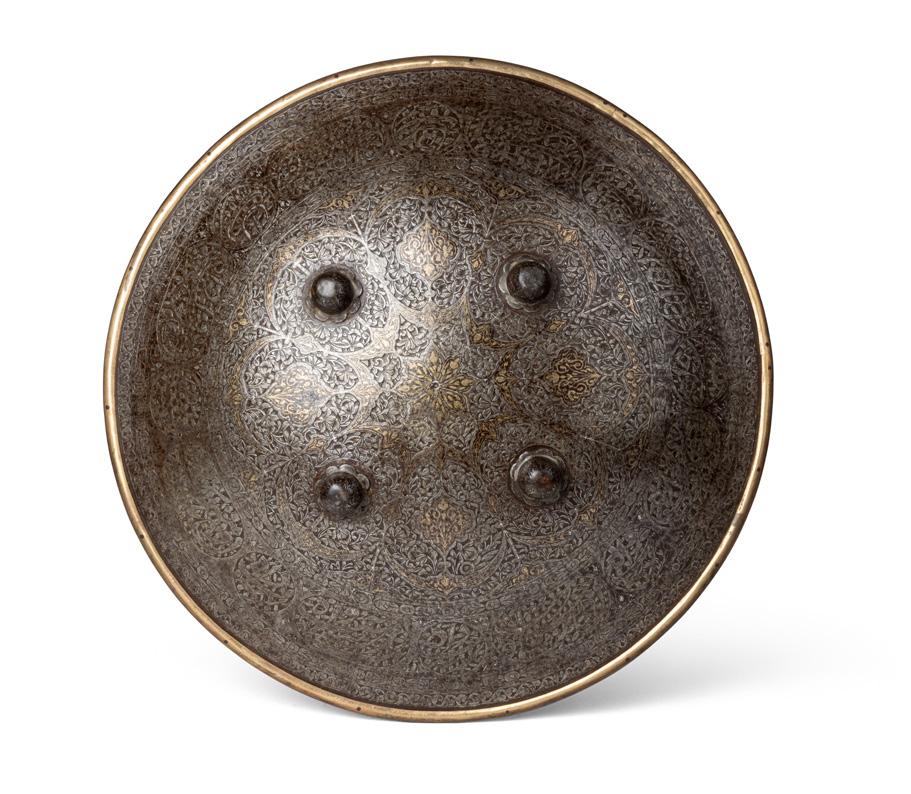

27
A QAJAR GOLD-DAMASCENED AND ENGRAVED STEEL SHIELD PERSIA, 19TH CENTURY
of typical form with four raised circular bosses, the surface profusely engraved with floral and vegetal motifs centred around an eight-pointed flowerhead, with a band of inscription-filled cartouches around the rim, probably comprising Persian verses 46.5cm. diameter
£800-1,000
For a very similar shield sold through these rooms, see Islamic and Indian Art, 11 December 2024, lot 38.
28
AN ILLUSTRATED FOLIO FROM FIRDAWSI’S SHAHNAMEH: THE BATTLE BETWEEN TUS, SON OF NAWZAR, AND HUMAN
QAJAR PERSIA, 19TH CENTURY
black and red ink, gouache and gold on paper, the inscriptions in nasta’liq divided into 5 columns, with an illustration in the bottom half depicting two warring armies on horseback waiting behind a mountain, two horsemen in the foreground in battle with a horse on the ground to the left
36.3cm x 24.9cm
£400-600
29
ROSES AND A NIGHTINGALE OR GUL-O-BULBUL
QAJAR PERISIA, 19TH CENTURY
watercolour on paper, orange and blue-lined border, depicting an elegant nightingale bird standing in a rose bush with a butterfly above it, mounted, framed and glazed Sight size 21.5cm x 14.5cm
£1,500-2,000
The gul-o-bul-bul, or rose and nightingale, motif is employed in both Persian literature and painting. In poetry, the two represent the beloved and the loved, entwined in either an earthly or divine union. In art, the motif appears on all types of objects, and during the Qajar period proliferated to the extent that it became synonymous with the country itself. It became especially popular among European collectors, who demanded goods and albums decorated with this motif.
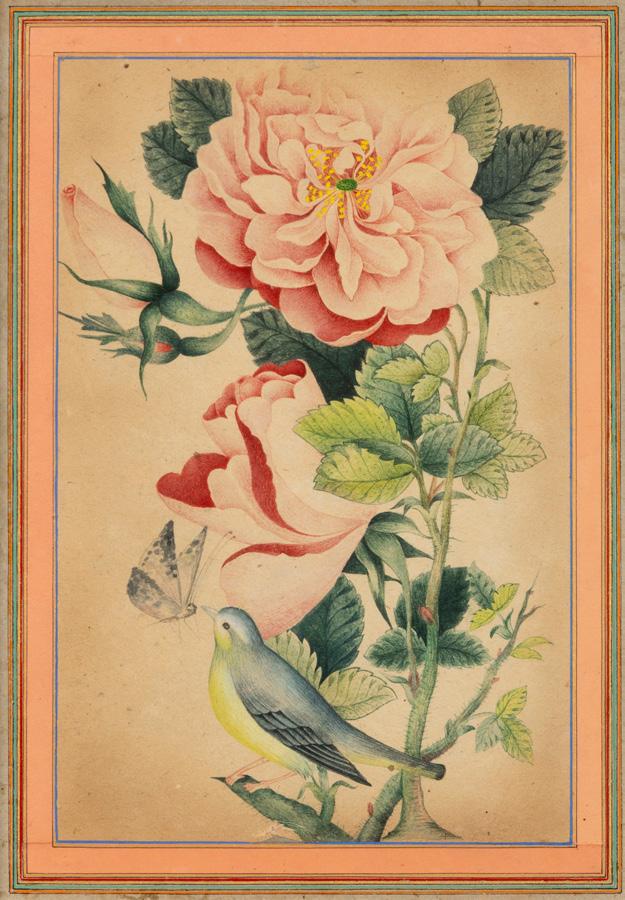
30
A QAJAR PIERCED BRASS CASKET WITH MYTHICAL FIGURES
PERSIA, 19TH CENTURY
of rectangular form on four stepped feet, the pierced openwork decoration with courtiers, acrobats, horsemen, divs and with feline battling with a serpent in medallions on dense foliated ground, the slightly domed lid with a central panel depicting seated male courtiers within a vegetal landscape, with handles to either side
18.2cm x 21.4cm x 15.6cm
£1,000-1,500

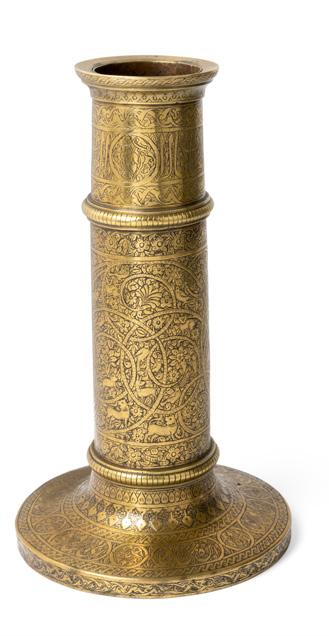
31
A QAJAR ENGRAVED BRASS CANDLESTICK
PERSIA, 19TH CENTURY
of slightly tapering cylindrical form on a splayed foot with flaring rim, two raised bands to shaft, profusely engraved with spiraling vines on which stand various animals and birds against a ground of vegetal and floral designs, above and below a band of inscription-filled medallions and cartouches comprising Persian verses
33cm high
£500-700
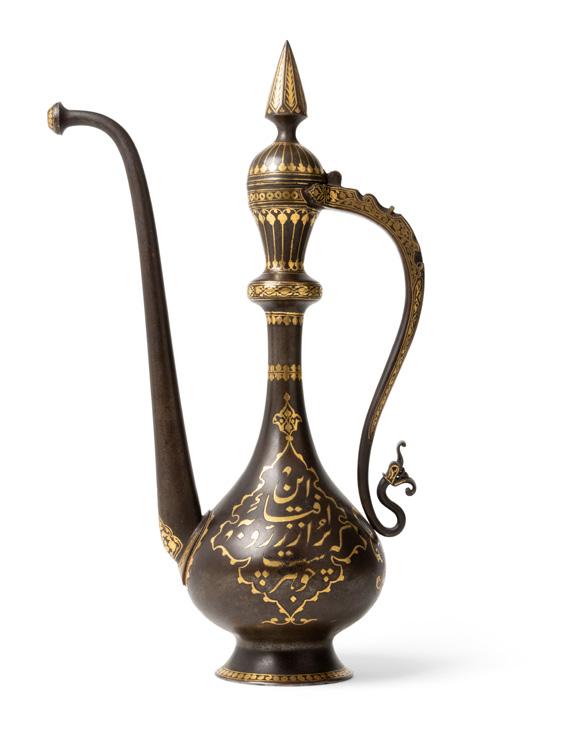
32
A QAJAR GOLD DAMASCENED STEEL EWER
PERSIA, 19TH CENTURY
of baluster form on a splayed foot, with tall curving spout and ‘S’-shaped handle with dragonhead-shaped terminal, the hinged domeshaped lid with faceted pointed finial, either side of the body decorated with a cusped cartouche containing inscriptions in nasta’liq
39cm high
£1,000-1,500
The inscriptions comprise a couplet in Persian: ’This ewer, which is full of gold and sheen, is worthy of the presence of the lord of the land’
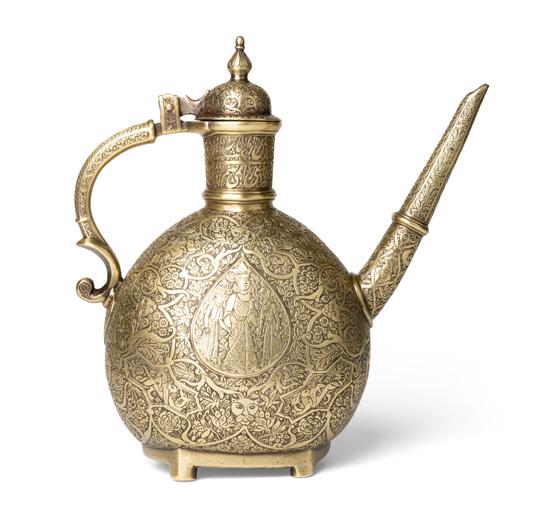
33
A MUGHAL STYLE EWER MADE FOR THE QAJAR MARKET
INDIA AND PERSIA, 19TH CENTURY
of squat pear-shape, with long protruding spout and S-shaped handle, profusely incised and decorated in low relief in the Qajar-style with images from a Persian Epic, including figures in the central tear-shaped medallion on either side, the remaining body with interlace, cartouches with animals and their prey, and a ground of vegetal designs, two bands of inscription around the neck, comprising verses from the preface of Sa’di’s Gulistan
27.1cm high
£500-700
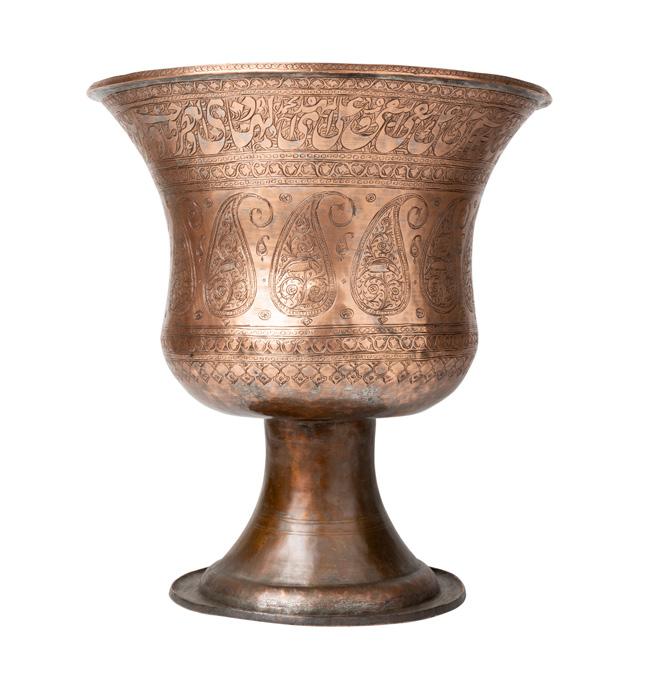
34
A LARGE QAJAR
TINNED-COPPER
PERSIA, 19TH CENTURY
ENGRAVED VASE
of waisted flaring form on a long splayed foot, the body engraved with a frieze of repeat boteh decorated with birds perching amidst scrolling vines, the neck with a large band of inscriptions on a ground of floral interlace flanking an inscription-filled cusped cartouche, remnants of tin
36cm high; 32.5cm diameter
£1,000-1,500
The inscriptions, in a poor hand, include The call to God to bless the Fourteen innocents.
For a comparable vase, see Bonhams, Islamic and Indian Art, 23 May 2023, lot 90.
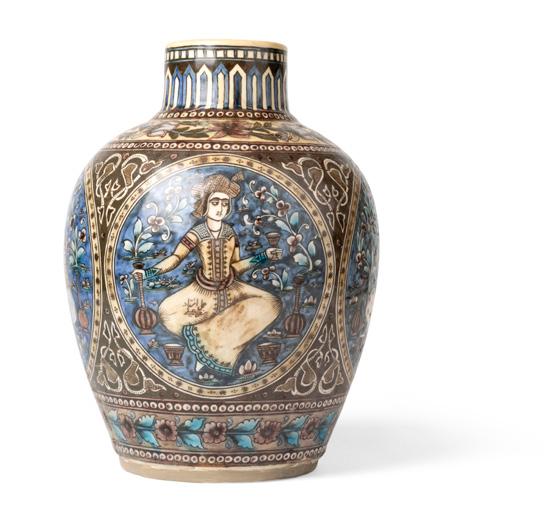
35
A QAJAR UNDERGLAZE PAINTED POTTERY JAR DEPICTING COURT PLEASURES
PERSIA, SIGNED BY ‘USTAD SAFER ALI’, 19TH CENTURY of squat pear-shape with short cylindrical neck, decorated in polychrome on a predominantly brown and blue ground with four large medallions containing figures in a landscape including a musician, maidens sampling wine, and a courtier sampling wine, the latter medallion with the artist’s signature
32.8cm high, 21.8cm diameter
£800-1,000
For a large Qajar tile signed by the same artist, see Christie’s, Art of the Islamic and Indian Worlds, 17 April 2007, lot 264.
36
A QAJAR UNDERGLAZE PAINTED POTTERY BLUE AND WHITE JAR
PERSIA, 19TH CENTURY
of pear-shape with everted rim, decorated in two shades of blue, brown and black outline on a white ground, with Chinese-inspired floral landscape with birds, deer and foliage
25.2cm high
£500-700
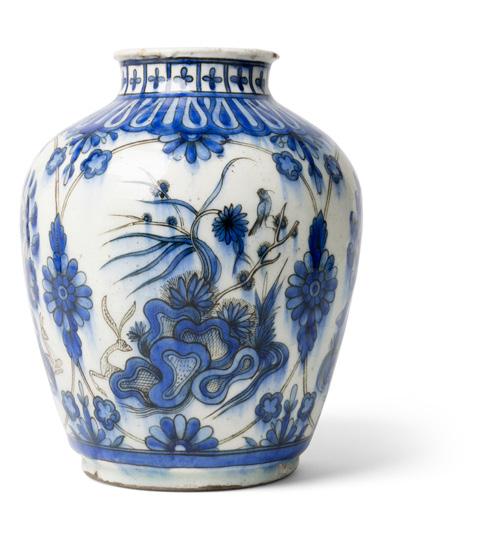
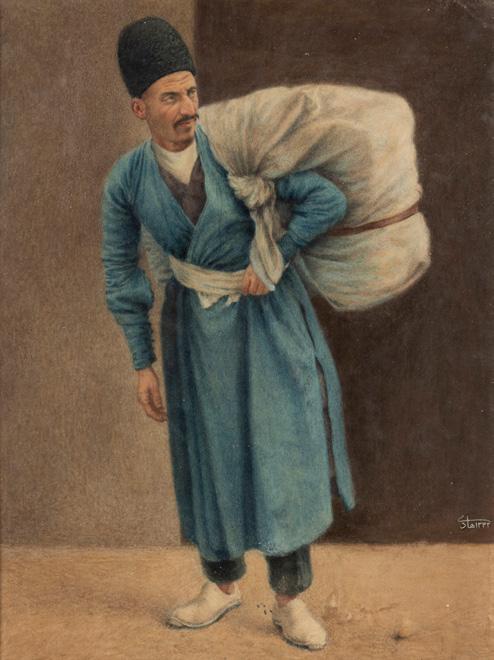

37
A MAN CARRYING A WHITE SACK AND A SEATED LADY CRUSHING HERBS AND SPICES
PERSIA, MEHDI TAYEB, MID-20TH CENTURY
watercolour on paper, the man image signed lower right: ‘Hadi 1342 (AD 1963-4); the female painting signed lower right: Mehdi Ta’eb 1344 (AD 1965-6), each mounted, glazed and framed
Man 34cm x 25cm; female 33.8cm x 25.4cm
£3,000-4,000
Mehdi Tayeb was a reputable painter in Iran in the mid-20th century and known for his depictions of rural life. For another painting by him sold through Bonhams, see, Islamic and Indian Art, 6 April 2006, lot 75.
38
A SUITE OF BOHEMIAN GLASSWARE MADE FOR THE ISLAMIC MARKET FRANCE, 19TH CENTURY
comprising a bottle with stopper, bowl and dish, all in opaline turquoise coloured glass with gilt and enamel decoration consisting of cusped cartouches and floral designs
Bottle 50.5cm high; bowl 14.4cm diameter; dish 18cm diameter
£1,200-1,800
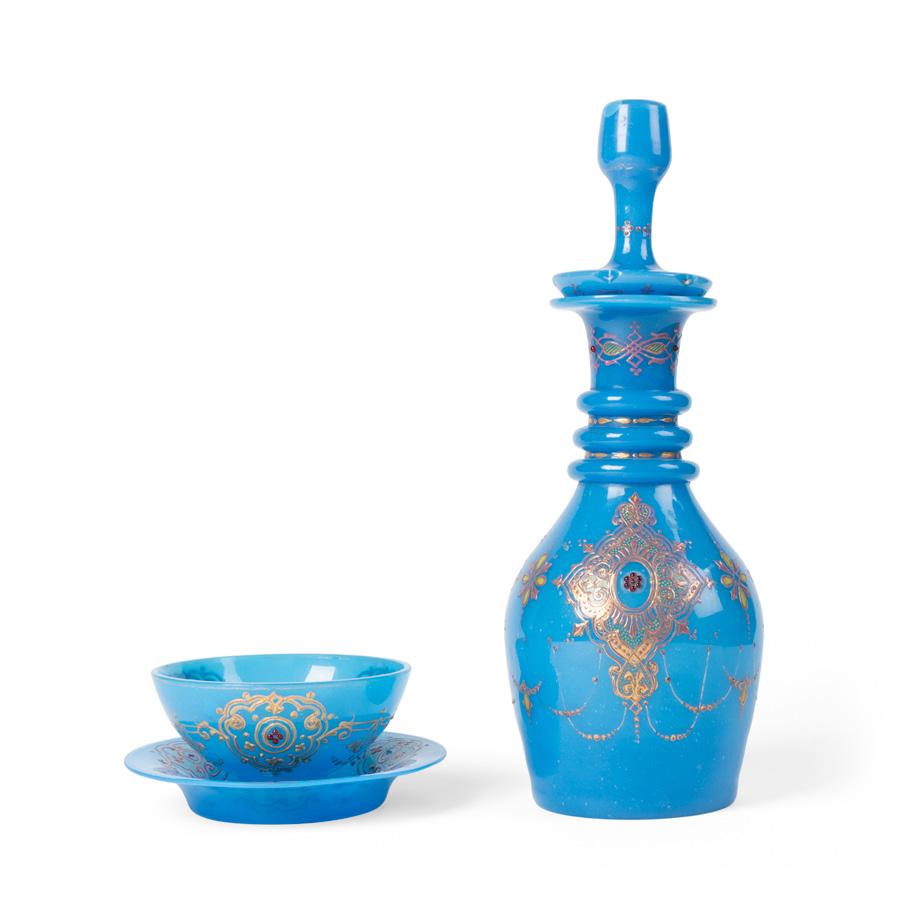
OTTOMAN MANUSCRIPTS & WORKS OF ART
39
AN ILLUMINATED OPENING BI-FOLIUM OF AN OTTOMAN PRAYER BOOK (DALA’IL AL-KHAYRAT)
TURKEY, 18TH CENTURY
Arabic manuscript on paper, 11 lines to the page written in naskh in black ink, verses separated by gold roundels with red and blue dots, within gold and black rules, gold and polychrome illuminated headpiece with scrolling floral vines issuing from a central cusp surmounting a cusped cartouche comprising an inscription in thuluth written in white, within gold floral margins, mounted, framed and glazed
Sight size, each 17.5cm x 11cm
£2,000-3,000
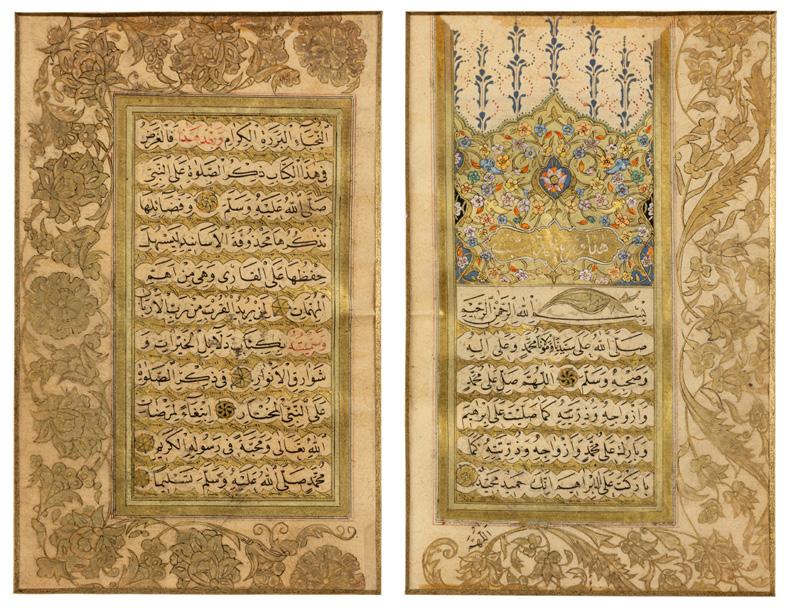
40
AN OTTOMAN CALLIGRAPHIC EXERCISE
TURKEY, 18TH CENTURY
Arabic manuscript and black ink on paper, starting with one line in thuluth script, followed by one line in naskh script with verses separated by gold roundels with blue dots, comprising Arabic verses and a quotation from al-Busiri’s Qasidat al-Burda, followed by four lines in smaller naskh script with gold separation dots comprising traditions of the Prophet, the two lower corners with gold floral decoration, blue margin with orange outer rule, mounted, framed and glazed
Sight size 25.2cm x 15.2cm
£2,000-3,000

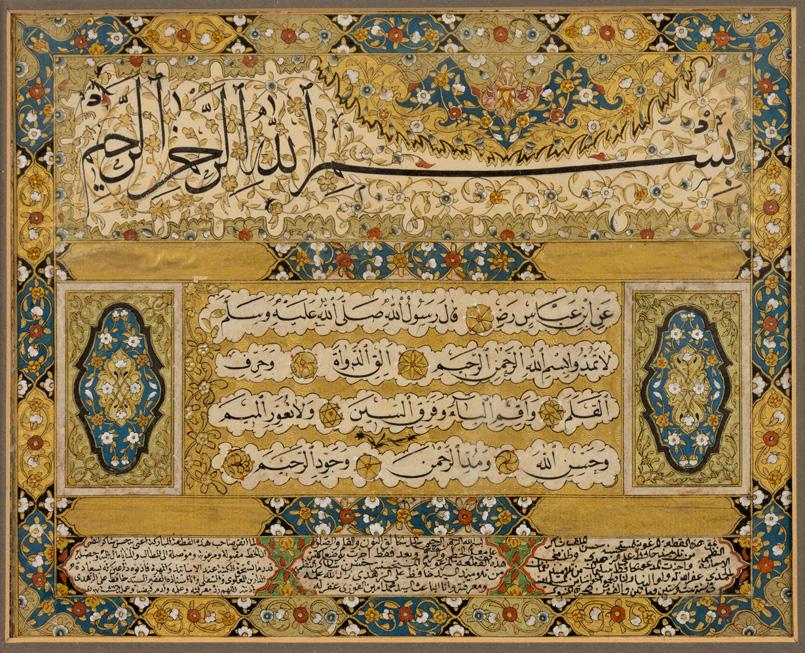
A STRIKING OTTOMAN ILLUMINATED CALLIGRAPHER’S DIPLOMA (IJAZEH OR ICAZETNAME) TURKEY, AWARDED TO HASAN SAKIR AL-NAZMI, DATED AH 1266/ AD 1849-50
Arabic manuscript on paper, black ink, gouache and gold on paper, the large script in thuluth above proclaiming the bismillah against a a ground of gold scrolling leafy vines, followed by four lines in naskh script, three cusped cartouches below each comprising five lines in smaller thuluth script, the interstices and borders filled with gold scrolling leafy vines and polychrome floral cartouches, outer margin with a band of repeat floral-filled cartouches, mounted, framed and glazed
Sight size 18cm x 22cm
£5,000-7,000
During the Ottoman Empire, it was common practise for calligraphers to produce their final work, ijazeh or icazetname. Not only are these documents attractively decorated but they also act as an historical document. They usually begin with the bismillah, in so doing giving thanks to God for the capacity to write, followed by the name of the student and the date, and end with signatures by the calligraphers’ tutors.
In the case of this diploma it has been signed by three tutors: Hafiz ‘Ali al-Zuhdi, Hafiz Sulayman and Seyyid Mehmed Emin Fevzi.

A RARE OTTOMAN WOOD PANEL WITH THE IMPERIAL COAT OF ARMS OF SULTAN ABDULHAMID II (R. 1876-1909)
TURKEY, CIRCA 1900 of square form, carved in high relief with the Ottoman coat of arms of Sultan Abdulhamid II backed with symbolic objects, surmounted with Sultan Abdulhamid II’s tughra
49cm x 44cm
£7,000-10,000
Every sultan of the Ottoman Empire had his own imperial monogram, called the tughra, which served as his royal signature. The Ottoman imperial coat of arms in the European heraldic sense was created in the late 19th century. Abdulmecid I (r. 1876-1909) was made a Stranger Knight of the Garter by Queen Victoria, which required him to provide a coat of arms to be placed alongside those of his predecessors. As there was no existing Ottoman coat of arms a new one had to be invented, the design of which was finalised by his successor Abdulhamid II (r. 1876-1909) on April 17, 1882.
This panel features Abdulhamid II’s imperial coat of arms in all its glory, including a variety of firearms from cannons to revolvers, swords, pikes and halberds, the scales of justice, the books of Shari’a and western-style law, the two flags representing Islam and the Ottoman Empire, and even the diamond-set brooches of the five main Ottoman orders of excellence at the bottom. Despite the visual complexity of the arrangement, the tughra included at the top is finely carved and fully legible. This composition has been described by the historian Edhem Eldem as “no fewer than thirty-six items that formed a grandiose… allegory for a dying empire”, but it was heavily promoted by the Sultan himself and came to be closely associated with his reign (see E. Eldem, “The Changing Design and Rhetoric of Ottoman Decoration, 1850-1920” in The Journal of Decorative and Propaganda Arts, Vol. 28, Turkey (2016), pp. 39-40).
The only comparable panel carved on wood with the tughra of Sultan Abdulhamid II is in the reading room of the Istanbul University Library. This example is located at the top of the main bookcase, and was in fact produced by Sultan Abdulhamid himself as he was a master carpenter. The bookcase was originally located in the Yildiz Palace Library, founded by Sultan Abdulhamid II, but was moved to the university on the orders of Mustafa Kemal Ataturk.
THREE IZNIK TILES WITH NOBLE EUROPEAN PROVENANCE
Each of the following three Iznik tiles are accompanied by handwritten notes dated to 1905. Whilst two of the notes have been detached from the tiles (see fig. 1a and 1b), they still have remains of the seal wax that was used to attach them. Lot 45, however, still has its note securely attached on the reverse (see fig. 2).
The note reads in French:
‘3 morceaux de faïence, provenant de mosquees qui m’ont ete données de la part de sa mere par le jeune Marcel van der Elst et qui proviennent de la collection de son grandpere. Conple. 14 juin 1905’
Which translates as:
‘Three pieces of pottery from mosques that were given to me by the mother of the young Marcel van der Elst, and that came from the collection of his grandfather. Constantinople 14 June 1905.’
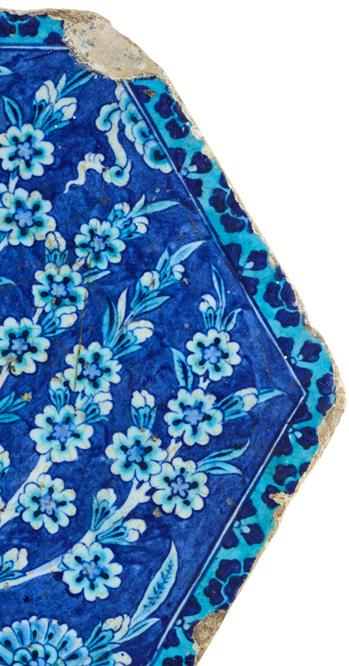
Two of the notes are written in the hand of Count Frederick van der Steen de Jehay (1858-1916), the recipient of the Iznik tiles, who served as a distinguished politician and diplomat. Most notably, he was posted as special envoy to Istanbul from 1897-1905. The end of his appointment coincides with the year these tiles came into his possession, suggesting that they may have been given to him to mark the end of his tenure.
After his tenure in Istanbul, he was made Chief of Cabinet of the Belgian Ministery of Foreign Affairs. His wife, Henriette (1873-1957) was lady-in-waiting to Queen Elisabeth, wife of King Albert I of Belgium. Frederick and Henriette bore no children, and the tiles would have been inherited by her sister, Jeanne Snoy (1878-1955) who married Count Charles de Jourda de Vaux (1865-1946).
It is through this line that the tiles were inherited by the late Sir Bernard Kelly’s wife, Marie-Noelle Kelly, niece of Jeanne Snoy, and have remained in the family since.
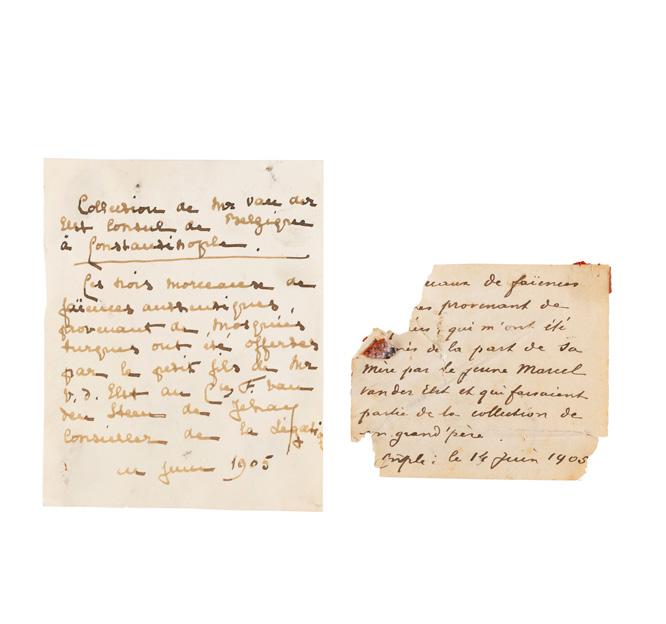
Fig. 1A
Fig. 1B
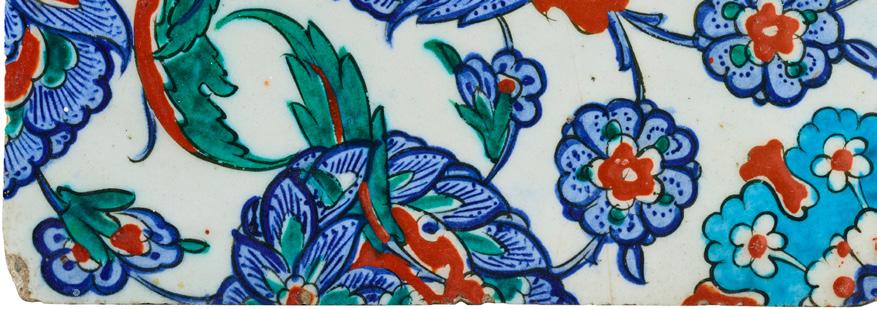
The grandfather of Marcel van der Elst is named as M. v. d Elst within a note written in a different hand (see fig. 1a). The name is likely to refer to Leon Baron van der Elst (1865-1933), a highly distinguished diplomat, negotiator, and was most notable for being the foreign affairs advisor to King Leopold II of Belgium from 1906 to 1918. In an historical biographical account, (see http://www.ars-moriendi.be), Baron van der Elst put Count ven der Steen de Jehay forward as chief ‘ad interim’ of the King’s cabinet from 1916 up until his death, highlighting the esteem the Baron held for the Count.
Although there are no further provenance details for the other two tiles, the prior history of the piece from the Çinili Hamam, lot 43, is known.
An anonymous document addressed to Sultan Abdülhamid II states that a French antiques dealer, Ludovic Lupti, had stripped the hamam of its tiles around 1874 and subsequently taken them to France, paying pennies for each of them. From Paris he sold them to museums and collections across the continent for the princely sum of 24 francs each. This appears to have been the sole point of dispersal for all the tiles from this group, which can now be found in major collections in France, the UK, and Türkiye (see Özbay and Şengozer, Barbarossa’s Cinili Hamam: A Masterpiece by Sinan, 2023, pp. 52, 266).
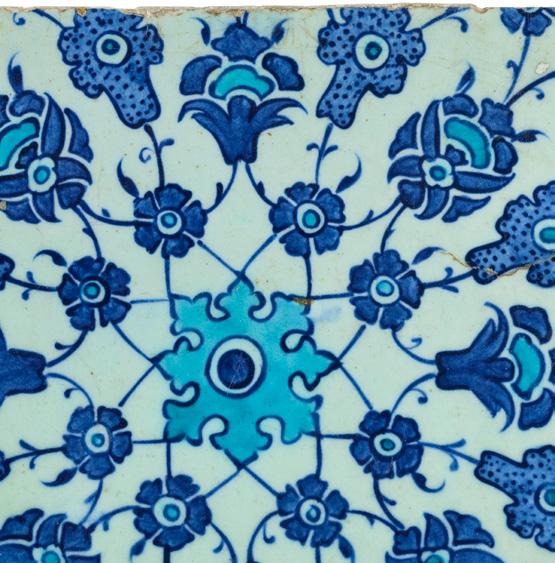
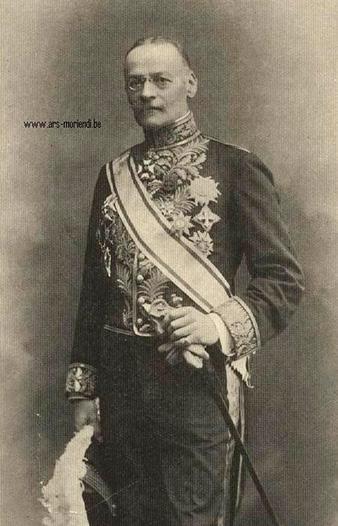
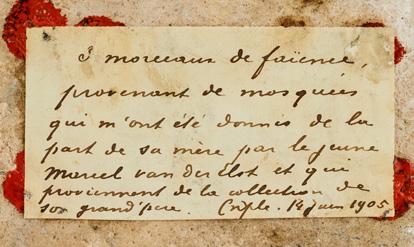
Fig. 3 Baron van der Elst
Fig. 2
AN
EXTREMELY RARE IZNIK POTTERY TILE FROM THE ‘CINILI HAMAM’
OTTOMAN TURKEY, CIRCA 1540 of hexagonal form, underglaze, the main field decorated in white against a dark blue background, with details picked out in turquoise, the primary element of the design is an asymmetrical prunus tree in blossom, growing from a bunch of fleshy saz leaves at the base, from this base also sprout two other stems in the saz style, the right one with a large rosette as well as buds and leaves, and the left stem ending in a distinctive threepetalled tulip decorated with dark blue dots and turquoise teardrop shapes, at the top right is a Chinese-inspired cloud motif, and the borders are of turquoise with a repeat pattern of rosettes in two different sizes
28.3cm diameter max.
£30,000-50,000
Provenance: Baron Leon van der Elst (Belgian, 1865-1933).
Count Frederick van der Steen de Jehay (Belgian, 1858-1916).
Henriette de Jourda de Vaux (Belgian, 1865-1946).
Marie-Noelle Kelly (Belgian, 1901-1999); thence by descent.
This tile is one of only three complete tiles bearing this pattern. The example in the Victoria & Albert Museum was made by cutting two damaged tiles and fitting the remaining parts together (see Atasoy and Raby, Iznik: The pottery of Ottoman Turkey, 1989, fig. 501). The third of these tiles is in the Ömer Koç Collection, Istanbul (see H. Bilgi 2015, no.15). Although the overall design of each is the same, suggesting the use of stencils, there are subtle alterations in details of colour and patterning between the three.
During the conservation of the Çinili Hamas which took place from 2010-23, fragments of tiles were found under and above the wall plaster, including several pieces of the same design as this tile (see Özbay and Şengozer, Barbarossa’s Cinili Hamam: A Masterpiece by Sinan, 2023, figs. 4.6e and 4.7 pattern 20). Exactly where this tile design was placed within the hamam is unclear, it is certain that both the men’s and women’s sections were decorated in this fashion, and hexagonal tiles appear to have been used side-by-side to create uninterrupted walls of a single design (opp, cit, pp. 192-7).
The basic design of the tile was clearly popular among the potters of Iznik and their clients. With a pattern spread over two tiles rather than one and with mossy green added to the palette, a contemporary tile panel in the David Collection employs the same elegant prunus along with the non-natural serrated leaves and tulips at the base, and both may have been inspired by the arts of the book (see Atasoy and Raby 1989, figs. 229-30, pp. 134-5). A blue-ground dish in the British Museum, made half a century later, uses a slightly simplified version of the same design (see J. Carswell, 1988, fig. 56 pp. 80-1).
The Çinili Hamam’s patron was none other than the great kapudan-i derya (Admiral) Hayreddin Pasha, better known in the West as Barbarossa. He was one of the most important characters of the reign of Süleyman the Magnificent, leading Ottoman naval forces across the Mediterranean from around 1510 until his death in 1546. That his hamam was constructed in the prestigious Zeyrek district of Istanbul was a testament to his importance, with the endowment deed of 1534 stating that the Sultan himself had reserved access to the nearby aqueduct’s water for the Hamam’s use (see opp. cit, pp. 78-9). As a key figure at the Ottoman court, Barbarossa was given access to both Sinan, the greatest architect of the time, as well as the Nakkaşhane (imperial painters’ workshop) which provided designs for the tiles. The baths were adjacent to the mansions of palace dignitaries as well as easily accessible from nearby main roads, making it an easy source of money to be provided to Barbarossa’s charitable foundations elsewhere in the city (ibid, pp. 181-4). Sinan himself was a pioneer in including tiles within the overall architectural scheme of buildings, as seen in the Çinili Hamam, and may even have been in charge of the Iznik ceramic industry in this period [Necipoğlu 1990, pp. 154-5].
Originally named after its patron or his titles as Admiral, the name by which the hamam is now known derives from the extensive tilework (‘Çinili’ means ‘tiled’), which distinguished it from other baths of the period which lacked extensive tile decoration. Such was the impression made by the tiles that one of the leading Ottoman poets of the day praised them on the occasion of the Hamam’s opening, suggesting that they had overcome even the ‘beautiful ones of China’. Although it was considered one of the preeminent baths of Istanbul during the 16th and 17th century, the Çinili Hamam was damaged by fires during the 18th century and finally destroyed by fire in 1833, passing through multiple hands thereafter (see opp. cit, 2023, pp. 82-91). After an extensive process of restoration, the hamam has now reopened, along with a small museum including both archaeological finds and the tile fragments found under the plaster. In its new state, it truly reflects the sentiment of the poetry found on some of the surviving tiles:
“The area of the bath is like Paradise/Although its foundations are made of clay and bricks” (see opp. cit, p. 43].

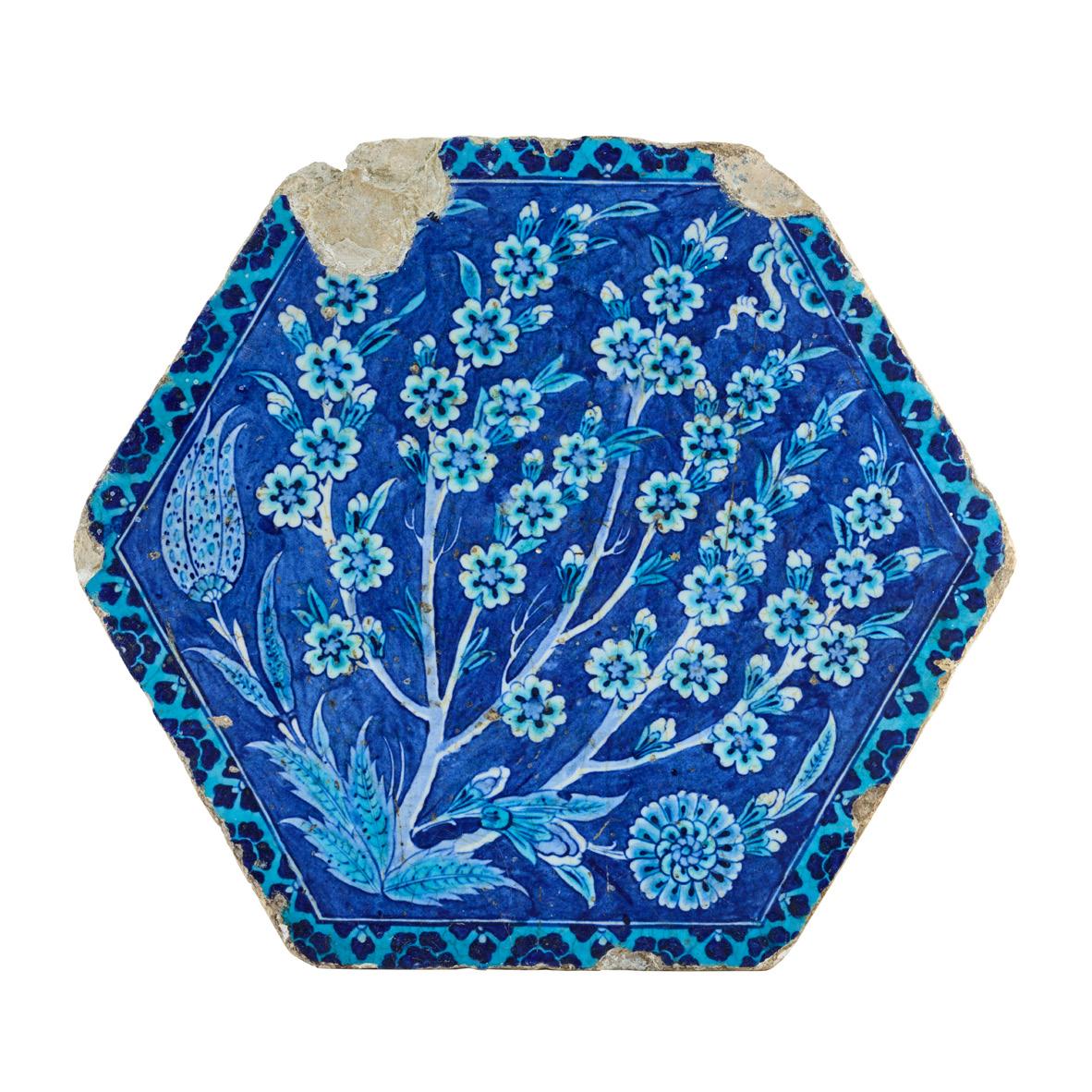
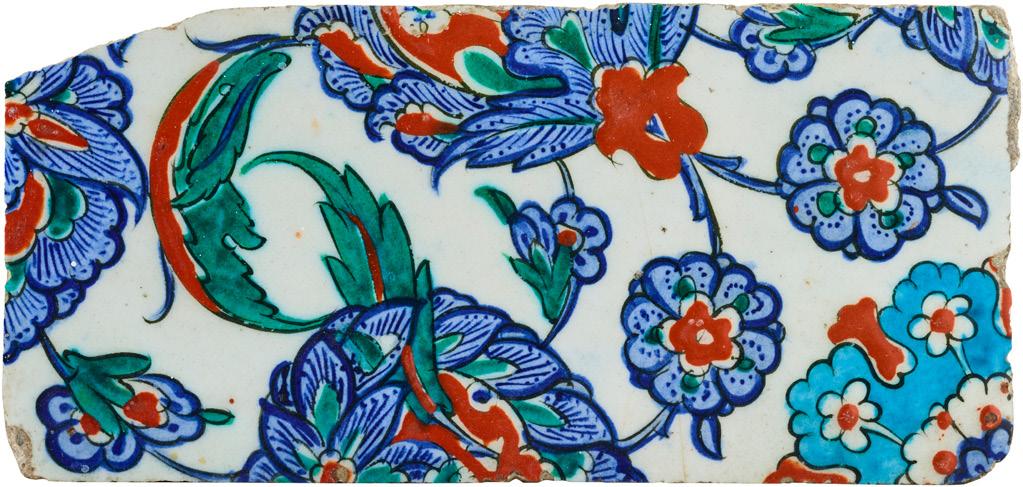
44 AN
IZNIK
POTTERY TILE FRAGMENT
OTTOMAN TURKEY, CIRCA 1570
of irregular rectangular form, decorated in two shades of cobalt blue, turquoise, green and bole red on a white ground, with large stylised part-palamettes, flowerheads and saz leaves, verso with an old written note in French secured down with red seal wax at each corner 24.7cm x 11.6cm
£1,000-2,000
Provenance: Baron Leon van der Elst (Belgian, 1865-1933).
Count Frederick van der Steen de Jehay (Belgian, 1858-1916).
Henriette de Jourda de Vaux (Belgian, 1865-1946).
Marie-Noelle Kelly (Belgian, 1901-1999); thence by descent. It is unclear exactly which building this tile may have been used in, but it is unmistakably a product of peak-period Iznik in the second half of the 16th century. Close comparison can be made with a panel in the British Museum (see V. Porter, Islamic Tiles, 1995, p.104, no. 97) as well as the tympanums from the Piyale Pasha Mosque, now in the Musée du Louvre (see Makariou, 2012, pp. 347-9, fig. 219). A closely related tile was sold at Christies, Arts of the Islamic & Indian Worlds, 21 April 2016, lot 171.
45
AN IZNIK BLUE, TURQUOISE AND WHITE POTTERY TILE
OTTOMAN TURKEY, CIRCA 1650
of irregular square form, decorated in cobalt blue and turquoise on a white ground, with a central star-shaped and stylised palmette, from which issue symmetrical and meandering vines comprising spotted flowerheads, small flowerheads and larger palmettes, with double leaves at each side, cut down on one side, verso with remains of red seal wax and two corners of old note paper, accompanied by the original handwritten note that was affixed to the back
25.1cm x 28cm
£2,000-3,000
Provenance: Baron Leon van der Elst (Belgian, 1865-1933).
Count Frederick van der Steen de Jehay (Belgian, 1858-1916).
Henriette de Jourda de Vaux (Belgian, 1865-1946).
Marie-Noelle Kelly (Belgian, 1901-1999); thence by descent. Where the hexagonal tile represented the springtime of Iznik production, and the polychrome tile its full summer bloom, this tile demonstrates the industry’s autumn years. The Sultanahmet Mosque, completed in 1617, was the last major imperial commission of Iznik tiles. The craftsmen were therefore forced to look further afield, exporting large quantities of relatively simple but nonetheless striking blue and white tiles to Cairo. They also provided replacement tiles for use in the Sünnet Odası (Circumcision Room) of the Topkapı Palace (see J. Carswell, Iznik Pottery, 1998, pp. 106-8). A group of comparable tiles are in the Musée du Louvre, where the provenance is given as either Cairo, the Topkapı, or the mausoleum of Hatice Sultan (inv. nos. OA 4047/212-214).
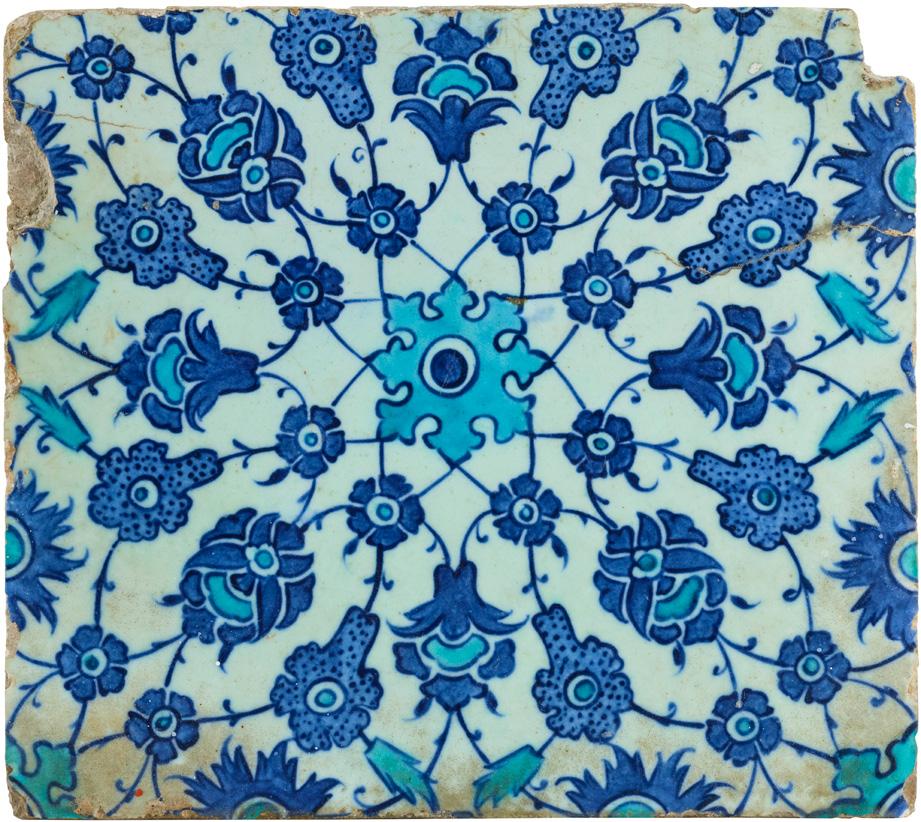
46 Y
AN OTTOMAN GOLD OVERLAID STEEL KNIFE
TURKEY, SIGNED AND DATED AH 1215/ AD 1800 with finely watered steel tapering blade ‘with walrus-ivory hilt’, the forte and spine decorated in gold overlay with floral motifs, one side of the forte with a date in hiji, the other side inscribed with ‘The work of Muhammad Hadi’
31.6cm long
£300-500
Provenance: Private Scottish collection.

47 Y
AN OTTOMAN YATAGAN WITH MAKER’S NAME
TURKEY, DATED AH 1226/ AD 1811-12 of typical form, with tapering and slightly curving watered steel blade, with gold inlay decoration, one side of the blade with a large inscription-filled elongated cartouche comprising a cusped medalion and six rectangular cartouches around it, the other side decorated with tulips and other flowerheads, the spine of the hilt set with coral
69.8cm long
£600-800
Provenance: Private Scottish collection. The inscriptions comprise Arabic prayers within the six cartouches around the medallion and the date spelled in Arabic, and a Turkish couplet. In the central cartouche ‘Work of el-Hace Mehmed 1226 (AD 1811-12)’.



A RARE AND EARLY OTTOMAN SILVER-GILT AND NIELLOED KNIFE SET WITH TUGHRA OF SULTAN AHMED III (R. 1703-1730)
TURKEY, EARLY 18TH CENTURY
formed of a pair of small knives with tapering blades set within one scabbard, the tops of the hilts set with garnets, the surface of the scabbard with silver-gilt panels engraved and decorated with floral designs, the interstices decorated in silver niello with intertwined scrolls and stylised carnations, stamped with a tughra, on stand 21.2cm long
£6,000-8,000
This knife set (trousse) is exceptional. Not only is it a masterpiece in terms of the fineness of its execution, but it is also one of the oldest known examples of an Ottoman silver trousse. The surface is richly covered with engraved and incised designs against a background of niello, and stamped with the tughra (personal seal) of the reformist Ottoman sultan Ahmed III (r. 1703-1730). In terms of its technique, it is similar to a somewhat earlier silver dagger from the reign of Sultan Mehmed IV (r. 1648-1687), which is also silver-gilt and nielloed (see G. Kürkman, Ottoman Silver Marks, Mathusalem Publications: 1996, p.145). A suite of body armour, made for the Janissary Mustafa Ağa and dated 1093 AH/ 1682 AD, displays the same quality of niello-work as the present knife-set (op. cit., p.146). This similarity in both decoration and technique shows that the aesthetic of silver and niello developed under Mehmed IV from the mid-17th century continued to be prized during the reign of his son and heir Ahmed III.
Of particular note is the pattern of repeating stylised carnations which covers the scabbard. These flowers were highly regarded in Ottoman culture, appearing across a wide variety of media including metalwork, as seen here, but also ceramics, textiles, and manuscript illumination. Portraits of Ottoman Sultans and high functionaries often depict them holding a carnation, and these blooms were also used as metaphors for the beloved in Ottoman poetry.
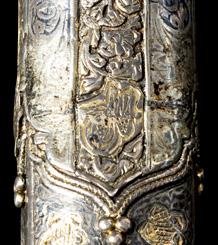
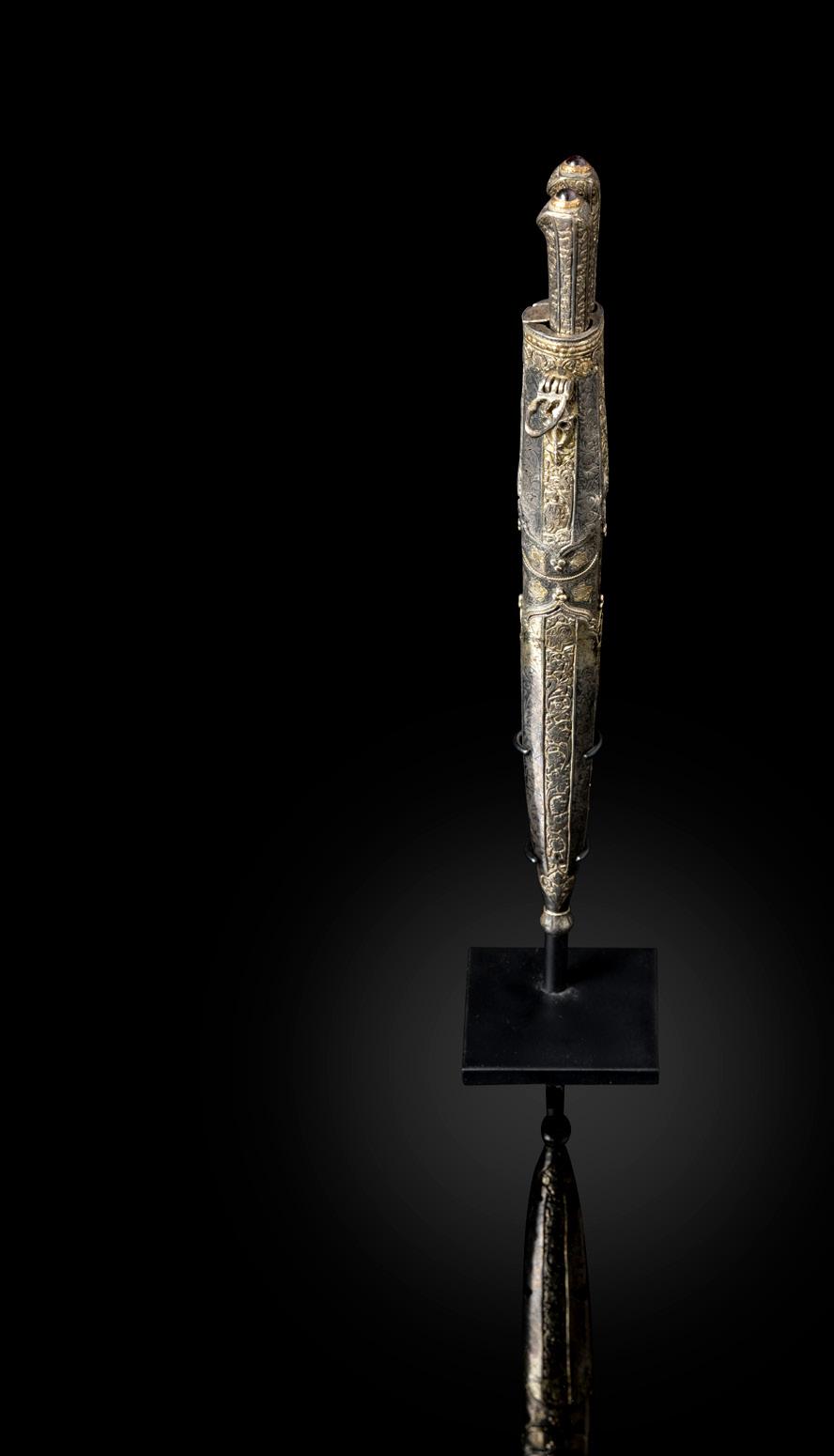

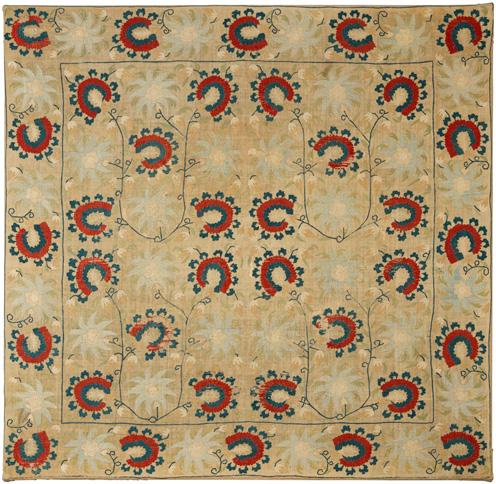
AN OTTOMAN SILK EMBROIDERED LINEN WRAPPING CLOTH (BOHCA)
TURKEY, 18TH CENTURY
of square form, the cream linen ground embroidered in polychrome silk threads depicting floral motifs, with further repeat floral motifs around the border, backed, on stretcher
123cm x 128cm
£1,000-1,500
Provenance: Private UK collection.
For further examples of Ottoman Bohcas dating to the 18th century in The Textile Museum, Washington, see S. B. Krody, Flowers of Silk & Gold, Four Centuries of Ottoman Embroidery, p. 120, nos. 20 and 21.
AN EXQUISITE OTTOMAN EMBROIDERED WOMAN’S PRAYER PANEL
WESTERN TURKEY, CIRCA 1800
of rectangular form, the cream linen ground embroidered with red, coral, and dark blue silk threads, tassels on either end, backed in red 145.5cm x 96cm
£3,000-4,000
For another example of this type of prayer panel in the Denver Art Museum, see accession number 1959.19.
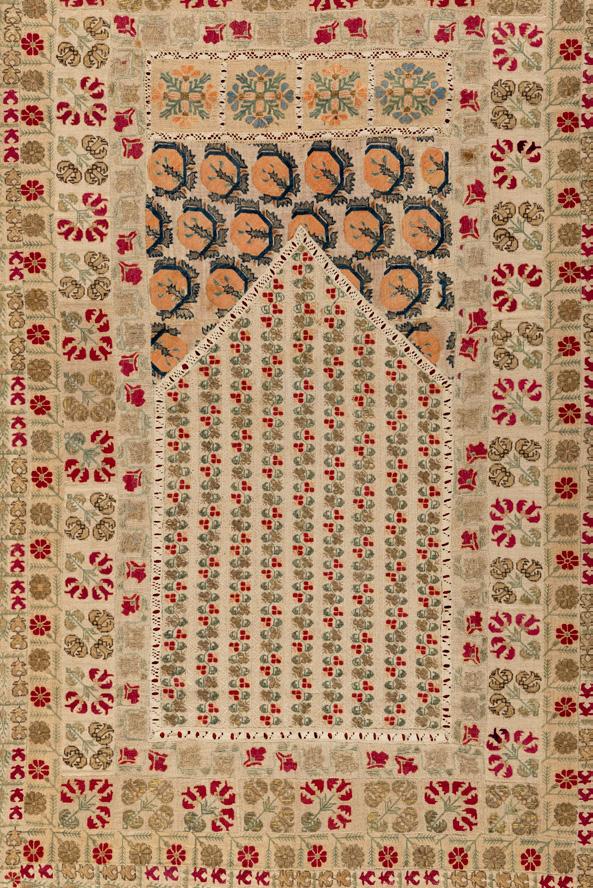


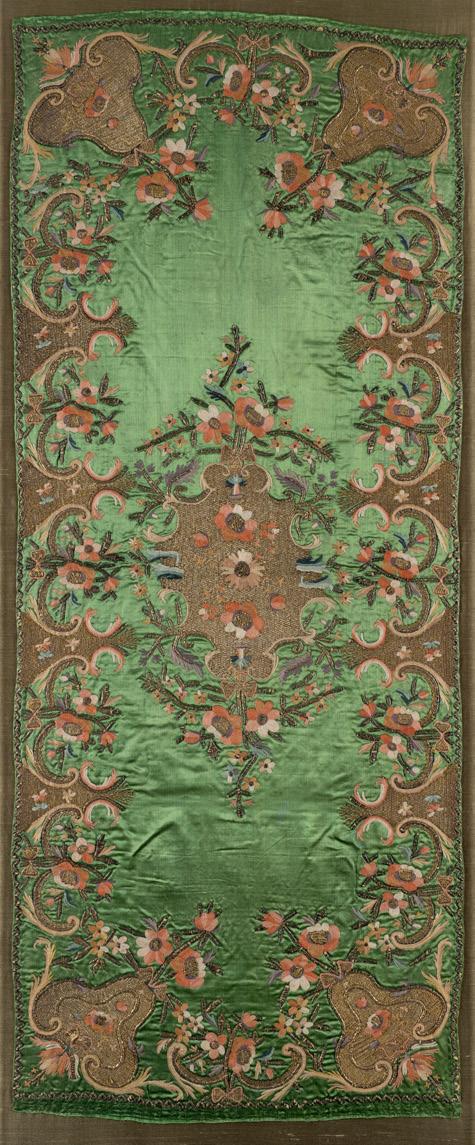
A SUPERB PAIR OF OTTOMAN METAL-THREAD EMBROIDERED SILK CEREMONIAL COVERS
TURKEY, LATE 18TH CENTURY/ EARLY 19TH CENTURY
each of rectangular form, the green silk ground embroidered in gilt and silver threads, and polychrome silk threads, with a central cusped and stylised cartouche comprising flower heads, the border with a repeat design of floral swags all in the rococo-style, mounted on silk panel on stretcher, in perspex cover each 120.3cm x 48.5cm
£8,000-12,000

The present luxurious pair of green silk covers, richly embroidered with silk and precious metal threads, were probably used for interior decoration or as furnishing covers during social or ceremonial gatherings. The shape may indicate that they could have been used as mirror covers. For other Ottoman silk mirror covers please see, K. Belger, Flowers of Silk & Gold: Four Centuries of Ottoman Embroidery, Merrell & The Textile Museum, Washington D.C., 2000, cats. 27 & 29.
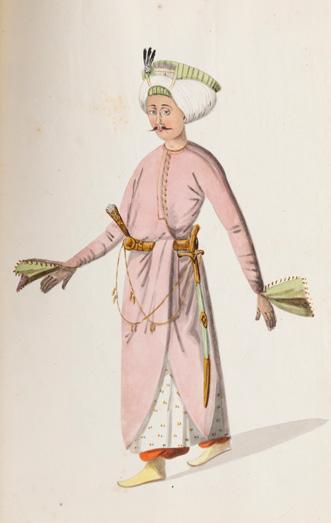

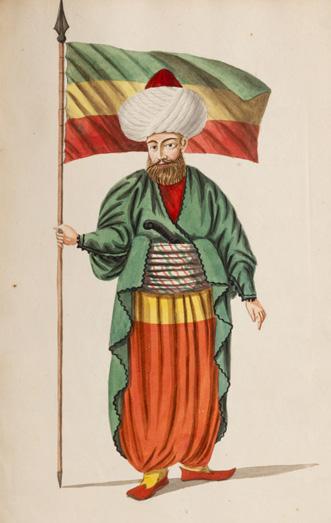

AN ALBUM OF TWENTY-FOUR WATERCOLOURS OF HIGH-RANKING OFFICIALS, COURTIERS AND OTHER FIGURES
OTTOMAN TURKEY, EARLY 19TH CENTURY
bound album, watercolour on paper, each numbered in ink, inscribed in pencil in English and on verso in French with their identifying position including a Judge, a city magistrate and members of the janissary army
Book cover 31.7cm x 20.7cm; folio 31.7cm x 19.7cm
£1,500-2,000
Provenance: An accompanying letter implies that it was gifted to the Archibald family in circa 1814; thence by descent.
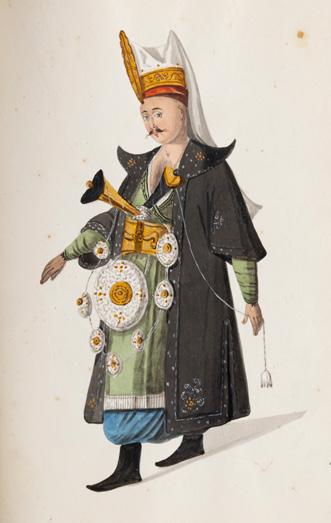
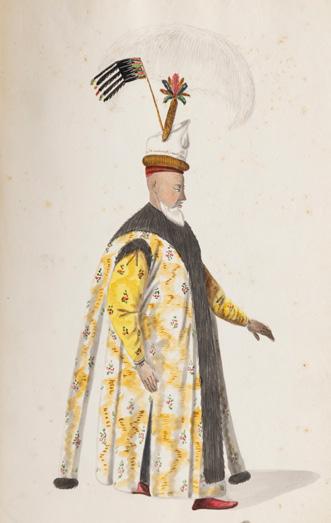
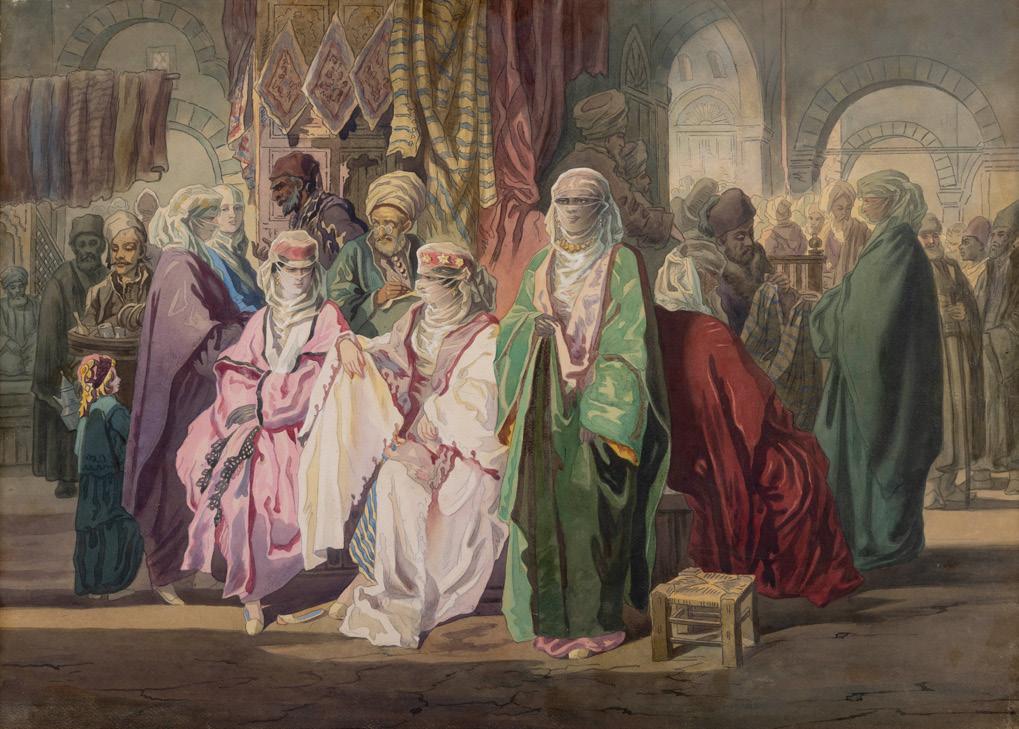
LADIES MINGLING IN THE GRAND BAZAAR
ATTRIBUTED TO AMADEO PREZIOSI (MALTA, 1816-1882)
watercolour on paper, framed and glazed
Sight size 48.7cm x 68.5cm
£6,000-8,000
Amadeo Preziosi (1816-1882) was a Maltese painter known for his vivid and detailed watercolors of the Balkans, the Ottoman Empire, and Romania. Preziosi studied at the École des Beaux-Arts, and eventually settled in Istanbul, where he set up his workshop and became ingrained in society, also contributing his time to the dragoman of the British Embassy and the Greek legation. He experienced success with his workshop here, which was often visited by tourists wishing to take souvenirs home. Notably, Edward VII visited and purchased several of his pieces. His works have a draughtsman-like quality to them, yet his linework is handled in watercolour rather than a bold, opaque ink, which keeps his compositions soft and atmospheric. Ladies Mingling in the Grand Bazaar is representative of these qualities, with its precise colour-blocking and vivid tones. It also shares the detailoriented characteristics of Preziosi’s other works, while maintaining the atmospheric and ethereal vein.
Portrait of a Turkish Beauty, attributed to Amadeo Preziosi, a drawing sold through Bonhams, The Travel and Exploration Sale, 6 December 2012, lot 131, appears to be a preparatory drawing of the same seated female figure dressed in white in the foreground of this finished watercolour, leaving us in no doubt that this painting is by Amadeo Preziosi.

AN OTTOMAN UNDERGLAZE PAINTED POTTERY TILE
DECORATED WITH CINTENAMI
SYRIA, DAMASCUS, FIRST HALF OF 18TH CENTURY
of square form, decorated predominantly in blue and green with an X-symmetrical pattern comprising four wavy stripes, double crescent balls and carnation stems
25cm square
£2,000-3,000
The design on this tile is very similar to ones that were made in the Tekfur Saray workshop in Istanbul (see National Museum of Scotland, Edinburgh, inventory number A. 1892.27). The workshop was created in order to revive the Ottoman tile industry. The only difference in the design, is the use of carnations rather than the green Chinese-inspired cloud swags within the design.
55 A BOKHARA SILK EMBROIDERED LINEN SUSANI
CENTRAL ASIA, 20TH CENTURY
the rectangular linen ground embroidered in silk threads with floral motifs centred around a star, a band of palmettes around the border, backed with strip of velcro for hanging 204cm x 148cm; with backing 216cm x 160cm
£500-700
Provenance: Private UK collection.
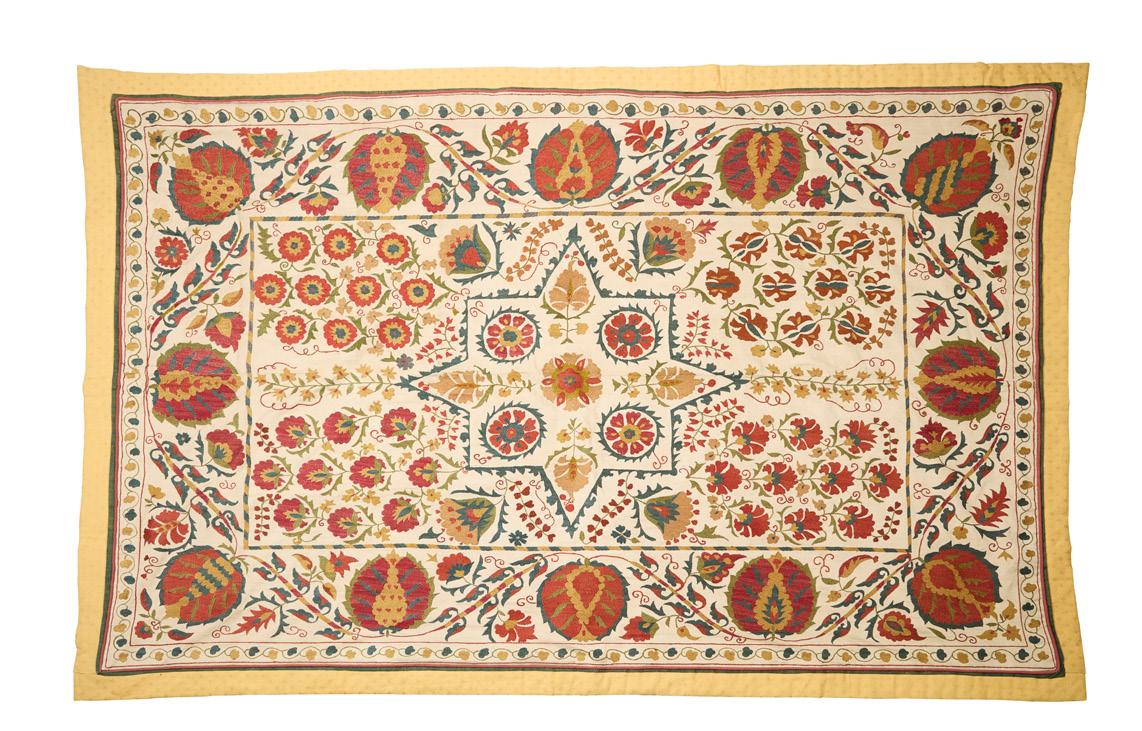
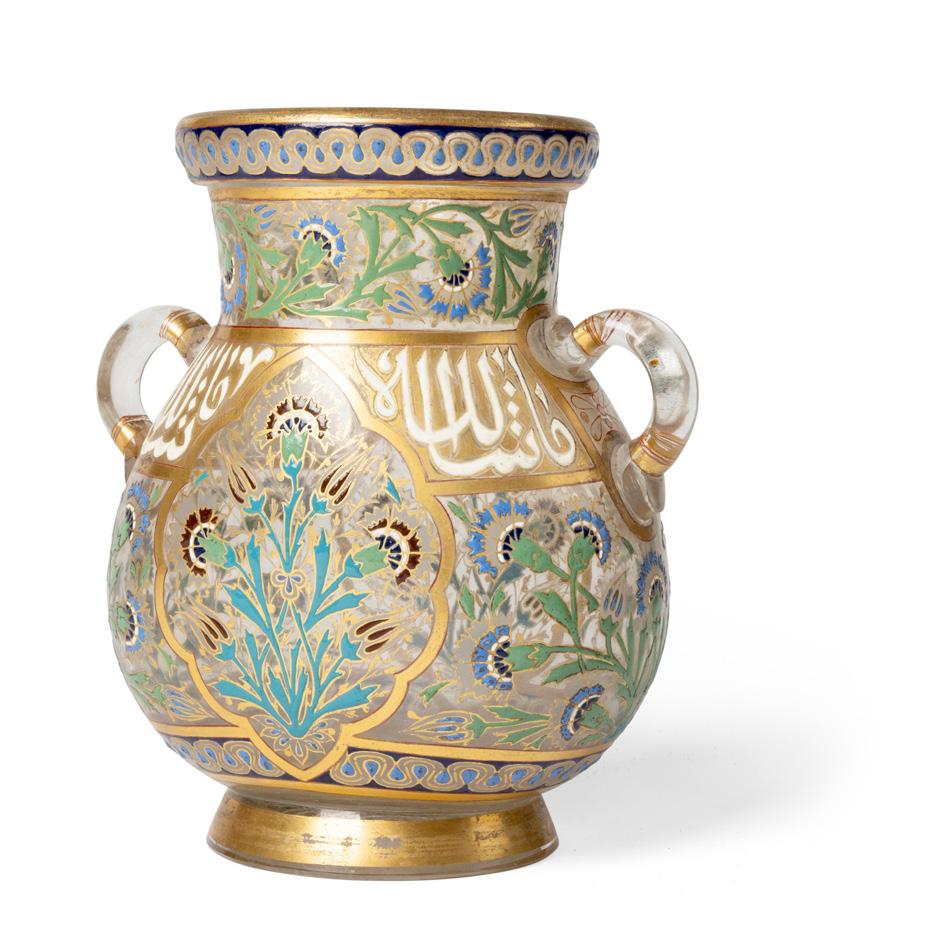
56
A ‘LOBMEYER’ IZNIK-STYLE ENAMELLED GLASS DOUBLE-HANDLED VASE AUSTRIA,
VIENNA, CIRCA 1878
of baluster form on splayed foot with loop handles to either side of cylindrical neck and shoulder, the body enamelled in gilt, green, blue, black and white with two cusped cartouches comprising Iznik-style floral sprays of tulips and carnations, the remaining body and neck with further floral sprays, the shoulder with a wide band of Arabic calligraphy in white, underside signed with Lobmeyer monogram and around it, inscribed in German with:
‘Der Wille Gottes geschehe’
17.2cm high
£6,000-8,000
Provenance: Christie’s, Art of the Islamic and Indian Worlds, 31 May 2009, lot 235.
The Arabic inscription on the shoulders is a repeat of ma sha’ Allah (as God wills), which is translated in German under the foot.
An almost identical vase, with the same inscription and colour scheme sold through Christie’s, see, Art of the Islamic and Indian Worlds, 8 April 2008, lot 152. Another example is in the Khalili Collection, see S. Vernoit, Occidentalism, London, 1997, no. 176, p. 227. For an Iznik-style dish sold through our rooms and a further discussion on Lobmeyr, see Islamic and Indian Art, 11th December 2024, lot 50.
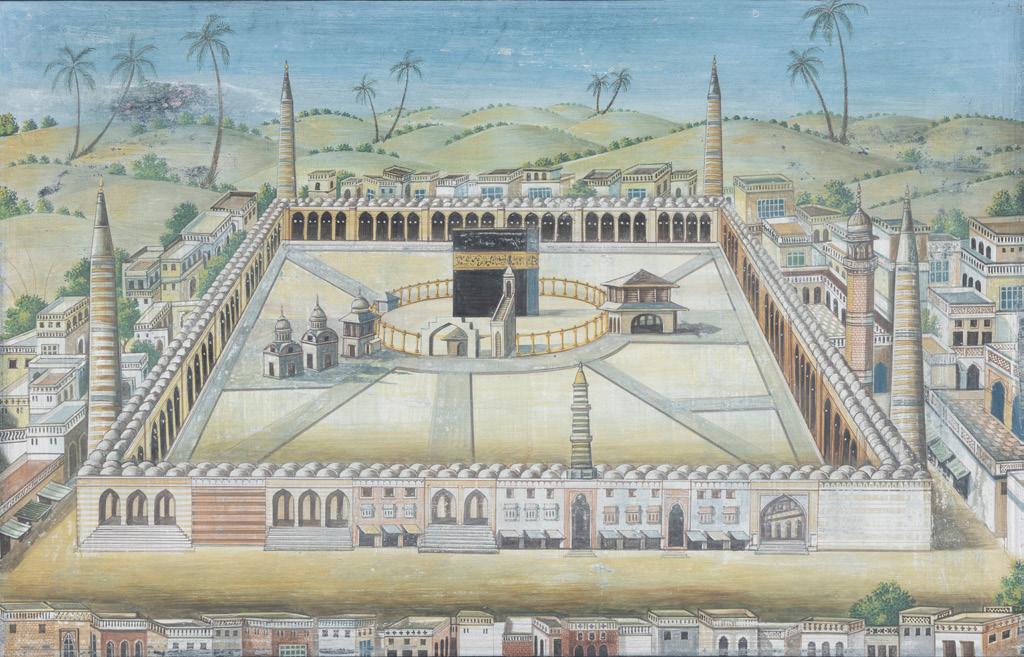
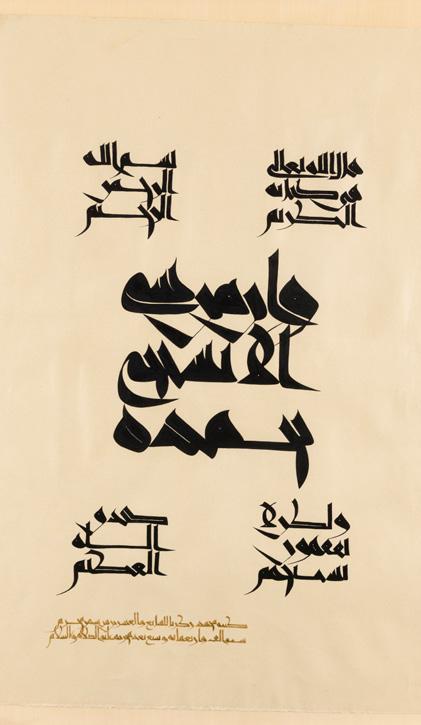
57
A VIEW OF THE KA’BA AND THE MASJID AL HARAM
SAUDI ARABIA, MECCA, LATE 19TH/ EARLY 20th CENTURY
watercolour on paper, black border, depicting the Ka’ba enclosed by the mosque walls of the great Masjid Al-Haram, with hills and buildings around it
34.6cm x 49.9cm
£1,500-2,000
This painting was probably produced as a souvenir for the pilgrims to Mecca. For a comparable painting sold at Sotheby’s see, Travel, Atlases, Maps and Photographs, 24 May 2022, lot 46.
58
KUFIC CALLIGRAPHIC EXERCISE: PART OF QUR’AN 17:44
SIGNED BY MOHAMAD ZAKARIYA (AMERICAN, B. 1942)
ink and gouache on paper, signed lower left: signed by Muhamad Zakariya dated 27 Muharram 1407/ 2 October 1986, framed and glazed
95cm x 63.5cm
£4,000-6,000
Provenance: Formerly, the collection of a distinguished Saudi diplomat, acquired directly from the artist.
Our painting is a relatively early work by Zakariya and is undoubtedly inspired by the striking kufic calligraphy from the famous Nurse’s Quran.
Mohamed Zakariya is an American master Islamic calligrapher and an American Muslim convert. Zakariya became drawn to Islamic calligraphy while growing up in California and made his way to Morocco in his teens. While there he became more interested in Islam and converted upon his return to the United States. After being self-taught in Islamic calligraphy for many years, he eventually became a student of Turkish master calligrapher Hasan Celebi, one of the students of Hamid Aytaç, the last of the Ottoman calligraphers. Through Celebi’s teachings, Zakariya received a diploma at the research Center of Islamic History, Art, and Culture in Istanbul in 1988, the first American to receive this accolade. Now a teacher himself, Zakariya is very prolific and has had many high-profile commissions, including one from US President Barack Obama to create a piece presented to the king of Saudi Arabia in 2009.

59
A PAIR OF GOLD JAMBIYA DAGGERS WITH SAUDI ROYAL EMBLEM

SAUDI ARABIA, BY BADR AL-DIN AHMAD, 20TH CENTURY
each of typical form with waisted grip and sharply curving blade and sheath, the steel blade with medial ridge, the gold hilt and sheath engraved with rococo-style floral designs, a double sword and palm tree in silver relief representing the Saudi Arabian Royal Emblem, verso plain gold with maker’s name in Arabic within a rectangular cartouche
each 20.5cm long
£25,000-35,000


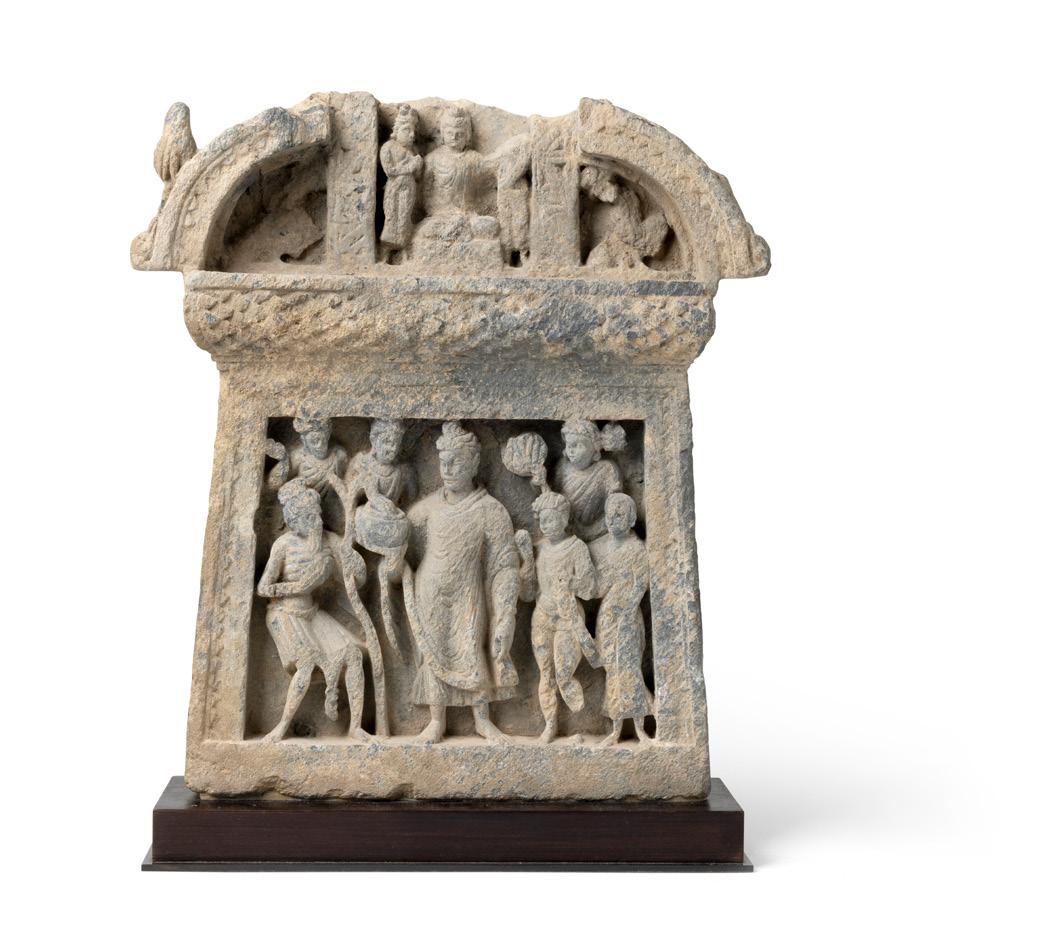
A GREY SHIST RELIEF OF DIPANKARA JATAKA
NORTHERN INDIA, GANDHARA, 2ND OR 3RD CENTURY AD
grey schist stone relief, carved in deep relief with Buddha Dipankara to the centre, flanked by further figures within a sawtooth border, on stand 36cm x 33cm x 6cm
£3,000-4,000
Provenance: Formerly, Kurita Isao Collection, Japan.
Acquired from Spinks, London, 1986.
This carved schist panel depicts the story of the Ascetic Mega and the Buddha Dipankara. Part of a collection of stories about the previous lives of the Buddha, this story describes how the Buddha-to-be is born as Megha the ascetic, who meets the Buddha Dipankara. Inspired and moved by his kindness and wisdom, Megha vows to become Buddha himself in the future.
For a related carved panel depicting the same scene and a discussion on the subject, see British Museum accession number 1980,0225.1.
A LARGE BRONZE TEMPLE BOWL OR URLI
SOUTH INDIA, 19TH CENTURY
cast of broad shallow form on four ball feet, the ridged inverted rim with a pair of looped foliate handles, each above a floral stylised motif
18cm high; 49cm diameter
£400-600
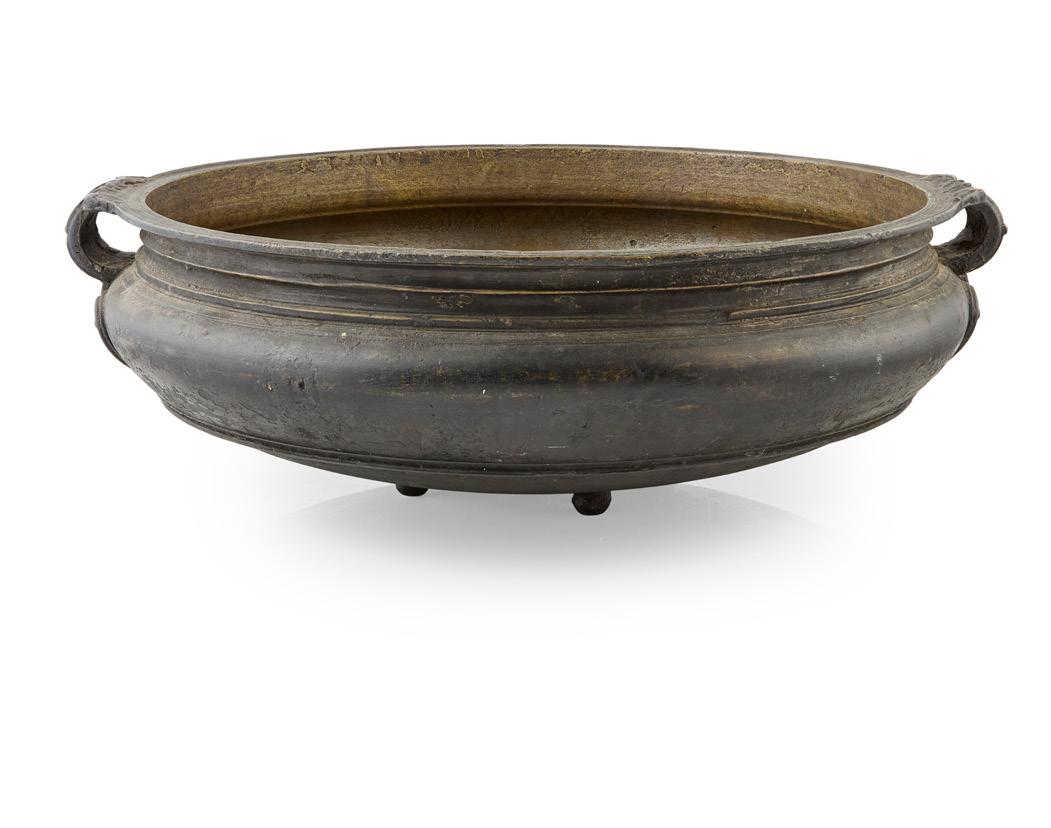
Provenance: Private Scottish collection.
For a larger example, formerly in the Stuart Cary Welch Collection, see Sotheby’s, Part Two, Arts of India, 31st May 2011, lot 171. In the Sotheby’s note, it is suggested that the production of these types of vessels is associated with the Musari community of the Kammalan caste in Kerala.
62
A BRASS NANDI PUJA BELL OR GHANTA
SOUTH INDIA, 18TH CENTURY
cast of typical form, the ribbed handle surmounted by a cast seated figure of the bull, Nandi
26cm high
£600-800
Traditionally, the puja bell is used during Hindu rituals and rung during prayers to invoke the presence of deities.

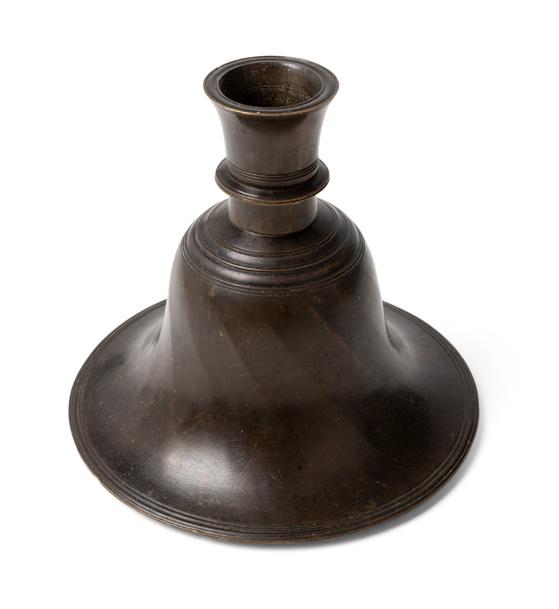

63
A PAIR OF MUGHAL RED SANDSTONE ARCHITECTURAL FINIALS
INDIA, 17TH CENTURY
each in the form of a stylized floral palmette with the petals elegantly clustered to the top to form the cusped palmette and standing on a tiered and waisted pedestal decorated with leaf and petal forms
Each 37cm x 33cm x 13.5cm
£1,200-1,500
Provenance: Spink & Son, London.
These finials would have been used as an architectural ornament on a projecting eave or as part of a decorative border on the roof.
64
AN ELEGANT MUGHAL BRONZE BEGUM’S HOOKAH BOTTLE NORTHERN INDIA, EARLY 18TH CENTURY
cast of typical bell-shaped form, the body with elegant radiating panels, the slightly tapering neck with a raised rib 13cm high, 15.2cm diameter max.
£600-800
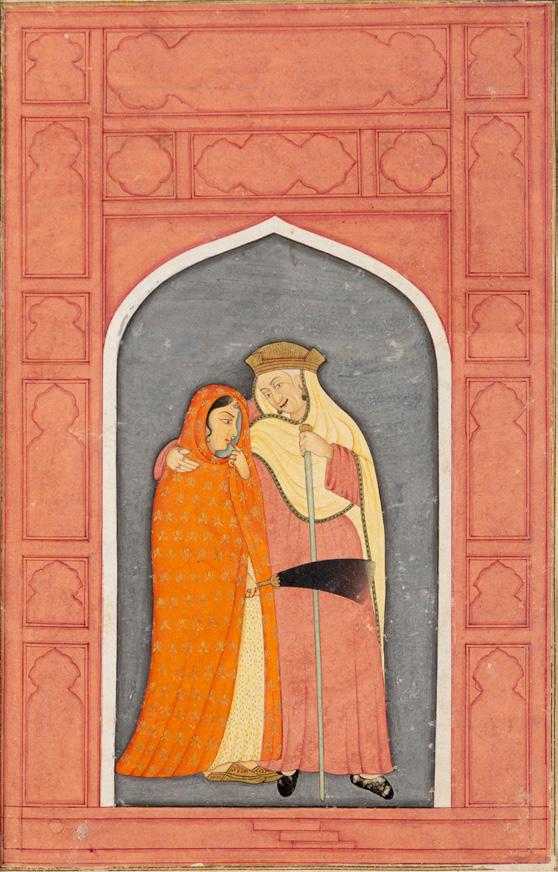
A YOUNG LADY AND HER GOVERNESS
INDIA, PROVINCIAL MUGHAL, LATE 18TH CENTURY
gouache on paper heightened with gold, a young woman stands with her governess, an older grey-haired doyenne who is leading her through a palace doorway to the palace zenana, the maiden wrapped in a red cloak holding a cauri , her protector leaning on a staff, the coral-coloured arch with typical Mughal designs, mounted, glazed and framed 36cm x 23.7cm
£4,000-6,000
Provenance: Formerly, the collection of Dr. Claus Virch, collected in the early 1970s.
Claus Virch (1927-2012) was an esteemed scholar and connoisseur of European paintings. He was a member of the curatorial staff of the Metropolitan Museum of Art, New York, from 1957 to 1970 as a specialist in the Department of Old Master Paintings and Drawings. Born in Germany, Virch completed a dissertation on the drawings of Ernst Barlach in 1952 at the University of Kiel. After the war, he immigrated to California, but soon moved to New York where a chance meeting with Henry Francis Taylor, then Director of the Metropolitan Museum, led to his working there.
In 1970, after overseeing the new installation of paintings in conjunction with the institution’s Centennial celebration, Virch left the museum to create an art fund with Christian Humann to invest in art from world cultures. Humann’s active collecting, especially of Asian art, coincided with Virch’s wide-ranging tastes. Dr. Pratapaditya Pal met Virch in 1973 when he accompanied Virch and Humann on a visit to acquire works of art from Alice Heeramaneck after Nasli Heeramaneck’s death. Some of that purchase went to form Christian Humann’s famous Pan-Asian Collection, Claus Virch’s large collection of Indian paintings was very likely acquired around that time, with significant purchases from the Heeramanecks.
This painting, whilst minimalist in its composition, draws our focus on the two figures and their expression. The old lady is seen with her head slightly tilted, comforting and advising her young ward with her arm around her shoulders. The young lady looks a little forlorn and pensive, with her finger lifted towards her mouth. There is a degree of modesty, almost as if they are sharing deep secret between them.
During the Mughal Empire, the theme of a young lady with an old lady is a popular one. For a similar but earlier painting of a maiden wrapped in a cloak by Mohammad Panah, an artist working in the court of Muhammad Shah (r. 1714-1748), see E. Hannam, Eastern Encounters, Four Centuries of Paintings and Manuscripts from the Indian Subcontinent, London, 2018, no. 42.


AN IMPRESSIVE SILVER BIDRI AND SILVER HOOKAH INDIA, CIRCA 1860 AND LATER
comprised of a large splayed base surmounted by a 19th century bell-shaped hookah bottle, from which issues a long silver stem with an elaborate succession of drop-shaped, spherical and tapering elements rising to the furnace in a poppy-bud form, the decoration with stylised flowers within cusped medallions
79.3cm high, base 37.2cm diameter
£2,000-3,000
For another complete hookah set, see Christie’s, Arts of India, 1 October 2012, lot 219.
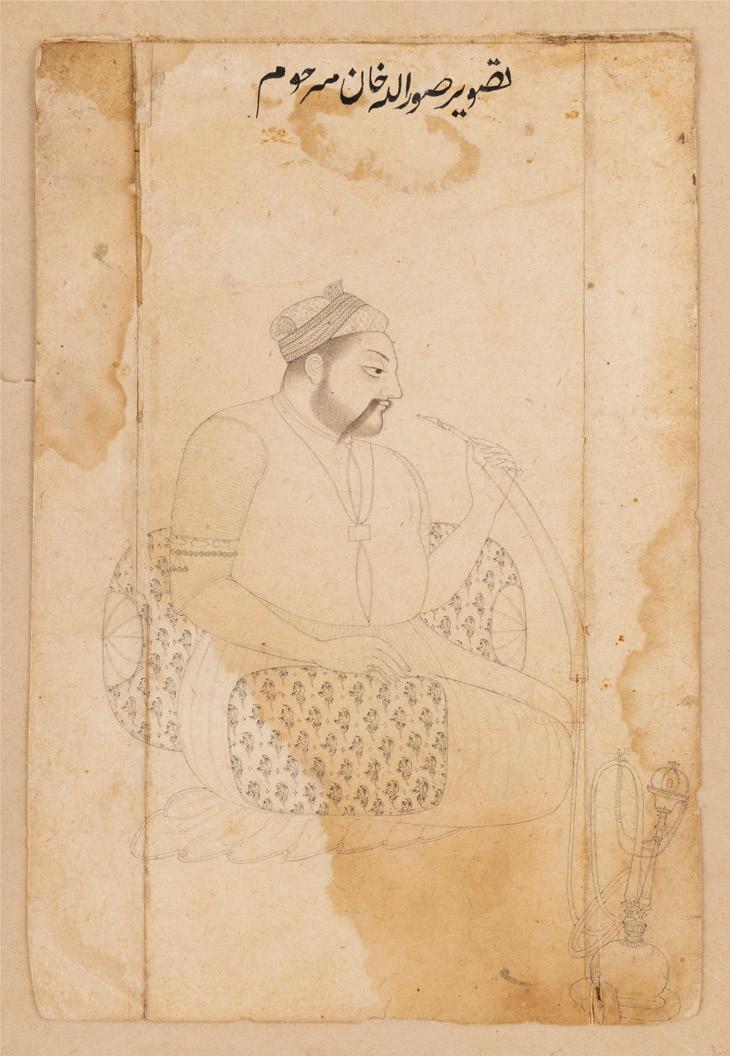
A SEATED NOBLEMAN SMOKING A HOOKAH INDIA, PROVINCIAL MUGHAL OR DECCAN, 18TH CENTURY
brush drawing on paper without borders, the paper extended at the sides, depicts a seated nobleman, the late Sur Allah Khan smoking a hookah, identified by the bold Persian inscription above, taswir-i-sur allah khan marhum, verso with a label of the Royal Academy Exhibition, series no. 1058 (or 1)
17.6cm x 11.9cm
£2,000-3,000
Provenance: Formerly in the collection of Dr Alma Latifi, CIE, OBE. Private Collection UK.
Dr Latifi, a civil servant, amassed a substantial collection of Indian paintings from which several pieces were loaned to the Royal Academy exhibition entitled, The Art of India and Pakistan, 1947-48.
Exhibited: Royal Academy, London, 1947-48, The Art of India and Pakistan.

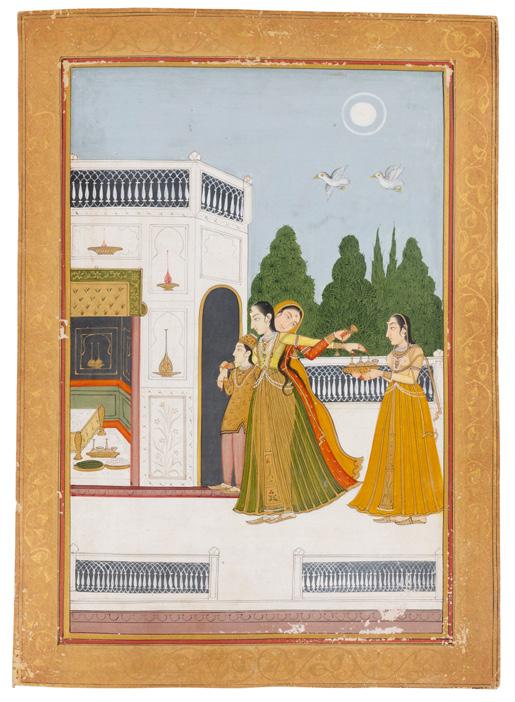
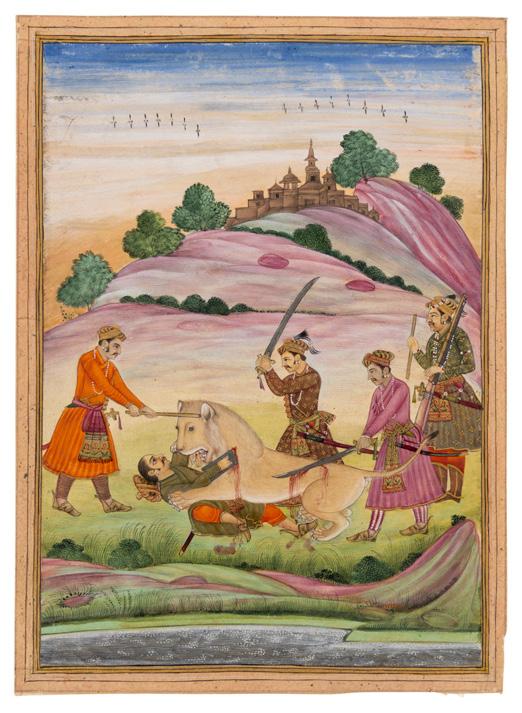
68

AN INEBRIATED PRINCESS BEING LED BY TWO FEMALE ATTENDANTS TO A BEDCHAMBER ON A PALACE TERRACE
INDIA, PROVINCIAL MUGHAL, LATE 18TH CENTURY
gouache heightened in gold on paper, gold floral decorated border with red and black rules, depicting a lady adorned in jewellery with her arm stretched outwards towards a tray of drinks being held by a servant, her duenna or chambermaid pulling her away with the help of a smaller female servant, all on a palace terrace under a moonlit sky with trees in the distance, unframed 26.3cm x 18.9cm
£600-800
For another illustration of this very same scene attributed to Bundi, circa 1760, sold at Bonhams, see Islamic and Indian Art, 5 July 2006, lot 232.
70
A KOFTGARI GOLD INLAID STEEL SURAHI
INDIA, 19TH CENTURY
69
THE MUGHAL EMPEROR JEHANGIR WRESTLING WITH A TIGER OUT ON A HUNT
INDIA, PROVINCIAL MUGHAL, 19TH CENTURY
gouache on paper heightened in gold, gilt and black ink margin rules, depicting Jehangir lying on the ground with a tiger on top of him, four courtiers around him trying to sleigh the tiger with their swords, within a mountainous landscape by a water’s edge
21.1cm x 15.3cm
£1,200-1,800
on a splayed foot, of globular form with slanting shoulder, tall and slightly tapering neck with dome-shaped lid, the body decorated in gold inlay consisting of repeat designs of stylised palmettes and split-palmettes, the neck with a lattice design of trefoil and split-palmettes, the base of the steel engraved with leafy stems
33.5cm high
£800-1,000
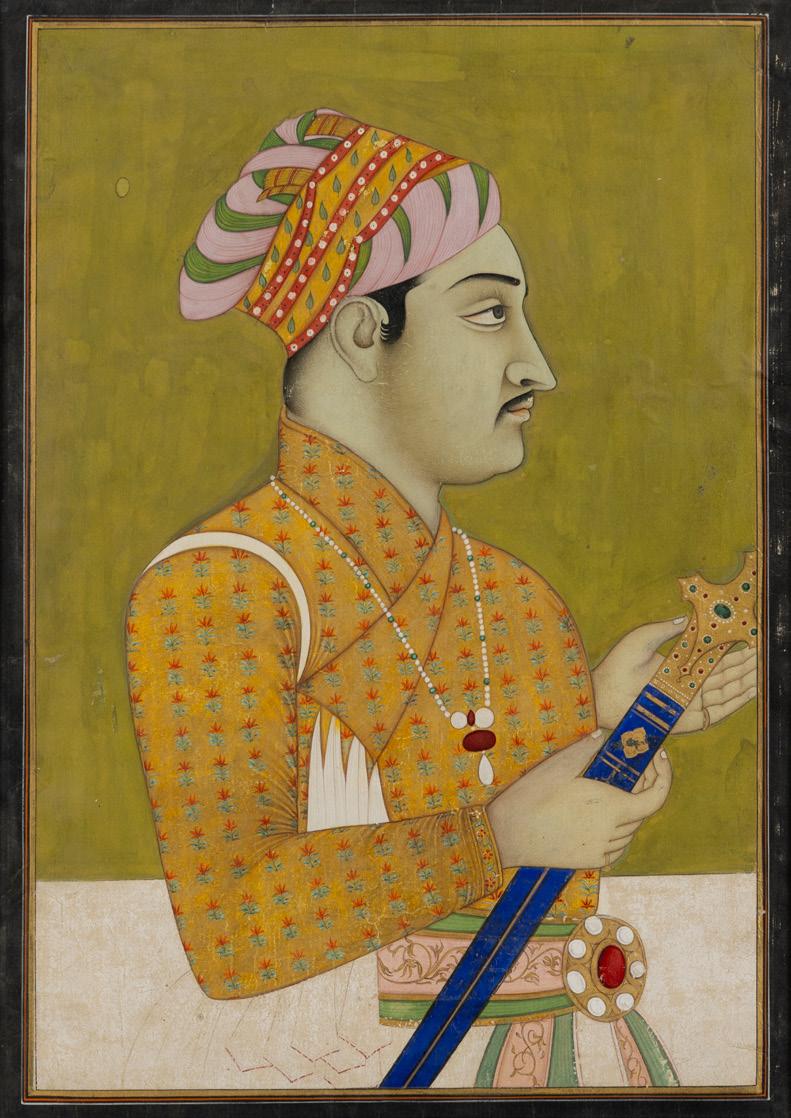
AN IMPRESSIVE PORTRAIT OF A MUGHAL PRINCE, POSSIBLY SULTAN MURAD MIRZA, SON OF MUGHAL EMPEROR AKBAR
INDIA, PROVINCIAL MUGHAL, 18TH CENTURY
gouache on paper heightened with gold, depicting the prince standing in profile wearing a green and pink turban, dressed in a yellow and red jama with pink and green sash, holding a gem-set sabre with blue sheaf, against a green ground, mounted, glazed and framed
Sight size 43.3cm x 31cm
£6,000-8,000
Prince Murad Mirza (1570–1599), the second surviving son of Mughal Emperor Akbar, was the first Mughal prince to receive an education from Western Jesuit priests. In 1593, he was appointed to lead the Mughal army in the Deccan. However, his leadership proved largely ineffective, primarily due to his struggles with alcoholism.
72
AN ILLUSTRATION FROM A RAGAMALA SERIES: KAMOD RAGINI
INDIA, DECCAN, LATE 18TH CENTURY
ink and watercolour on paper, detailed highlights in white, within a goldlined black border, further blue and gold margin rules, gold decorated border, depicting a Nayika stringing garlands offered on a tray by a female attendant under a blossoming drooping tree, signed in ink lower left in Persian with ‘Riza’, verso inscribed with a Mughal Raqam mark
28cm x 18.5cm
£600-800
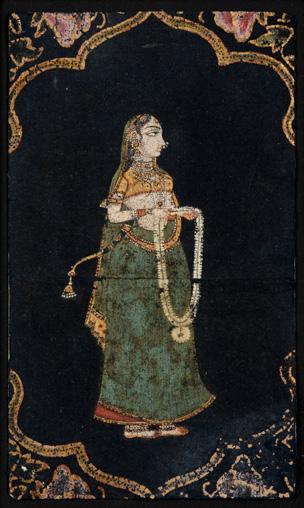
73
74
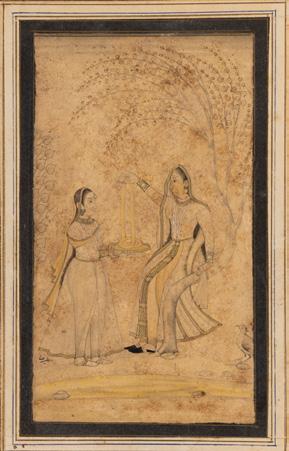
AN EARLY PICCHAVAI FRAGMENT OF A GOPI HOLDING A GARLAND
INDIA, DECCAN, 18TH CENTURY
opaque watercolour heightened with gold on a dyed black cotton ground, backed with a piece of eighteenth or nineteenth century silk brocade, the elegant gopi adorned with jewellery, stands facing right holding a white floral garland, dressed in an olive green pleated sari edged with gold over a crimson underskirt, within a gold cartouche
24cm x 13.5cm
£2,000-3,000
Provenance: Acquired from Terence McInerney in 2006.
This image is a fragment from a larger wall hanging or picchavai. Picchavais are temple hangings of the Vallabhacharya sampradaya (sect), founded by the scholarly saint and legendary religious teacher Vallabhacharya around 1500. Its members worship Krishna Govardhana as Srinathji, the divine child king. The original wall hanging probably had a row of similar gopis within cartouches along its lower edge, or in the borders surrounding the central devotional image. Deccani wall hangings of this period with a black ground are rare. As the colour black does not maintain its pigment as well as others, un-retouched pieces are not often found. Similar gopis can be seen in the inner border framing the central design of Krishna fluting in a late eighteenth century Deccani picchavai on a very dark blue, almost black, cotton ground in the Calico Museum, Ahmedabad.
AN ILLUSTRATION FROM A RAGAMALA SERIES: BANGAL RAGINI
INDIA, PROVINCIAL MUGHAL, PROBABLY FAIZABAD, CIRCA 1770
gouache on paper heightened in gold, depicting a barefooted maiden standing under an olive tree in an otherwise barren landscape worshipping the moon, wearing a transparent dopatta over a transparent choli and skirt, a tray lies close to her feet with various offerings including a ewer, mounted, glazed and framed 29.3cm x 20.4cm
£1,500-1,800
Provenance: Formerly, a Private American Collection.

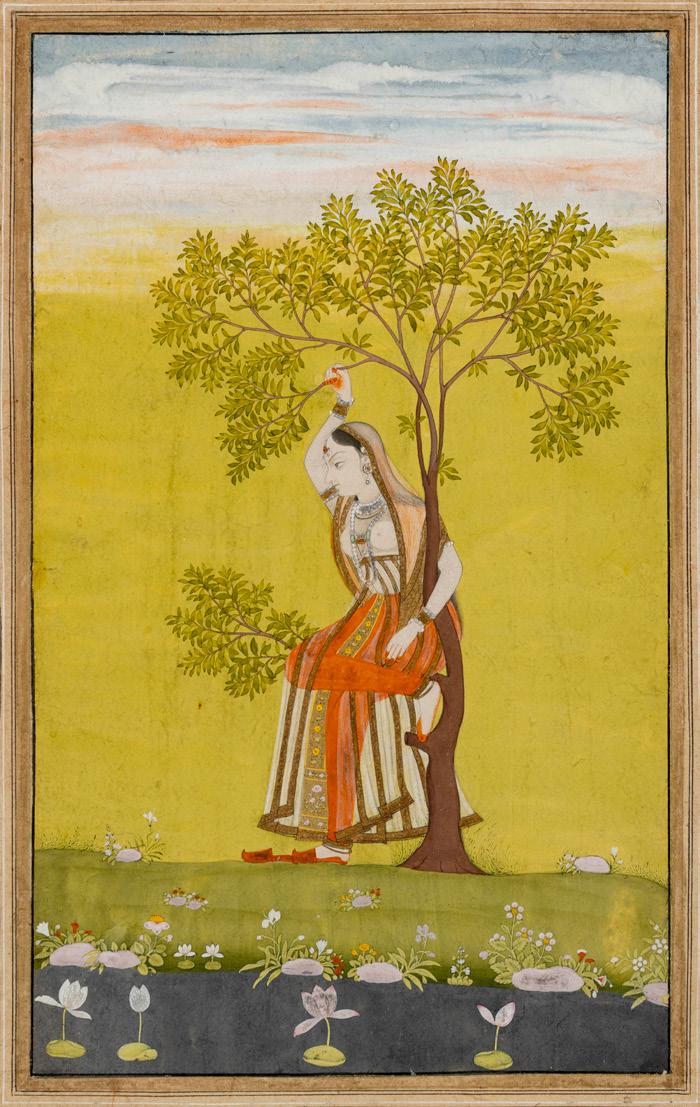
AN ILLUSTRATION FROM A RAGAMALA SERIES: KAMOD RAGINI INDIA, DECCAN, HYDERABAD, CIRCA 1800
gouache on paper heightened with gold, gilt-decorated borders with coloured margin rules, depicting a solitary maiden wearing jewellery and dressed in a transparent choli seated under a tree and pulling one of the branches, her hands covered in henna, within a green landscape, a pond with lilies in the foreground, mounted, glazed and framed
Sight size 21.5cm x 14.5cm
£2,000-3,000
Kamod Ragini embodies viraha, the poignant emotion of separation and longing. In this painting, Kamod is our heroine, having adorned herself with henna’d hands, she is picking from the tree above. The orange sky suggests it is dawn and that she has been waiting all night in vain for her lover.
76
A MUSICIAN PLAYING A TAMBUR
CENTRAL INDIA, BUNDELKHAND, CIRCA 1860
watercolour on paper, depicting the musician seated in a European-style chair on a green and pink carpeted terrace, mounted, glazed and framed
sight size 22.7cm x 16.4cm
£800-1,200
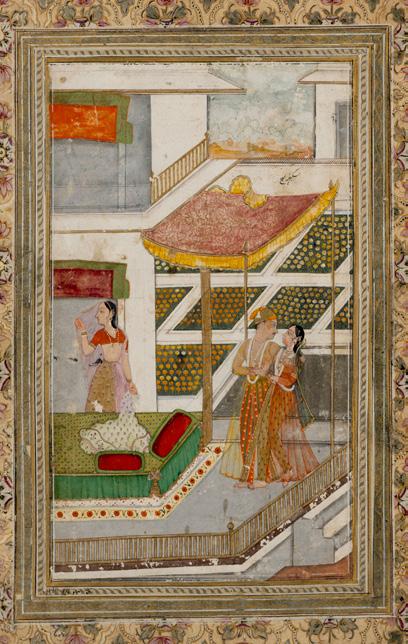
78
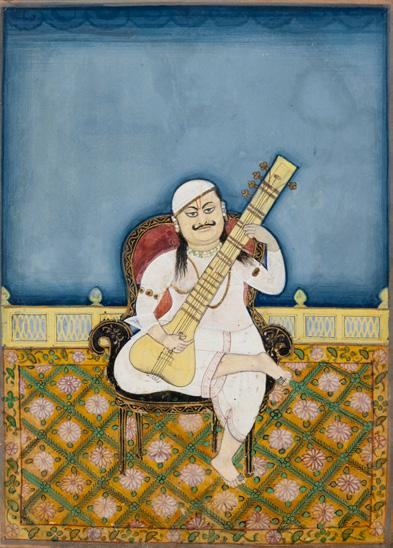
77
AN ILLUSTRATION FROM A RAGAMALA SERIES: BAIRADA RAGINI
INDIA, DECCAN, HYDERABAD, CIRCA 1800
gouache on a paper heightened with gold, mounted on an album page with gilt decorated borders, depicting a couple caressing on a palace terrace, a female attendant preparing a bed-chamber to the left, formal gardens in the background, an inscription in nasta’liq on painted surface, a nasta’liq quatrain on the reverse, mounted, glazed and framed
sight size: 34.5cm x 23.2cm
£1,000-1,500
A PORTRAIT OF A NIZAM, POSSIBLY NIZAM ASAF JAH II OF HYDERABAD
INDIA, DECCAN, HYDERABAD, CIRCA 1800
gouache on paper heightened with gold, dark blue border with red margin lines, depicting the ruler seated in a European-style chair on a palace terrace, facing right holding a rose, formal gardens in the background, mounted, glazed and framed
Sight size; 25cm x 18.8cm
£1,000-2,000
Provenance: Formerly, from a private French collection.
For comparison see M. Zebrowski, Deccani Painting, London, 1983, no. 246.
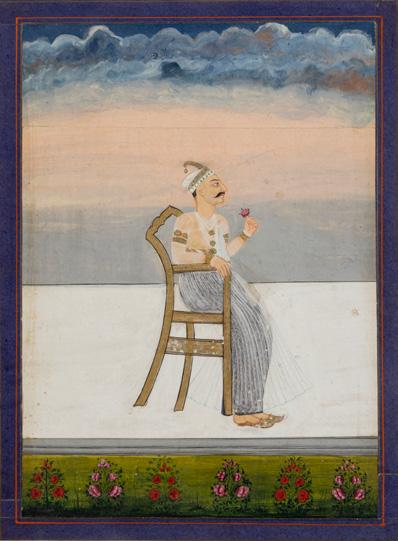
AN ILLUSTRATED FOLIO FROM A DISPERSED SHAHNAHMEH: RUSTAM SLEEPS WHILE RAKHS FIGHTS OFF A LION INDIA, PROVINCIAL MUGHAL, DECCAN, SECOND HALF OF 18TH CENTURY
gouache heightened with gold and ink on paper, with an elegant gold and polychrome decorated border with a floral lattice design, the image with red, gold and blue rules depicting Rustam dressed in his tiger-striped tunic, his head resting on his shield on a blue striped cushion, his eyes closed in deep sleep, holding a sword in his right hand, his quiver case to his left, in the foreground his faithful horse, Rakhs, is seen biting into the back of a lion, all within a rocky, wooded and green landscape, verso with text in nasta’liq divided into four columns 29.2cm x 17.8cm
£2,000-3,000
Provenance: Private UK Collection.

A PRINCESS AND TWO ATTENDANTS KNEELING BY A WATERFALL IN A ROCKY LANDSCAPE
INDIA, DELHI, MID-19TH CENTURY
gouache on paper, mounted on an album page with illumination in colours and gold, depicting a princess at worship at the side of a waterfall flowing from a hillside, wearing a transparent dopatta draped over her choli and sari, her hands raised in worship with trays of artefacts of worship before her, two female attendants kneeling at her side, the edge of the album page inscribed ‘Rani Padmini’
37.3cm x 27.7cm
£1,000-1,500
Rani Padmini, also known as Padmavati, is a legendary 13th/ 14th century queen of the Rajput kingdom of Mewar, famed for her beauty, valour, and tragic end. According to the epic poem Padmavat (1540 CE) by Malik Muhammad Jayasi, she was the wife of Rana Ratan Singh. Sultan Alauddin Khilji of Delhi, hearing of her beauty, attacked Chittor to capture her. Facing inevitable defeat, Padmini and other Rajput women committed jauhar (ritual self-immolation) to protect their honour. In our painting, Rani Padmini, is represented possessing divine gifts.
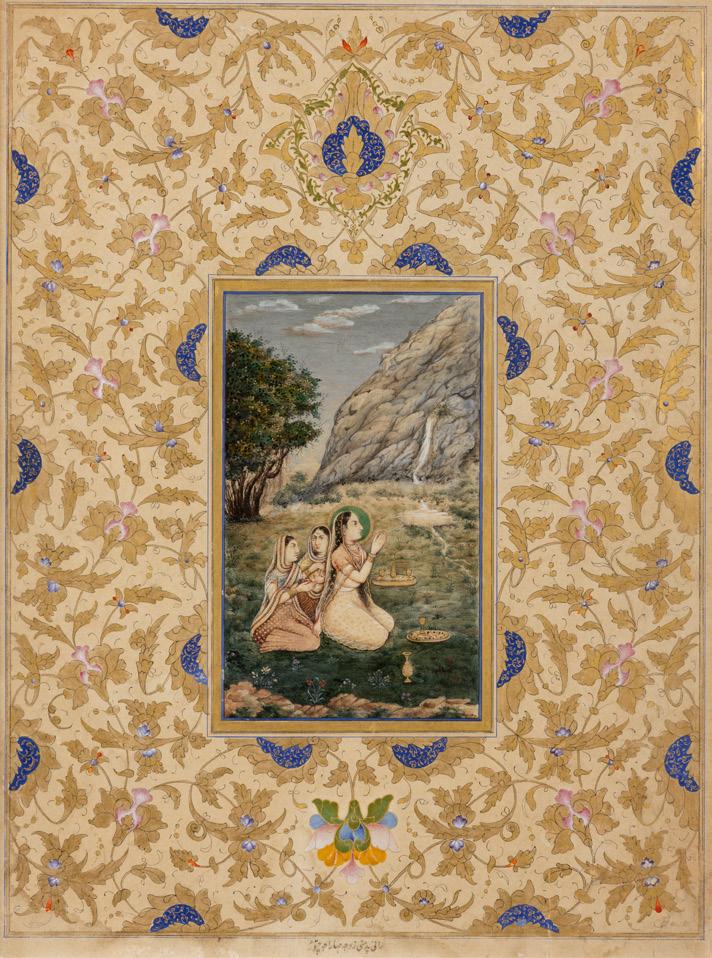
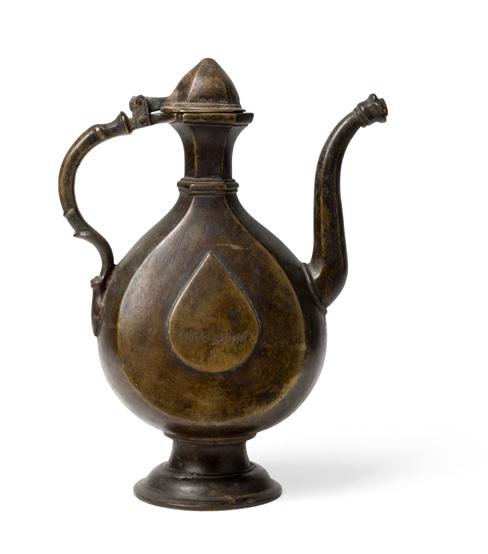
A MUGHAL BRONZE EWER
NORTHERN INDIA, LATE 17TH/ EARLY 18TH CENTURY
cast bronze on a flared foot, the tear-shaped body with hinged-domed lid, tear-shaped design moulded in relief on either side of the body, with S-shaped faceted handle and spout, owner’s inscription in nagari on one side
30.3cm high
£400-600
For a comparable example dated to 1584, see Exhibition Catalogue, The Great Mughals, London, 2025, no. 61, p. 83.
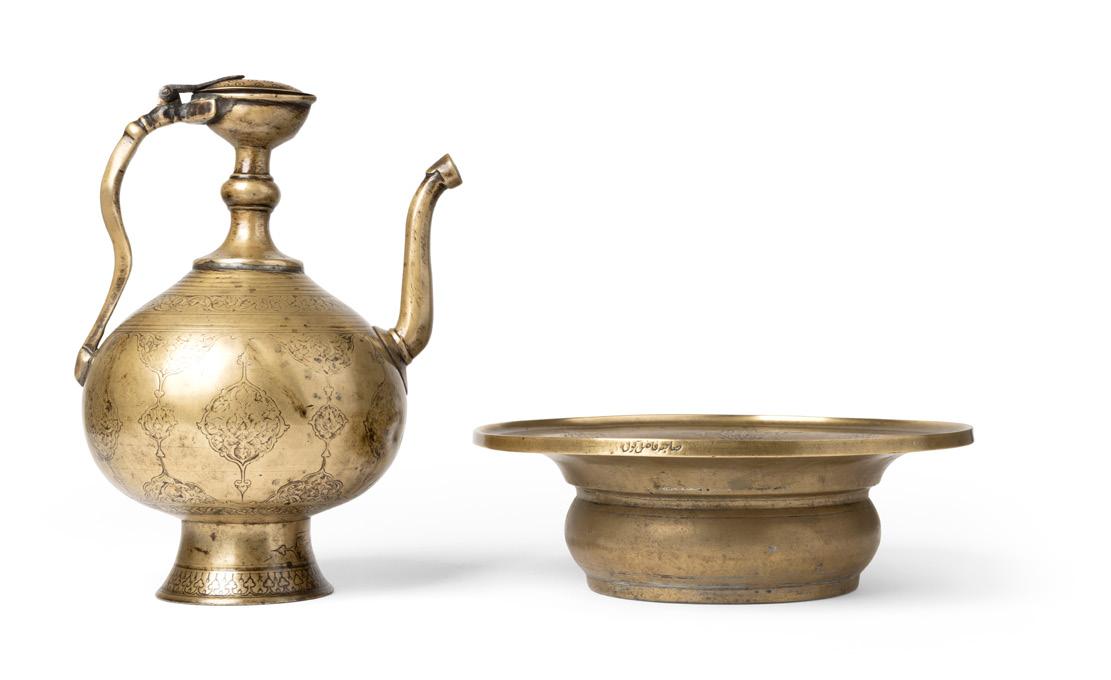
82
A PERSIAN-STYLE MUGHAL BRASS EWER AND BASIN NORTHERN INDIA, 16TH/ 17TH CENTURY
the ewer of squat baluster form on a tall splayed foot, with curving spout and handle, the body engraved with a frieze of diamond-shaped-pointed palmettes, the shoulder with meandering floral motifs, the bowl with similarly decorated motifs around the rim, the exterior rim inscribed with the owner’s name, Fazil Gul
Ewer 31.5cm high; bowl 30.5cm diameter
£1,500-2,000
A bowl of very similar shape was recently exhibited at The Great Mughals exhibition at the Victoria and Albert Museum, see S. Stronge, The Great Mughals, London, 2024, no. 51; and for a comparable ewer with its globular-shaped body, see M. Zebrowski, Gold, Silver & Bronze, London, 1997, no. 211, p. 157.
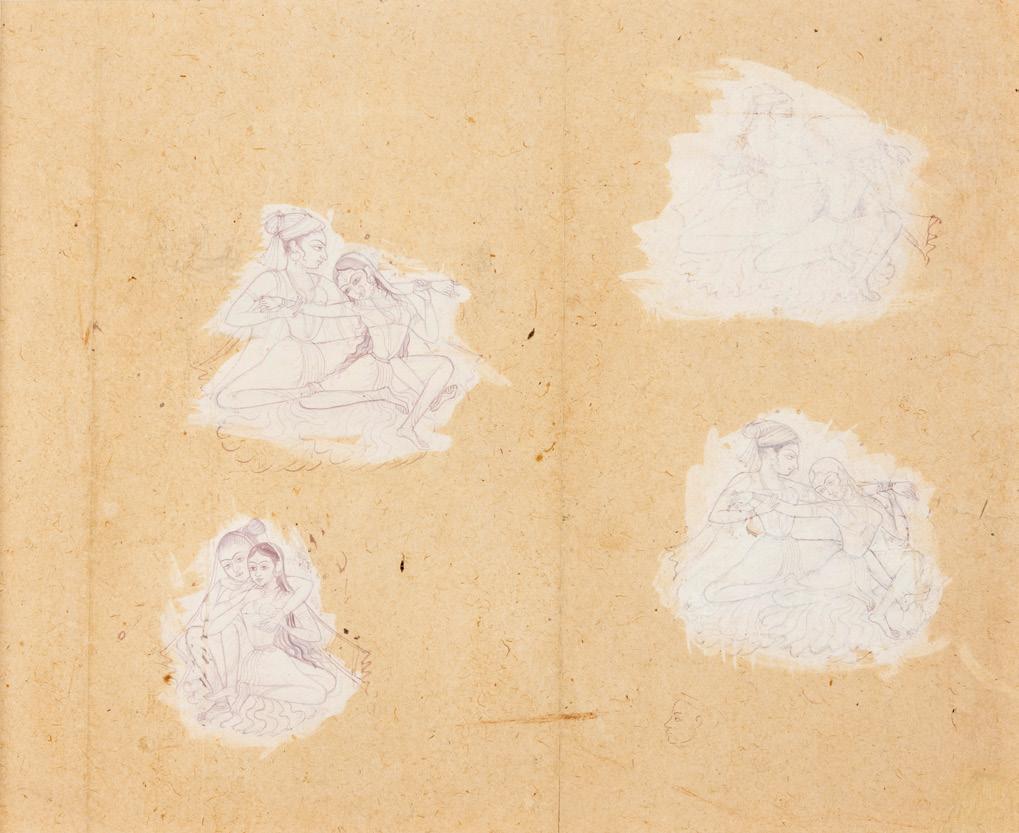

83
FOUR STUDIES FOR AN EMBRACE INDIA, RAJASTHAN, 18TH CENTURY
pen and ink on buff paper, the four studies done on areas of opaque white watercolour used as a base, mounted, framed and glazed
19.5cm x 24cm
£1,000-2,000
Provenance: Private UK collection.
84
A SILVER-INLAID ALLOY BIDRI SURAHI
INDIA, 18TH CENTURY
of globular form with tall and slightly flaring neck, the body decorated with an allover lattice design consisting of flowerheads within leafy frames
29.5cm high
£600-800
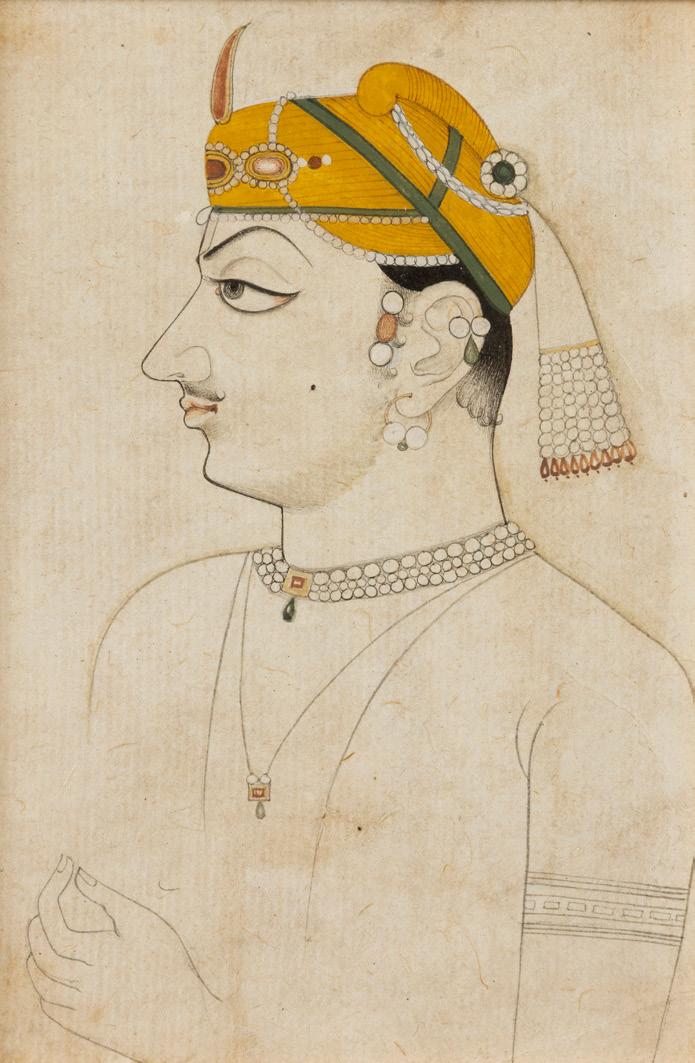
A PORTRAIT OF A YOUNG MAHARAJA INDIA, RAJASTHAN, MARWAR, 18TH CENTURY
drawing on buff paper with use of gouache and gold, head and shoulders of the young maharaja facing left, wearing a yellow turban adorned with jewels and a jewelled sarpech, rows of pearls and pendants with emeralds and rubies around his neck, his left hand slightly raised as if he was holding a flower or a jigha, mounted, glazed and framed sight size: 17.2cm x 11.4cm
£1,000-1,500
Portraits executed at Marwar, the state surrounding Jodhpur, were popular during the reign of Maharaja Bakht Singh (r. 1751-1753) and this portrait of a young maharaja decorated with jewels, befitting his status, is a fine example. Marwari Court artists were influenced by the work of seventeenth Mughal artists and continued the tradition into the eighteenth century. For a comparable work see, D. Mason, T. McInerney, J. Seyller and E. Smart, Intimate Worlds, Indian Paintings from the Alvin O. Bellak Collection, Philadelphia, 2001, no. 57.
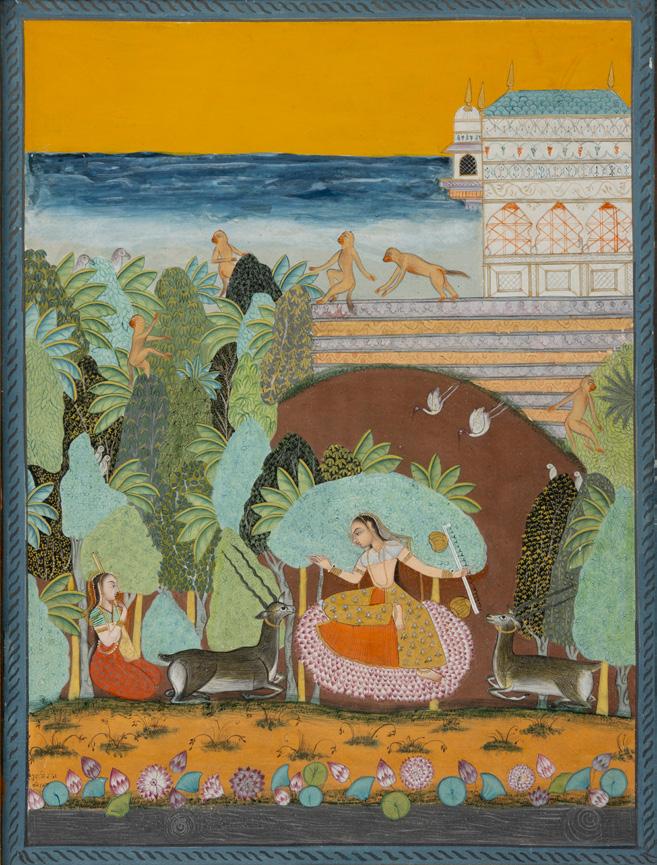
AN ILLUSTRATION FROM A RAGAMALA SERIES: TODI RAGINI INDIA, RAJASTHAN, PROBABLY AMBER, CIRCA 1750
gouache on paper heightened in gold, blue striped border, a richly detailed image depicting an exotic forest landscape with bountiful flora and fauna and monkeys, in the foreground near the water’s edge, the main female figure is seated on a pink lotus throne holding a vina in her left hand and holding her right hand over a tame gazelle, flanked by a further gazelle and a female musician playing a tambour kneeling to the left, monkeys running through trees and along a palace roof in the background against a yellow sky, lotus flowers alongside a brook in the foreground, a blank yellow panel above the painting probably intended for text
26.3cm x 19.7cm
£3,000-5,000
Provenance: Formerly, private French collection. For an illustration from the same series, entitled Gaudi Ragini, in the Cleveland Museum of Art, see L. Y. Leach, Indian Miniature Paintings and Drawings, Ohio, 1986, Fig. 61 and for an almost identical painting sold at Bonhams, see, Indian, Himalayan & Southeast Asian Art, 18 September 2013, lot 132. These two pages and ours share the same blue-striped borders and green luscious landscape with monkeys.
Three pages from this series are in the San Diego Museum of Art (nos. 1990.8.851, 855, 856).
Another page is in the Los Angeles County Museum of Art (M.71.1.42), see Rosenfield, The Arts of India and Nepal, Boston, 1966, p. 173.
AN ILLUSTRATION FROM A RAGAMALA SERIES: TODI RAGINI INDIA, RAJASTHAN, AMBER, CIRCA 1740
gouache on paper heightened in gold, depicting a maiden holding a vina walking amongst gazelles in a landscape, trees and a temple on a hillside in the background, yellow panel above with five lines of nagari text above, a row of lotus flowers below, mounted, glazed and framed
26.5cm x 18.4cm
£1,000-2,000
Provenance: Formerly, from a private French collection.


AN ILLUSTRATION FROM A RAGAMALA SERIES: MADHUMADHAVI RAGINI
INDIA, RAJASTHAN, AMBER, CIRCA 1700
gouache on paper heightened in gold, gold and red border, two lines of nagari text above in a yellow panel, depicting a nayika holding a cup of water out to the peacocks resting in the tree, and holding a surahi in her left hand, a female attendant waits on her with a tray with more cups, to the right a maid servant is freshening up her bed inside a palace pavilion
31cm x 23.5cm
£3,000-4,000
Provenance: Formerly, Private Collection, London.
For illustrations from the same series, see Christie’s, The Doris Wiener Collection, 30 March 2012, lots 283 and 285, and; Bonhams, Indian, Himalayan & Southeast Asian Art, 11 September 2012, lot 60. These paintings along with our painting are characterised by their diminutive female figures contrasting with bold background colours, two lines of nagari text against a yellow background above, a pink layered brick wall below with a side shadow, and lastly the red and gold border.
Two slightly earlier paintings in the Victoria and Albert Museum attributed to Amber share a similar composition (IS.78-1952; IS.82-1952).

AN ILLUSTRATION FROM A RAGAMALA SERIES: DESAKH RAGINI
INDIA, RAJASTHAN, KOTAH, CIRCA 1760
gouache on paper, red border, 4 lines of text in nagari script against a yellow ground above, depicting five gymnasts performing acrobatics around a central pole, two of the gymnasts balancing on the pole, including a female acrobat dressed in blue trousers at the top of a pole, whilst three in the foreground are showing off their strength in various poses, on a green ground with a line of plantain trees at top 40.1cm x 26cm
£3,000-5,000
Provenance: Private UK collection.
This liveliest of ragamala illustrations brings together the physical strength of the five gymnasts using the vibrant colours of Rajasthani painting. Figures performing upside down on a central pole and defying gravity was a popular act at village fairs around India. In this particular painting you can almost hear the gasps of the onlookers. For further discussion and another illustration of this subject see: E. and R.L. Waldschmidt, Miniatures of Musical Inspiration Part II, Ragamala - Pictures from Northern India and the Deccan, Berlin, 1975, and; C. Glynn, R. Skelton and A. Dallapiccola, Ragamala, Paintings from India from the Claudio Moscatelli Collection, London, 2011, no.10.
For another illustration from the same series, entitled Asavari Ragini sold at Christie’s, see Art of the Islamic and Indian Worlds including Rugs and Carpets, 24 October 2024, lot 161. This painting and our painting share the same bright colours, composition and size.
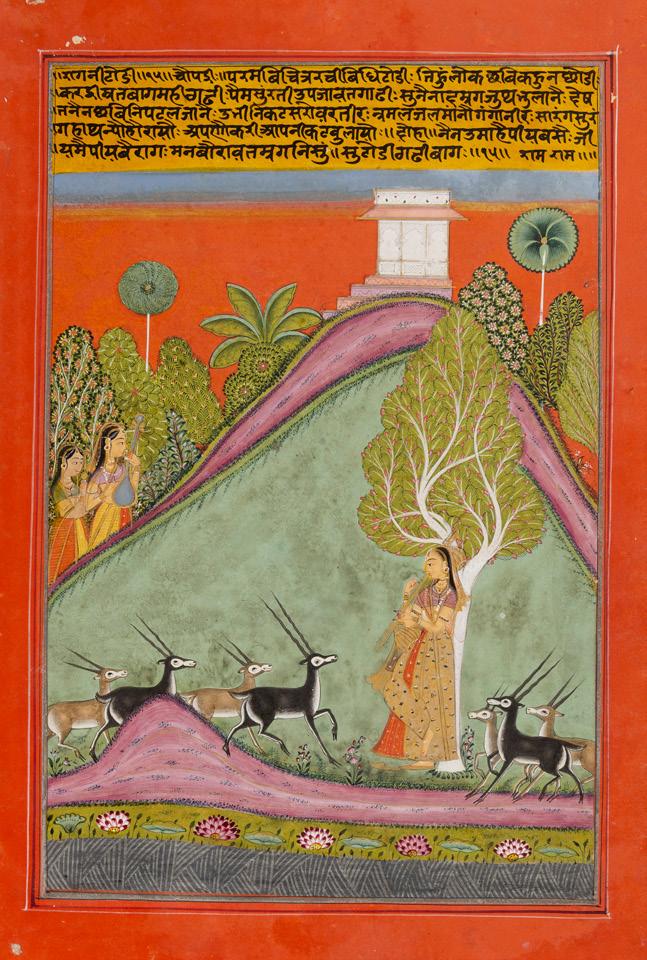
‡
AN ILLUSTRATION FROM A RAGAMALA SERIES: TODI RAGINI
INDIA, RAJASTHAN, AMBER, CIRCA 1740
gouache on paper heightened in gold, red border, with five lines of nagari text above on a yellow ground, a maiden is playing a vina at the side of a stream surrounded by tame gazelles, female musicians in the background showing a pavilion with palm and plantain trees against a bright orange sky
30.4cm x 22.4cm
£3,000-4,000
Provenance: From a Spanish Private Collection, formerly in the collection of the Maharaja of Bikaner. This striking ragamala illustration is from a well known series attributed to Amber or nearby Jaipur, painted in the second quarter or middle of the eighteenth century. The artists from the region used the vibrant colours of flaming red, orange and yellow as a background to the green vegetation with musical instruments and garments often highlighted in gold. The panel of nagari text against a yellow background adds to the intensity of the colours and richness of the palette. The subjects are endearing as they tell the stories of individual ragas and musical modes and in this case the passion of the young maiden amongst gazelles in lush, fertile vegetation.
There is a very similar illustration from the same series, formerly in the Edwin Binney, 3rd, collection, in the San Diego Museum of Art, accession number 1990.850; another in the Art Institute of Chicago, gift of Russell Tyson, accession number 1962.147.15; another in the Los Angeles County Museum of Art, formerly in the Nasli and Alice Heeramaneck Collection, accession number M.71.1.42 and lastly; Yale University Art Gallery, Gift of Mrs. John D. MacDonald, accession number 2001.138.54.
For three illustrations from the same series sold at Christie’s, see, Arts of India, 12 June 2018, lots 18, 19, and 20. They share the same bright colours, elegance and composition as our painting.
MAHARANA ARI SINGH HUNTING WILD BOAR BY THE MASTER ARTIST SHIVA INDIA, RAJASTHAN, UDAIPUR, DATED 1764 gouache heightened in gold on paper, depicting the maharana with a drawn bow and arrow, astride his galloping and richly caparisoned black stallion to the rescue of a fallen hunter being attached by an enraged wild boar, the hunter has tumbled head first still holding on to his steel katar and shield in the other hand, the wild boar biting into his arm, whilst two hunting or saluki hounds are biting into the wild boar, on a green ground, inscribed on the reverse in devanagari in two different hands with the name and titles of the Maharana, the subject of the painting, the name of the horse and the name of the painter ‘Shiva’
22.5cm x 40.5cm
£8,000-12,000


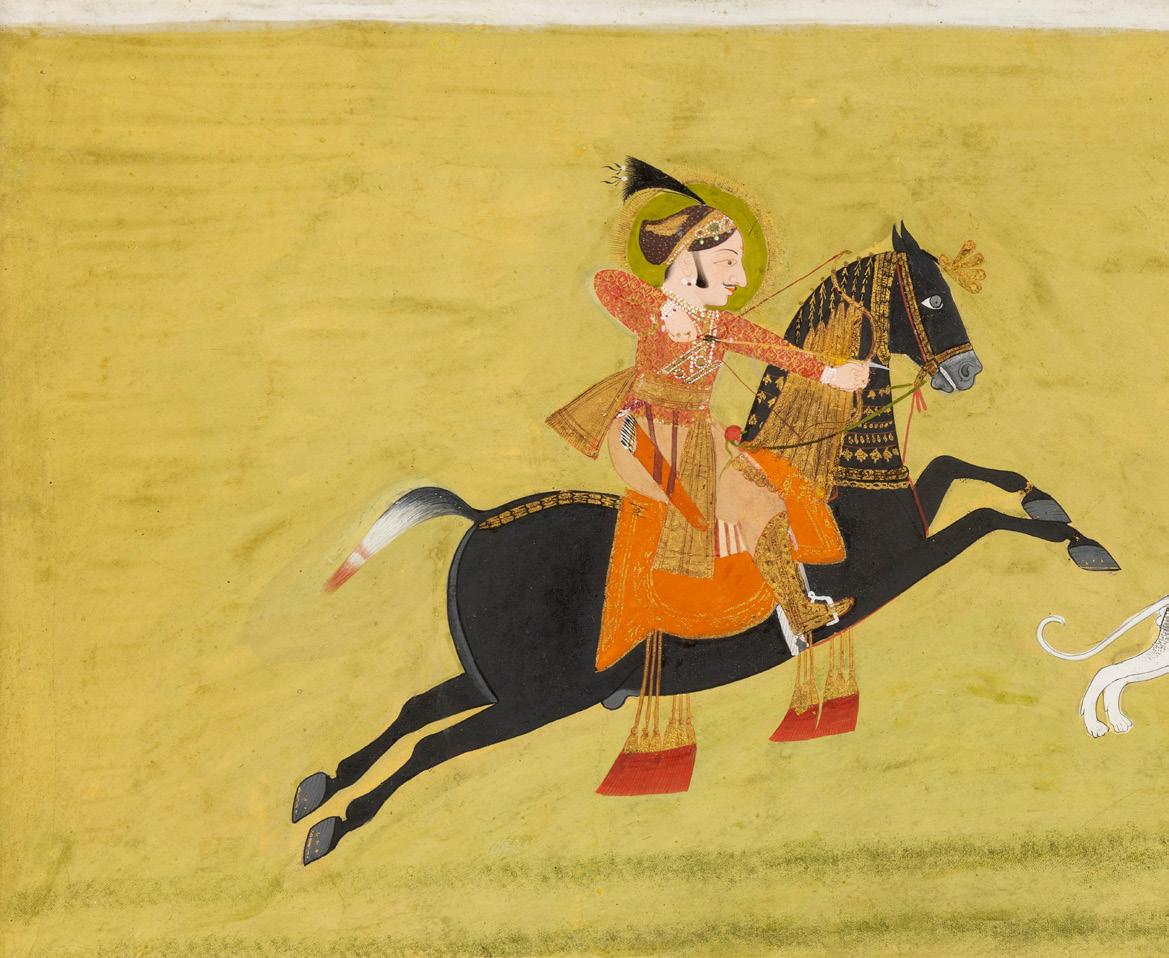
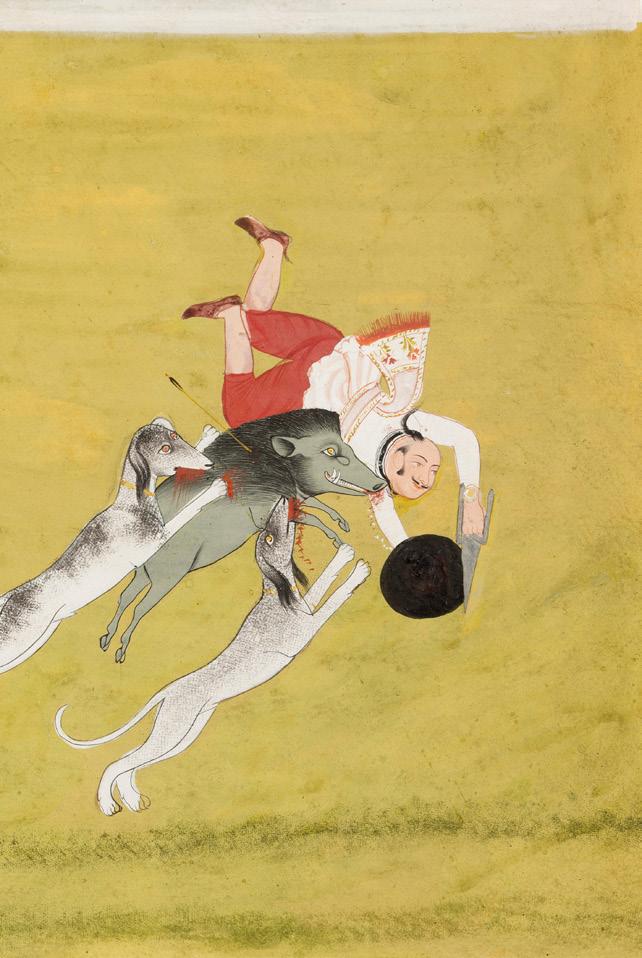

Provenance: Mewar Royal Collection, inventory number 3/246. Spink and Son, London, 1987.
No doubt Ari Singh was a splendid horseman and wanted his painters to celebrate his riding skills while providing him with a glittering, heroic context in which to be depicted, rather different from the reality of his wilful and ill-tempered character and the meagre achievements of his turbulent rule. Despite his unpopularity and ruthlessness, Ari Singh presided over a period of abundant painting. When depicted in his public persona, Ari Singh appears most often on horseback. During the first two years of his reign, 1761-1762, his artists produced a spate of equestrian procession scenes, showing him mounted on his favourite stallions with an entourage of up to twenty attendants on foot, in the well-worn convention developed under Sangram Singh (see A. Topsfield, Court Painting at Udaipur: Art under the patronage of the Maharanas of Mewar, 2002, p. 199).
Solitary equestrian portraits were also produced, including spirited studies of the Rana wheeling at speed as he practices horsemanship or galloping beside his boon companion Rupji (see A. Topsfield, Paintings from Rajasthan in the National Gallery of Victoria, 1980, pp. 120 and 123, cat. nos. 170 and 179). In other paintings he is shown shooting wild boar from his horse while out hunting in the hills surrounding Udaipur (see A. Topsfield, op. cit, 2002, p. 201, fig. 182. See also A. Topsfield, op. cit, 1980, p. 121, cat. no. 171. For a similar painting with the artist name as Deva, see op. cit, cat no. 155.
Shiva, the son of Naga and grandson of Bhagvan, was a junior artist at the Mewar court in Udaipur. A painting by Shiva dated 1761 of “Ari Singh practicing horsemanship” is illustrated in Andrew Topsfield, The City Palace Museum Udaipur: Paintings of Mewar Court Life, 1990, p. 54, cat. no. 17. Topsfield also illustrates on p. 53, no. 16, a painting of “Maharana Raj Singh II riding in procession to the Saranesvarji temple”, on which Shiva collaborated with the senior artists Syaji and Sukha.
A RAJPUT NOBLEMAN HOLDING A FLOWER
INDIA, RAJASTHAN, MEWAR, CIRCA 1760
gouache on paper heightened in gold, red border with black margin rules, the nobleman holding a flower standing facing left, wearing a white turban and jama, a floral patka tied around his waist, a sword and shield hanging from his shoulder
29.4cm x 22.4cm
£2,000-3,000
Provenance: Private UK collection.
This portrait follows a series of portraits of early Maharanas by the artist Suhajii presented to Maharana Ari Singh (r. 1762-1772) on his accession. For comparison see A. Topsfield, Paintings from Rajasthan in the National Gallery of Victoria, Melbourne, 1980, nos. 181 and 182.

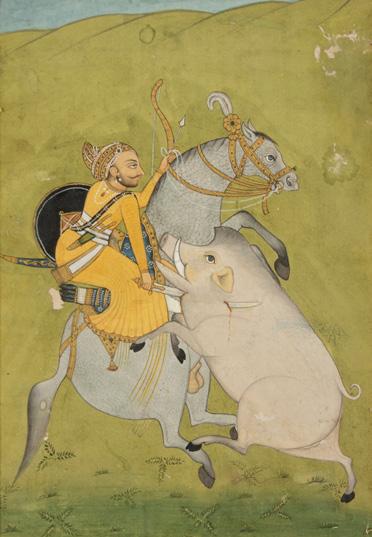
A MAHARAJA ON HORSEBACK HUNTING A WILD BOAR
INDIA, RAJASTHAN, JODHPUR, CIRCA 1800 gouache on paper heightened in gold, the maharaja dressed in a yellow jama, his hunting armour strapped to his sash, he is wielding his sword into the wild boar’s chest, whilst holding the reins of his rearing horse in his left hand, within a green and hilly landscape, glazed, mounted and framed Sight size 21.3cm x 14.7cm
£500-700
Provenance: Private UK collection.

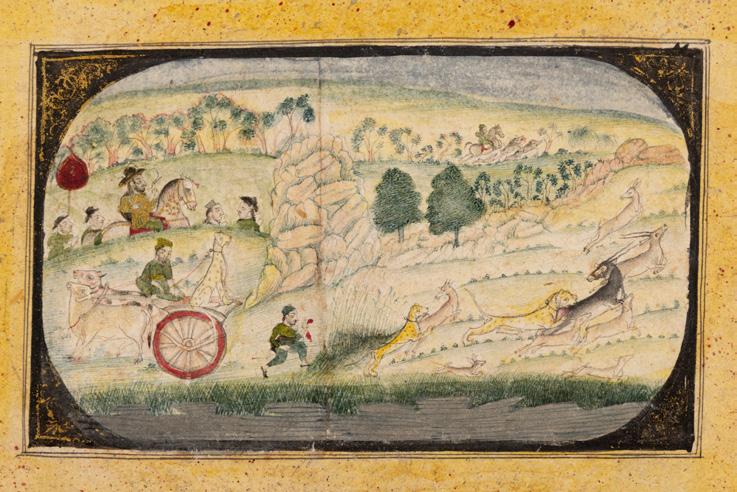
A GAZELLE HUNT LED BY EUROPEANS IN A ROCKY LANDSCAPE ATTRIBUTED TO CHOKHA (ACTIVE, EARLY 19TH CENTURY)
INDIA, RAJASTHAN, DEVGARH OR MEWAR, CIRCA 1800
gouache with some areas highlighted in gold on paper, black inner border with gold highlights, depicting leopards chasing gazelles up a hillside, one leopard chained on a cart drawn by oxen, a European huntsman on horseback with retainers on foot watching the scene in the background
Image: 7cm x 11cm; Folio 19cm x 23.5cm
£4,000-6,000
Provenance: Private UK collection.
The present minute image measuring a mere 7cm x 11cm is an extremely accomplished hunting scene, given the size. It is painted in the distinct style of the artist Chokha (active circa 1799-1826), the son of Devgarh artist Batra. The sketch-like quality reflects Chokha’s early career and can be compared to the earliest known inscribed painting by him in the National Gallery of Victoria attributed to circa 1799 (see A. Topsfield, Paintings from Rajasthan in the National Gallery of Victoria, 1980, no. 207). The sketching of the horse’s head in our painting can be closely compared to the execution of the horses in the painting entitled ‘Wild Horses’, in the Harvard Art Museum (accession no. 1995.88).
There was great interaction between the Devgarh and Mewar schools of painting at this time. The Europeans in the background may have been visiting the Devgarh court where European maps and lithographs were available to the court artists. For further discussion about the artist Chokha and his father see M.C. Beach, Bagta and Chokha, Master Artists at Devgarh, Museum Rietberg Zurich, 2005.
actual size
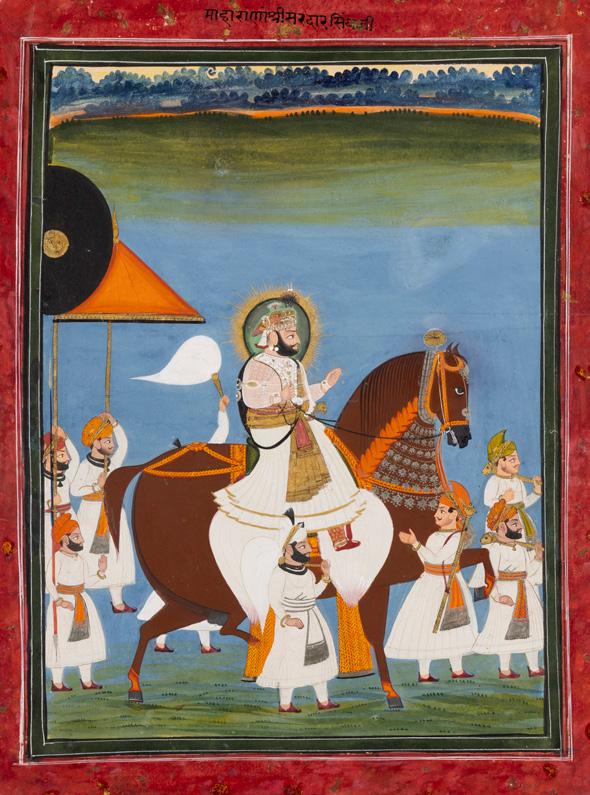
AN EQUESTRIAN PORTRAIT OF A RAJPUT NOBLEMAN
INDIA, RAJASTHAN, JODHPUR, EARLY 19TH CENTURY
gouache and ink on paper, black border, the raja dressed in white riding a brown stallion to the left, two retainers walking alongside, mounted, glazed and framed
Sight size 25.2cm x 21.4cm
£1,000-1,500
Provenance: Formerly, from a private estate in California. 95
A LARGE EQUESTRIAN PORTRAIT OF JAWAN SINGH OF UDAIPUR
(R.
1778-1828) ATTRIBUTED TO RAMA
INDIA, RAJASTHAN, MEWAR, CIRCA 1835
gouache and gold on paper, red border with black margin rules, inscribed in nagari in black ink, the ruler riding a brown stallion to the right, resplendent in a gold turban decorated with jewels and a white jama, a nimbus about his head, retainers running alongside waving cauris and bearing banners and canopy
40.8cm x 33.7cm
£2,000-3,000
This imposing equestrian portrait of Maharana Jawan Singh, possibly riding Eklinga Baksh, one of his favourite stallions, excites with its majesty and movement. For further discussion and comparisons see L. York Leach, Mughal and Other Indian Schools from the Chester Beatty Library, Dublin, London, 1995, pp.1014-1018; A.Topsfield, Paintings from Rajasthan in the National Gallery of Victoria, Melbourne, 1980, nos. 234 and 236; D.Diamond and D.Kheera, A Splendid Land: Paintings from Royal Udaipur, Washington D.C., 2023, and these rooms, Islamic and Indian Art, 11 December, 2024, lots 78 and 79.
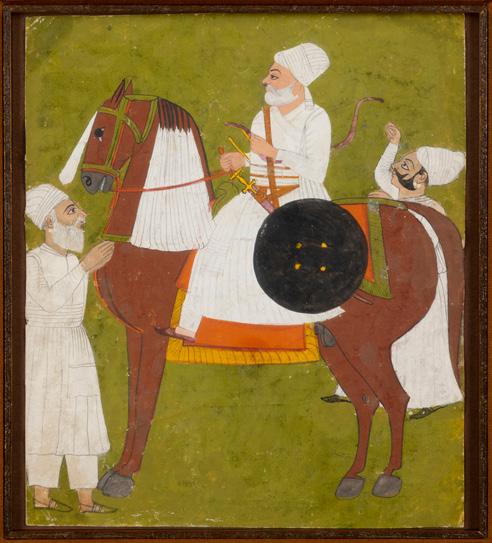
97
A RAJPUT EQUESTRIAN PORTRAIT
INDIA, RAJASTHAN, JODPHUR, CIRCA 1810
gouache and gold on paper, red and inner yellow border, the young Rajput prince riding a bay horse richly caparisoned in procession to the left, three retainers running alongside, the maharaja wearing a red turban and white jama, the retainers also dressed in white, verso with nagari inscription, mounted, framed and glazed
Sight size 30.3cm x 20.9cm
£1,000-1,500
The canter of the stallion and the running steps of the retainers alongside give movement and rhythm to this fine equestrian portrait of the young maharaja. For a comparable painting, see R. Crill, Marwar Painting, A History of the Jodhpur Style, Mumbai and Jodhpur, 1999, fig. 93.
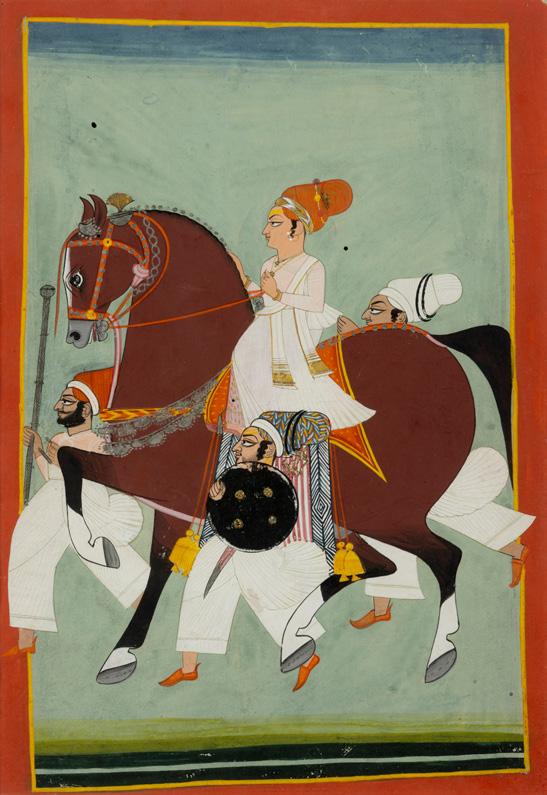
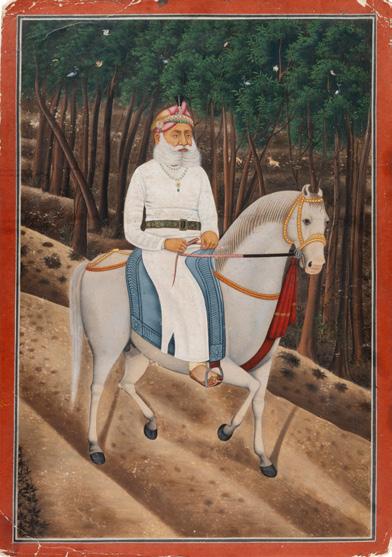
98
THE MAHARAJA FATEH SINGH OF UDAIPUR AND MEWAR (R. 1884-1930)
RIDING HIS GREY HORSE
INDIA, LATE 19TH CENTURY/ EARLY 20TH CENTURY
gouache on paper highlighted in gold, red border, depicting the Maharaja on his grey horse on a wooded path with a variety of birds in the trees, verso backed with many pages of nagari script
71cm x 50cm
£500-700
Fateh Singh was the Maharaja of Udaipur and Mewar from 1884 to 1930. He was known for his conservative and independent ruling style, which was often at odds with the desires of the British government during the British Raj. This led to his eventual deposition in 1921, whereupon his son Bhupal Singh took over. Also an avid hunter, Fateh Singh commissioned many royal procession and hunting scenes along with numerous portraits throughout his reign, wanting to highlight his favorite activity. This portrait on a grey horse was likely one of these pieces created during his life.
THE ACHARYA JAIJAIRAM JI AND DEVOTEES LISTENING TO DEVOTIONAL CHANTS
INDIA, RAJASTHAN, UDAIPUR, CIRCA 1745
gouache heightened with gold on paper, inscribed to the top of the red border in devanagari identifying the impressive figure of Jaijaram, who is seated cross-legged on a white mat in front of white tripolya and holding a long string of prayer beads or rudrakshamala, placed on the mat are adjuncts to meditation including a bowl of cut flowers, a pandan open to reveal fresh betel quids, a chowrie, a back scratcher, lotas and shorter strings of beads, a standing attendant waves a morchal behind him, whilst two priests in front of him are kneeling, one of whom holding strings of beads, below in the foreground three figures are holding cymbals, and two below right are playing the drums, verso with Mewar royal inventory inscriptions, mounted, glazed and framed
50.5cm x 34.5cm
£18,000-20,000
Provenance: Sotheby’s, London, 8th April 1975, lot 116.
Private English Collection.
The name of the acharya Jaijairam and the tilak marks on all their foreheads, consisting of a vertical yellow U with a red stripe, suggest that the devotees are nandis or worshippers of Rama, one of the largest and most egalitarian sects in India. It was founded in the fourteenth or fifteenth century by the saint Ramanada, who preached in simple Hindi and believed that all were equal before God (see A. Dallapiccola, Dictionary of Hindu Love and Legend, 2002, p. 162). He opposed the caste system, admitting women and people of humble origin into his sect. Although not criticising the Hindu pantheon, he made Rama the centre of his devotional movement as he taught that Rama alone could liberate mankind from the cycle of rebirths. Ramanandi ascetics rely upon meditation and strict ascetic practices but also believe that the grace of God is required for them to achieve liberation. Distinguished members of the sect include the mystic poetess Mirabai and Tulsidas, the Awadhi poet regarded as an incarnation of Valmiki, the author of the Ramayana, and celebrated for his Hindi dialect version of the Ramayana, the Ramcharitamanas (see op. cit, Dallapicolla, p. 162).
According to Jerry Losty, while artistic activity in the reign of Maharana Jagat Singh (1734–1751) is characterised by large scale paintings of hunts and festivities, there is also a strain of introspective works involving more intimate portrait studies in the last decade of his reign, for example the double portrait of Baba Bharath Singh clothed and half-clothed in the Alvin O. Bellak Collection in Philadelphia. This is published in Andrew Topsfield, Court Painting at Udaipur: Art under the patronage of the Maharanas of Mewar, 2002, p. 144, figs. 165-166. The intention may have been to mock this vastly overweight and rebellious thakur, but the artist manages to imbue him with a certain dignity. As in our portrait of Jaijairam, Baba Bharath Singh is painted with more careful attention to the modelling of flesh than was normally the case in Udaipur at this period.
Andrew Topsfield has charted the careers of various Mewar court musicians, through their representations on inscribed paintings, in his article “The Kalavants on their Durrie: Portraits of Udaipur Court Musicians, 1680-1730”, in R. Crill, S. Stronge and A. Topsfield (eds.), Arts of Mughal India: Studies in Honour of Robert Skelton, 2004, pp. 248-263. While these famous named musicians sit decorously in the presence of the Rana, our anonymous priestly musicians vigorously sing and play with an unbridled energy that matches the intense meditation of the devotees.
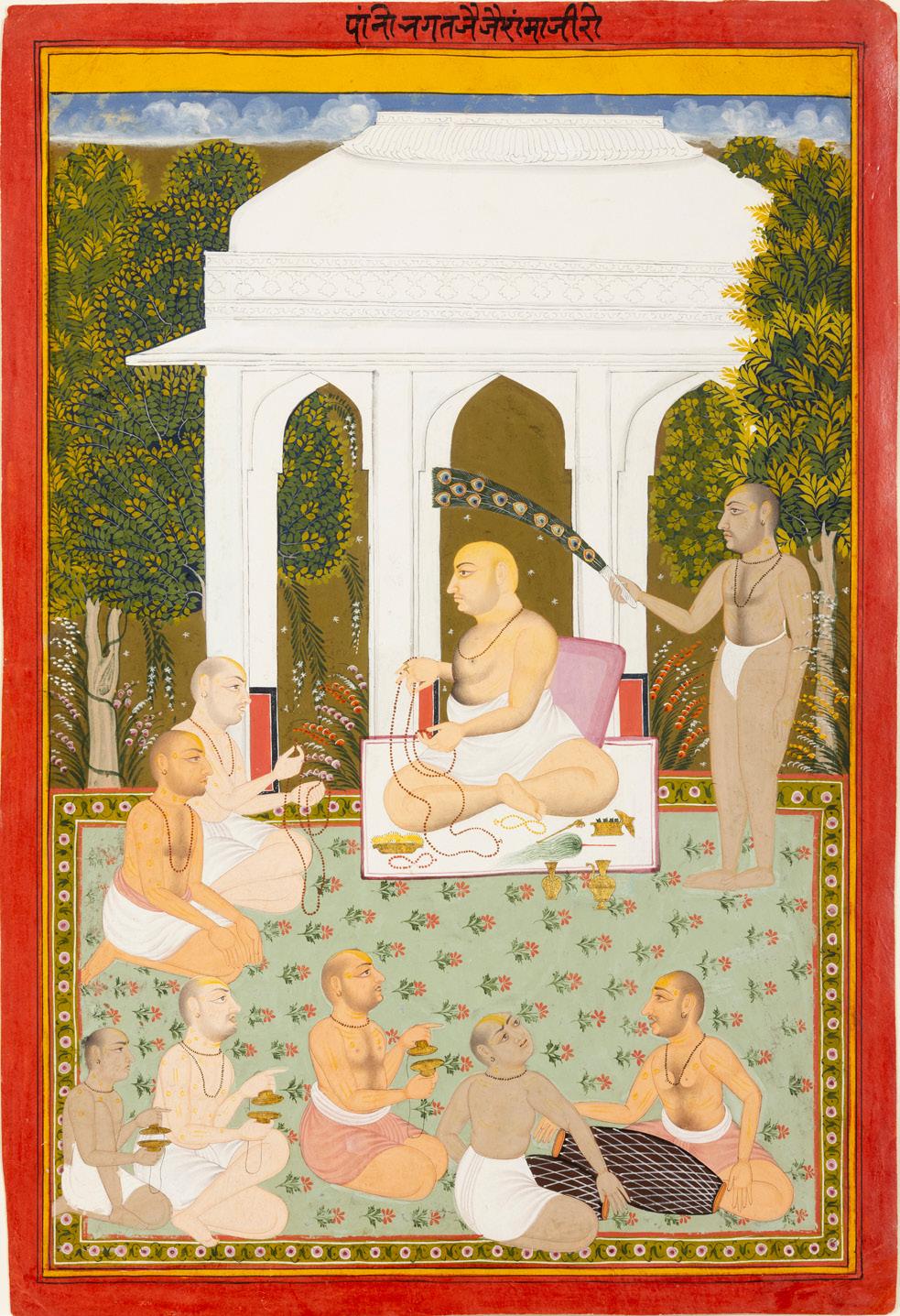

100
A TRIUMPHANT HANUMAN
INDIA, RAJASTHAN, JAIPUR, CIRCA 1850
gouache and ink on paper, depicting the large monkey-like Hanuman in an excited trance with his foot over Parvati, trampling her, mounted, glazed and framed
45.7cm x 37.8cm
£1,200-1,800
Provenance: Formerly, Detlef Rosen Collection, Dusseldorf, Germany.
A JAIN ILLUSTRATION
DEPICTING THE ENERGY FLOW OF A HORSE
INDIA, RAJASTHAN, 19TH CENTURY
black and red ink on paper, the horse is presented with his right leg up and his hind right leg forward, his neck and head in a rounded outline, red scrolls used to highlight areas, with inscriptions in nagari
Sight size 47cm x 58cm
£1,200-1,800
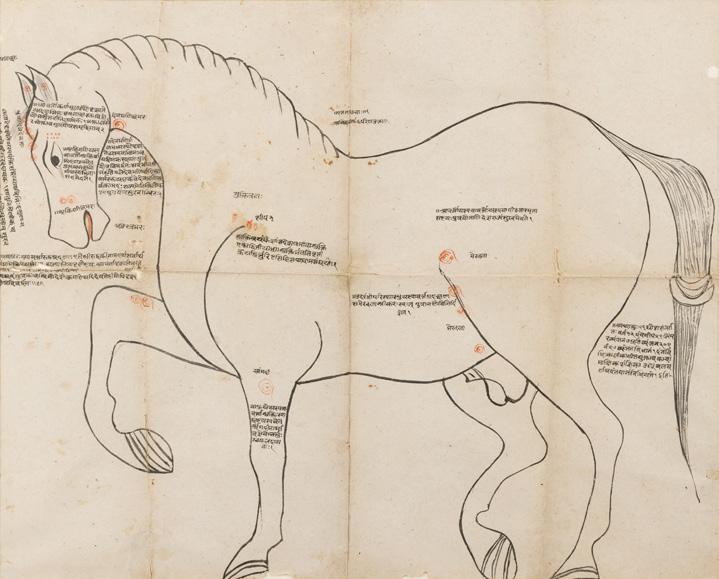


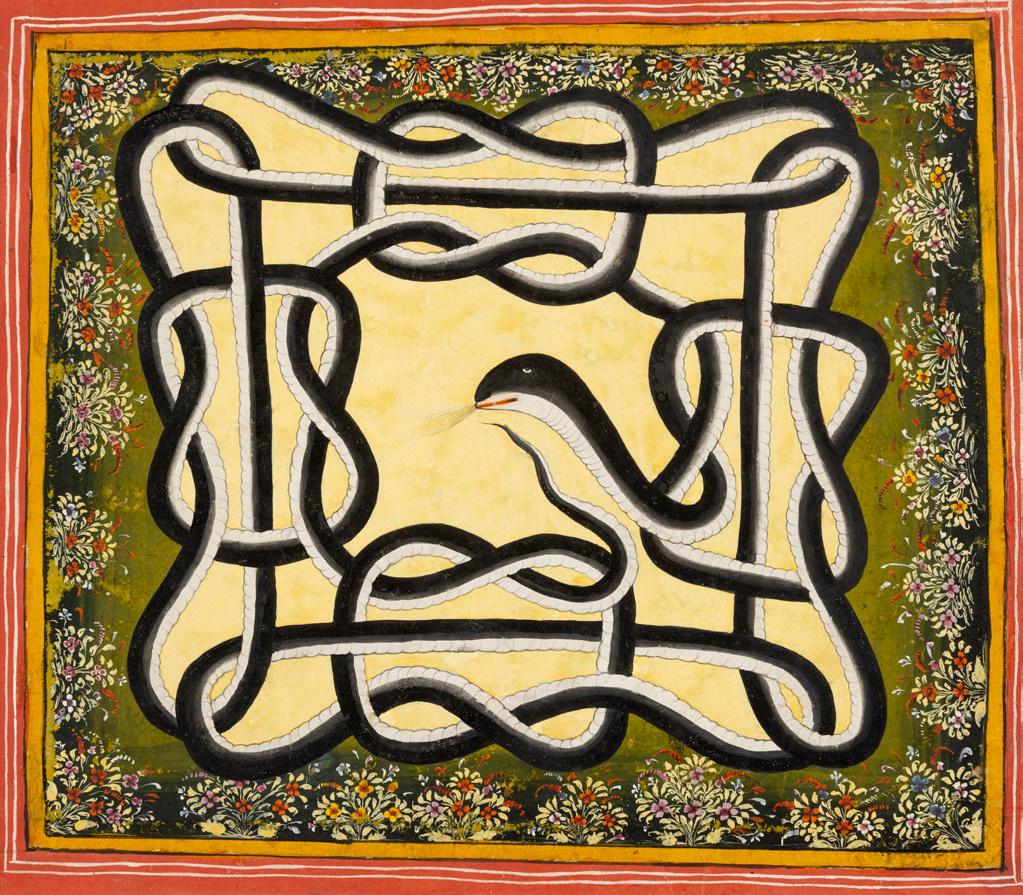
102
NAAG PAASH
INDIA, RAJASTHAN, UDAIPUR, 18TH CENTURY
gouache on paper, an intricate mesh is formed by the coils of a very long snake that loops in on itself to tighten a complex series of reef knots and corner loops, the venomous head with hissing tongue and the darting tail of the snake meeting at the centre of the picture where the snake both begins and ends
23.2cm x 29.3cm
£3,500-4,500
This Mewari artist quickly captures the eye of the onlooker with the hissing and coils of a serpent in this unusual Indian painting, inscribed on reverse in nagari ‘naag paash’ meaning serpent-noose. Vishvajit, also derived from ‘naag paash’, was the name given to the lasso used by Varuna, an important Vedic deityj. This deadly weapon was again used by Ravana, one of the demons in the Ramayana, when he tried to ensnare Rama and Lakshmana. Garuda, the god and king of birds and enemy of snakes, swiftly comes to the rescue by loosening the naag paash and releasing Ravana’s deadly grip. For further discussion, see A.Sattar, The Ramayana by Valmiki, New York, 1996, and A. Dalapiccola, Dictionary of Hindu Lore and Legend, London, 2002.
AN ILLUSTRATION FROM A RAGAMALA SERIES: KRISHNA WITH RADHA AND GOPIS ON A TERRACE INDIA, RAJASTHAN, JAIPUR, CIRCA 1810
gouache on paper heightened with gold, mounted on an album page with a striking Mughal-style floral decorated yellow border and two further inner margins, depicting Krishna and Radha on a terrace close to a pavilion, both pointing out to the looming storm above, two gopis behind them holding morchals and looking at one another quizzically, a gopi in front of the couple also pointing out to the sky, in the background, a pair of peacocks perched calmly on the blue and gold balustrade looking towards the sky, two pairs of birds are nestled in the trees beyond, in the bottom part of the painting illustrates an elaborate palace basement, mounted, glazed and framed 39.8cm x 29.4cm
£15,000-20,000
This is a brilliantly painted and captivating image centred around the looming storm but equally symbolic in the smaller details, such as the paired birds nestled in the trees, no doubt representing Krishna’s undying love. The bright colour palette is typical of Jaipur. The painting is organised with an elaborate basement storey. The artist suggests real depth as we can see well inside the entrance at its centre and into the corner of the angled pavilion on the upper terrace. The edge of the terrace projects over the lower storey, cantilevered by means of a row of supporting brackets.
Robert Del Bonta has suggested that this un-inscribed album leaf may represent Madhumadhavi ragini from a Ragamala series. The way the figures point to the lightning is characteristic to the usual depictions of this ragini. Peacocks are also a normal feature of Madhumadhavi, though they are often shown fluttering or crying in excitement as the storm gathers while flocks of other birds such as Sarus cranes take flight into the darkening sky (see K. Ebeling, Ragamala Painting, 1972, p. 69 for a Madhumadhavi ragini dated 1756 from the small principality of Malpura, south of Jaipur, in which a lady rushes into the palace to escape the onset of the thunderstorm; and p. 71 for an eighteenth century Jaipur depiction with excited, squawking peacocks that need feeding before the storm erupts). In the present picture, the peacocks simultaneously function as symbols of Krishna, reinforcing the iconography of his peacock feather crown and the morchals held by the gopis.
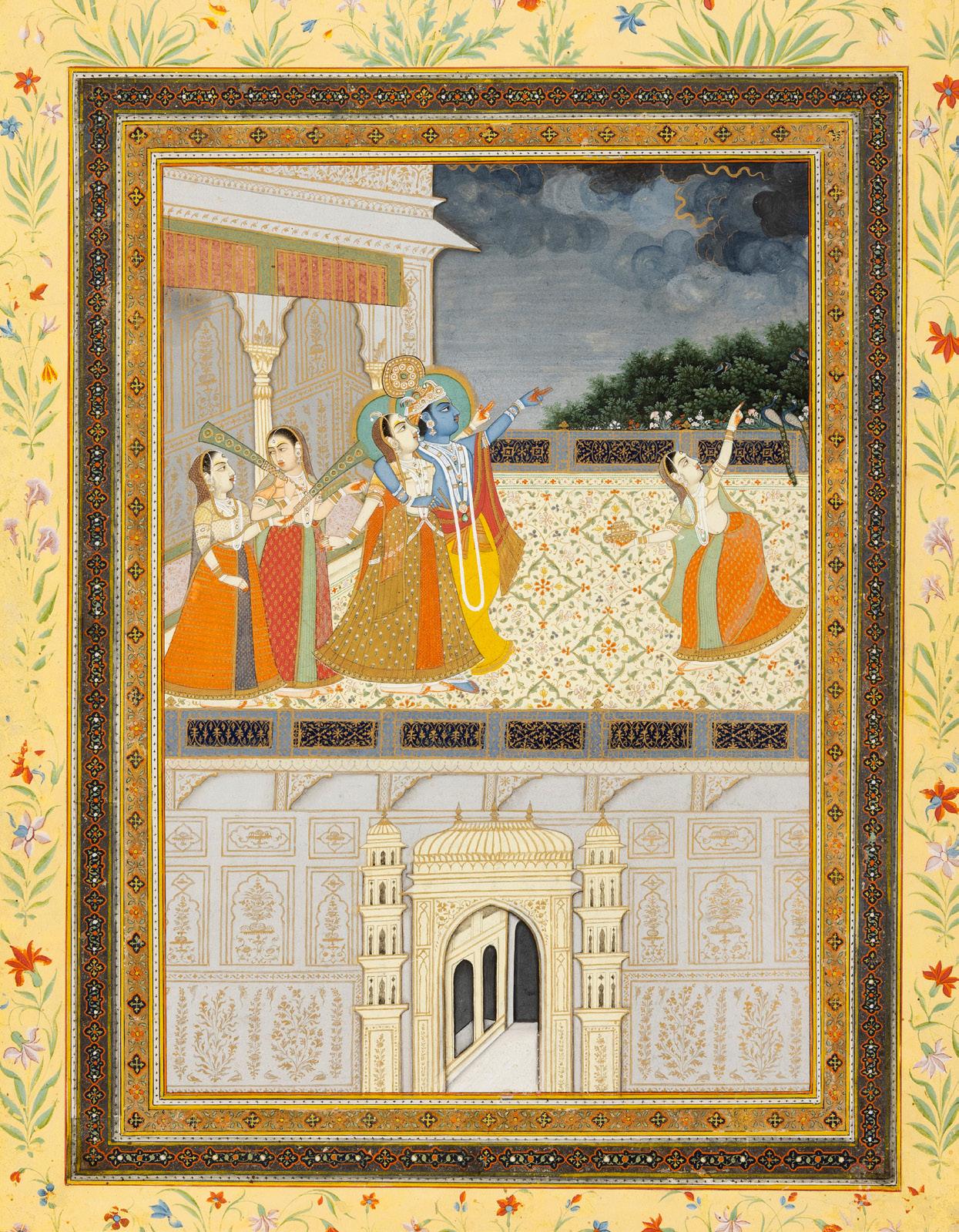
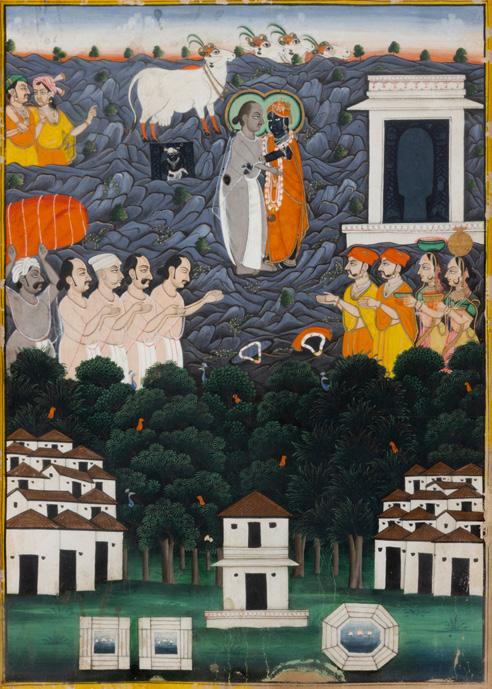
VALLABHACHARYA DISCOVERING SRI NATHJI AT THE GOVARDHAN HILL
INDIA, RAJASTHAN, KOTAH, CIRCA 1830
gouache on paper heightened in gold, depicting Sri Nathji and Vallabhcharya with a green and gold halo embracing one another within a mountainous landscape, a group of sacred Nandi cows above them, two onlookers draped with jewellery to the left pointing out the scene, the empty white temple to the right, a row of male worshippers dressed in loincloths to the left, a row of noble worshippers to the right with offerings, a village landscape scene below, mounted, glazed and framed
33.9cm x 25.6cm
£1,500-2,000
This painting and the next lot depict the first encounter between Krishna, the cowherd god, and Vallabhacharya, the mystic who founded the Sri Nathji cult. In 1493, Vallabhacharya visited Mathura, Krishna’s home and following this pilgrimage built a shrine at Mount Govardhan, in 1670 the shrine, being under threat from the Mughal ruler Alamgir (r. 1658-1707) was taken northwest to Rajasthan to Nathdwara, twenty five miles north of Udaipur.
Dauj II (1797-1826), a priest and son of the priest Girdharji, stimulated life around the Nathdwara temple devoted to Sri Nathji. He built gardens and palaces with a school of painting. Mahararao Kishor Singh (r. 1819-1827) was a devout Vishnava devotee and Dauji II initiated the ruler into the devotion of Vallabha Sampradaya. Dauji II also gave the ruler refuge at Nathdwara in 1821 when he was exiled from his kingdom for three months by the British. There was a likely interaction between Nathdwara and Kotah during this period.
For further discussion and comparisons see: S.C.Welch (ed.), J.K. Bautze, C.W. Bowen, N. Peabody and W.Taylor, Gods, Kings and Tigers, New York, 1997, pp. 184-201, and; J.Seyller (ed.) , M.C. Beach, C.Glynn, J.Mittal and A.Topsfield, Rajasthani Paintings in the Jagdish and Kamla Mittal Museum of Indian Art, Hyderabad, 2015, pp. 146-155, and; J. Williams, Kingdom of the Sun, Indian Court and Village Art from the princely state of Mewar, San Francisco, 2007, no. 54.
105
VALLABHACHARYA DISCOVERING SRI NATHJI AT THE GOVARDHAN HILL
INDIA, RAJASTHAN, KOTAH, CIRCA 1830
gouache on paper heightened in gold, depicting Sri Nathji and Vallabhcharya with a green and gold halo embracing one another within a mountainous landscape, a group of sacred Nandi cows above them, two onlookers draped with jewellery to the left pointing out the scene, the empty white temple to the right, a row of male worshippers dressed in loincloths to the left, a row of noble worshippers to the right with offerings, a village landscape scene below, mounted, glazed and framed
33.9cm x 25.6cm
£1,000-1,500
Provenance: Private Collection, London. Please see note to lot 104.
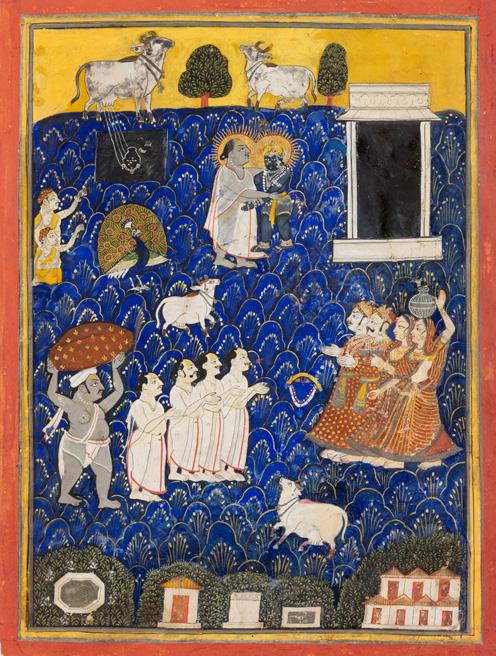
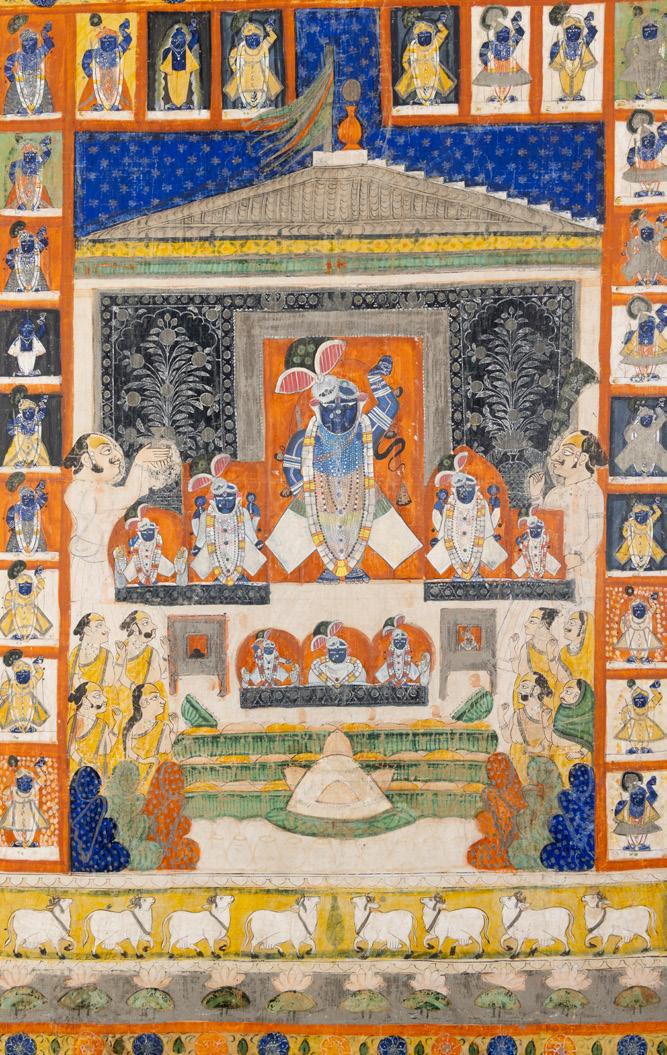
A PICCHAVAI OF ANNAKUTA: FESTIVAL OF FIFTY-SIX OFFERINGS
INDIA,
RAJASTHAN,
NATHDWARA,
19TH CENTURY
painting on cotton, the idol of Shri Nathji standing in the centre flanked by smaller figures of the deity, worshippers to either side, under a pavilion topped with billowing flags, the sky speckled with silver stars, the long borders decorated with images of Shri Nathji, bordered with orange and blue flowerheads, on stretcher sight size 123cm x 87.5cm
£2,000-3,000
This vibrant and richly coloured pichhavai is an excellent example of the Nathdwara school of painting. It portrays the sanctum of the Shri Nathji temple in Nathdwara during the festival of Annakuta, celebrated annually in October and November. The festival commemorates the villagers of Vraj offering their harvest to Mount Govardhan, following Krishna’s guidance. As the most significant festival of the year, Annakuta draws pilgrims who bring the fruits of their harvest to the temple. A symbolic mountain of rice is placed at Shri Nathji’s feet, surrounded by offerings in bowls. Women in brightly hued veils are shown kneeling reverently on either side of the deity. Vallabhacharya, the founder of the Pushtimarg sect, is depicted standing to the left, while smaller cartouches around the composition feature other forms of the god.
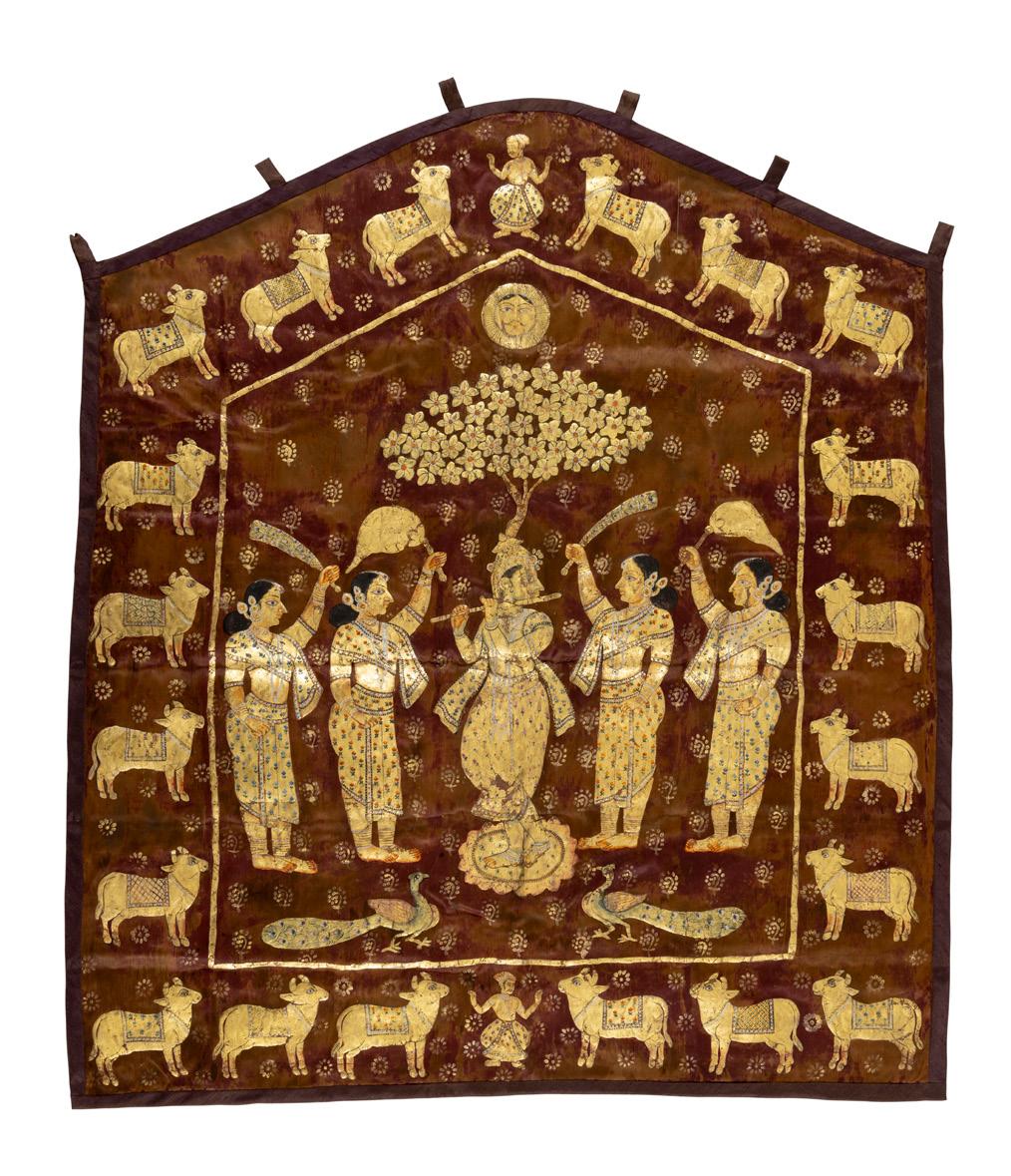
A PICCHAVAI PAINTED IN GOLD LEAF DEPICTING KRISHNA PLAYING THE FLUTE TO THE GOPIS INDIA, RAJASTHAN, 19TH CENTURY
of pointed-arch form, the brown satin ground painted in gold leaf depicting Krishna in the centre playing the flute, flanked by pairs of gopis holding fans, the border with a repeat design of nandi, backed, hoops on the upper edge
79cm x 91cm
£1,000-1,500
Provenance: Christie’s, Art & Textiles of the Islamic & Indian Worlds including works from the collection of the late Simon Digby, 7 October 2011, lot 416.
108
A JAIN SIDDHACHAKRA YANTRA
INDIA, GUJARAT OR RAJASTHAN, 18TH/ 19TH CENTURY
gouache and gold on cloth 89.5cm x 89.5cm
£1,500-2,000
Provenance: Collected by Jean-Claude Ciancimino (1931-2014) in 1964.
Formerly, Seward Kennedy Collection (1925-2015), New York.
This painting represents a Jain yantra—a sacred diagram that combines visual elements with inscribed mantras (incantations). Used in tantric rituals and meditative practices, yantras serve as tools to aid in spiritual focus and the pursuit of enlightenment. The example shown here is a Siddhachakra Mahāyantra, a large-scale yantra traditionally rendered in the form of a kalasha (ceremonial pot), adorned with an eye motif on either side.
For related examples, see J. Jain and E. Fischer, Jaina Iconography, 1978, Part 2; and P. Pal, The Peaceful Liberators: Jain Art from India, Los Angeles, 1995, p. 80, no. 49.
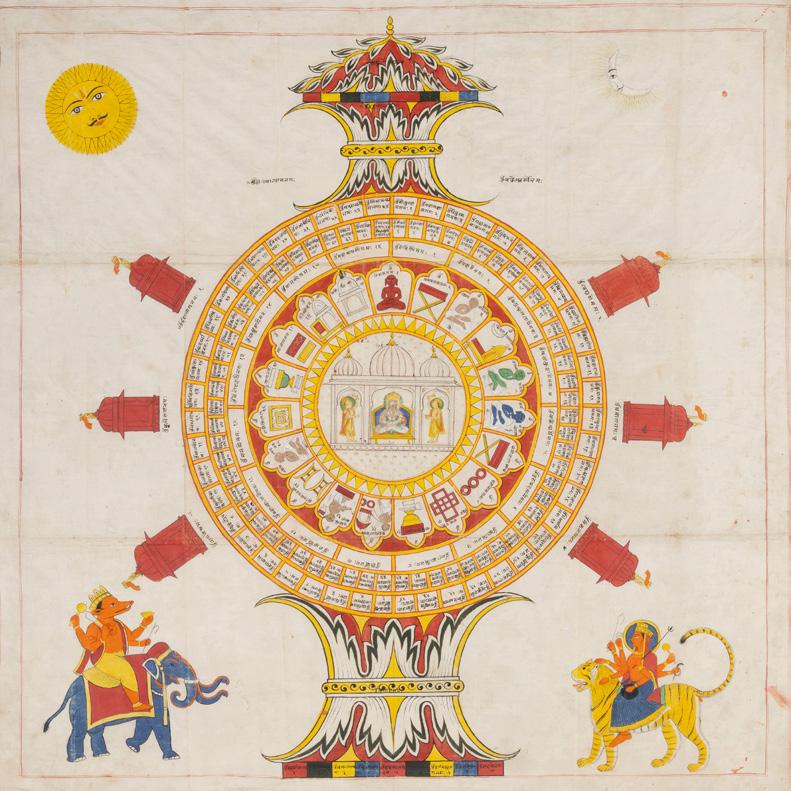
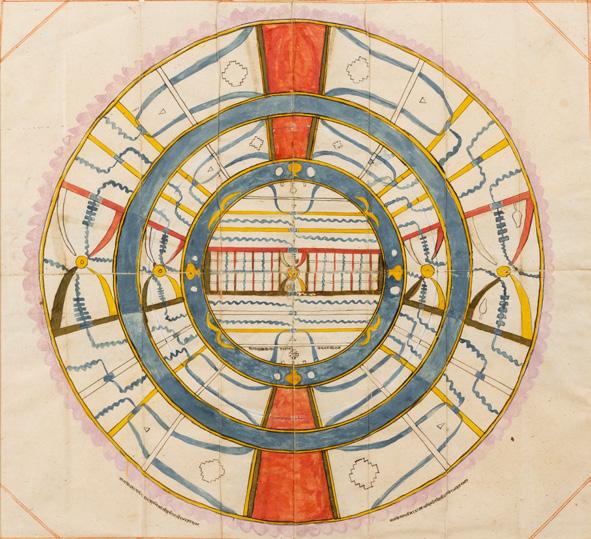
109
A JAIN COSMIC ILLUSTRATION OF THE ADHAIDVIPA
INDIA, RAJASTHAN, 19TH CENTURY
watercolour on paper, depicting concentric bands in yellow and blue, the latter representing the sea, inscriptions in nagari, mounted, glazed and framed Sight size 46.3cm x 50.4cm £800-1,200
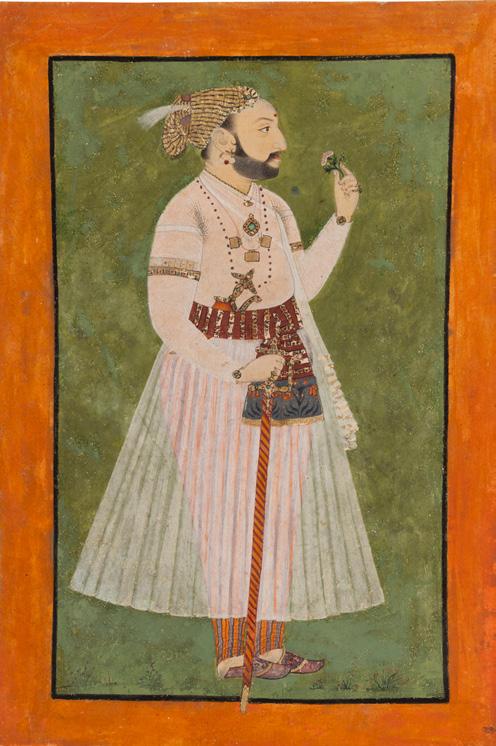
110
A PORTRAIT OF A PRINCE, PROBABLY DAN CHAND, PRINCE OF BILASPUR
INDIA, PUNJAB HILLS, BILASPUR, CIRCA 1700
gouache on card heightened in gold, orange border with black margin line, depicting the prince facing right leaning on a sword, holding a rose, wearing a gold turban and transparent jama over striped pantaloons, a dagger tucked into his floral patka, unframed
22.1cm x 15.1cm
£1,200-1,800
Provenance: Christie’s, Art of the Islamic & Indian Worlds, 10 October 2014, lot 79.
Private UK Collection.
Prince Dan Chand was a brother to the Maharaja Bhim Chand (1667-1712) of Bilaspur and a crucial advisor to his brother during his reign. For further discussion and comparisons see, W.G. Archer, Paintings from the Punjab Hills, London, 1973, Vol. I, p. 224 and Vol. II, p. 177, no. 20 and San Diego Museum of Art, Accession Number 1990. 1154 from the collection of Edwin Binney, 3rd.
A ROYAL ARCHER
INDIA, PUNJAB HILLS, GULER, MID-18TH CENTURY
drawing on paper with use of colours and gold, takri inscription at top, orange border, depicting a portrait of a royal archer standing facing left holding a bow and arrow, wearing an orange and gold turban decorated with an aigrette and an orange jama tied with a patka
Sight size 11cm x 8cm
£1,000-1,500
Although of different subjects, for comparison see: W.G.Archer, Paintings from the Punjab Hills, London, 1973, Vol. I , p.154, no. 28 and Vol. II., p.104, no. 28, and; W.G Archer, Visions of Courtly India, 1976, no. 22, and; B.N. Goswamy and E. Fischer, Pahari Masters, Court Painters of Northern India, Zurich, pp. 286-300.
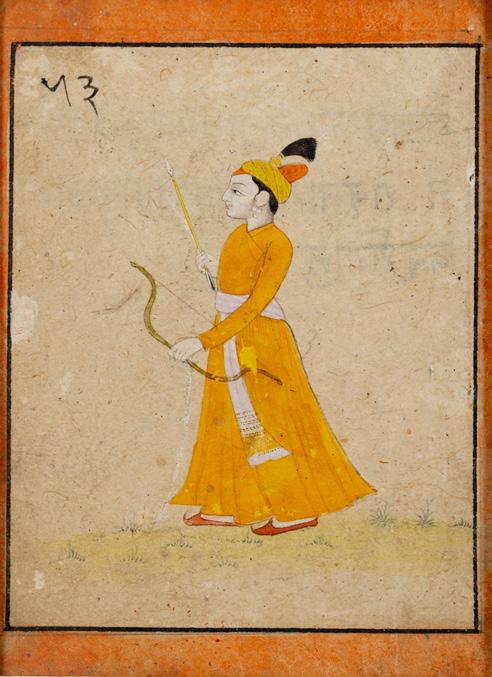

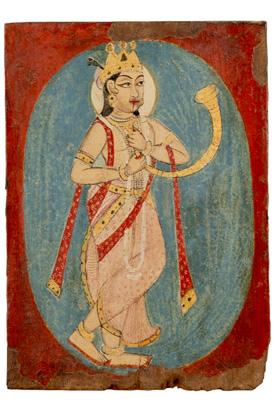
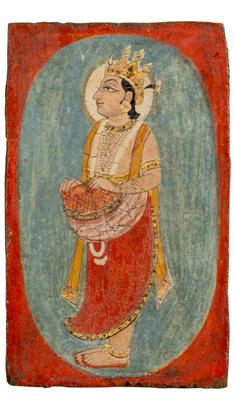

112
A SET OF INDRALOK MUSICIANS
INDIA, PUNJAB HILLS, BILASPUR, CIRCA 1800 gouache on four wood panels, depicting musicians paying the horn, the drums and the tambur, all in one frame Framed size 42cm x 67; each panel 14.5cm x 11cm largest
£500-700
Provenance: Formerly, Museum für Asiatische Kunst, Germany.
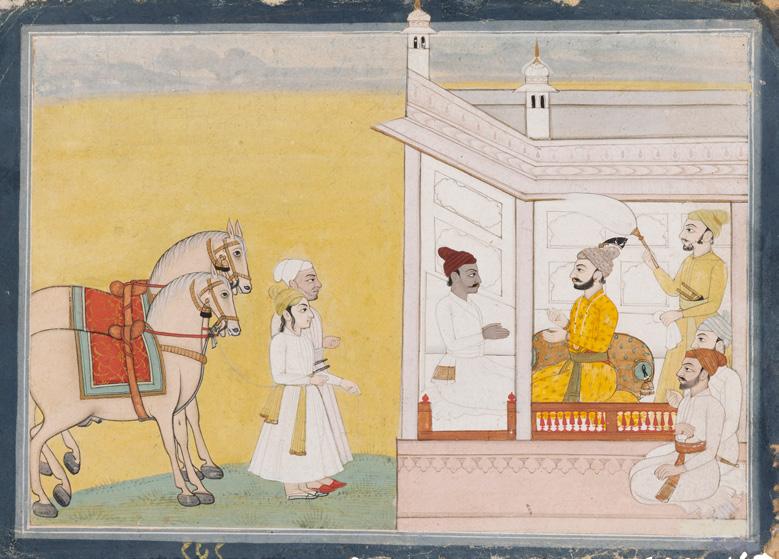
113 ‡
AN ILLUSTRATION FROM THE MAHABHARATA, NALA AND DAMAYANTI: KING BHIMA PRESENTED WITH TWO STALLIONS
INDIA, PUNJAB HILLS, BILASPUR, SECOND HALF OF 18TH CENTURY gouache on paper, dark blue border, cover paper with five lines in gurumukhi text and the number ‘181’, depicting King Bhima, the father of Damayanti, receiving King Rituparna of Ayodha presenting two charioteers with their two stallions, courtiers kneeling at the side of the ruler, an attendant standing in the background waving a cauri
20.4cm x 27.9cm
£1,000-1,500
Provenance: Private Collection, Spain.
This delightful illustration to the Mahabharata, relating to the part devoted to Nala and Damayanti, depicts King Bhima inspecting the two charioteers Varshneya and Varukha not realising that Varukha is his daughter Damayanti in disguise.
For further discussion and comparison with eleven illustrations to a Nala Damayanti series in the Victoria and Albert Museum ( I.S. 265-1953 and I.S. 30-1954 to 39-1954) see W.G. Archer, Paintings from the Punjab Hills, London, 1973, Vol. I. pp. 240 - 241, no 43 ( i-xi) and Vol. II , pp. 184-187, no. 43 (i-xi). See also the San Diego Museum of Art, Accession Numbers 1190.1168-1170 from the collection of Edwin Binney, 3rd.
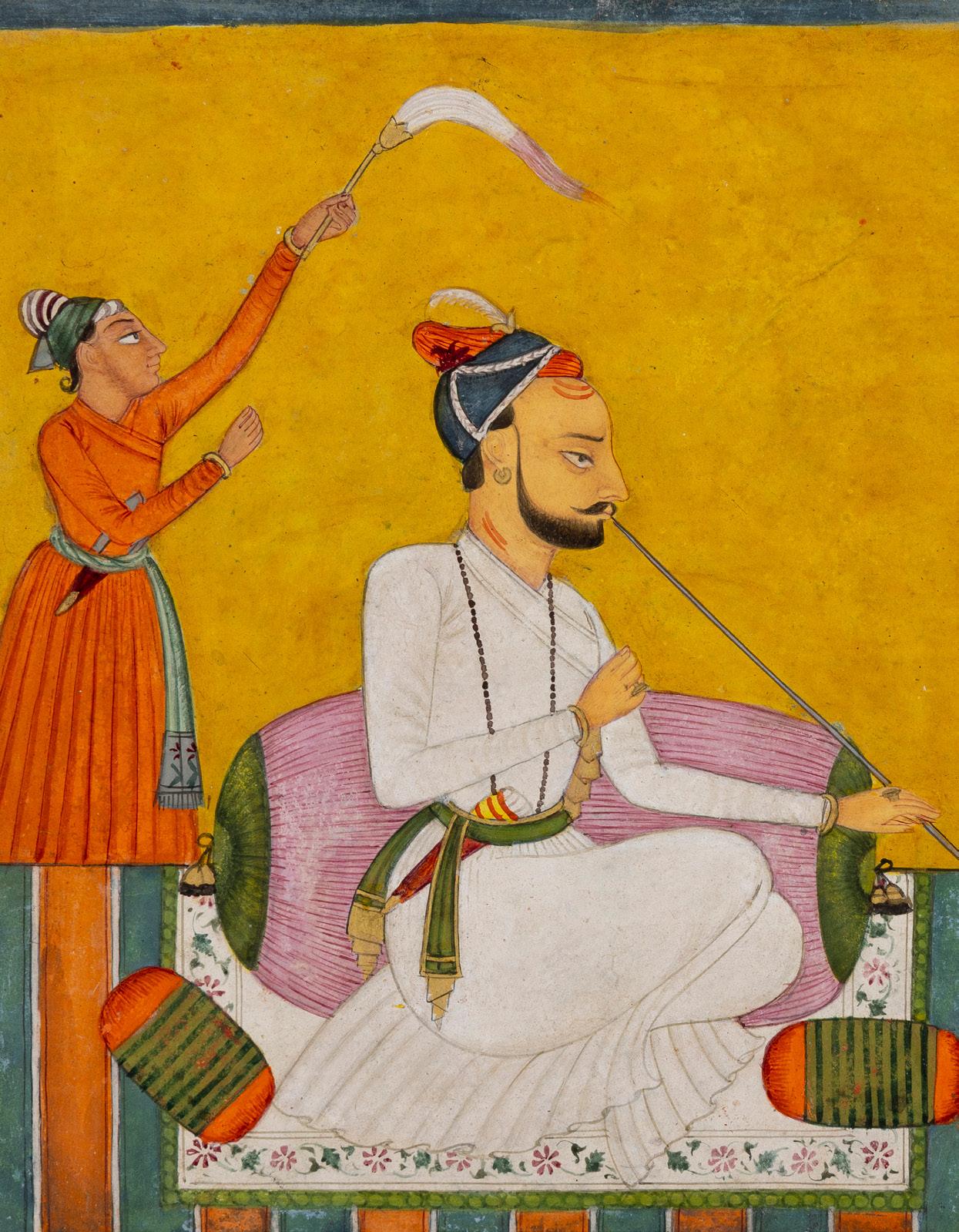
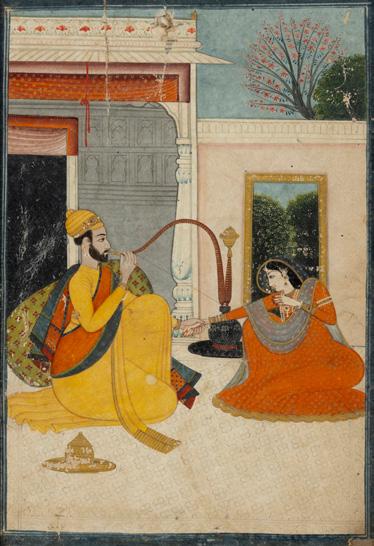
115
114 ‡
A MAHARAJA CLASPING THE HAND OF A SHY MAIDEN INDIA, PUNJAB HILLS, GARHWAL, CIRCA 1780-90
gouache on paper heightened with gold, dark blue border with margin rules in white, the raja is dressed in a bright yellow jama and turban leaning against a green and red bolster holding his hookah, at the same time holding the hand of his beloved, who is dressed in a bright orange robe with a grey dopatta draped over her head and shoulders, a palace chamber with a rolled blind in the background, cherry trees in blossom seen beyond through a doorway
19.4cm x 13.4cm
£1,000-1,500
Provenance: From a Spanish Private Collection, formerly in the collection of the Maharaja of Bikaner.
The flow of this painting with the command of the maharaja, the curve of his hookah pipe and his clasping of the shy maiden’s hand all add to the romance of this palace terrace scene. The artist invites the viewer, most likely his patron, to share the depth of the romantic feeling in the painting, so often found in the Pahari schools. For further discussion and a close comparison, see, M. Lal, Garhwal painting, New Delhi, 1968, no. 1, and; E. Binney, Rajput Miniatures from the collection of Edwin Binney 3rd, Portland 1968, no. 87, and finally; W. G. Archer, Indian Paintings from the Punjab Hills, London, 1973, Vol. 1, p. 115, no. 14 and Vol. II, p.82. no. 14.
A PORTRAIT OF RAJA ANAND DEV OF BAHU (C.1690-C.1715)
INDIA, PUNJAB HILLS, JAMMU, CIRCA 1690
gouache on paper heightened with gold, red border with black and white margin lines, depicting the raja dressed in a white jama with a green and gold sash, a blue and orange turban with a feathered sarpech or aigret, leaning against a pink and green bolster on a small white summer carpet, to the right a visiting dignitary dressed in a green jama with an orange sash and blue and white turban, an attendant standing to the left waving a cauri, on a green and orange striped terrace, against a strong yellow ground, mounted, framed and glazed
21.2cm x 27cm
£20,000-30,000
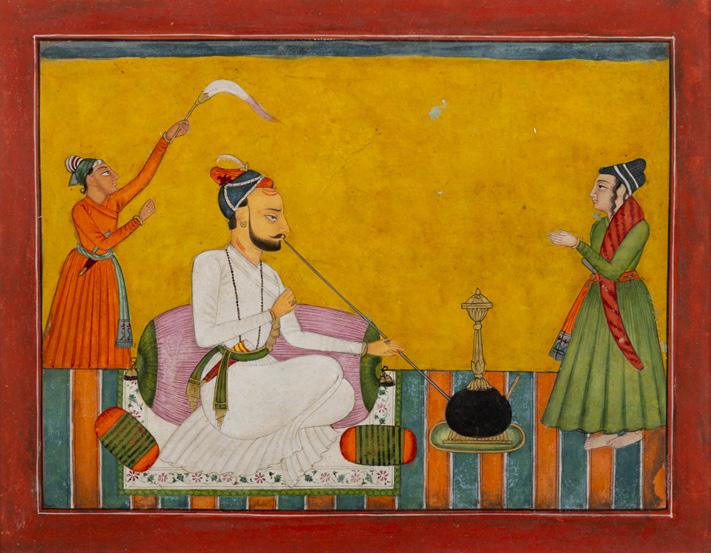
Provenance: Formerly, old Private UK collection
This portrait of the young Raja Anand Dev bearing Vaishnava tilak marks on his forehead and wearing a white jama is a fine example of painting at Jammu at the end of the seventeenth century going into the eighteenth century. It may well have been intended as a state portrait to celebrate the ruler’s accession to the throne in 1690 and the merging of Bahu with Jammu. The fine, clear lines of the painting and strong colours are typical of portraits executed in the Punjab Hills at this time. The striped rug is another particular feature. There was also interaction between Kulu and Jammu artists at this time when the rulers of Jammu visited Kulu to worship at the Raghunathji shrine.
For further discussion and comparisons, see: W.G. Archer, Indian Paintings from the Punjab Hills, London, 1973, Vol. I., p. 190, no. 1 and Vol. II, p.132, fig. 1, and; W.G. Archer, Visions of Courtly India, London, 1975, no.52, and; Sotheby’s, London, The Bachofen von Echt Collection of Indian Miniatures and Company School Paintings, 29 April, 1992, lot 17, and; B.N. Goswamy and E. Fischer, Pahari Masters, Court Painters of Northern India, Museum Rietberg, Zurich, 1992, no.29.
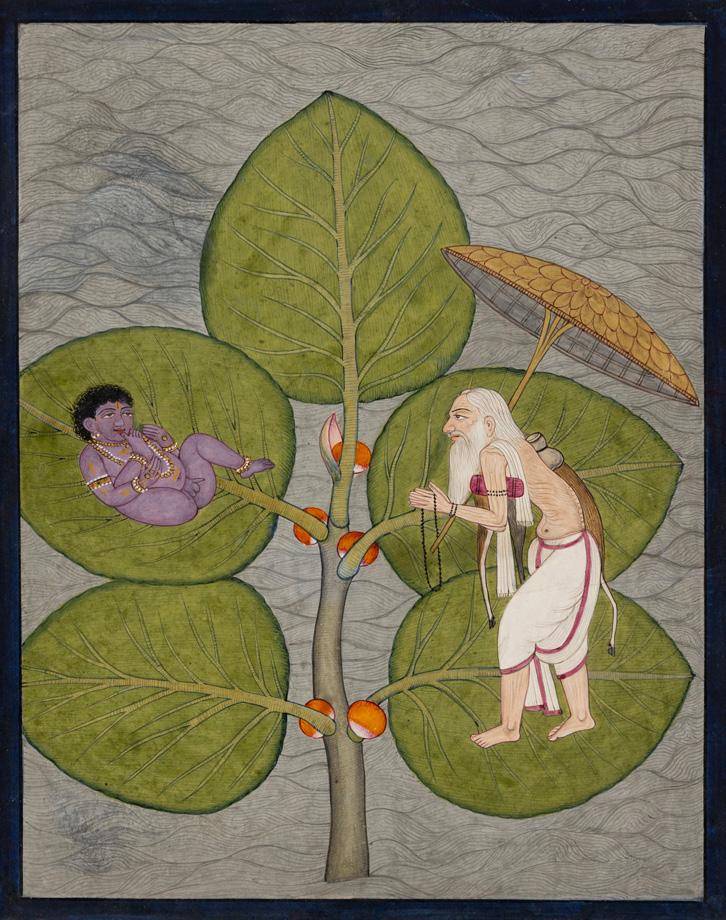
AN ILLUSTRATION FROM THE MAHABHARATA: THE SAGE MARKANDEYA’S VISION OF THE INFANT KRISHNA FLOATING ON A BANYAN LEAF
INDIA, PUNJAB HILLS, KANGRA, CIRCA 1830
gouache and gold on paper, dark blue border, depicting a large banyan tree rising from the ocean with five leaves and its orange fruit, the infant Krishna is lying on one of the leaves joyfully sucking his toe whilst the sage Markandeya is dressed in white with his frail and aged body standing on a leaf holding a parasol and worshipping before the infant Krishna, mounted, glazed and framed sight size 20cm x 15.5cm
£1,200-1,800
Provenance: Private UK collection.
For comparison and further discussion about this emotive religious subject of Krishna floating in a cosmic ocean see: Philadelphia Museum of Art , accession no. 1955-11-1, and; Christie’s , An Eye Enchanted: Indian Paintings from the Collection of Toby Falk, 27 October, 2023, lot 95.
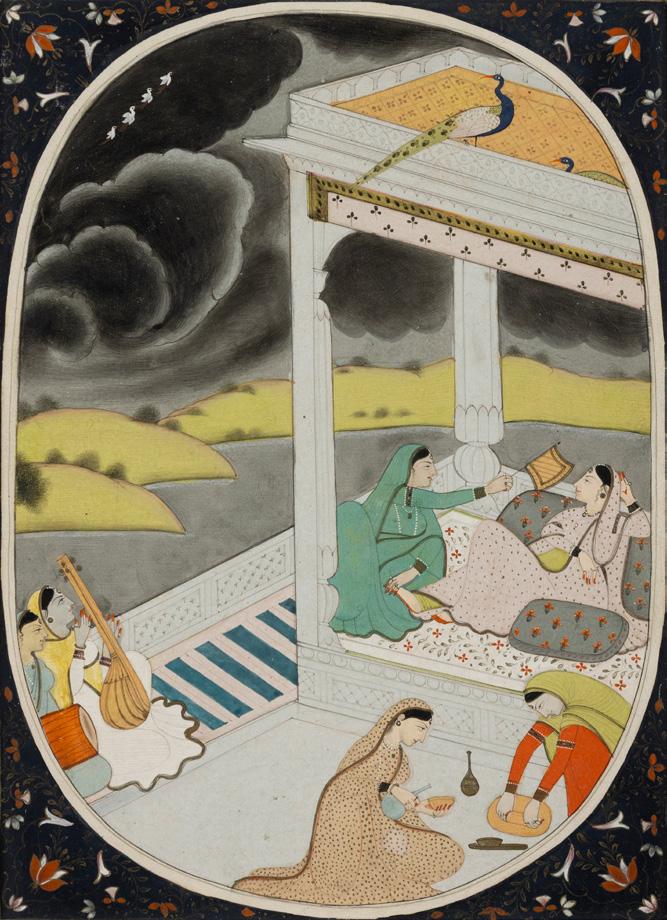
117
AN ILLUSTRATION FROM A RAGAMALA SERIES: MADHUMADHAVI RAGINI INDIA, PUNJAB HILLS, KANGRA, CIRCA 1830
gouache on paper heightened with gold, the image of oval form with polychrome and gold floral border on a black ground, a maiden is lying against a bolster under her canopy and being fanned by her maid, a storm is brewing in the hilly background with four white birds flying away in unison, two peacocks standing on the canopy roof, two seated musicians in the foreground watching the scene unfold, and two servants drenching a cloth, mounted, glazed and framed
Sight size 20.2cm x 14.3cm
£2,000-3,000
Provenance: Private UK collection.
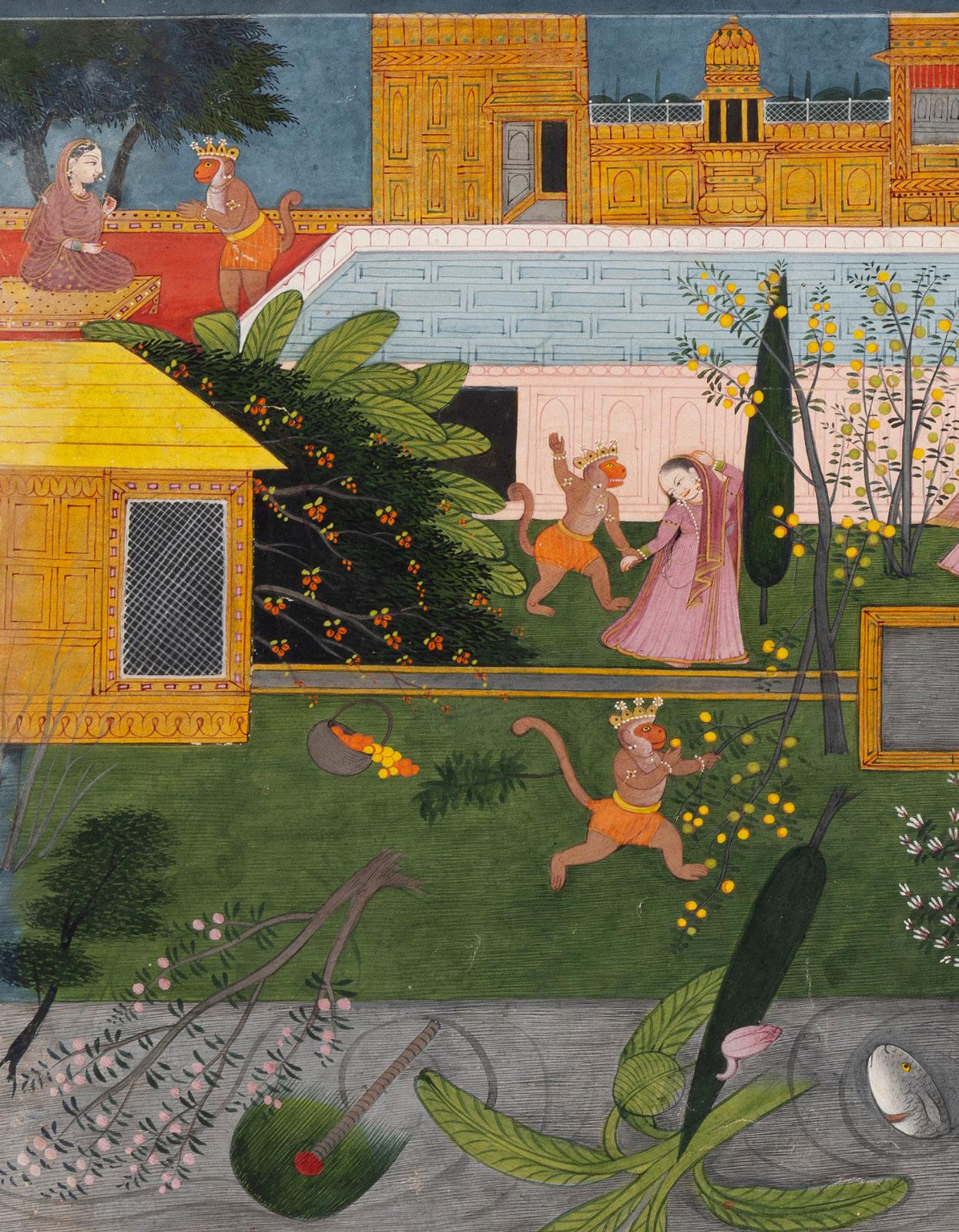
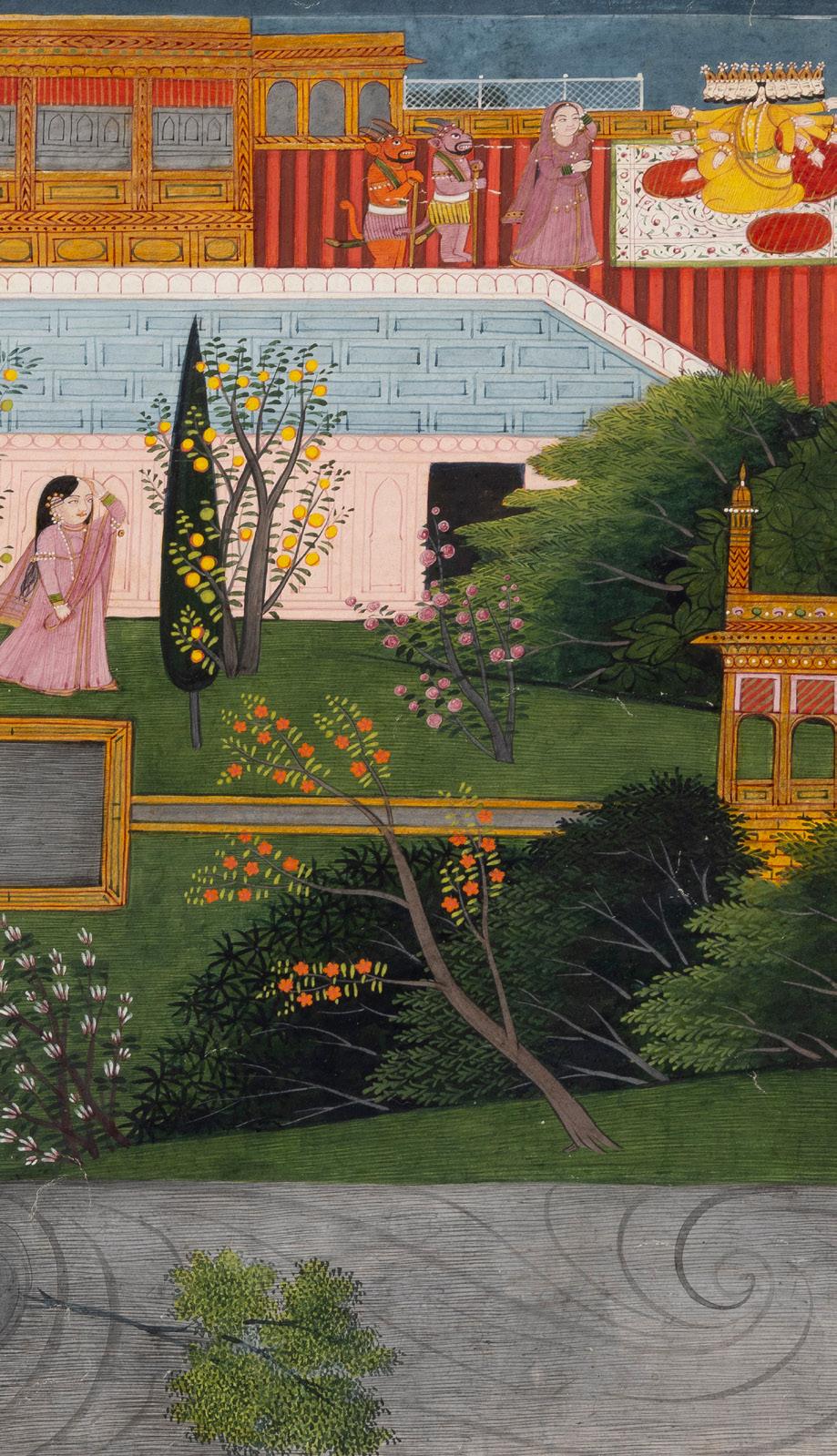
118
AN ILLUSTRATION FROM A RAMAYANA SERIES: HANUMAN TAKES LEAVE OF SITA AND DESTROYS THE ASHOKA GROVE INDIA, PUNJAB HILLS, CHAMBA, CIRCA 1805
gouache and gold and silver on paper, narrow blue and wide red border, featuring a palace with a garden and lake in the foreground, variety of trees lying flat on the ground and lake having been destroyed by the various representations of hanuman, crowned monkey-like beings, stealing fruit from the trees, trying to woo a princess, a scene of worship in the upper right hand corner 27cm x 36.7cm
£12,000-15,000
Provenance: Formerly in the collection of Dr Alma Latifi, CIE, OBE (1879-1959).
Dr Latifi, an eminent civil servant, collected Indian works of art from the 1930s to the 1950s. He amassed a substantial collection of Indian paintings from which some paintings were loaned to the Royal Academy exhibition in London entitled, The Art of India and Pakistan, 1947-1948.
For reference, see, The Ramayana of Vakmiki, translated by Hari Prasad Shastri, 1953-1959, Sundara Kanda, chapters 38-41.

119
A DOUBLE ILLUMINATED OPENING TO A PRAYER BOOK (DALA’IL AL-KHAYRAT)
INDIA, KASHMIR, 18TH CENTURY
Arabic and Persian manuscript on paper, with gold and blue illumination, 5 lines of naskhi text in black and red ink within a central rectangular panel surrounded by a rhombus-shaped design within a rectangular panel with gold floral and blue decoration, from each corner issue diagonal lines of text in nasta’liq, glazed and framed sight size: 20.5cm x 25cm
£500-700
120
A SIALKHOT GOLD AND SILVER KOFTGARI STEEL DISH NORTH INDIA, 19TH CENTURY
of shallow circular form on a short footring, profusely engraved and overlaid in gold and silver, the decoration centred around a six-petalled flowerhead with trefoil pillars in between, a band of meandering floral pattern around the rim, the base with silver lattice pattern 25.3cm diameter
£500-700
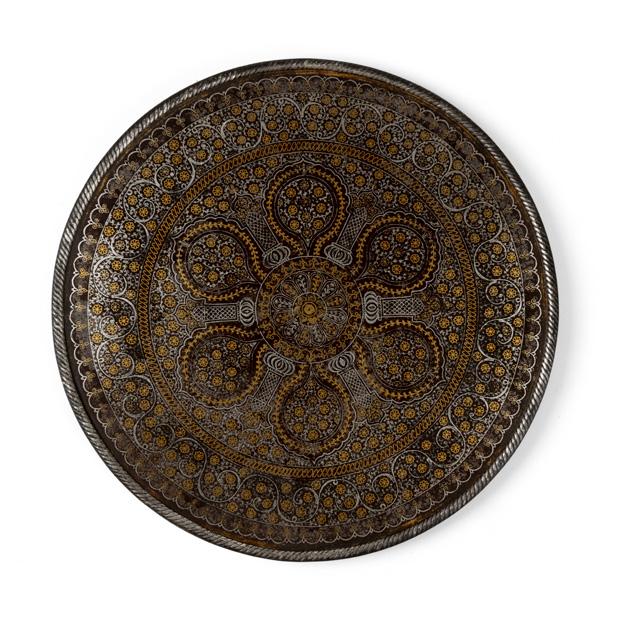
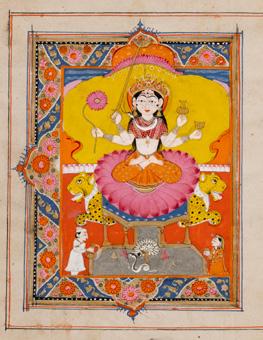
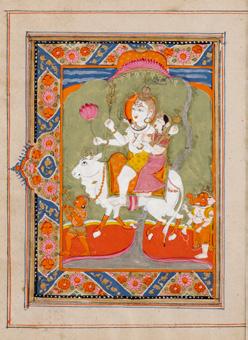
121 ‡
FOUR ILLUSTRATED LEAVES FROM A HINDU EPIC INDIA,
KASHMIR,
MID-19TH CENTURY
gouache, gold and silver on paper, with cover leaves in sanskrit text, fourteen lines to the page written in black in within orange margin rules, the illustrations combine Sarlauh-shaped arabesque illumination and image with fine details, and portray the Goddess Ragnya Devi, Shiva and Parvati, Surya, and Krishna driving Arjuna’s chariot into the battlefield
Each image 18.3cm x 14cm
£500-700
Provenance: Private collection, Spain.
These finely painted illustrations share many stylistic similarities with an illustrated Bhagavad Gita manuscript in The National Gallery of Victoria, Melbourne, accession number 1515-5.

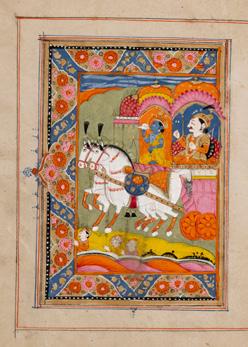
122
NARASIMHA
SOUTH INDIA, ANDHRA PRADESH, CIRCA 1850
gouache and gold on paper, red border with white margin rules, inner yellow border with black rules, depicting Narasimha, Vishnu’s half-lion form, sitting on a large throne with his multiple arms, holding his multiple attributes, disemboweling the demon-king Hiranyakashipu, and wielding Vishnu’s mace, lotus, and disc with his remaining arms, the king’s son Prahlada and wife, Kayadhu, are in attendance in either corner, all against a bold orange ground within a green and yellow arch, mounted, glazed and framed
37.9 x 29.4cm
£1,000-1,500
Provenance: Formerly, Peter Blohm, Aberystwyth, Wales.
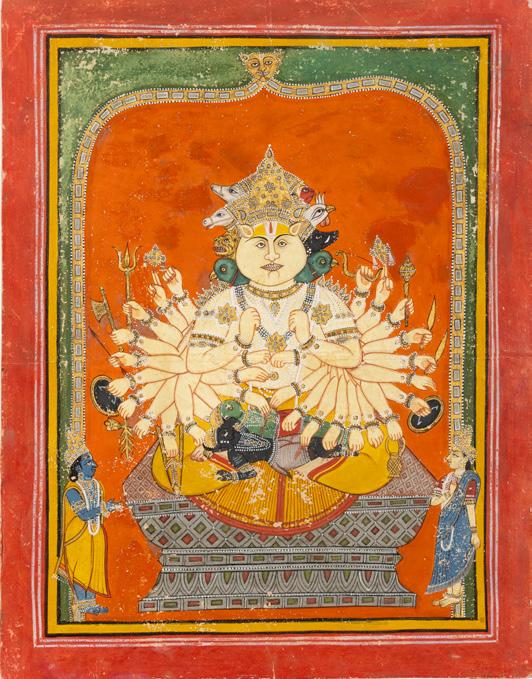

123
123 ‡
AN ILLUSTRATION FROM A BHAGAVATA PURANA SERIES: CELEBRATION OF KRISHNA’S BIRTH IN GOKUL CENTRAL INDIA, DATIA, LATE 18TH CENTURY
gouache on paper highlighted in gold, with red border and black margins rules, within the upper corner a devout nobleman is seated against his bolster celebrating the birth of Krishna surrounded by his courtiers, below in the palace bedchamber, Yasoda, the foster-mother of Krishna is nursing the infant Krishna, the sage Shukadeva is in deep discussion with King Parakshit in background on the right hand side, whilst in the foreground musicians and dancing girls performing as the cowherds of Gokula tend their oxen, with identifying nagari inscriptions in black ink, folded to the back of the painting cover paper with title and twelve lines in nagari script, and the library stamp of the State Datia collection
31.5cm x 43.7cm
£2,000-3,000
Provenance: From a Spanish Private Collection, formerly in the collection of the Maharaja of Bikaner.
For an example of another lively scene of this period also executed at Datia in Central India see L. York Leach, Mughal and Other Indian Paintings from the Chester Beatty Library, Dublin, London, 1995, Vol II. p. 1019, no. 10.62, and; Detroit Institute of Arts, Michigan, accession number 70.778.
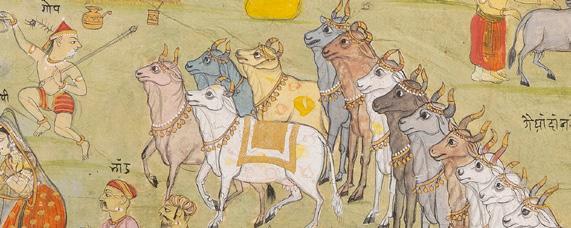
124 ‡
AN ILLUSTRATION FROM THE BHAGAVATA PURANA: BRAHMA WORSHIPPED BY A RULER AND DEVOTEES ON A MOUNTAINSIDE
INDIA, MEWAR, CIRCA 1710-20
gouache on paper heightened in gold, with two lines of nagari script in black ink on a yellow ground above, trimmed on either side, the image displaying three different narratives starting above against a greenish background, four brahmins pleading with the god Indra, then against a red background the same devotees are seen accompanying Indra to worship Brahma who gives them some sacred text, finally against a brown background, the group takes leave, with one of the Brahmins lighting a sacred fire towards Brahma, a pond with Lillies to the right foreground
22.6cm x 34.8cm
£800-1,000
Provenance: Private collection, Spain.
For a comparable in the Detroit Institute of Arts Museum, see accession nos. 70.730-70.747, and 60.394-60.413.
HORNED DEMONS CHASING
NAKED FIGURES WITH DOGS INDIA, MEWAR, CIRCA 1760
gouache on paper, red border with blue margin rules, four lines of nagari text above in a yellow panel, from the right a yellow and orange demon running forward with bows and arrows, four hunting dogs ahead of them chasing and catching ghost-like figures, mounted, glazed and framed Sight size 19.2cm x 28.2cm
£800-1,000
Provenance: Private UK collection. The chase is so typical of Mewar painting. For comparison, see A. Topsfield, Paintings from Rajasthan in the National Gallery of Victoria, Melbourne, 1980, no. 155.
126
AN ILLUSTRATION FROM THE BHAGAVATA PURANA: KRISHNA AND THE DEMONESS PUTANA
CENTRAL INDIA, MALWA, CIRCA 1680-90
gouache and gold paper, divided into three scenes, the top left depicting cowherds and an elderly sage on a green ground, the top right with baby Krishna being presented by the sage to Yashoda and Putana on a maroon ground, lower section depicting the giant form of the demoness Putana, having been strangled by Krishna being cut up and burnt by the people of Vraj, verso with inscription in black and red devanagari script with folio no. 15, mounted, glazed and framed Sight size 18cm x 34.6cm
£1,000-1,500
Provenance: According to the Christie’s catalogue entry, it was with Doris Wiener’s Gallery since the 1960s and early 1970s.
Christie’s, The Doris Wiener Collection, 20 March 2012, lot 266.
Christie’s, The Collection of Paul F. Walter, 26-27 September 2017, lot 249.
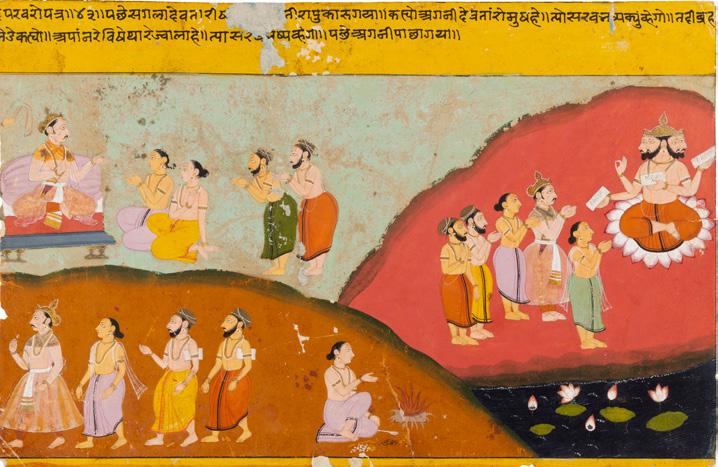
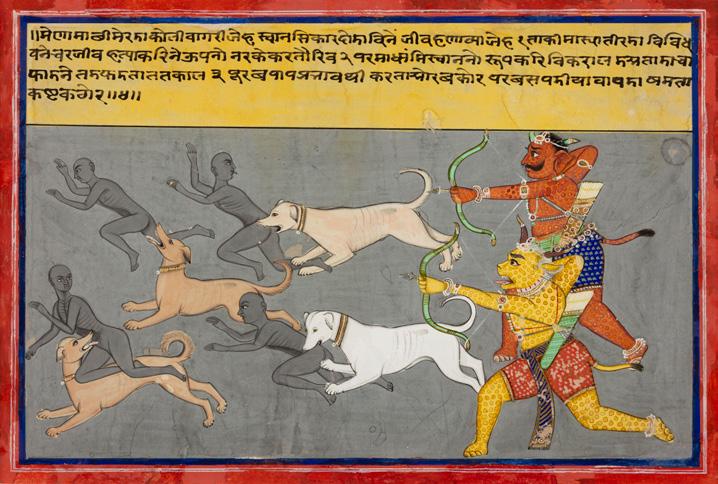

Private UK collection.
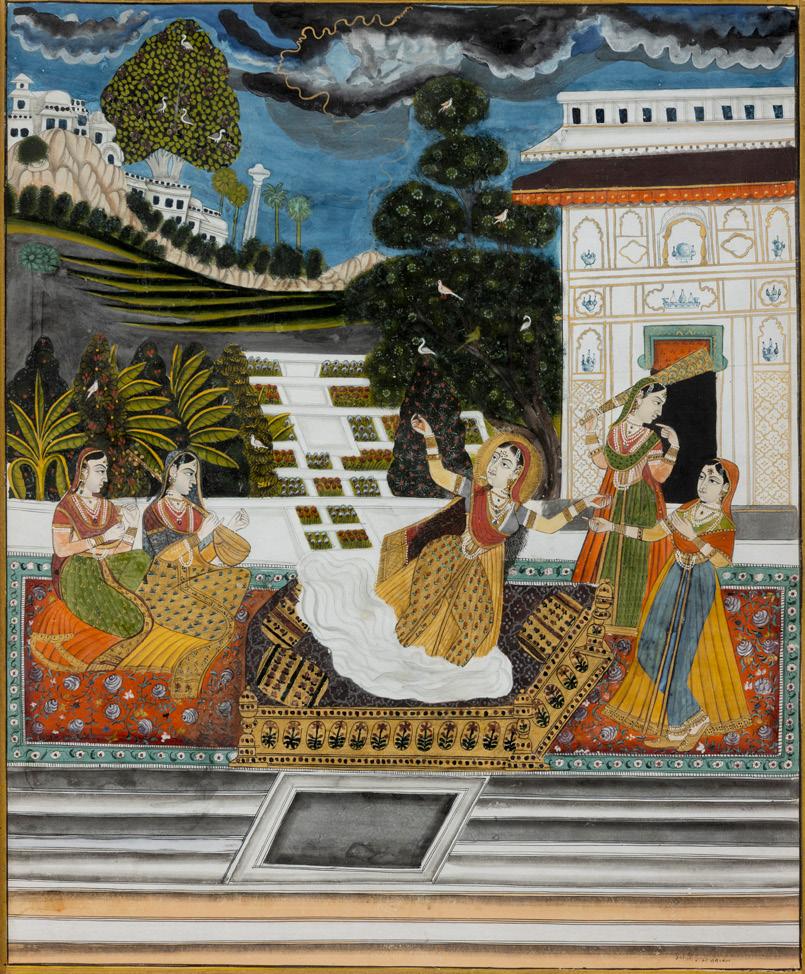
AN ILLUSTRATION FROM A RAGAMALA SERIES: MADHUMADAVI RAGINI
INDIA, ANDHRA PRADESH, KURNOOL, CIRCA 1810-20
gouache on paper heightened in gold, brown border with red margin rules, depicting a highly detailed scene with a maiden at the centre standing on her bed, two attendants to her left and two seated musicians to her right, her hands up in the air, on a carpeted terrace, orderly gardens in the background with various birds resting in exotic trees, in the distance a palace on a mountain top, all under a stormy night sky, mounted, glazed and framed
Sight size 30.5cm x 25cm
£2,500-3,000
Kurnool, on the banks of the river Tungabhadra and over a hundred miles from Hyderabad, was a large subordinate state of the capital with an important school of painting. For comparison and further reference see, M. Zebrowski, Deccani Painting, London, 1983, pp. 15, 148-149. 239, 244-245, 263, 272-273.
128
A BRASS INCENSE BURNER IN THE FORM OF A PEACOCK INDIA, DECCAN, 17TH CENTURY
cast, hinged and pierced, the peacock with upright feathers curled inwards, its breast pierced with holes, its feet perched on a stand, the rounded handle acting as a second stand 17.6cm high
£800-1,000
Provenance: Formerly, the collection of Jagdish Mittal (1925-2025).
Private UK collection.
For comparable examples of peacockformed incense burners attributed to the Deccan, see M. Zebrowski, Gold, Silver & Bronze from Mughal India, London, 1997, p. 100-101.
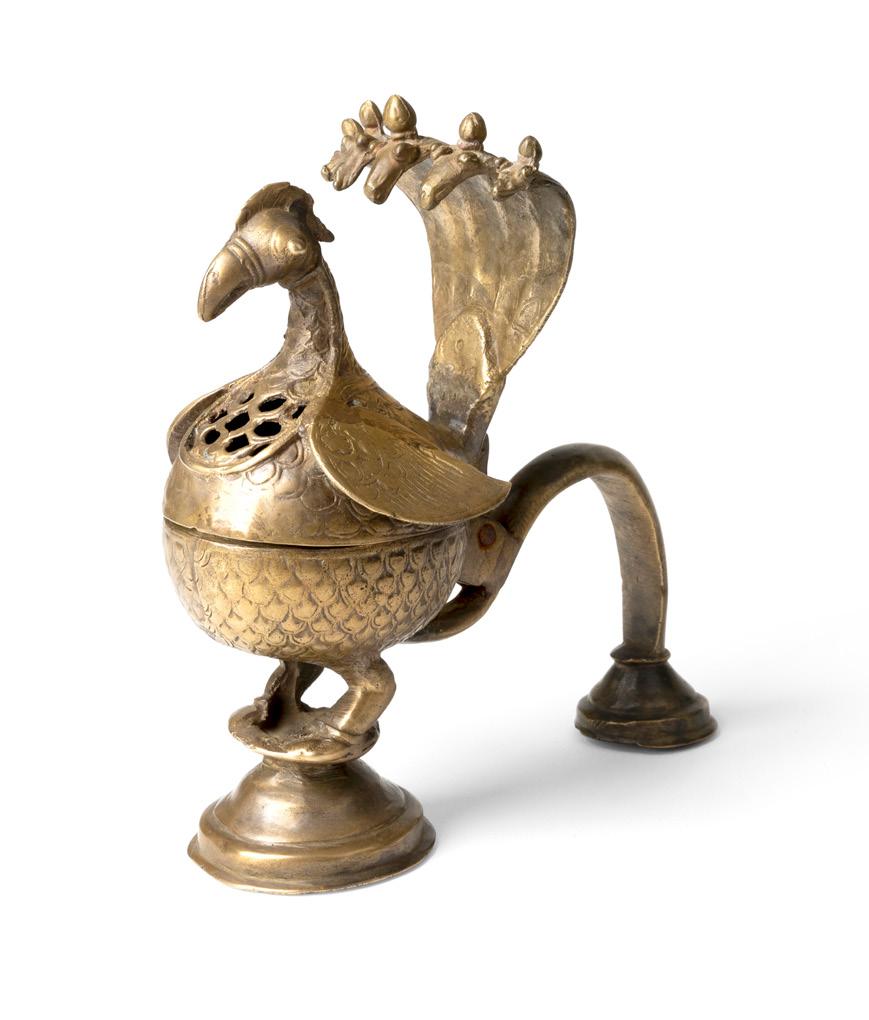
129
A RUBY BIRD PENDANT OR HAIR ORNAMENT SOUTH INDIA, TAMIL NADU, 19TH CENTURY
of circular form with small suspension hoop, the gilt metal openwork frame set with rubies, emerald and quartz, forming a bird design to the centre 3.2cm diameter
£1,000-1,500
For a very similar pendant or hair ornament sold in these rooms, see Islamic and Indian Art, 12 June 2024, lot 67.
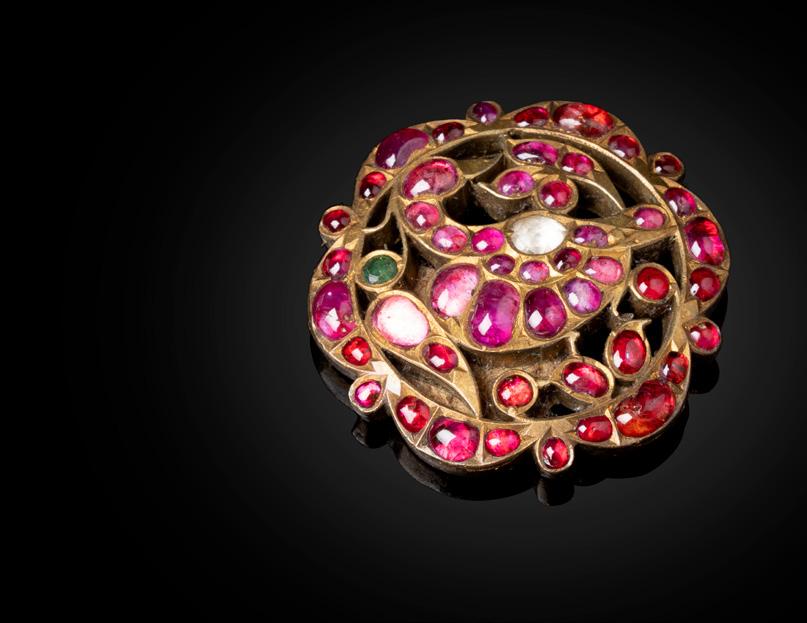
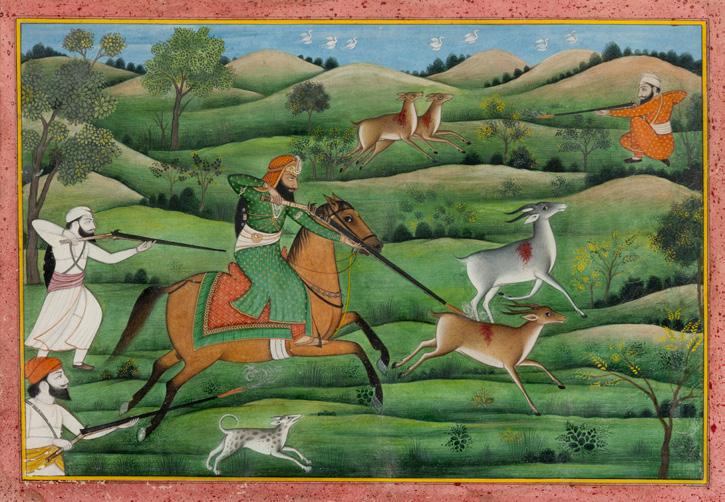
130
MAHARAJA NARINDER SINGH OF PATIALA (1824-1862) OUT HUNTING GAZELLES ON HORSEBACK ACROSS A HILLSIDE
INDIA, PUNJAB PLAINS, PATIALA, CIRCA 1860 gouache on paper, pink-flecked borders, depicting the Maharaja accompanied by a prince and attendants on foot, aiming rifles at their prey, mounted, glazed and framed Sight size 27.8cm x 40.5cm
£1,000-1,500
Maharaja Narinder Singh, fifth in line in the Patiala kingdom in the Punjab Plains, was a highly cultured ruler building palaces and forts and establishing a flourishing court studio where artists not only illustrated Sikh and Hindu texts but produced portraits, court and hunting scenes. Narinder Singh was also an important ally to the British during the Anglo-Sikh Wars and Uprising of 1857, declining to support the diminishing Mughal Empire. The Patiala ruler, having supplied soldiers and arms, was rewarded with honours and land in the Patiala region by the British. For further comparison and further discussion see: S. Stronge (ed), The Arts of the Sikh Kingdoms, London, 1999, pp. 165-179, pl. 200, and; D. Singh Toor, In Pursuit of Empire: Treasures from the Toor Collection of Sikh Art, London, 2018, pp.258-259.
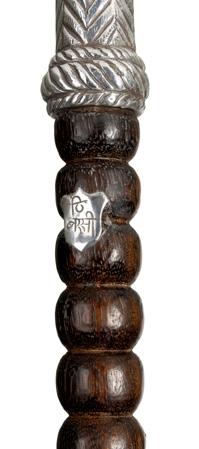
131
AN IMPRESSIVE PAIR OF SILVER-MOUNTED WOOD GUARDS’ CEREMONIAL SPEARS
CENTRAL INDIA, POSSIBLY DECCAN, LATE 19TH CENTURY/ EARLY 20TH CENTURY
each with a ribbed shaft made of turned wood surmounted by a tapering steel blade, the silver mounts with repoussee decoration consisting of zig-zag and fish scale patterns, a miniature crest-shaped silver plaque on each inscribed in Devanagari 231cm long
£4,000-6,000
For a pair of similar spears in the Royal Armouries in the Tower of London attributed to Mahratta, India, and dated to the 18th century, see object number XXVIL.222.

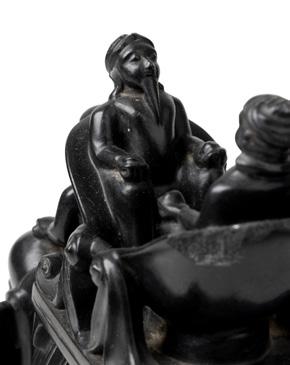
A CARVED STEATITE FIGURE OF AN ELEPHANT WITH RANJIT SINGH (R. 1780-1839)
NORTHWESTERN INDIA, PUNJAB, 19TH CENTURY
black stone carved with naturalistic details on a stand, the elephant caparisoned with a ceremonial howdah with two people seated inside facing one another, one figure with a characteristic long and tapering beard with his hands out in prayer closely resembling Ranjit Singh, a mahout is seated on the elephant’s neck
27.2cm high
£3,000-5,000
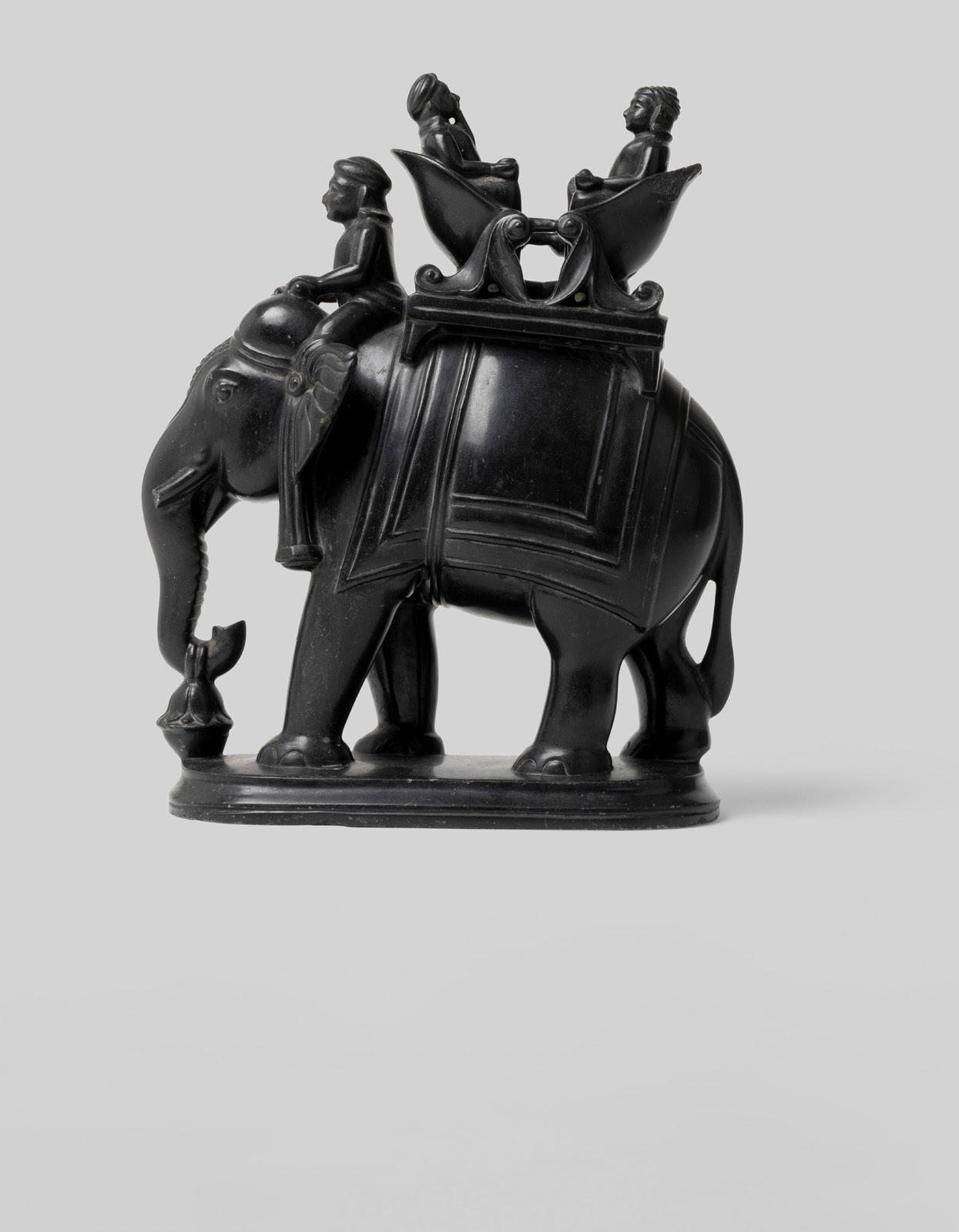
Provenance: Acquired from Susanna Montiel-Colmenares, circa 15 years ago.
Private UK collection.
Elephants have long been used in India to carry rulers during official processions and hunts and therefore are a common motif in art and sculpture depicting sovereigns. Their attributes were a marriage of Indian and European sensibilities, often exposed to Britain during the Regency period. Our example very likely depicts Maharajah Ranjit Singh with his distinctive howdah and facial resemblance. For a small carved black steatite sculpture of Ranjit Singh, See Bonhams, Islamic and Indian Art, 30th April 2019, Lot 205.

133
A HARBOUR SCENE WITH A BURNING MERCHANT SHIP
INDIA, RAJASTHAN, KUTCH, CIRCA 1850
gouache on paper, with a dark blue border, depicting a city harbour scene where a drama has unfolded in the form of a merchant ship taking fire on the right hand side, whilst people are depicted steadily emptying the ship, two charred bodies are seen rising up through the flames, other boats nearby are assisting, to the left the rest of the city goes on living with the gentry out on horseback or in a horse drawn carriage, riders on horseback, the backdrop of the city with a row of red and yellow awning flanking the city entrance, rows of figures on some of the buildings no doubt looking at the drama unfold
23.4cm x 38cm
£2,000-3,000
Provenance: Formerly, Private Collection, London
This lot and the following lot have a distinctive charm about them. Within the first painting, whilst the artist has successfully recounted a dramatic event with all the movement, gathering of people and the engulfing flames, they have failed to master perspective. The sea on the right hand side appears to be higher than the whole city and the two horse riders in the foreground are minuscule, compared to the rather large and obscure figure on the right in the foreground carrying a stick. Similarly in the second painting, the artist has managed the overall architectural perspective but then does not quite master the size of the figures. Both these paintings are charming interpretations or pastiche of Western prints. For further discussion on these types of paintings produced by local Indian artists, see B.N. Goswamy and Anna Dallapiccola, A Place Apart: Painting in Kutch, Oxford University Press, 1983.
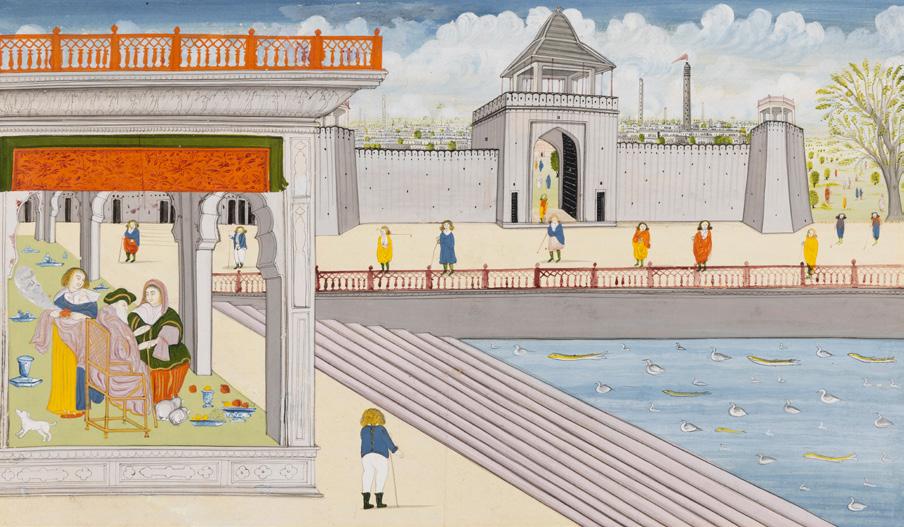
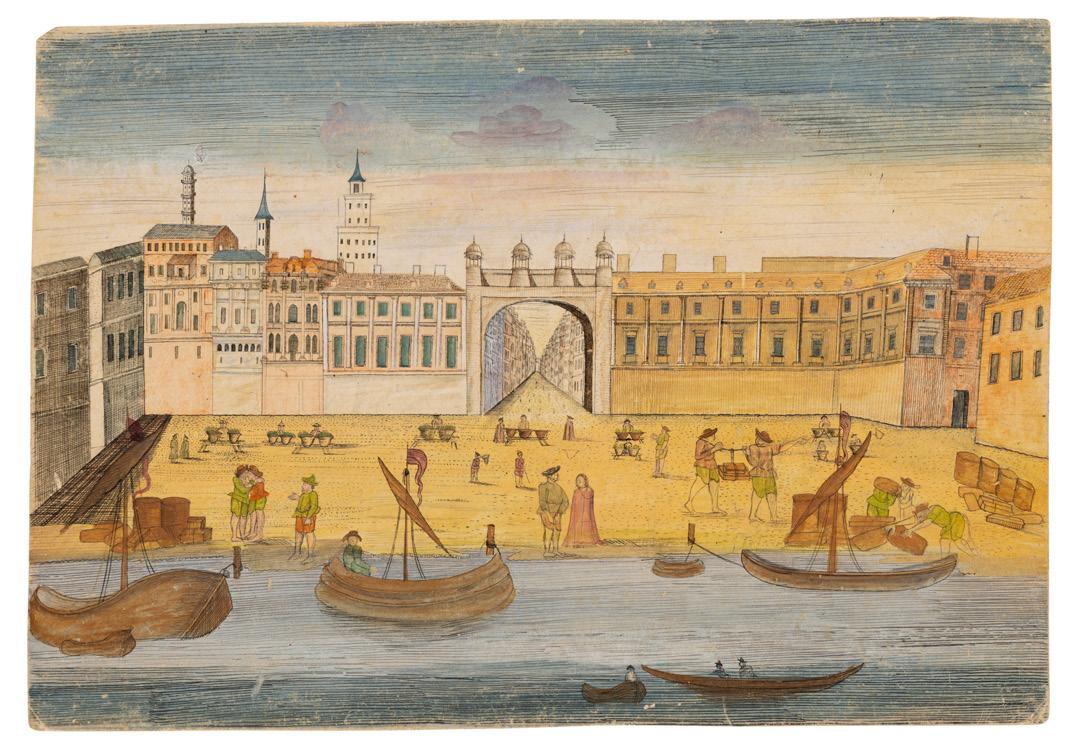
134
A VIEW OF A CITY LAKESIDE
INDIA, RAJASTHAN, JAIPUR, 19TH CENTURY
gouache on paper, yellow and blue border with white and black rules, depicting the walls of a fortress and a pavilion to the left with steps leading down to a pond, a seated elderly gentleman in European dress being attended by his companion and a lady servant holding a bowl of fruit, two cats sitting at their feet, a few gentleman walking about in European clothes with their walking sticks, a whole cityscape beyond the fortress walls with minaretstyle buildings, unframed
25.3cm x 35.2cm
£1,200-1,800
Provenance: Formerly, the collection of Marie-Christine David (Paris, 1946-2021).
Marie-Christine David was a recognised and leading specialist in Islamic and Indian Art in France.
135
’LISBON PORT HARBOUR’ ATTRIBUTED TO THE MASTER ARTIST NIHAL CHAND (1710-1782)
INDIA, RAJASTHAN, KISHANGARH, CIRCA 1750
ink and gouache on card, depicting a large square with a turreted and arched city entrance overlooking a harbour, various figures in European dress going about their daily chores including moving items from incoming boats, and on walkabouts, the arched entrance indicating a larger city in the background, to the left of the image, a variety of towered or minaret-style buildings in the background, cross hatching and highlights in black ink 19.7cm x 28.2cm
£4,000-6,000
Provenance: Private UK Collection.
This rare eighteenth-century illustration attributed to Nihal Chand of a city harbour that closely resembles the praco do Commerco in the Portuguese capital of Lisbon, is very probably based on an European print. The use of cross-hatching within the details of the buildings to the left, the unusual lines in the sea and sky, as well as little details on the square indicate that the artist was imitating the engraver of a print. The artist most known for this trait is Nihal Chand, whom this painting has been attributed to. For a comparable painting by Chand, entitled ‘Endless Vistas at Kishangarh’, formerly in the Stuart Cary Welch Collection, and now in the Harvard Museum, see object number 1995.116. Cary Welch notes on Chand: ‘Fascinated by the cross-hatching and freely stroked lines of the engraver’s tool, he has imitated them with loving care’ (see Exhibition Catalogue, A Room for Wonder: Indian Painting during the British period, 1760-1880, 1978, pp. 130-131). There are a number of other similarities with our painting, including the centred perspective, the sketching of the cloud and sky, and the size of the painting.
Nihal Chand, both an artist and poet, was the chief painter of the Kishangarh court during the reign of Savant Singh (also known as Nagari Das). He is credited for being one of the leading Rajput artists of the 18th century.
For a full and thorough study of Kishangarh Painting see N.Najat Haidar, The Kishangarh School of Painting: 1680-1850, D. Phil. Thesis, Oxford, 1995. See also P. Pal, Court Paintings of India, New York, 1983, R.13.
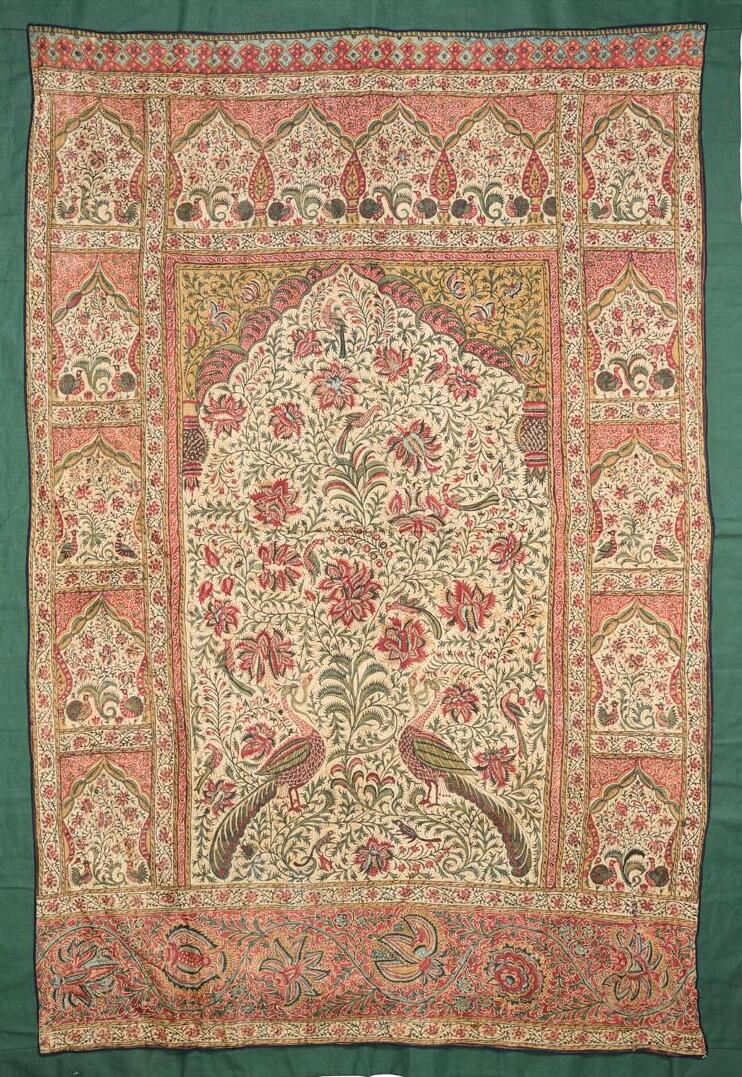
136
A CHINTZ PANEL OR HANGING INDIA, PROBABLY MACHILIPATNAM, CIRCA 1850
the rectangular cream cotton ground, painted with a mihrab arch with a pair of peacocks at the bottom and a ground of floral motifs, with a band of repeat smaller arches with pairs of birds and floral motifs around the arch, the lower part with a wide band of meandering floral palmettes, backed 123cm x 194cm; with panel 142cm x 214cm
£1,000-1,500
Provenance: Private UK collection.
For another painted panel with similar decoration in the Victoria and Albert Museum attributed to Machilipatnam, see IS.1-1890.

A STUDY OF A WESTERN CRESTED PIGEON INDIA, COMPANY SCHOOL, CALCUTTA, CIRCA 1830
watercolour on paper, watermarked ‘J. Whatman’, depicting the soft grey and brown-feathered pigeon standing on a tree stump with a sprig of pink flowers behind him, mounted, framed and glazed Sight size 29.2cm x 41cm
£3,000-4,000
Provenance: Private UK collection.
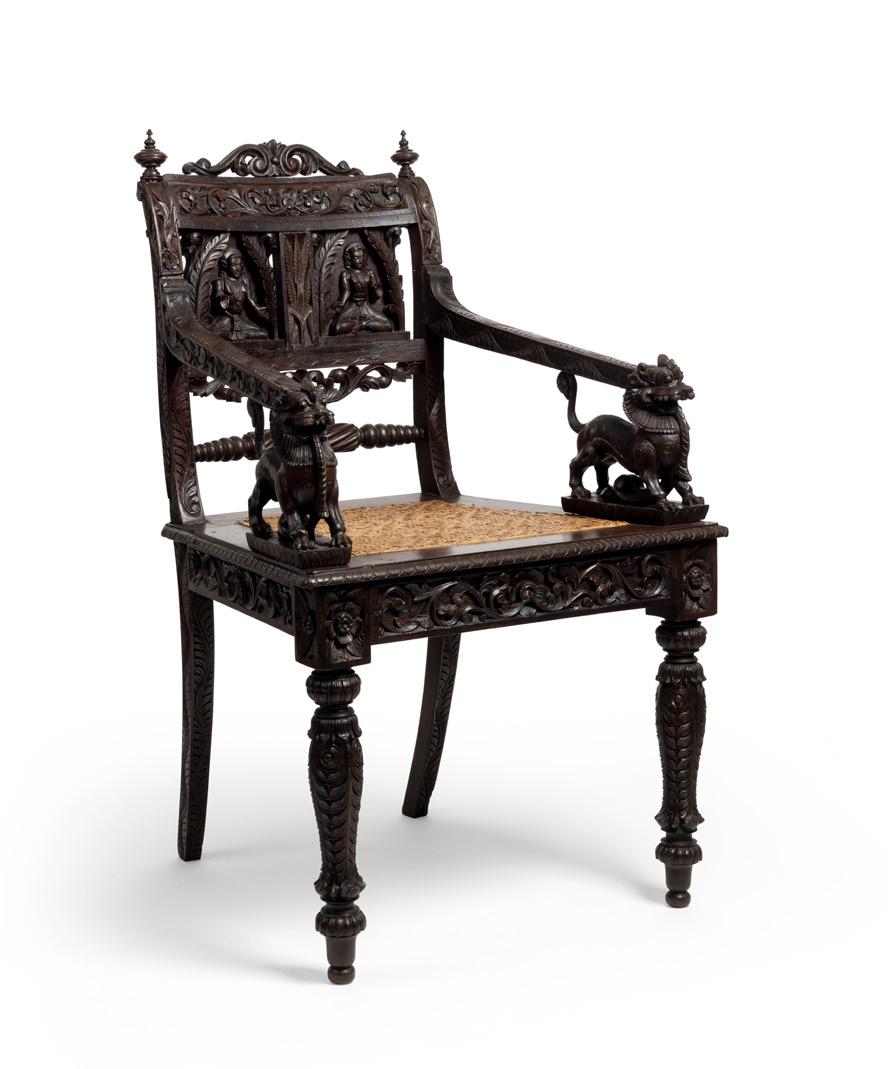
A RICHLY CARVED HARDWOOD ARMCHAIR
SOUTHERN INDIA, TAMIL NADU, LATE 19TH CENTURY
standing on two bun feet and two bracket feet, profusely carved in relief with floral and vegetal designs, the armrests on a pair of proud standing lions, the back rest carved with two niches comprising two cross-legged figures within leafy arches, with caned seat
93cm x 57.5cm x 50.5cm
£2,000-3,000
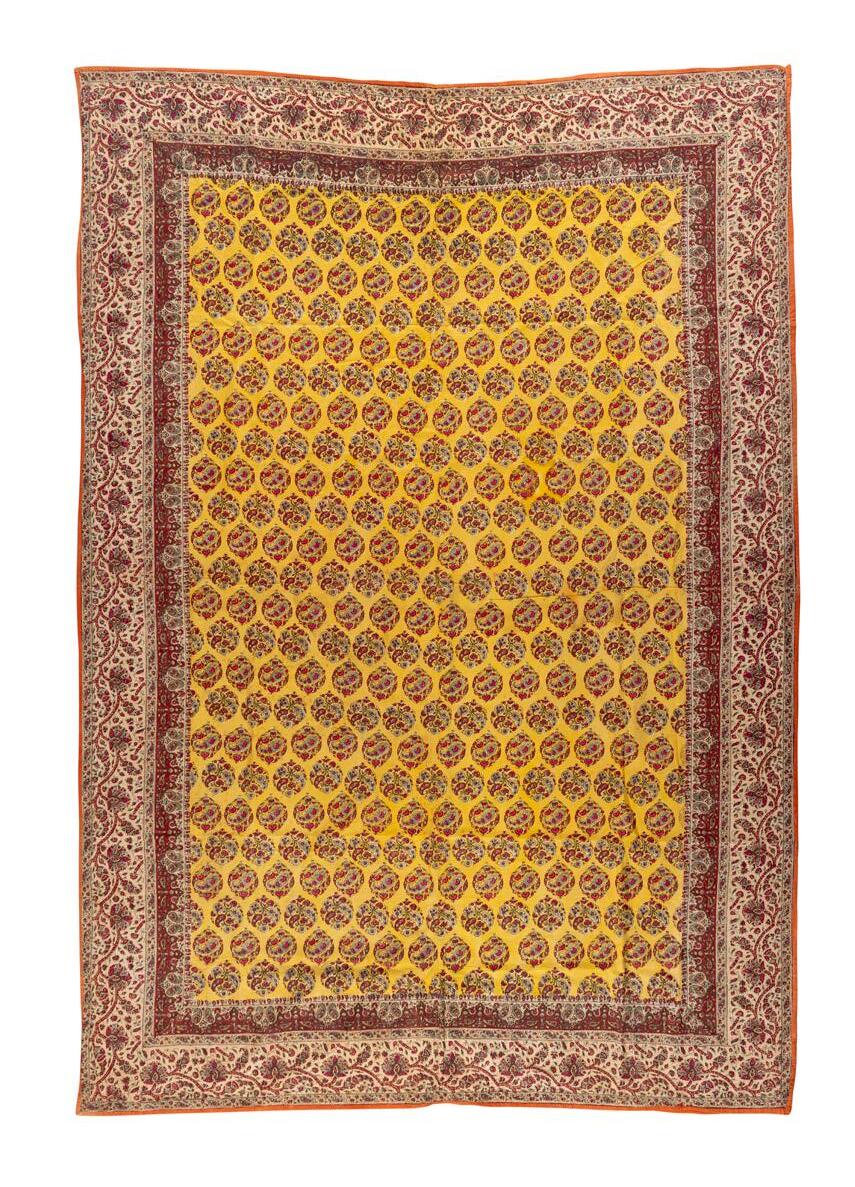
139
A RESIST AND MORDANT DYED AND PAINTED COTTON COVERLET INDIA, GUJARAT, CIRCA 1880 of rectangular form, the main bright yellow ground is covered with a repeat design of floral sprigs with boteh motifs, the borders with meandering floral swags, backed in orange 228cm x 160cm
£800-1,200
Provenance: Private UK collection. This striking, predominantly yellow ground is unusual but shows the versatility of the women producing these types of textiles. For a similarly decorated coverlet in the Victoria and Albert Museum, see accession number IS.410-1883.
140
AN INDIAN VULTURE
INDIA, COMPANY SCHOOL, CALCUTTA OR BARRACKPORE, CIRCA 1803
gouache on paper, inscribed in ink to the top of the sheet in Persian: vibyati kwik, which translates as “Foreign vulture or provincial vulture”, mounted, glazed and framed 47cm x 29.5cm
£12,000-15,000
Provenance: George Annesley, 9th Viscount Valentia (1769-1844).
Collection of Stuart Cary Welch, New England, 1994.
A mysterious and macabre creature, the vulture has long been a point of interest for bird enthusiasts, as well as art enthusiasts. With the vulture’s association with death and their presence in multiple continents, they are an interesting subject matter that can be found in the art of many cultures. The birds whose features have led us to classify them as vultures, inhabit Asia, Africa, Europe, North and South America. New World and Old World vultures have slight differences including wing length, the length of the hind claws and the structure of the nostrils but were nevertheless assumed to be related. Today, New World vultures are currently considered to be a sister-group to the large family which includes hawks, eagles and Old-World vultures. It is an important reminder that, just because different animal groups are adapted to the same ecological niche and therefore look the same, it does not mean that they are necessarily related; this is called convergent evolution.
The vulture pictured here is something of an enigma. The large wings with relatively short primary flight feathers which do not extend beyond the tip of the tail, and its relatively long hind toe suggests that it should be an Old-World vulture. The fact that it is the subject of an Indian painting one would expect it to be an Asian species. But it is not.
The closest Old-World species is the African Hooded Vulture Necrosyrtes monachus, but their “hood” consists of pale brown down and not black feathers. The black colouration and red head are reminiscent of an American Turkey Vulture or another of the genus Cathartes, but the nostril shape and wing markings do not fit these either. The bill is unhooked, the fleshy cere on the bill is behind, and not surrounding the nostril, and, although the head is coloured red, it gives every indication of being covered in feathers which surround the bill and eye and completely mask the ear opening. Neither are there any slender-billed vulture species with anything resembling a wing bar, though it is possible that this marking is intended to represent a line of shiny iridescence. This is a bird which does not exist, possibly painted from a description or recollection of a vulture once seen. It is an amalgamation of different species, possibly inspired by famous paintings of vultures, such as those of the Mughal artist Mansur in the celebrated Kevorkian Album. It was not drawn from direct observation of a vulture but is, nevertheless, a beautiful and interesting painting.
This painting comes from an important series of natural history studies made for George Annesley, 2nd Earl of Mountnorris and Viscount Valentina, when he made a private tour of India from 1802-1806. He was a keen amateur natural historian and visited many botanists and zoologists during his trip, chronicling his travels in three volumes published in 1809 entitled Voyages and Travels to India, Ceylon and the Red Sea, Abyssinia and Egypt in 1802-06. In Calcutta there were a number of English residents who shared his passion in natural history, and Annesley’s visits to local aviaries and menageries inspired him to commission many natural history drawings, mostly of birds, several of which have subsequently found their way into other collections. Annesley gifted two paintings to Lord Wellesley when he stayed with him in 1803 and saw the menagerie in Barrackpore. These are now in the British Library in London and published in Mildred Archer, Natural History Drawings in the India Office Library, 1962, p. 96. There is another painting in the Chester Beaty Library published by Linda York Leach, Mughal and other Indian Paintings from the Chester Beaty Library, 1995, vol. ii, pp. 761-762.
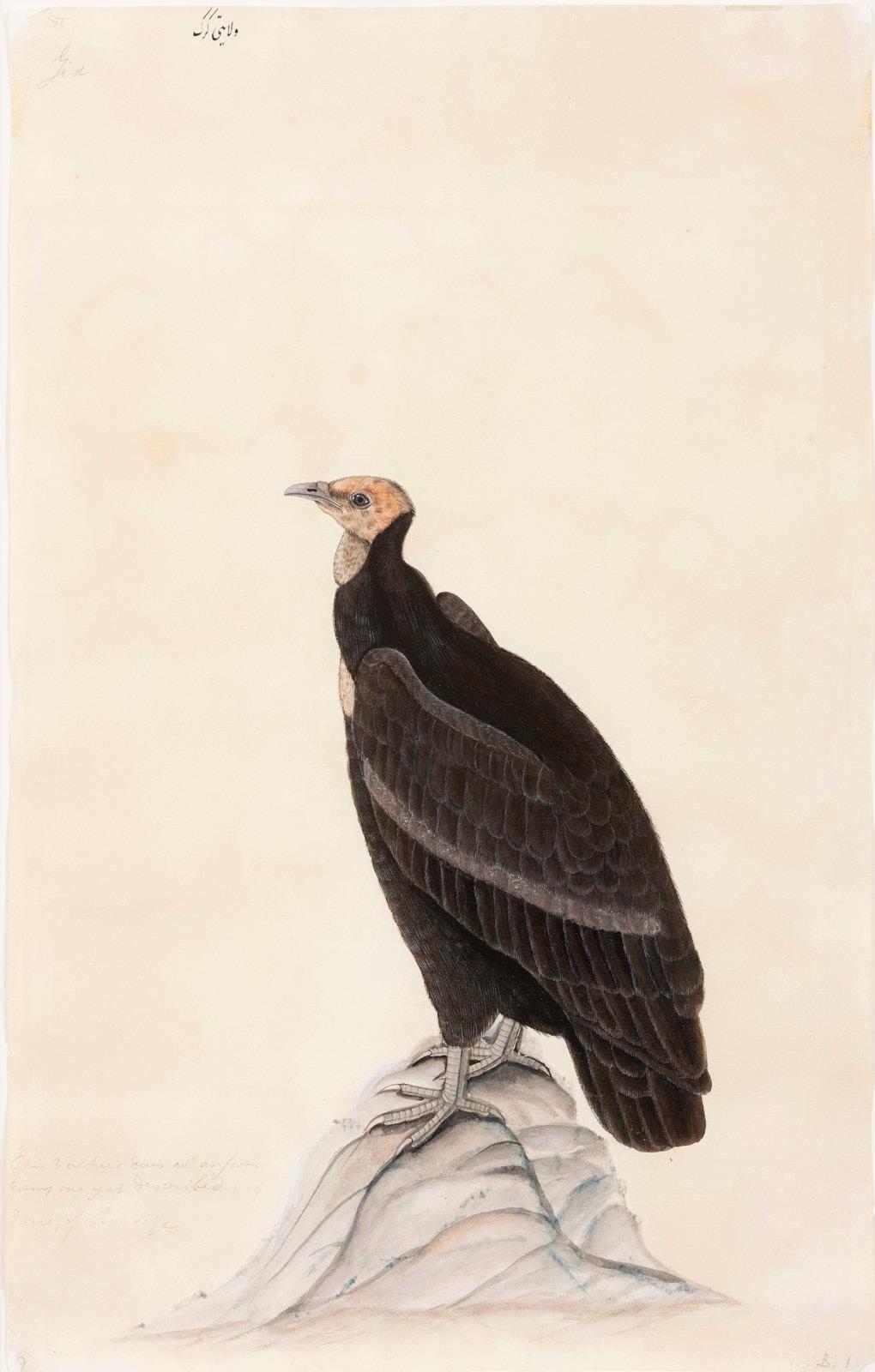


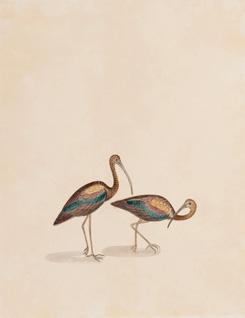
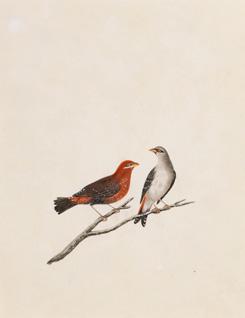


A GROUP OF EIGHT STUDIES OF BIRDS
INDIA, COMPANY SCHOOL, CALCUTTA, CIRCA 1840
watercolour on paper, watermarked ‘C. Wilmot 1840’, including a blue Indian Ringneck Parakeet, a Black Drongo, Red Avadavat, Glossy Ibis, Eurasian Hoopoe, Greater Painted Snipe, Oriental Turtle Dove or Spotted Dove, and probably the Amur Stonechat, mounted, glazed and framed each 25.2cm x 20.2cm
£3,000-5,000
Provenance: Formerly, the collection of Georgina Hogg (1938-2019), more commonly known as Min Hogg, co-founder of the The World of Interiors. Private UK London.
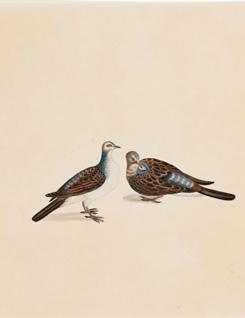
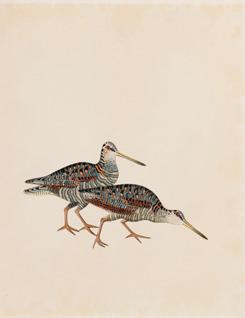
142
A STUDY OF PIETRA DURA INLAY ON THE CENOTAPH OF SHAH JAHAN AT THE TAJ MAHAL INDIA, COMPANY SCHOOL, EARLY 19TH CENTURY
ink and watercolour on paper, depicting a single flower, mounted, glazed and framed sight size 21cm x 16cm
£500-700
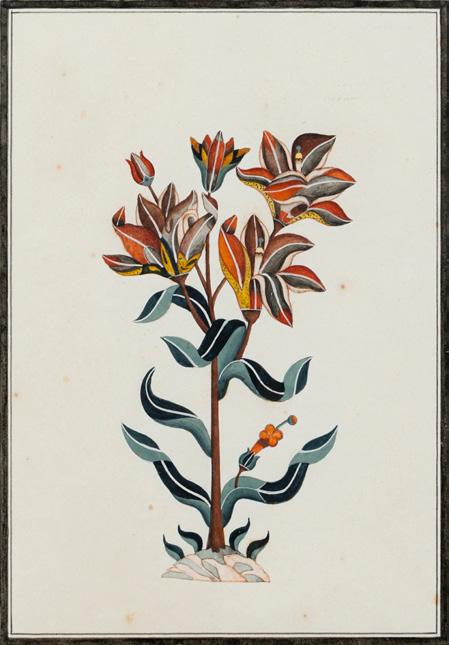
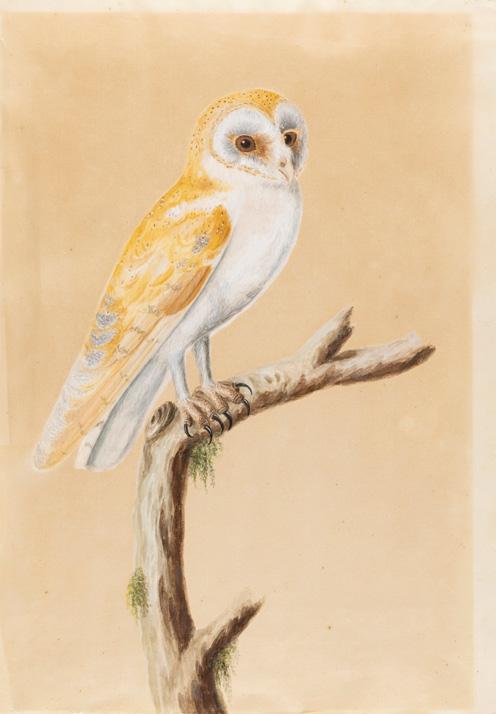
143
A STUDY OF AN INDIAN BARN OWL INDIA, COMPANY SCHOOL, 19TH CENTURY
watercolour on paper, watermarked ‘IHS I VILLEDARY, depicting an owl with his white chest and light brown wings, perched on a branch 72.5cm x 54.4cm
£600-800
This endearing study of a barn owl is painted on paper produced by French paper maker Jean Villedary. Jean Villedary’s watermark was used from 1668-1758, which suggests that this paper may have reached Bengal during the time the Dutch colony was occupying the area (1627-1825).
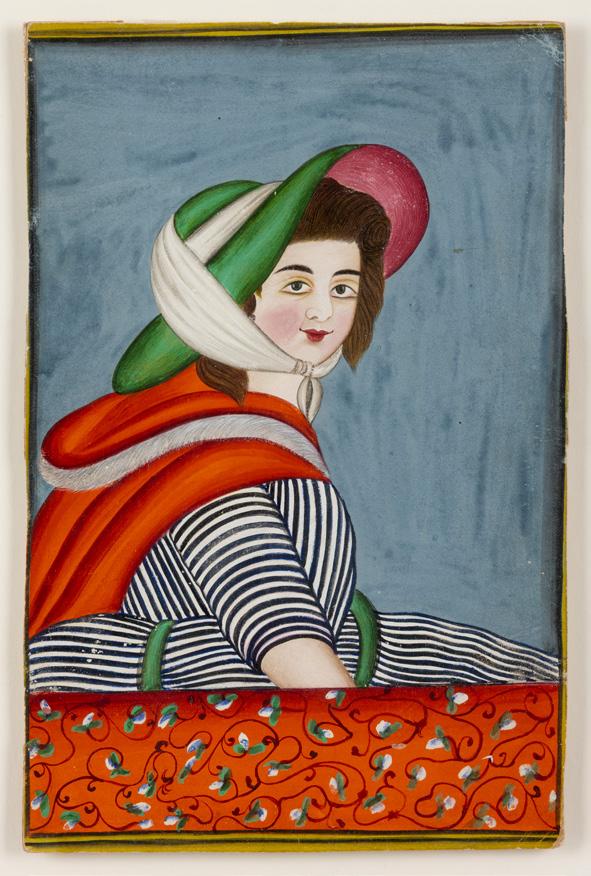
144
PORTRAIT
OF A EUROPEAN MISTRESS STANDING AT A WINDOW INDIA, COMPANY SCHOOL, KISHANGARH, EARLY 19TH CENTURY
gouache on paper, depicting a half portrait of a young European lady behind red window sill, she is dressed in a striped blue and white dress, a red cloak and a green bonnet, mounted, glazed and framed 22cm x 14cm
£1,500-2,000
Provenance: Formerly, the collection of the late Ruth Prawer Jhabvala (1927-2013).
Ruth Prawer Jhabvala, CBE, was a novelist and screenwriter who held both British and American citizenship. She gained widespread recognition for her long-standing partnership with Merchant Ivory Productions, the acclaimed team of director James Ivory and producer Ismail Merchant.
145
A GROUP OF BRASS TOY ANIMAL FIGURINES NORTHERN INDIA, 19TH CENTURY
cast brass, comprising a cow, a camel, a camel and rider, and a deer
8.4cm high max.
£400-600

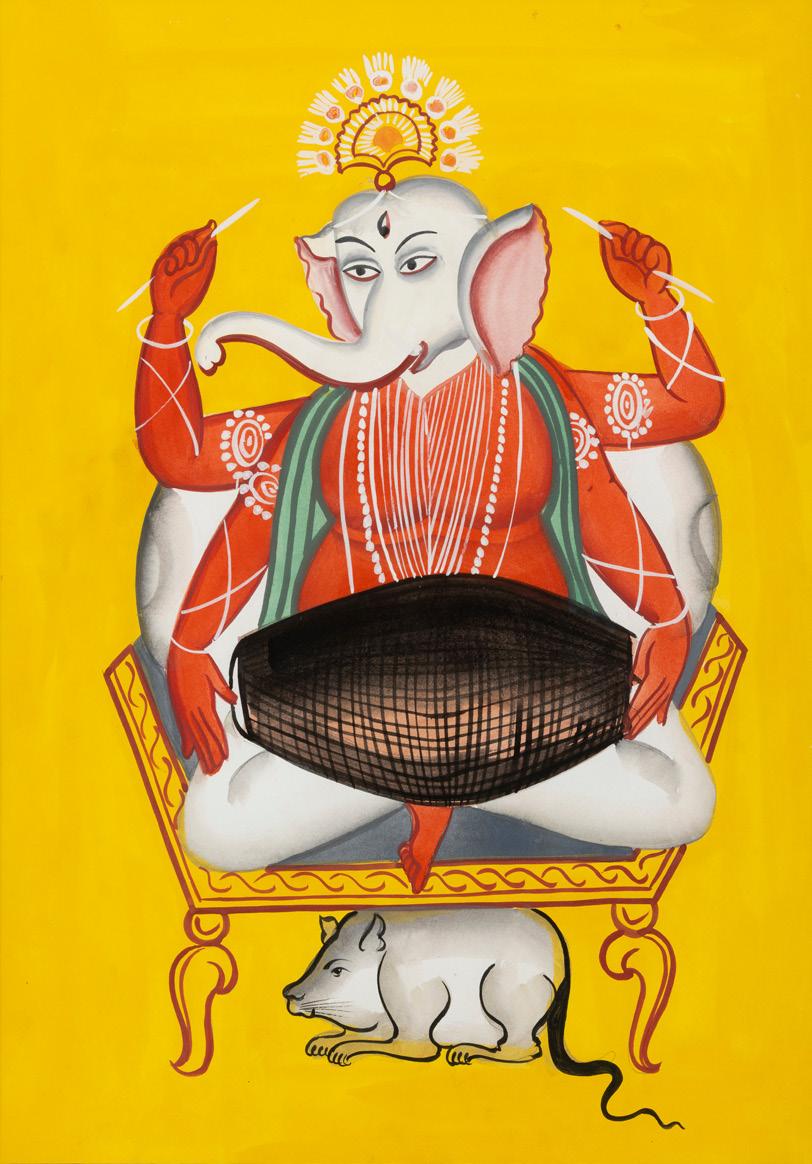
A KALIGHAT PAINTING OF GANESHA
BENGAL SCHOOL, INDIA, FIRST HALF OF 20TH CENTURY
watercolour on paper, on a bright yellow ground depicting Ganesha seated cross-legged playing the drums on a chair above his vehicle mouse, mounted, glazed and framed
Sight Size: 41cm x 28.7cm
£500-700
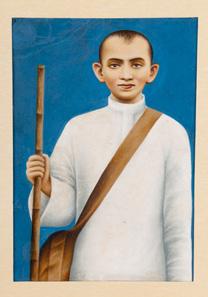
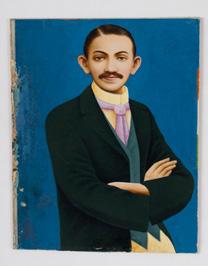

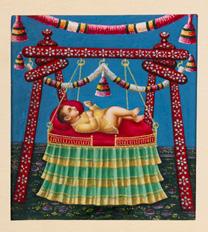
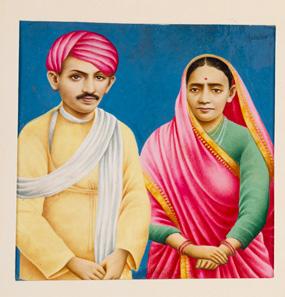
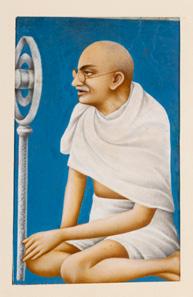
ORIGINAL PAINTINGS COMMISSIONED FOR A PRINTED POSTER ENTITLED ‘THE LIFE STORY OF THE REVERED GANDHIJI’ PUBLISHED BY HEMCHANDER BHARGAVA, DELHI
BY LAXMILAL NANDLAL NATHDWARA, INDIA, CIRCA 1948
gouache on card, comprising 10 small-sized paintings, one signed by the artist, depicting the life of Gandhi, from a baby depicted in a Krishnastyle presentation crib, to his early and later education dressed in a suit, his marriage, his time in South Africa, when he reached India, his change of dress, his peaceful marches, his speeches, his wisdom (10) 15.1cm x 15.5cm largest
£5,000-7,000
Provenance: Bonhams, India in Books, Photography, Maps and Manuscripts, 13 October 2006, lot 429.
Private UK Collection.
Created at an important moment in history these 10 original paintings were commissioned by publishers Hemchander Bharagava & Co of Delhi to form part of a dramatic biographical poster. “Poojya Gandhiji ki Jivan Caritra” or “The Life Story of Revered Gandhiji”, leads the viewer through the important events of Ghandi’s life culminating in his assassination. The story, told through each piece of art, commences in the bottom left-hand corner and moves vertically up the left-hand side of the poster before traversing horizontally and then down the right-hand side. Leading the viewer through his education and his arrival in South Africa, the poster then charts Ghandi’s journey back to India where he engages with key domestic issues before formulating his campaign of non-violent protests. Whilst the latter part of the story focuses on Ghandi’s campaign for Britain to quit India the dominant image is of his assassination which is placed front and centre to directly engage the viewer.
These paintings provide a rich visual biography which need to be considered against the dramatic political change of the period. In 1947 India was partitioned along religious lines to create the two independent states of India and Pakistan. This division displaced millions of people creating a refugee crisis, violence and large-scale loss of life. 6 months later Ghandi was shot dead in New Delhi on 30th January 1948. These events created turmoil and uncertainly in a country which had only just begun to realise its freedom. At a time when there was no television and radio was only just starting to make inroads, print makers took a lead in visual communication. As a result, these prints would have been highly prized, passed from hand to hand or displayed proudly in homes. It is also likely that they were affixed to walls, doors, or poster boards in public areas. They were meant for large scale communication but not designed to last. Gandhi figured prominently in these prints and whilst not a religious character he was often portrayed within the ranks of the divine depicted alongside Budda and Jesus. Artists also borrowed heavily from Catholic theology suggesting that the dripping blood, as seen within this poster design, represents Ghandi’s absorption into the blood stream of the nation. Ghandi’s identity was thus inextricably linked to India and vice versa. Artists also sought to portray a safe future for India. Whilst little is known about the artist of these paintings, Laxmilal Nandlal from Nathdwara, undoubtedly was a classically trained artist who was favoured by the publishing company Hemchander Bhargava & Co., for he went on to create a similar style biographical poster of Nehru, and also painted Indian deities, such as Lord Shiva and Parvati.
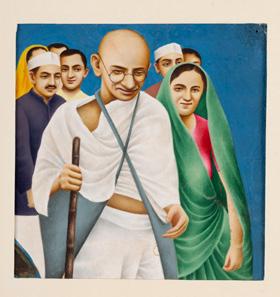

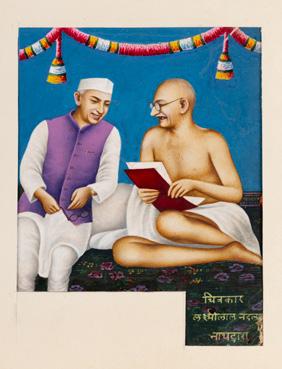
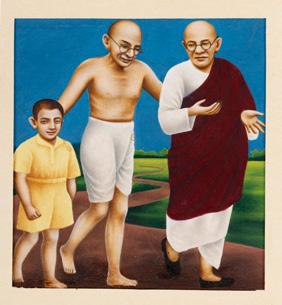
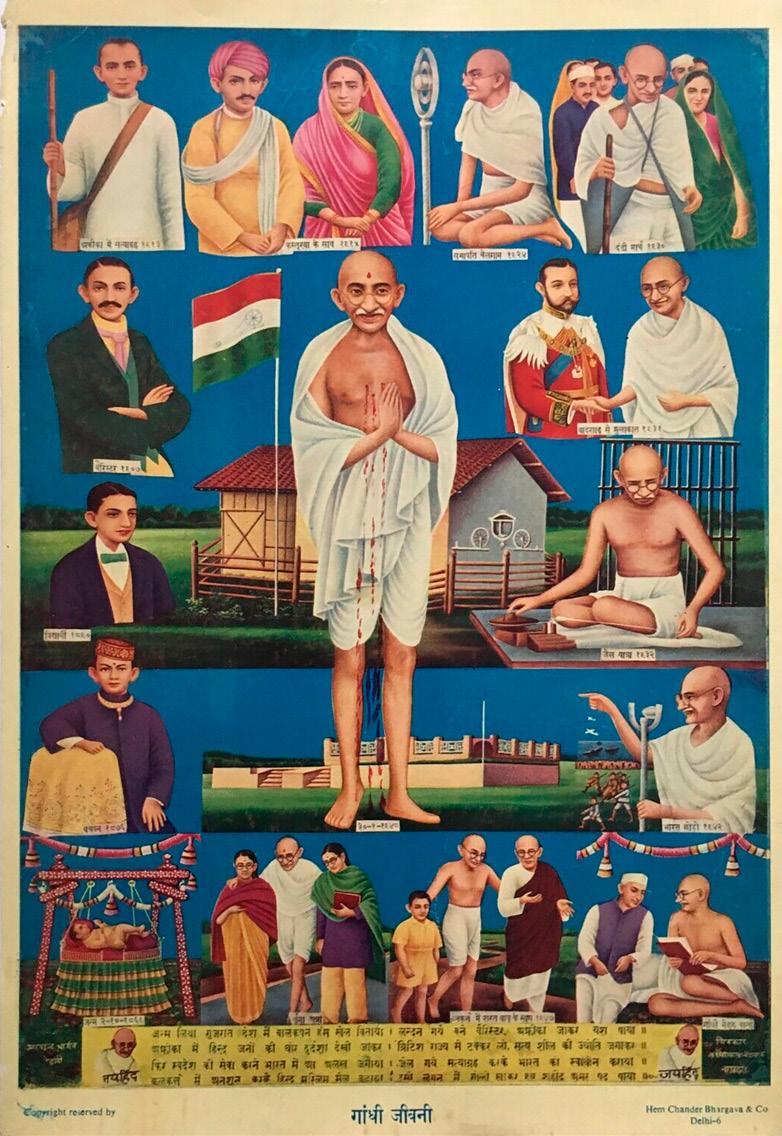
Poster entitled ‘The Life Story of the Revered Gandhiji’ published by Hemchander Bhargava, Delhi.
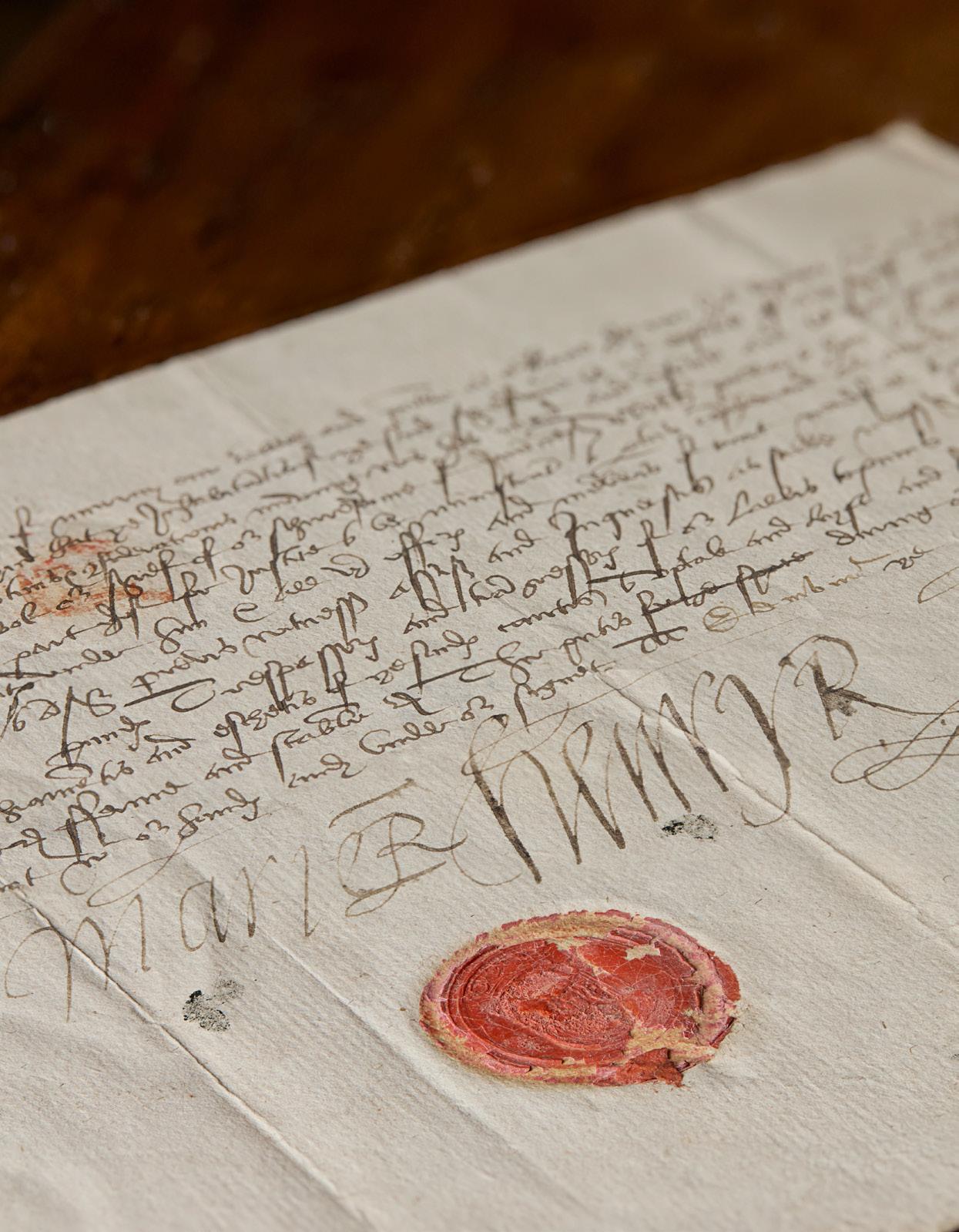
MARY, QUEEN OF SCOTS (1542-1587), QUEEN OF SCOTLAND 1542-1567
LETTER SIGNED, 1565
Letter signed “Marie R.” with the joint name “Henry R.” (Henry Stewart, Earl of Darnley) to the Laird of Kilravock, appointing him Sheriff for Inverness £10,000-15,000 + fees AUCTION
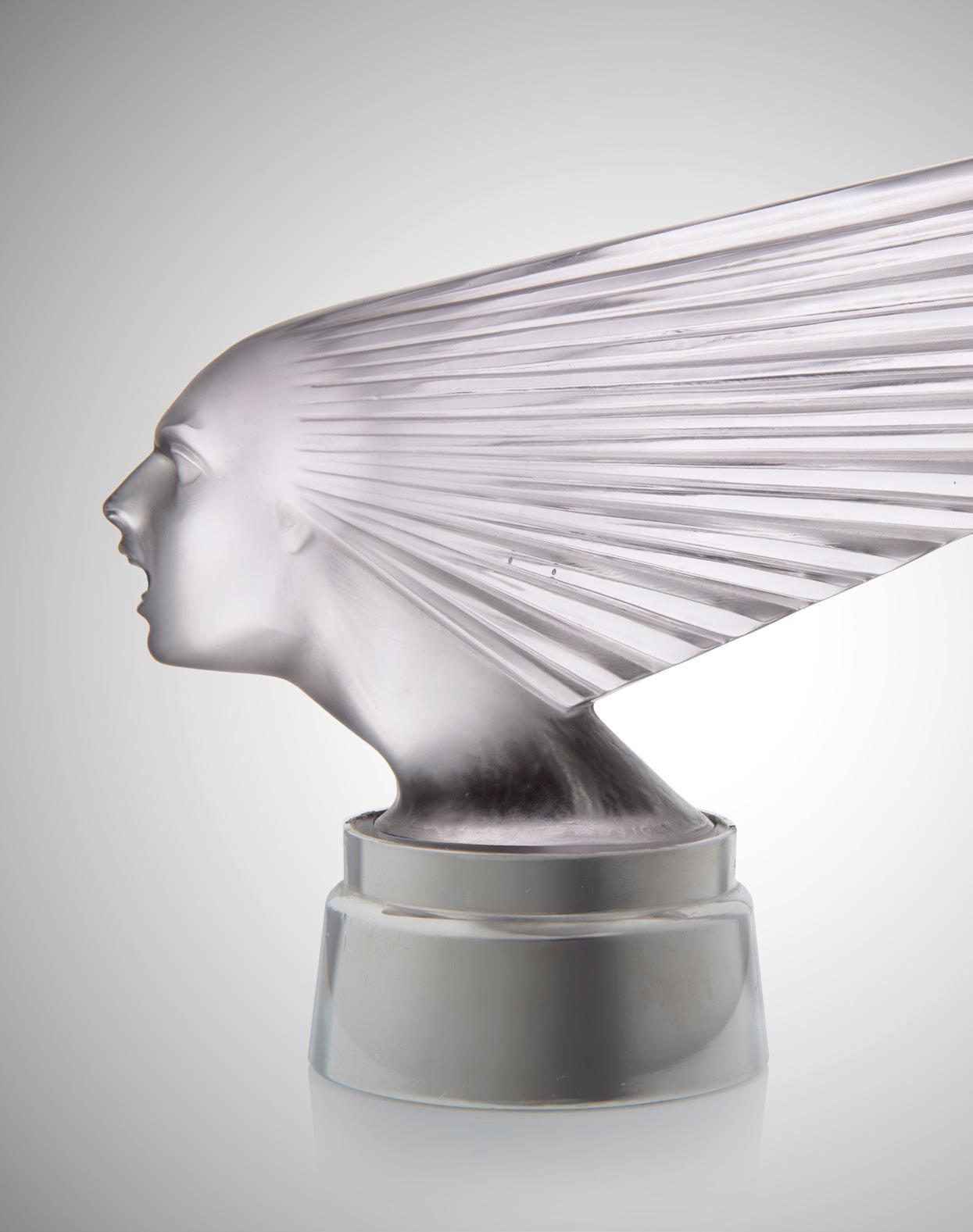
RENÉ LALIQUE (1860-1945)
VICTOIRE CAR MASCOT, NO. 1147
£6,000-8,000 + fees
FOR BUYERS (UK)
These Conditions of Sale and the Saleroom Notices as well as specific Catalogue terms, set out the terms on which we offer the Lots listed in this Catalogue for sale. By registering to bid and/or by bidding at auction You agree to these terms, we recommend that You read them carefully before doing so. You will find a list of definitions and a glossary at the end providing explanations for the meanings of the words and expressions used.
Special terms may be used in Catalogue descriptions of particular classes of items (Books, Jewellery, Paintings, Guns, Firearms, etc.) in which case the descriptions must be interpreted in accordance with any glossary appearing in the Catalogue. These notices and terms will also form part of our terms and conditions of sales.
In these Conditions the words “Us”, “Our”, “We” etc. refers to Lyon & Turnbull Ltd, the singular includes the plural and vice versa as appropriate. “You”, “Your” means the Buyer. Lyon & Turnbull Ltd. acts as agent for the Seller. Lyon & Turnbull Ltd. acts as agent for the Seller. On occasion where Lyon & Turnbull Ltd. own a lot in part or full the property will be identified in the catalogue with the symbol ( ) next to its lot number.
A. BEFORE THE SALE
1. DESCRIPTIONS OF LOTS
Whilst we seek to describe Lots accurately, it may be impractical for us to carry out exhaustive due diligence on each Lot. Prospective Buyers are given ample opportunities to view and inspect before any sale and they (and any independent experts on their behalf) must satisfy themselves as to the accuracy of any description applied to a Lot. Prospective Buyers also bid on the understanding that, inevitably, representations or statements by us as to authorship, genuineness, origin, date, age, provenance, condition or Estimated selling price involve matters of opinion. We undertake that any such opinion shall be honestly and reasonably held and only accept liability for opinions given negligently or fraudulently. Subject to the foregoing neither we the Auctioneer or our employees or agents accept liability for the correctness of such opinions and no warranties, whether relating to description, condition or quality of Lots, express, implied or statutory, are given. Please note that photographs/images provided may not be fully representative of the condition of the Lot and should not be relied upon as indicative of the overall condition of the Lot. All dimensions and weights are approximate only.
2. OUR RESPONSIBILITY FOR OUR DESCRIPTION OF LOTS
We do not provide any guarantee in relation to the nature of a Lot apart from our authenticity warranty contained in paragraph E.2 and to the extent provided below.
(a) Condition Reports: Condition Reports are provided on our Website or upon request. The absence of a report does not imply that a Lot is without imperfections. Large numbers of such requests are received shortly before each sale and department specialists and administration will endeavour to respond to all requests although we offer no guarantee. Any statement in relation to the Lot is merely an expression of opinion of the Seller or us and should not be relied upon as an inducement to bid on the Lot. Lots are available for inspection prior to the sale and You are strongly advised to examine any Lot in which You are interested prior to the sale. Our Condition Reports are not prepared by professional conservators, restorers or engineers. Our Condition Report does not form any contract between us and the Buyer. The Condition Reports do not affect the Buyer’s obligations in any way.
(b) Estimates: Estimates are placed on each Lot to help Buyers gauge the sums involved for the purchase of a particular Lot. Estimates do not include the Buyer’s Premium or VAT. Estimates are a matter of opinion and prepared in advance. Estimates may be subject to change and are for guidance only and should not be relied upon.
(c) Catalogue Alterations: Lot descriptions and Estimates are prepared in advance of the sale and may be subject to change. Any alterations will be announced on the Catalogue alteration sheet, made available prior to the sale. It is the responsibility of the Buyer to make themselves aware to any alterations which may have occurred.
3. WITHDRAWAL
Lyon & Turnbull may, at its discretion, withdraw any Lot at any time prior to or during the sale of the Lot. Lyon & Turnbull has no liability to You for any decision to withdraw.
4.
JEWELLERY, CLOCKS & OTHER ITEMS
(a) Jewellery:
(i) Coloured gemstones (such as rubies, sapphires and emeralds) may have been treated to enhance their look, through methods such as heating and oiling. These methods are accepted practice but may make the gemstone less strong and/or require special care in future.
(ii) All types of gemstones may have been improved by some method. You may request a gemmological report for
any Lot which does not have a report if the request is made to us at least three weeks before the date of the sale and You pay the fee for the report in advance of receiving said report.
(iii) We do not obtain a gemmological report for every gemstone sold in our sales. Where we do get gemmological reports from internationally accepted gemmological laboratories, such reports may be described in the Sale Particulars. Reports will describe any improvement or treatment only if we request that they do so, but will confirm when no improvement or treatment has been made. Because of differences in approach and technology, laboratories may not agree whether a particular gemstone has been treated, the amount of treatment or whether treatment is permanent. The gemmological laboratories will only report on the improvements or treatments known to the laboratories at the date of the report.
(iv) For jewellery sales, all Estimates are based on the information in any gemmological report or, if no gemmological report is available, You should assume that the gemstones may have been treated or enhanced.
(b) Clocks & Watches: All Lots are sold “as seen”, and the absence of any reference to the condition of a clock or watch does not imply the Lot is in good condition and without defects, repairs or restorations. Most clocks and watches will have been repaired during their normal lifetime and may now incorporate additional/ newer parts. Furthermore, we make no representation or warranty that any clock or watch is in working order. As clocks and watches often contain fine and complex mechanisms, Buyers should be aware that a general service, change of battery or further repair work, for which the Buyer is solely responsible, may be necessary. Buyers should also be aware that we cannot guarantee a watch will remain waterproof if the back is removed. Buyers should be aware that the importing watches such as Rolex, Frank Muller and Corum into the United States is highly restricted. These watches cannot be shipped to the USA and only imported personally. Clocks may be sold without pendulums, weights or keys.
(c) Alcohol: may only be sold to persons aged of 18 years and over. By registering to bid, You affirm that You are at least that age. All collections must be signed for by a person over the age of 18. We Reserve the right to ask for ID from the person collecting. Buyers of alcohol must make appropriate allowances for natural variations of ullages, conditions of corks and wine. We can provide no guarantees as to how the alcohol may have been stored. There is always a risk of cork failure and allowance by the Buyer must be made. Alcohol is sold “as is” and quality of the alcohol is entirely at the risk of the Buyer and no
warranties are given.
(d) Books-Collation: If on collation any named item in the sale Catalogue proves defective, in text or illustration the Buyer may reject the Lot provided he returns it within 21 days of the sale stating the defect in writing. This, however, shall not apply in the case of unnamed items, periodicals, autographed letters, music M.M.S., maps, drawings nor in respect of damage to bindings, stains, foxing, marginal worm holes or other defects not affecting the completeness of the text nor in respect of Defects mentioned in the Catalogue, or at the time of sale, nor in respect of Lots sold for less than £300.
(e) Electrical Goods: are sold as “works of art” only and if bought for use must be checked over for compliance with safety regulations by a qualified electrician first. Use of such goods is entirely at the risk of the Buyer and no warranties as to safety of the goods are given.
(f) Upholstered items: are sold as “works of art” only and if bought for use must be checked over for compliance with safety regulations (items manufactured prior to 1950 are exempt from any regulations). Use of such goods is entirely at the risk of the Buyer and no warranties as to safety of the goods are given. We provide no guarantee as to the originality of any wood/material contained within the item.
B. REGISTERING TO BID
1.
NEW BIDDERS
(a) If this is Your first time bidding at Lyon & Turnbull or You are a returning Bidder who has not bought anything from us within the last two years You must register at least 48 hours before an auction to give us enough time to process and approve Your registration. We may, at our discretion, decline to permit You to register as a Bidder. You will be asked for the following:
(i) Individuals: Photo identification (driving licence, national identity card or passport) and, if not shown on the ID document, proof of Your current address (for example, a current utility bill or bank statement)
(ii) Corporate clients: Your Certificate of Incorporation or equivalent document(s) showing Your name and registered address together with documentary proof of directors and beneficial owners, and;
(iii) Trusts, partnerships, offshore companies and other business structures please contact us directly in advance to discuss requirements.
(b) We may also ask You to provide a financial reference and/or a deposit to allow You to bid. For help, please contact our Finance Department on +44(0)131 557 8844.
2. RETURNING BIDDERS
We may at our discretion ask You for current identification as described in paragraph B.1.(a) above, a finance
reference or a deposit as a condition of allowing You to bid. If You have not bought anything from us in the last two years, or if You want to spend more than on previous occasions, please contact our Finance Department on +44(0)131 557 8844.
3. FAILURE TO PROVIDE THE RIGHT DOCUMENTS
If in our opinion You do not satisfy our Bidder identification and registration procedures including, but not limited to, completing any anti-money laundering and/or anti-terrorism financing checks we may require to our satisfaction, we may refuse to register You to bid, and if You make a successful bid, we may cancel the contract between You and the Seller.
4. BIDDING ON BEHALF OF ANOTHER PERSON
(a) As an authorised Bidder: If You are bidding on behalf of another person, that person will need to complete the registration requirements above before You can bid, and supply a signed letter authorising You to bid for him/her.
(b) As agent for an undisclosed principal: If You are bidding as an agent for an undisclosed principle (the ultimate Buyer(s)) You accept personal liability to pay the Purchase Price and all other sums due, unless it has been agreed in writing with us before commencement of the auction that the Bidder is acting as an agent on behalf of a named third party acceptable to us and we will seek payment from the named third party.
5. BIDDING IN PERSON
If You wish to bid in the saleroom You must register for a numbered bidding paddle before You begin bidding. Please ensure You bring photo identification with You to allow us to verify Your registration.
6. BIDDING SERVICES
The bidding services described below are a free service offered as a convenience to our clients and we are not responsible for any error (human or otherwise), omission or breakdown in providing these services.
(a) Phone bids
Your request for this service must be made no later than 12 hours prior to the auction. We will accept bids by telephone for Lots only if our staff are available to take the bids. If You need to bid in a language other than English You should arrange this Well before the auction. We do not accept liability for failure to do so or for errors and omissions in connections.
(b) Internet Bids
For certain auctions we will accept bids over the internet. For more information please visit our Website. We will use reasonable efforts to carry out online bids and do not accept liability for equipment failure, inability to access the internet or software malfunctions related to execution of online bids/ live bidding.
(c) Written Bids
While prospective Buyers are strongly advised to attend the auction and are always responsible for any decision to bid for a particular Lot and shall be assumed to have carefully inspected and satisfied themselves as to its condition we shall, if so instructed, clearly and in writing execute bids on their behalf. Neither the Auctioneer nor our employees nor agents shall be responsible for any failure to do so. Where two or more commission bids at the same level are recorded we Reserve the right in our absolute discretion to prefer the first bid so made. Bids must be expressed in the currency of the saleroom. The Auctioneer will take reasonable steps to carry out written bids at the lowest possible price, taking into account the Reserve. If You make a written bid on a Lot which does not have a Reserve and there is no higher bid than Yours, we will bid on Your behalf at around 50% of the lower Estimate or, if lower, the amount of Your bid.
C. DURING THE SALE
1.
ADMISSION TO OUR AUCTIONS
We shall have the right at our discretion, to refuse admission to our premises or attendance at our auctions by any person. We may refuse admission at any time before, during or after the auction.
2. RESERVES
Unless indicated by an insert symbol (∆), all Lots in this Catalogue are offered subject to a Reserve. A Reserve is the confidential Hammer Price established between us and the Seller. The Reserve is generally set at a percentage of the low Estimate and will not exceed the low Estimate for the Lot.
3. AUCTIONEER’S DISCRETION
The maker of the highest bid accepted by the Auctioneer conducting the sale shall be the Buyer and any dispute shall be settled at the Auctioneer’s absolute discretion. The Auctioneer may move the bidding backwards of forwards in any way he or she may decide or change the order of the Lots. The Auctioneer may also; refuse any bid, withdraw any Lot, divide any Lot or combine any two or more Lots, reopen or continuing bidding even after the hammer has fallen.
4. BIDDING
The Auctioneer accepts bids from:
(a) Bidders in the saleroom;
(b) Telephone Bidders, and internet Bidders through Lyon & Turnbull Live or any other online bidding platform we have chosen to list on and;
(c) Written bids (also known as absentee bids or commission bids) left with us by a Bidder before the auction.
5. BIDDING INCREMENTS
Bidding increments shall be at the Auctioneer’s sole discretion.
6. CURRENCY CONVERTER
The saleroom video screens and bidding platforms may show bids in some other major currencies as Well as sterling. Any conversion is for guidance only and we cannot be bound be any rate of exchange used. We are not responsible for any error (human or otherwise) omission or breakdown in providing these services.
7. SUCCESSFUL BIDS
Unless the Auctioneer decides to use their discretion as set out above, when the Auctioneer’s hammer falls, we have accepted the last bid. This means a contract for sale has been formed between the Seller and the successful Bidder. We will issue an invoice only to the registered Bidder who made the successful bid. While we send out invoices by post/or email after the auction, we do not accept responsibility for telling You whether or not Your bid was successful. If You have bid by written bid, You should contact us by telephone or in person as soon as possible after the auction to get details of the outcome of our bid to avoid having to pay unnecessary storage charges.
8.
RELEVANT LEGISLATION
You agree that when bidding in any of our sales that You will strictly comply with all relevant legislation including local laws and regulations in force at the time of the sale for the relevant saleroom location.
D.
THE BUYER’S
PREMIUM, TAXES AND ARTIST’S RESALE ROYALTY
1. THE PURCHASE PRICE
For each Lot purchased a Buyer’s Premium of 26% of the Hammer Price of each Lot up to and including £20,000, plus 25% from £20,001 to £500,000, plus 20% from £500,001 thereafter. VAT at the appropriate rate is charged on the Buyer’s Premium. No VAT is payable on the Hammer Price or premium for printed books or unframed maps bought at auction. Live online bidding may be subject to an additional premium (level dependent on the live bidding service provider chosen). This additional premium is subject to VAT at the appropriate rate as above.
2. VALUE ADDED TAX
Value Added Tax is charged at the appropriate rate prevailing by law at the date of sale and is payable by Buyers of relevant Lots.
(a) Lots affixed with (†): Value Added Tax on the Hammer Price is imposed by law on all items affixed with a dagger (†). This imposition of VAT maybe because the Seller is registered for VAT within the European Union and is not operating under a Margin Scheme.
(b) Lots affixed with (*): A reduced rate of Value Added Tax on the Hammer Price of 5% is payable. This indicates that a Lot has been imported from outwit the European Union. This
reduced rate is applicable to Antique items.
(c) Lots affixed with [Ω]: Standard rate of Value Added Tax on the Hammer Price and premium is payable. This applies to items that have been imported from outwit the European Union and do not fall within the reduced rate category outlined above.
3. ARTIST’S RESALE ROYALTY (DROIT DE SUITE)
This symbol § indicates works which may be subject to the Droit de Suite or Artist’s Resale Right, which took effect in the United Kingdom on 14th February 2006. We are required to collect a royalty payment for all qualifying works of art. Under new legislation which came into effect on 1st January 2012 this applies to living artists and artists who have died in the last 70 years. This royalty will be charged to the Buyer on the Hammer Price and in addition to the Buyer’s Premium. It will not apply to works where the Hammer Price is less than £1,000. The charge for works of art sold at and above £1,000 and below £50,000 is 4%. For items selling above £50,000, charges are calculated on a sliding scale. All royalty charges are paid to the Design and Artists Copyright Society (‘DACS’) and no handling costs or additional fees are retained by the Auctioneer. Resale royalties are not subject to VAT. More information on Droit de Suite is available at www.dacs.org.uk.
E. WARRANTIES
1. SELLER’S WARRANTIES
For each Lot, the Seller gives a warranty that the Seller; (a) Is the owner of the Lot or a joint owner of the Lot acting with the permission of the other co-owners, or if the Sellers is not the owner of or a joint owner of the Lot, has the permission of the owner to sell the Lot, or the right to do so in law, and; (b) Had the right to transfer ownership of the Lot to the Buyer without any restrictions or claims by anyone else. If either other above warranties are incorrect, the Seller shall not have to pay more than the Purchase Price (as defined in the glossary) paid by You to us. The Seller will not be responsible to You for any reason for loss of profits or business, expected savings, loss of opportunity or interest, costs, damages, other damages or expense. The Seller gives no warranty in relation to any Lot other than as set out above and, as far as the Seller is allowed by law, all warranties from the Seller to You, and all obligations upon the Seller which may be added to this agreement by law, are excluded.
2. AUTHENTICITY GUARANTEE
We guarantee that the authorship, period, or origin (collectively, “Authorship”) of each Lot in this Catalogue is as stated in the BOLD or CAPITALISED type heading in the Catalogue description of the Lot, as
amended by oral or written saleroom notes or announcements. We make no warranties whatsoever, whether express or implied, with respect to any material in the Catalogue other than that appearing in the Bold or Capitalised heading and subject to the exclusions below.
In the event we, in our reasonable opinion, deem that the conditions of the authenticity guarantee have been satisfied, it shall refund to the original purchaser of the Lot the Hammer Price and applicable Buyer’s Premium paid for the Lot by the original purchaser.
This Guarantee does not apply if:
(a) The Catalogue description was in accordance with the opinion(s) of generally accepted scholar(s) and expert(s) at the date of the sale, or the Catalogue description indicated that there was a conflict of such opinions; or
(b) the only method of establishing that the Authorship was not as described in the Bold or Capitalised heading at the date of the sale would have been by means or processes not then generally available or accepted; unreasonably expensive or impractical to use; or likely (in our reasonable opinion) to have caused damage to the Lot or likely to have caused loss of value to the Lot; or
(c) There has been no material loss in value of the Lot from its value had it been in accordance with its description in the Bold or Capitalised type heading.
This Guarantee is provided for a period of one year from the date of the relevant auction, is solely for the benefit of the original purchaser of the Lot at the auction and may not be transferred to any third party. To be able to claim under this Authenticity Guarantee, the original purchaser of the Lot must:
(a) notify us in writing within one month of receiving any information that causes the original purchaser of record to dispute the accuracy of the Bold or Capitalised type heading, specifying the Lot number, date of the auction at which it was purchased and the reasons for such dispute; and (b) return the Lot to our registered office in the same condition as at the date of sale to the original purchaser of record and be able to transfer good title to the Lot, free from any third party claims arising after the date of such sale.
We have discretion to waive any of the above requirements. We may require the original purchaser of the Lot to obtain, at the original purchaser of Lot’s cost, the reports of two independent and recognised experts in the field. The reports must be mutually acceptable to us and the original purchaser of the Lot. We shall not be bound by any reports produced by the original purchaser of the Lot, and Reserves the right to seek additional
expert advice at its own expense. It is specifically understood and agreed that the rescission of a sale and the refund of the original Purchase Price paid (the successful Hammer Price, plus the Buyer’s Premium) is exclusive and in lieu of any other remedy which might otherwise be available as a matter of law. Lyon & Turnbull and the Seller shall not be liable for any incidental or consequential damages incurred or claimed, including without limitation, loss of profits or interest.
3. YOUR WARRANTIES
(a) You warrant that the funds used for settlement are not connected with any criminal activities, including tax evasion and You are neither; under investigation, have been charged with or convicted of money laundering, terrorist activities or other crimes.
(b) Where You are bidding on behalf of another person You warrant that:
(i) You have conducted appropriate customer due diligence on the ultimate Buyer(s) of the Lot(s) in accordance with all relevant antimoney laundering legislation, consent to us relying on this due diligence, and You will retain for a period of not less than five years the documentation evidencing the due diligence. You will make such documentation promptly available for immediate inspection by a third party auditor upon our written request to do so;
(ii) The arrangements between You and the ultimate Buyer(s) in relation to the Lot or otherwise do not, in whole or in part, facilitate tax crimes, and;
(iii) You do not know, and have no reason to suspect that the funds used for settlement are connected with the proceeds of any criminal activity, including tax evasion, or that the ultimate Buyer(s) are under investigation or have been charged with or convicted of moneylaundering, terrorist activities, or other crimes.
F. PAYMENT
1. MAKING PAYMENT
(a) Within 7 days of a Lot being sold You will pay to us the Total Amount Due in cash or by such other method as is agreed by us. We accept cash, bank transfer (details on request), debit cards and Visa or MasterCard credit cards. Please note that we do not accept cash payments over £5,000 per Buyer per year.
(b) Any payments by You to us can be applied by us towards any sums owing by You to us howsoever incurred and without agreement by You or Your agent, whether express or implied.
(c) We will only accept payment from the registered Bidder. Once issued, we cannot change the Buyer’s name on an invoice or re-issue the invoice in a different name.
(d) The ownership of any Lots purchased shall not pass to You until You have made payment in full to us of the Total Amount Due. The risk in
and the responsibility for the Lot will transfer to You from whichever is the earlier of the following:
(i) When You collect the Lot; or
(ii) At the end of the 30th day following the date of the auction, or, if earlier, the date the Lot is taken into care by a third party unless we have agreed otherwise with You in writing.
(e) You shall at Your own risk and expense take away any Lots that You have purchased and paid for not later than 7 working days following the day of the auction or upon the clearance of any payment whichever is later. Please note we do not accept cheques. We can provide You with a list of shippers. However, we will not be responsible for the acts or omissions of carriers or packers whether or not recommended by us.
(f) No purchase can be claimed or removed until it has been paid for.
(g) It is the Buyer’s responsibility to ascertain collection procedures, particularly if the sale is not being held at our main sale room and the potential storage charges for Lots not collected by the appropriate time.
2. IN THE EVENT OF NONPAYMENT
If any Lot is not paid for in full and taken away in accordance with these Conditions or if there is any other breach of these Conditions, we, as agent for the Sellers and on their behalf, shall at our absolute discretion and without prejudice to any other rights we may have, be entitled to exercise one or more of the following rights and remedies:
(a) To proceed against You for damages for breach of contract;
(b) To rescind the contract for sale of that Lot and/or any other Lots sold by us to You;
(c) To resell the Lot(s) (by auction or private treaty) in which case You shall be responsible for any resulting deficiency in the Total Amount Due (after crediting any part payment and adding any resale costs).
(d) To remove, store and insure the Lot in the case of storage, either at our premises or elsewhere and to recover from You all costs incurred in respect thereof;
(e) To charge interest at a rate of 5% a year above the Bank of Scotland base rate from time to time on all sums outstanding for more than 7 working days after the sale;
(f) To retain that or any other Lot sold to You until You pay the Total Amount Due;
(g) To reject or ignore bids from You or Your agent at future auctions or to impose conditions before any such bids shall be accepted;
(h) To apply any proceeds of sale of other Lots due or which become due to You towards the settlement of the Total Amount Due by You and to exercise a lien over any of Your property in our possession for any
purpose until the debt due is satisfied. You will be deemed to have granted such security to us and we may retain such property as collateral security for Your obligations to us; we may decide to sell Your property in any way we think appropriate. We will use the proceeds of the sale against any amounts You owe us and we will pay any amount left from that sale to You. If there is a shortfall, You must pay us the balance; and
(i) Take any other action we see necessary or appropriate.
G. COLLECTION & STORAGE
(1) It is the Buyer’s responsibility to ascertain collection procedures, particularly if the sale is not being held at our main sale room and the potential storage charges for Lots not collected by the appropriate time. Information on collection is set out in the Catalogue and our Website
(2) Unless agreed otherwise, You must collect purchased Lots within seven days from the auction. Please note the Lots will only be released upon full payment being received.
(3) If You do not collect any Lot within seven days following the auction we can, at our discretion;
(i) Charge You storage costs at the rates set out on our Website.
(ii) Move the Lot to another location or an affiliate or third party and charge You transport and administration costs for doing so and You will be subject to the third party storage terms and pay for their fees and costs.
(iii) Sell the Lot in any way we think reasonable.
H. TRANSPORT & SHIPPING
1.
TRANSPORT AND SHIPPING
We will include transport and shipping information with each invoice sent to You as well as displayed on our Website. You must make all transport and shipping arrangements.
2. EXPORT OF GOODS
Buyers intending to export goods should ascertain;
(a) Whether an export licence is required; and
(b) Whether there is any specific prohibition on importing goods of that character, e.g. items that may contain prohibited materials such as ivory or rhino horn. It is the Buyer’s sole responsibility to obtain any relevant export or import licence. The denial of any licence or any delay in obtaining licences shall neither justify the recession of any sale not any delay in making full payment for the Lot.
3. CITES: ENDANGERED PLANTS AND ANIMALS LEGISLATION
Please be aware that all Lots marked with the symbol Y may be subject to CITES regulations when exporting these items outside the EU. These regulations may be found at http:// www.defra.gov.uk/ahvla-en/importsexports/cites
We accept no liability for any Lots
which may be subject to CITES but have not be identified as such.
I. OUR LIABILITY TO YOU
(a) We give no warranty in relation to any statement made, or information give, by us, our representatives or employees about any Lot other than as set out in the authenticity warranty and as far as we are allowed by law, all warranties and other terms which may be added to this agreement by law are exclude. The Seller’s warranties contained in paragraph E.1 are their own and we do not have a liability in relation to those warranties.
(b) (i) We are not responsible to You for any reason whether for breaking this agreement or any other matter relating to Your purchase of, or bid for, any Lot other than in the event of fraud or fraudulent misrepresentation by us other than as expressly set out in these conditions of sale; or
(ii) We do not give any representation, warranty or guarantee or assume any liability for a kind in respect of any Lot with regard to merchantability, fitness for a particular purpose, description, size, quality, condition, attribution, authenticity, rarity, importance, medium, provenance, exhibition history, literature or historical relevance, except as required by local law, any warranty of any kind is excluded by this paragraph.
(c) in particular, please be aware that our written and telephone bidding services, Lyon & Turnbull Live, Condition Reports, currency converter and saleroom video screens are free services and we are not responsible for any error (human or otherwise) omission or breakdown in these services.
(d) We have no responsibility to any person other than a Buyer in connection with the purchase of any Lot
(e) If in spite of the terms of this paragraph we are found to be liable to You for any reason, we shall not have to pay more than the Purchase Price paid by You to us. We will not be responsible for any reason for loss of profits, business, loss of opportunity or value, expected savings or interest, costs damages or expenses.
J. OTHER TERMS
1. OUR ABILITY TO CANCEL
In addition to the other rights of cancellation contained in this agreement, we can cancel the sale of a Lot if;
(i) Any of our warranties are not correct, as set out in paragraph E3, (ii) We reasonably believe that completing the transaction is or may be unlawful; or
(iii) We reasonably believe that the sale places us or the Seller under any liability to anyone else or may damage our reputation.
2.
RECORDINGS
We may videotape and record proceedings at any auction. We will keep any personal information confidential, except to the extent disclosure is required by law if You do not wish to be videotaped, You may make arrangements to bit by telephone or a written bid or bid on Lyon & Turnbull Live instead. Unless we agree otherwise in writing, You may not videotape or record proceedings at any auction.
3. COPYRIGHT
We own the copyright in respect of all images, illustrations and written material produced by or for us relating to a Lot. (Including Catalogue entries unless otherwise noted in the Catalogue) You cannot use them without our prior written permission. We do not offer any guarantee that You will gain any copyright or other reproductions to the Lot.
4. ENFORCING THIS AGREEMENT
If a court finds that any part of this agreement is not valid or is illegal or impossible to enforce, that part of the agreement will be treated as deleted and the rest of this agreement will remain in force.
5. TRANSFERRING YOUR RIGHTS AND RESPONSIBILITIES
You may not grant a security over or transfer Your rights of responsibilities under these terms on the contract of sale with the Buyer unless we have given our written permission. This agreement will be binding on Your successors or estate and anyone who takes over Your rights and responsibilities.
6. REPORTING ON WWW.LYONANDTURNBULL.COM
Details of all Lots sold by us, including Catalogue disruptions and prices, may be reported on www.lyonandturnbull. com. Sales totals are Hammer Price plus Buyer’s Premium and do not reflect any additional fees that may have been incurred. We regret we cannot agree to requests to remove these details from our Website.
7.
SALE BY PRIVATE TREATY
(a) The same Conditions of Sale (Buyers) shall apply to sales by private treaty.
(b) Private treaty sales made under these Conditions are deemed to be sales by auction and subject to our agreed charges for Sellers and Buyers.
(c) We undertake to inform the Seller of any offers it receives in relation to an item prior to any Proposed Sale, excluding the normal method of commission bids.
(d) For the purposes of a private treaty sale, if a Lot is sold in any other currency than Sterling, the exchange rate is to be taken on the date of sale.
8. THIRD PARTY LIABILITY
All members of the public on our premises are there at their own risk and must note the lay-out of the premises, safety and security
arrangements. Accordingly, neither the Auctioneer nor our employees or agents shall incur liability for death or personal injury or similarly for the safety of the property of persons visiting prior to, during or after a sale.
9. DATA PROTECTION
Where we obtain any personal information about You, we shall use it in accordance with the terms of our Privacy Policy (subject to any additional specific consent(s) You may have given at the time Your information was disclosed). A copy of our Privacy Policy can be found on our Website www.lyonandturnbull.com or requested from Client Services, 33 Broughton Place, Edinburgh, EH1 3RR or by email from data enquiries@ lyonandturnbull.com.
10. FORCE MAJEURE
We shall be under no liability if they shall be unable to carry out any provision of the Contract of Sale for any reason beyond their control including (without limiting the foregoing) an act of God, legislation, war, fire, flood, drought, failure of power supply, lock-out, strike or other action taken by employees in contemplation or furtherance of a dispute or owing to any inability to procure materials required for the performance of the contract.
11. LAW AND JURISDICTION
(a) Governing Law: These Conditions of Sale and all aspects of all matters, transactions or disputes to which they relate or apply shall be governed by, and interpreted in accordance with, Scots law
(b) Jurisdiction: The Buyer agrees that the Courts of Scotland are to have exclusive jurisdiction to settle all disputes arising in connection with all aspects of all matters or transactions to which these Conditions of Sale relate or apply.
K. DEFINITIONS & GLOSSARY
The following words and phrases used have (unless the context otherwise requires) the meaning to given to them below. The go Glossary is to assist You to understand words and phrases which have a specific legal meaning which You may not be familiar with.
1.
DEFINITIONS
“Auctioneer” Lyon & Turnbull Ltd (Registered in Scotland No: 191166 | Registered address: 33 Broughton Place, Edinburgh, EH1 3RR) or it’s authorised representative conducting the sale, as appropriate;
“Bidder” a person who has completed a Bidding Form
“Bidding Form” our Bidding Registration Form our Absentee Bidding Form or our Telephone Bidding Form.
“Buyer” the person to whom a Lot is knocked down by the Auctioneer. The Buyer is also referred to by the words
“You” and “Your”
“Buyer’s Premium” the sum calculated on the Hammer Price at the rates
stated in Catalogue.
“Catalogue” the Catalogue relating to the relevant Sale, including any representation on our Website
“Condition Report” the report on the physical condition of a Lot provided to a Bidder or potential Bidder by us on behalf of the Seller.
“Estimate” a statement of our opinion of the range within the hammer is likely to fall.
“Hammer Price” the level of bidding reached (at or above any Reserve) when the Auctioneer brings down the hammer;
“High Cumulative Value of Lot” several Lots with a total lower Estimate value of £30,000 or above;
“High Value Lot” a Lot with a lower Estimate of £30,000 or above;
“Lot” each Item offered for sale by Lyon & Turnbull;
“Purchase Price” is the aggregate of Hammer Price and any applicable Buyer’s Premium, VAT on the Hammer Price (where applicable), VAT on the Buyer’s Premium and any other applicable expenses;
“Reserve” the lowest price below which an item cannot be sold whether at auction or by private treaty;
“Sale” the auction sale at which a Lot is to be offered for sale by us.
“Seller” the person who offers the Lot for Sale. We act as agent for the Seller.
“Total Amount Due” the Hammer Price in respect of the Lot sold together with any premium, Value Added Tax or other taxes chargeable and any additional charges payable by a defaulting Buyer under these Conditions;
“VAT” value added tax at the prevailing rate at the date of the sale in the United Kingdom.
“Website” Lyon & Turnbull’s Website at www.lyonandturnbull.com
2. GLOSSARY
The following have specific legal meaning which You may not be familiar with. The following glossary is intended to give You an understanding of those expressions but is not intended to restrict their legal meanings:
“Artist’s Resale Right” the right of the creator of a work of art to receive a payment on Sales of that work subsequent to
“Knocked Down” when a Lot is sold to a Bidder, indicated by the fall of the hammer at the Sale.
“Lien” a right for the person who has possession of the Lot to retain possession of it.
“Risk” the possibility that a Lot may be lost, damaged, destroyed, stolen, or deteriorate in condition or value.
“Title” the legal and equitable right to the ownership of a Lot.
GUIDE TO BIDDING & PAYMENT
REGISTRATION
All potential buyers must register prior to placing a bid. Registration information may be submitted in person at our registration desk, by email, or on our website. Please note that first-time bidders, and those returning after an extended period, will be asked to supply the following documents in order to facilitate registration:
1 – Government issued photo ID (Passport/Driving licence)
2 – Proof of address (utility bill/bank statement).
We may, at our option, also ask you to provide a bank reference and/or deposit.
By registering for the sale, the buyer acknowledges that he or she has read, understood and accepted our Conditions of Sale.
BIDDING OUTSIDE THE SALEROOM
BY PHONE
A limited number of telephone lines are available for bidding by phone through a Lyon & Turnbull representative. Phone lines must be reserved in advance. All bid requests must be received an hour before the sale. All telephone bids must be confirmed in writing, listing the relevant lots and appropriate number to be called. We recommend that a covering bid is also left in the event that we are unable to make the call. We cannot guarantee that lines will be available, or that we will be able to call you on the day, but will endeavour to undertake such bids to the best of our abilities. This service is available entirely at our discretion and at the bidder’s risk.
IN WRITING
Bid forms are available at the sale and/or the back of the catalogue. These should be submitted in person, by post, or by fax as soon as possible prior to the sale and we will bid on your behalf up to the limit indicated. In the event of receiving two identical bids the first one received will take precedence All bids must be received an hour before the sale. This service is provided entirely at the bidder’s risk.
ON THE INTERNET - ABSENTEE BIDDING
Leave a bid online through our website, call us on 0131 557 8844 or email info@lyonandturnbull.com
- BID LIVE ONLINE
Bid live online, for free, with Lyon & Turnbull Live. Just click the button from the auction calendar, sale page or any lot page online to register.
PAYMENT
Our accounts teams will continue to be available to process payments and answer queries. We will be able to accept online payments through our website and bank transfer. On-site payment facilities are available by appointment.
Payment is due within seven (7) days of the sale. Lots purchased will not be released until full payment has been received. Payment may be made by the following methods:
BANK TRANSFER
Account details are included on any invoices we issue or upon request from our accounts department.
ONLINE CREDIT OR DEBIT CARD PAYMENTS
We no longer accept card payments by phone. Please use our online payment service (provided by Stripe). You will find a link to this service in any email invoice issued or you can visit the payments section of our website.
CASH
No cash payments will be accepted for this auction.
COLLECTION OF PURCHASED LOTS
Please refer to page 2 of this catalogue.
